Perfect 10 Day Itinerary For Your Kyushu Trip
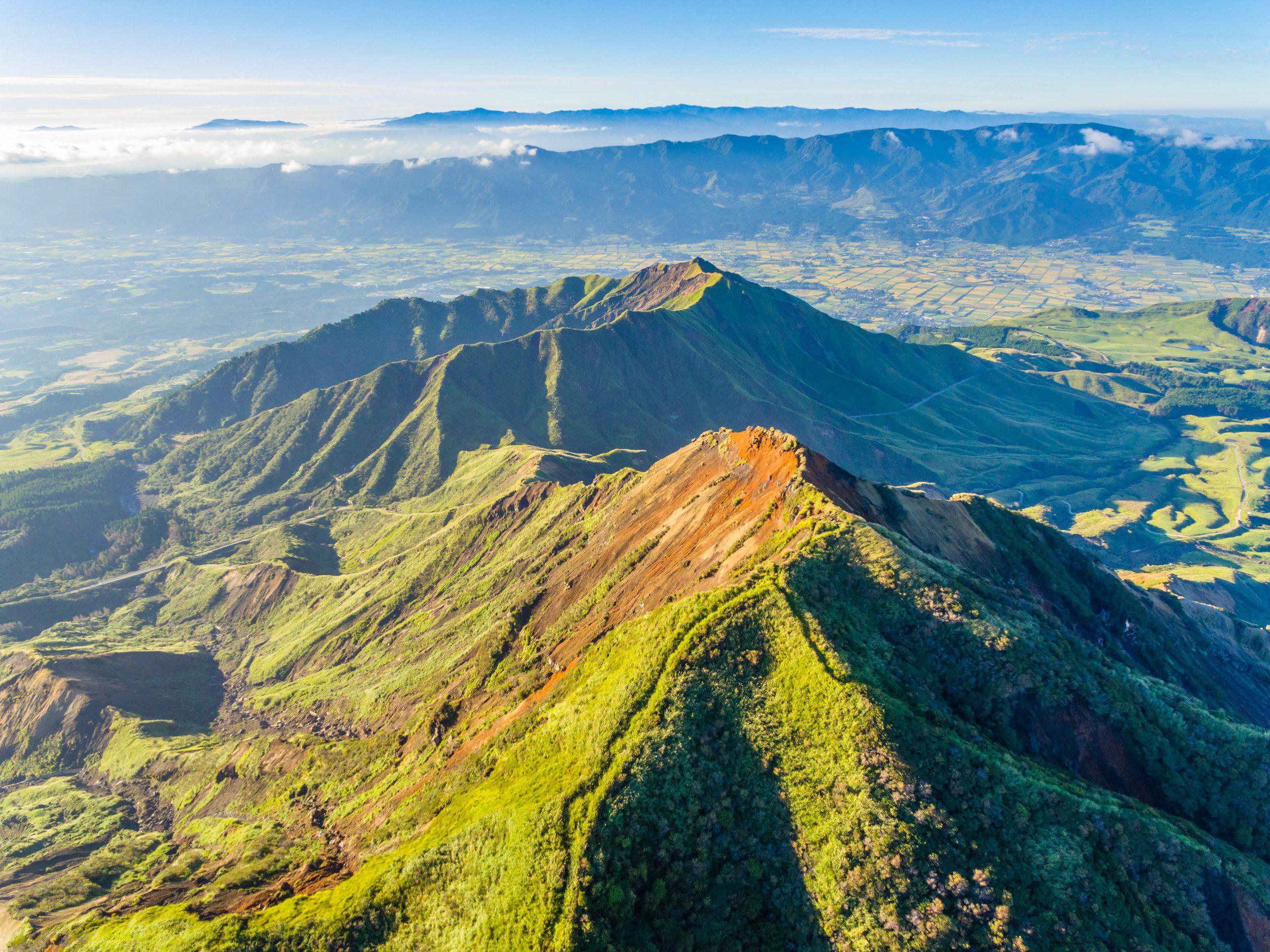
Kyushu is a natural paradise that offers many historic treasures, modern cities, and natural beauty. The southernmost of the main islands of Japan is known for its rich rugged landscape, volcanic scenery, vibrant cities, stunning hikes, and delicious ramen. Kyushu translates as nine provinces but is surprisingly formed by seven prefectures. The land of volcanoes also has a large number of high-quality (natural) hot springs dotted all over the island and Kyushu is often dubbed onsen island. Despite all of its beauty, Kyushu is an underrated paradise that isn’t frequently included on the itinerary by (international) tourists. All the more reason to travel to Kyushu! Here we will provide you with a ready-made itinerary to see some of the best places to visit in Kyushu . The itinerary is somewhat fast-paced so that you can cover the most popular spots and get to all the iconic places in 10 days. We also included some optional day trips for you to consider. As this schedule serves as an inspiration for your perfect trip to Kyushu, you can choose to leave out places or change the timing.


The best time to visit Kyushu
How to get to kyushu and around, day 1: fukuoka , day 2: fukuoka – saga – nagasaki , day 3: nagasaki – shimabara – kumamoto, day 4: kumamoto – kagoshima , day 5: kagoshima – yakushima , day 6: yakushima – kagoshima, day 7: kagoshima – kirishima , day 8: kirishima – takachiho, day 9: takachiho – mount aso, day 9: kurokawa – yufuin, tour packages, blogs you might also enjoy.
Kyushu has a comfortable climate all year round, but we recommend traveling in either spring or autumn. The winter is mild so you won’t see any snow, but it is still fairly cold at that time of the year. Summers in Kyushu are hot and humid and summer sees more rain than other regions in Japan.
Spring is definitely the most popular season to travel to Kyushu with sunny days and comfortable temperatures. The weather is perfect for all the outdoor activities and hiking that Kyushu is known for. It is also very popular at this time due to the cherry blossoms and flowers that are in full swing at this time of year.
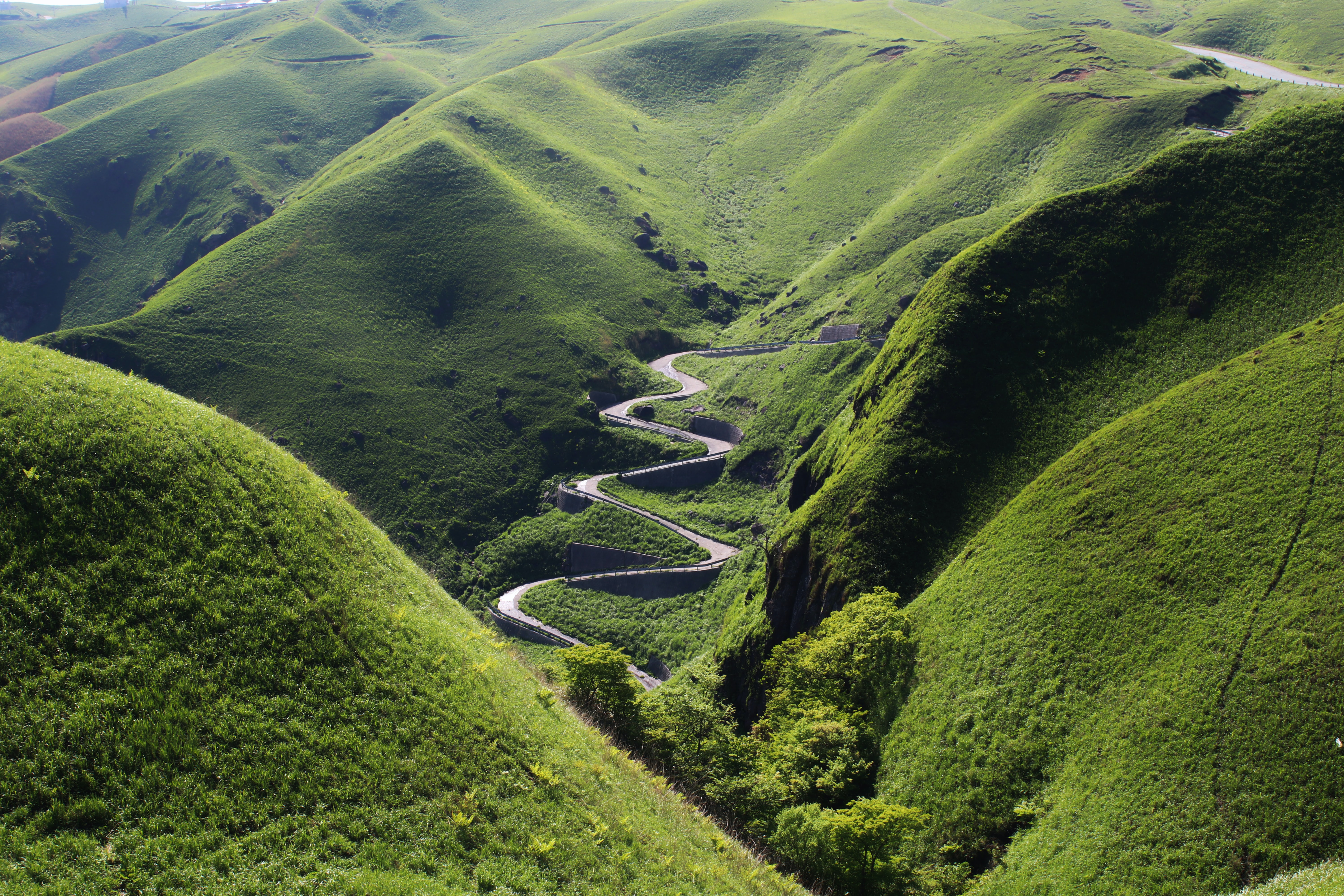
Most travelers will access Kyushu via Fukuoka , riding Japan’s famous shinkansen or boarding a flight to the well-connected airport of Fukuoka. But the island is home to a number of airports for example in Kagoshima , Nagasaki and Oita .
Kyushu has an extensive network of trains and buses within the major cities, connecting the seven prefectures on the island of Kyushu. The region is popular for its scenic trains such as the Yufuin no Mori and Kawasemi Yamasemi , along the coastline and crossing the mountainscape. The Japan Rail Pass (JR Pass) is also valid on most JR trains.
However, especially the more distant areas are easier to reach by car. With many breathtaking country roads, driving is the ideal way to explore Kyushu. Popular routes for a scenic road trip include the Nichinan coast road in Miyazaki, the Trans Kyushu Route, and the Aso Panorama Line in Kumamoto. We recommend exploring Kyushu by car as it will give you much more freedom and flexibility. You can find car rental agencies at airports and major stations.
The JR Kyushu Rail Pass is available for internationals and includes travel in the chosen area on the following JR trains:
- Local trains
- Limited express trains
- Shinkansen *Shinkansen between Kokura and Fukuoka, subways, buses or private railways are not applicable.
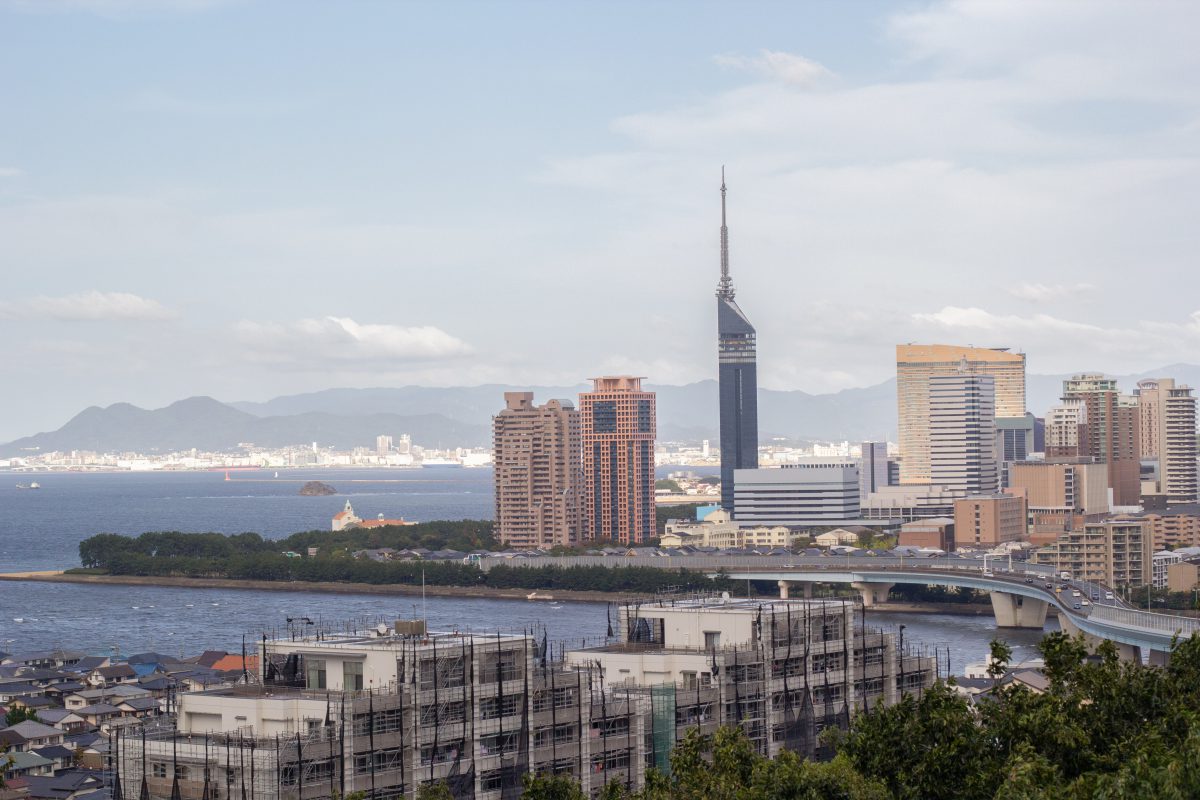
Kyushu’s largest and most vibrant city is Fukuoka ( 福岡 ), a great place to start your trip. The old castle town is located along Hakata Bay , which made it a favorable base for international trade. The city was first known as Hakata, but was renamed Fukuoka in the 17th century. We suggest you use this first day to discover the port city, Fukuoka is home to a number of top-notch shopping facilities and historically important temples and shrines such as Kushida-jinja Shrine and the Dazaifu Tenmangu shrine . Fukuoka’s castle was destroyed completely after the Meiji Restoration as it was seen as an unwanted symbol of the past, but the ruins and the bordering Maizuru Park are a very popular sakura viewing spot in Fukuoka . You cannot leave Fukuoka without trying the famous Hakata Ramen from one of the food stalls called yatai .
▼ And don’t miss out on the final Sumo Tournament in Fukuoka in November! Book your tickets by clicking the Link below and get a professional guide that will give you essential background information to enjoy the experience to the fullest .
▼ Fukuoka 1-Day Highlight Private Walking Tour (7 Hours) Book a guided private walking tour in Fukuoka to explore the highlights of Fukuoka including Dazaifu Tenmangu shrine, Kushida Shrine, and other unique spots that only locals know!
Both the drive and the train ride from Fukuoka to Nagasaki (長崎) will take you about 2 hours when traveling directly. You might want to take a detour and make some stops along the road in Saga prefecture , a small prefecture famous for Japanese traditional ceramics. Especially Arita and Imari are famous pottery villages . Start the day (very) early and catch the sunrise at Hamanoura Rice Terraces Lookout (浜野浦の棚田展望台) or enjoy the onsen facilities in Takeo Onsen (武雄温泉), a hot spring resort with over 1,300 years of history.
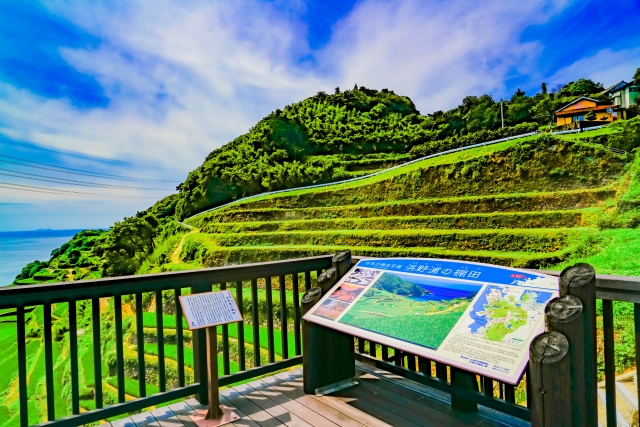
Nagasaki is widely known for two events in history ; it was the location of the second atomic bomb dropping and Nagasaki was the most important port where a restricted number of foreign traders were allowed during the period of isolation between the 17th and 19th centuries, known as the Sakoku period.
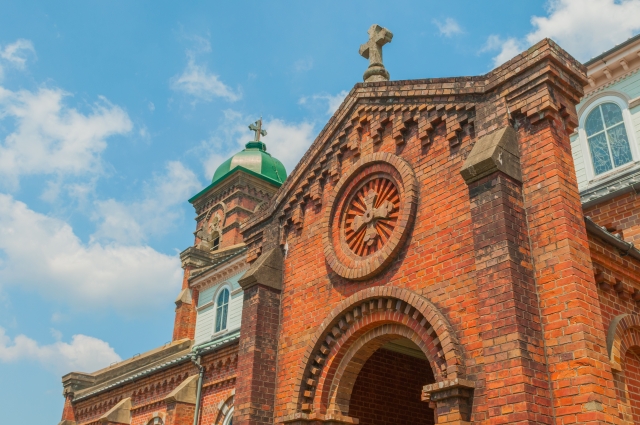
Depending upon the time of your arrival we recommend heading up to Mount Inasa for a spectacular view over Nagasaki. Nagasaki has a lot to offer, and the impressive night scenery that can be seen from Mount Inasa Observatory is one of them. When visiting Nagasaki, make sure to spend some time at the Nagasaki Peace Park where the victims of the second atomic bomb are commemorated. On August 9, 1945, Nagasaki became the second city that was destroyed by an atomic bomb, after Hiroshima. Another interesting place to visit in Nagasaki is Clover Garden , an open-air museum that showcases several beautiful mansions of the foreigners who lived in the city after the period of isolation. Or head to Dejima (出島), an artificial island that used to be Japan’s window to the world during that same period of isolation.
Right off Nagasaki’s coast, the abandoned island of Gunkanjima (軍艦島) makes for an interesting half-day trip. The small island served as an important coal mine until 1974 and can now be visited with a sightseeing tour.
▶ Make sure to book a tour to enter the Gunkanjima beforehand
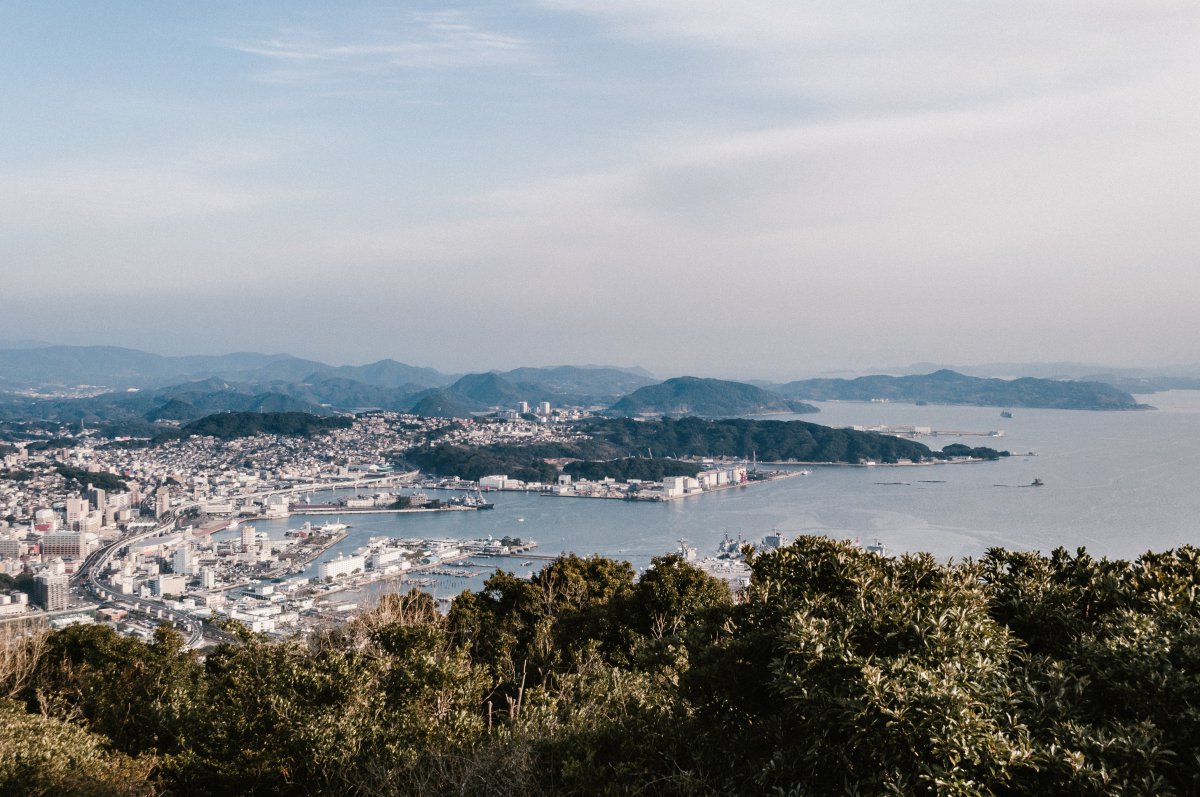
On the third day make your way from Nagasaki to Shimabara (島原), this should take about 1.5-2 hrs by car or train. Shimabara Peninsula (島原半島) is a popular hot spring and hiking destination, with Mount Unzen (雲仙岳) and Unzen Onsen (雲仙温泉) at the center. Mount Unzen is one of Japan’s most active volcanoes and has erupted several times in the last centuries. Its most recent eruption was in 1991 when 43 people were killed. Near the top of Mount Unzen, Unzen Onsen is a hot spring resort surrounded by several hot spring fields.
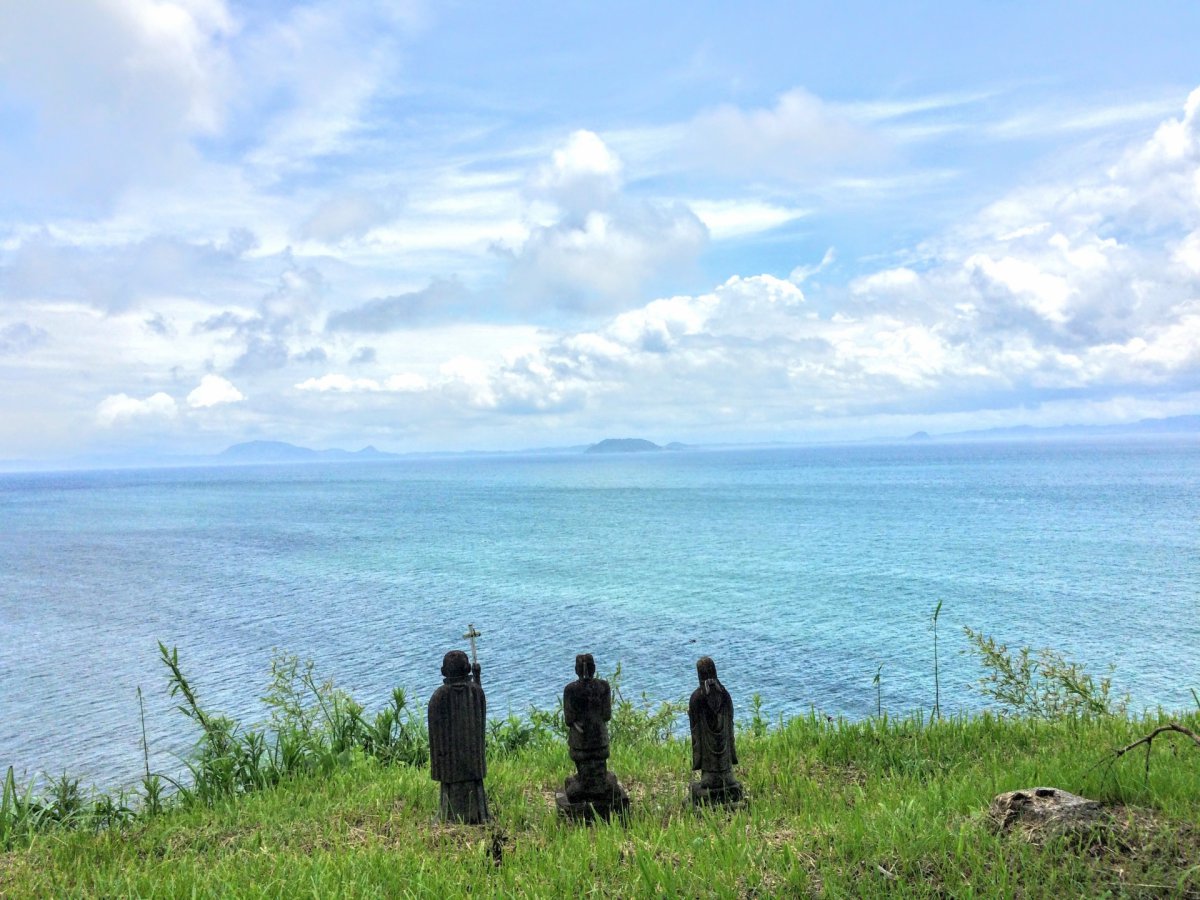
From Shimabara Port, catch the ferry to Kumamoto Port . From November to March, seagull feeding is available on the 60-minute ferry ride. Cars are allowed on board, but it is best to make a reservation (which can be made up to one month in advance).
Kumamoto (熊本) is the capital city of the namesake prefecture and is rich in history, with sites such as Kumamoto Castle , built over 400 years ago and considered one of the three most magnificent castles in Japan . Kumamoto is highly praised by nature lovers, blessed with breathtaking scenery and many hot springs . It is also called the land of water with hot spring water flowing from more than 1,000 locations across the prefecture.

Spend the morning exploring some more of Kumamoto, visit for example the Suizenji Garden , a beautiful serene Japanese garden. For lunch, have some Kumamoto Ramen , this local variant of the famous Japanese comfort food is characterized by mild tonkotsu soup , made rich in flavor with the addition of chicken bones mixed with garlic oil or chips.
Around midday make your way to Kagoshima (鹿児島), also known as the Naples of Japan for its bayside location and towering active stratovolcano Sakurajima ( 桜島 ). Stay overnight in Kagoshima for example at the Shiroyama Mountain Hotel , located on top of the hill and with hot spring baths overlooking Sakurajima volcano and the sea.
This guided tour will help you to explore all the highlights of Kyushu’s Kagoshima in a day tour , it’s highly recommended if you have a limited time or want to discover the city with a local guide.
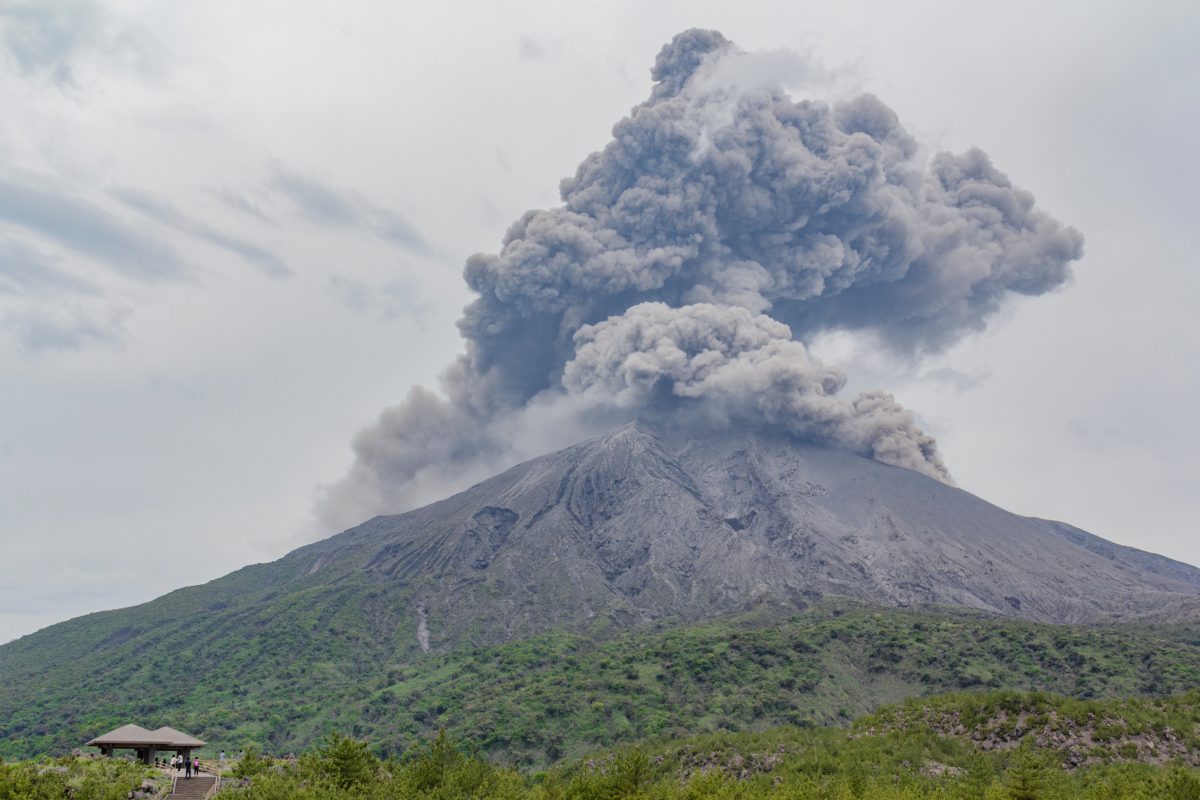
In the morning, board the ferry from Kagoshima to Yakushima (屋久島), a true nature lover’s paradise that served as an inspiration for Ghibli’s famous Princess Mononoke’s film . The small island of Yakushima is located about 60 km off the coast of Kagoshima and is famous for its towering mountains, its ancient cedar forest – Jomonsugi (縄文杉) is a giant cedar tree which is estimated to be 2000 to 7200 years old – and many well-marked hiking options. Much of the island is a designated UNESCO World Heritage Site .
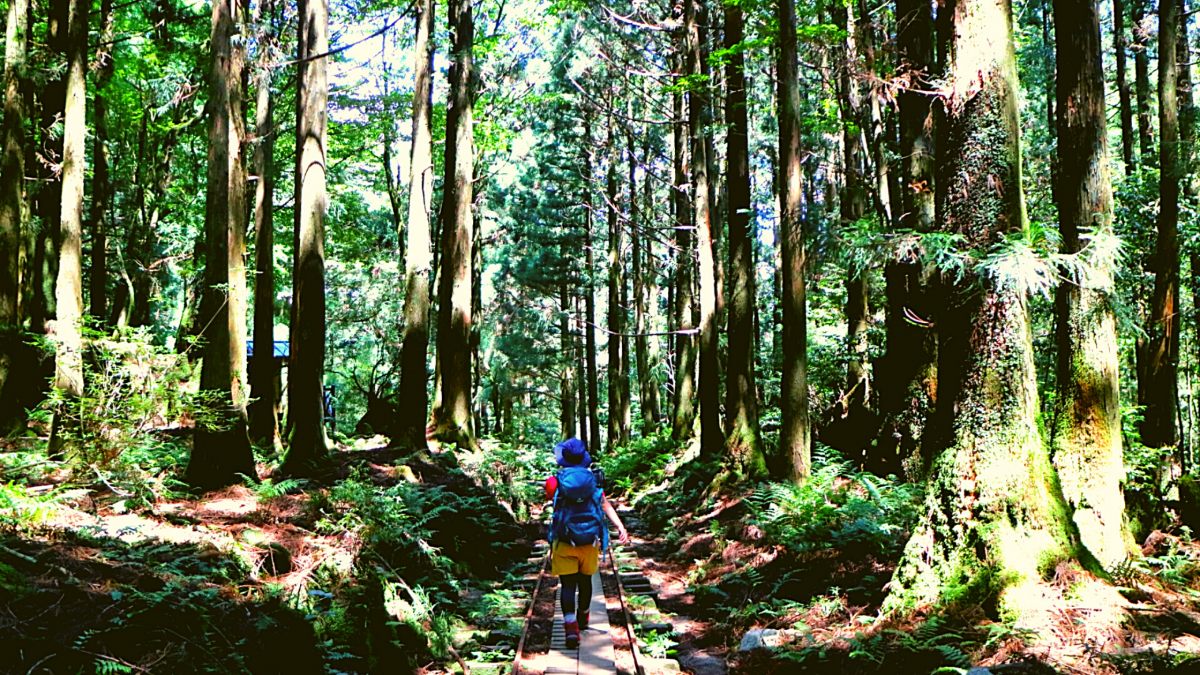
Enter the land of Princess Mononoke and pick one of the several hiking routes of Yakushima. We recommend visiting the Shiratani Unsuikyo (白谷雲水峡 ) where you have the option of several trails ranging from a 1 hr to a 6hr walk.
The island is quite small and it’s possible to access all of Yakushima’s main sights by bus, though service is infrequent. The best way to explore Yakushima at your own pace is by car. Cars can be rented on the island, and it is also possible to bring your car from Kagoshima with the car ferry .
Recommended tour: Yakusugi Cedar Forest Walking Tour on Yakushima Island
Spent the entire day exploring the island before taking back the ferry to Kagoshima. Admire mesmerizing waterfalls like Okonotaki , Senpiro, and Janokuchi , or the historical Yaku Shrine . One of the highlights of the island is the natural hot spring bathing pools formed from ocean rocks along the coast of the Sea of Japan. Bear in mind that the last ferry to Kagoshima departs from Yakushima at 4pm.

After waking up in Kagoshima the next morning, explore the city a bit more and transfer to Kirishima (霧島). The area of Kirishima consists of volcanic mountains, highlands, hot springs and volcanic lakes and it was the first to be designated as a national park in Japan in 1934. The absolutely breathtaking scenery is a feast for the eyes and the mountains offer a wide range of hiking courses suitable for both beginners and more experienced hikers. Nearby Ebino Kogen (えびの高原) and Kirishima Onsen (霧島温泉) are the two best hot spring towns in the Kirishima area. We recommend staying overnight in Kirishima Onsen, one of Japan’s best hot spring resorts with high-quality sulfuric water. You can also opt for staying in Ebino Kogen, an epic place to see the autumn colored leaves and the starting point of several hiking trails. Kirishima Mountain is also an important site in Japanese mythology and home to a large beautiful shrine; Kirishima Shrine is an impressive ancient shrine said to be built in the 6th century!
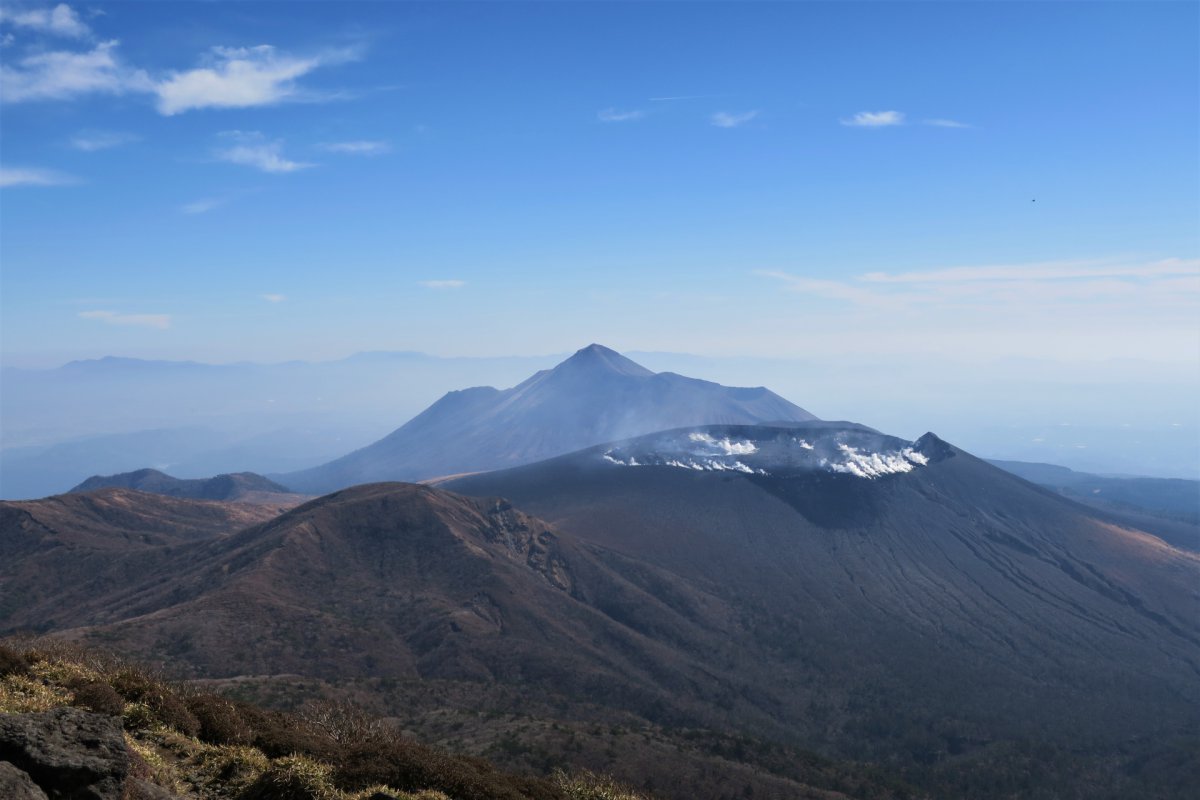
The trip from Kirishima to Takachiho (高千穂) takes about 3~3.5 hrs by car without any stops. Depending on your preference you can either do some more hiking in Kirishima or you can also decide to take a slightly longer route and drive along the coastline of Miyazaki (宮崎市), a beautiful scenic drive. In the south, the Nichinan Coastline is known as one of Japan’s best road trips, with beaches, great surfing spots and the stone giants of Sun Messe Nichinan along the way.

In northern Miyazaki you’ll find one of Japan’s most beautiful nature spots : Takachiho Gorge (高千穂峡). The stunning V-shaped gorge was formed from lava from Mount Aso (阿蘇山) which over time eroded to create 80-100m high volcanic cliffs. This place has appeared in Japanese mythology and is known as a power spot filled with spiritual energy. The gorge can be enjoyed in two ways; from above (the cliffs) and below while rowing down the river. Follow the trail that leads you to the observatory deck in front of the Manai Waterfalls .
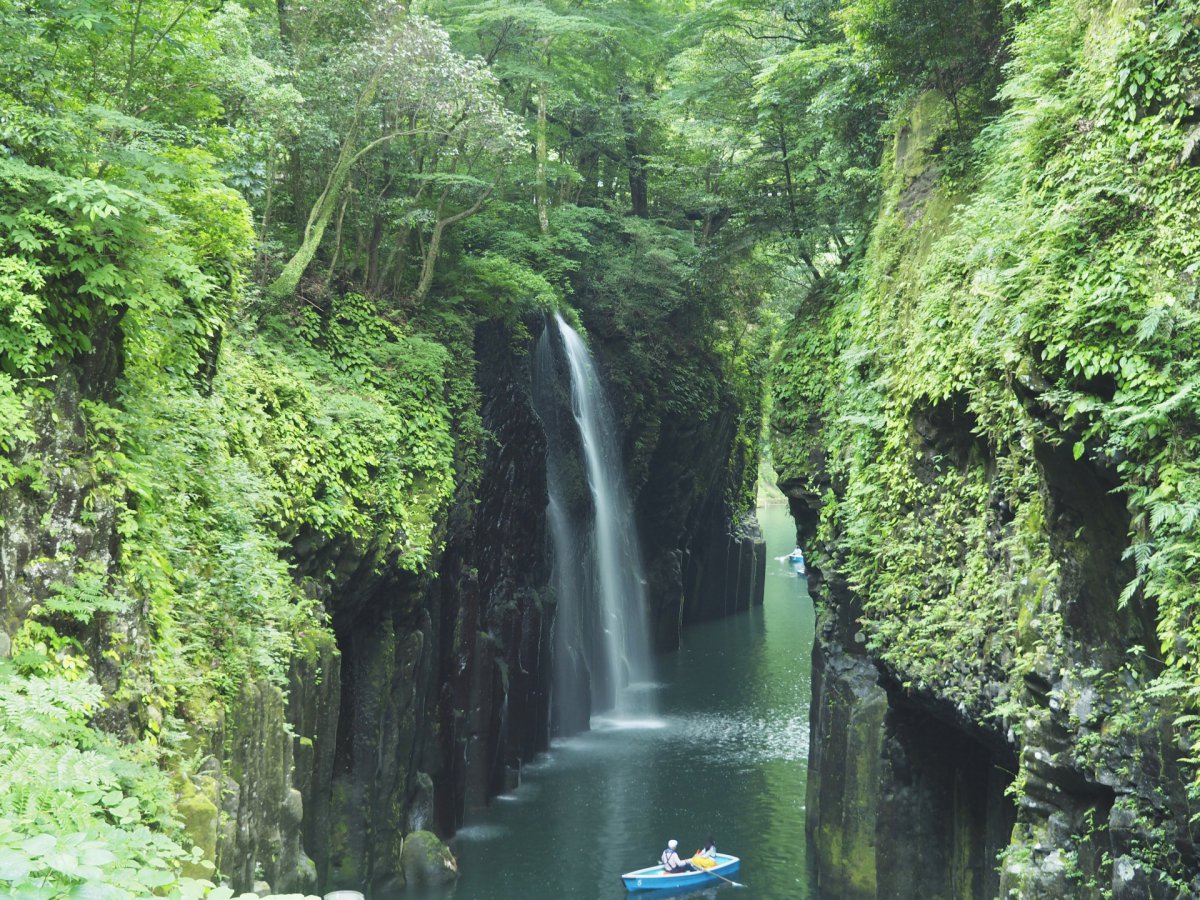
Overnight in Takachiho and see a traditional Japanese dance performance, held every evening at 8pm on the grounds of Takachiho shrine.
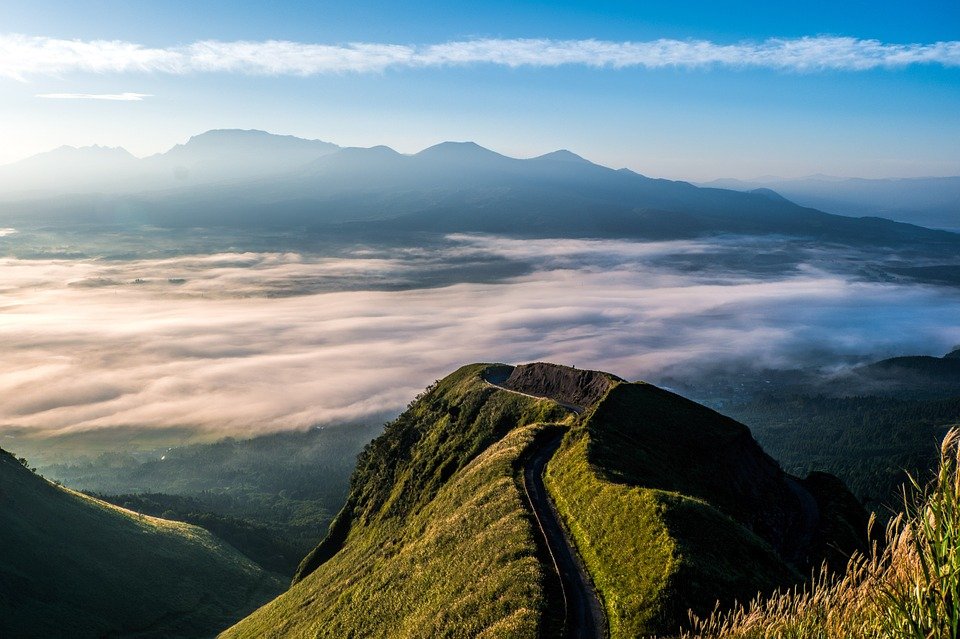
Wake up early and watch a magnificent sunrise at the nearby mountain peak called Kunimigaoka (国見ヶ丘), known for Japan’s famous unkai or sea of clouds . After one of the best sunrise views over the rice fields and Takachiho Valley, continue north and make your way to Mount Aso . But before visiting Japan’s largest active volcano, take a small detour and make a stop at the picturesque Kamishikimi Kumanoimasu Shrine . The path leading up to the shrine is lined with numerous stone lanterns, and it is worth the trip, even if you’re not a fan of shrines. The shrine is famous for being the setting of a popular anime and manga comic Hotarubi no Mori e (Into the Forest of Fireflies).
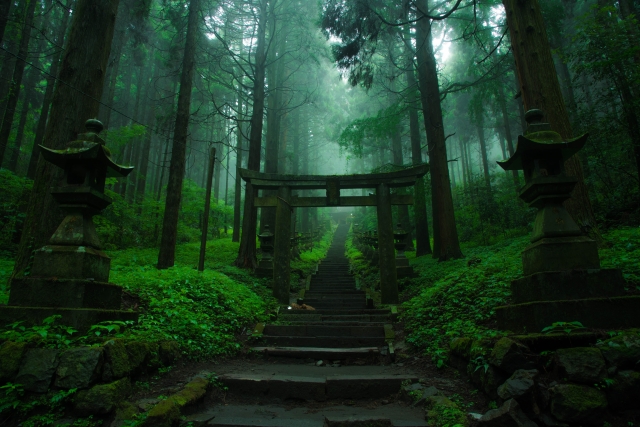
Mount Aso is one of the largest calderas in the entire world, spanning 17 kilometers from east to west and 25 kilometers from south to north with a total area of 350 square kilometers. Standing at 1592 meters above sea level and boasting five soaring peaks, Mount Aso is a must-visit for anyone visiting Kyushu. Hiking the Mount Aso region is one of the most incredible adventures you can have in Japan! It is possible to drive to the top of Mount Nakadake (中岳), or you walk in about 30 minutes to the summit. Alternatively, you can also take the ropeway around Mt. Aso and ride the plains created by the magma below the mountain. From the parking or the ropeway station, there are a number of hiking trails to explore Mount Aso . Always check the current status of the area before you go as the volcano is still active and often closed. To find out the current restrictions in place you check the official website .
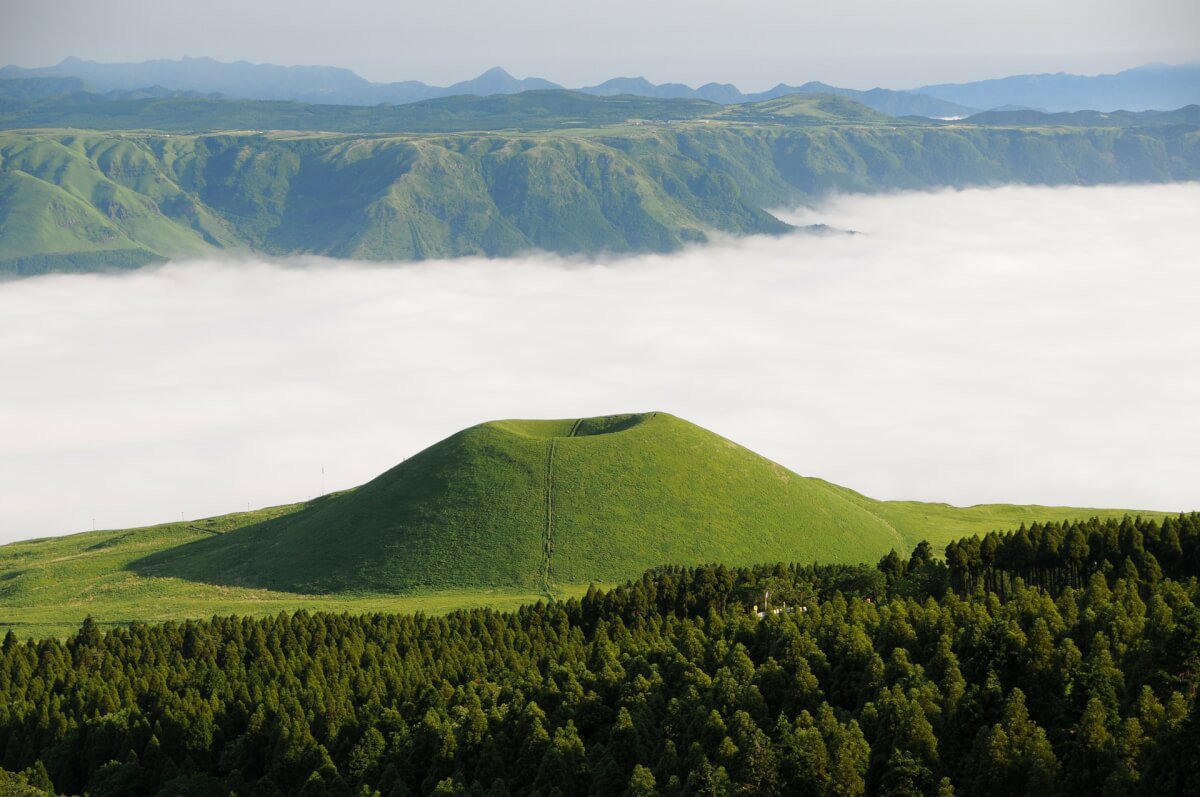
After taking in the breathtaking volcanic scenery of Mount Aso, make your way to Kurokawa Onsen (黒川温泉), a secluded onsen town up in the Aso mountain range. Kurokawa Onsen has managed to maintain the traditional atmosphere with ryokan and public bathhouses dominating the townscape. The charming town is home to a number of ryokan baths and public baths and visitors can purchase a tegata for ¥1,300 that offers access to any three of the participating onsen. Stroll around in your yukata and wooden sandals and relax after a long day of exploration.
After Kurokawa Onsen the next destination on the list is Yufuin (由布院), a popular onsen resort town in Oita Prefecture . You have two options of getting there by car and we recommend taking the road passing the Kuji Mountain (九重山) range along the way. The mountains are located along the scenic drive Yamanami Highway.
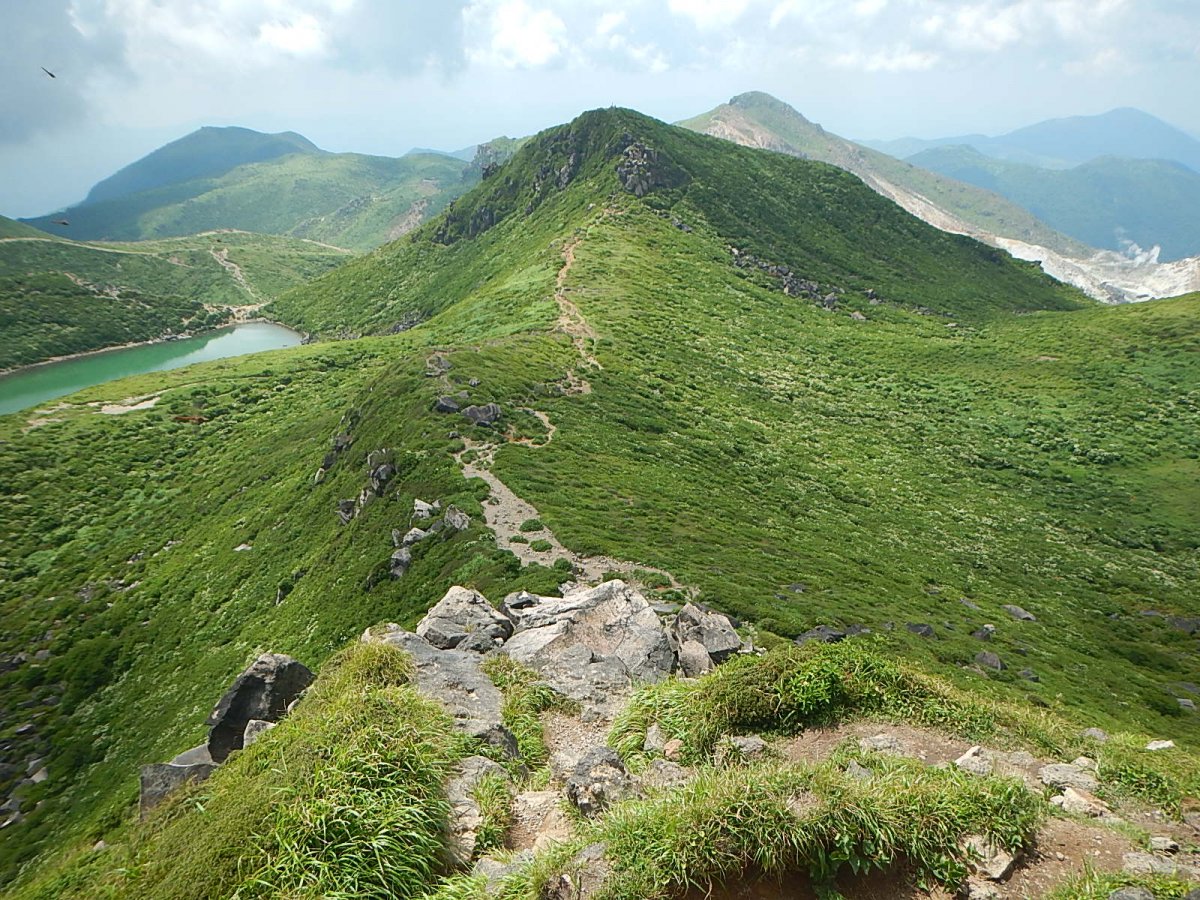
The natural hot springs of Yufuin are a must-try of course and there are several public baths that can be used by visitors like Tsuka no Ma, Baien and Musoen . Some of the baths are gender separated whereas others are mixed. Yufuin is located on a flat river basin nestled in a mountainous valley, with scenic views of Mount Yufu , a volcano that stands 1.83 meters tall, from nearly every place in town. Along the main street, you will find many souvenir shops, cafes and small art museums, creating a lively atmosphere. Most of the public baths and ryokan are scattered around the town and many visitors come to visit for just the day. Staying overnight will offer you the opportunity to enjoy the natural hot spring and the second no other place views. Because there are many mountains surrounding Yufuin, there are also plenty of hiking trails with easy access from the town. For example, this day trip hiking to the summit of Mount Yufu , takes about 4-5 hours to complete. On a clear day, the views are guaranteed jaw-dropping.
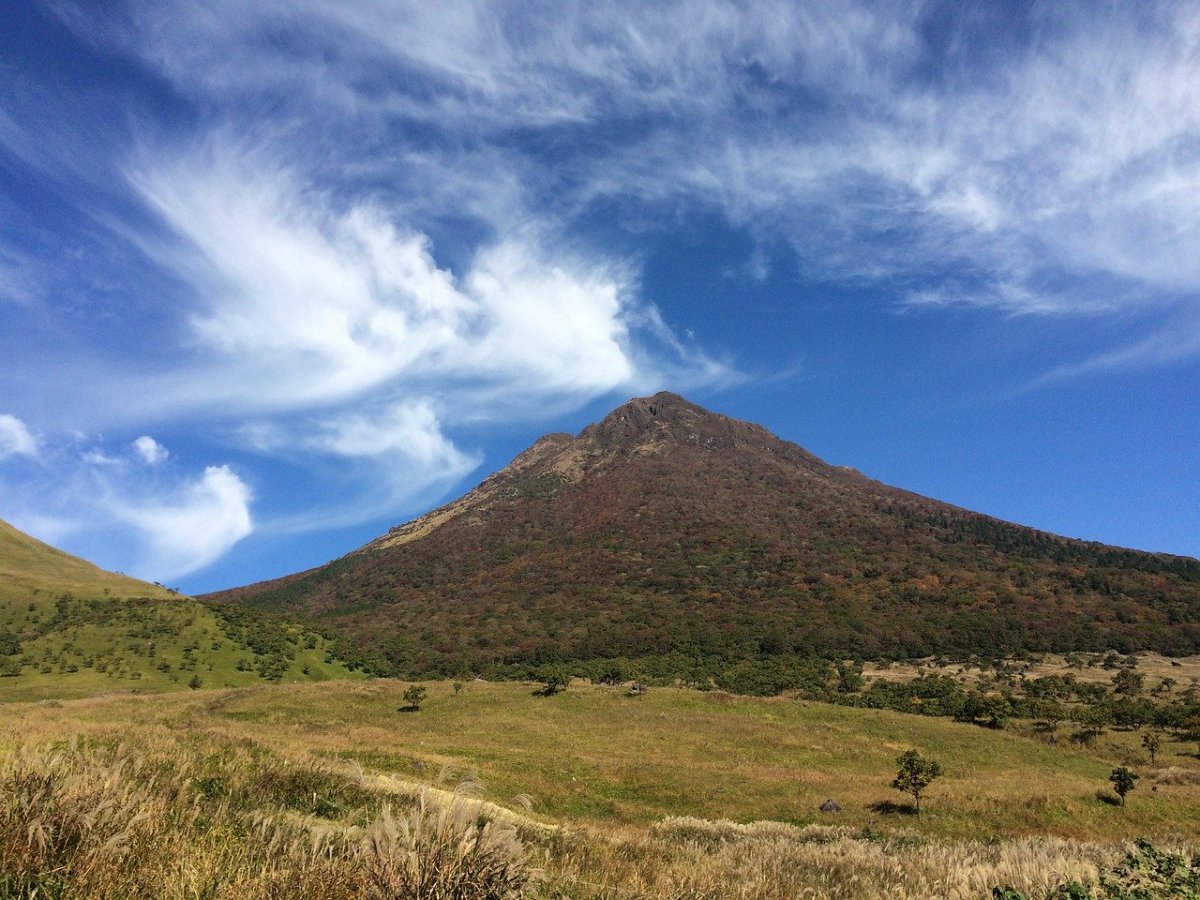
Another highlight nearby is Lake Kinrin at the base of Mt. Yufu. The small lake is located at the end of the main walking route of Yufuin. There is a small shrine located on the southern shore and there are charming little cafes and shops selling local specialties.
We recommend staying at the traditional ryokan, Yufuin Iyotomi . The ryokan has indoor cypress baths and a large outdoor bath (rotenburo).
Day 10: Beppu – Oita
Situated at the heart of Oita Prefecture , Beppu (別府) is one of Japan’s most popular hot spring resorts. The area produces the greatest amount of thermal water from natural hot springs in the world. You can’t miss it, there is steam rising into the air everywhere in Beppu. There is a wide range of baths to be enjoyed, from normal hot water baths to mud baths, sand baths and steam baths, Beppu offers it all.
In addition, the Hells of Beppu (地獄, jigoku) are a must-visit when you’re in the area. The hells of Beppu are seven incredible hot springs created by volcanic activity more than 30,000 years ago. These hot springs are for viewing rather than bathing as they are far too hot; the temperature reaches up to 100 degrees Celsius. The most beautiful hell is Umi Jigoku , or Sea Hell, a pond of boiling milky blue water, shrouded in steam. The grounds also feature a large garden and a few smaller, orange-colored hells. Chinoike Jigoku or Blood Pond Hell is another spectacular hell with bright red water, thanks to the high levels of iron and magnesium in the water.

Onbara (乙原の滝) is a hidden gem near Beppu where you can enjoy a short trek passing the epic waterfall of Onbara Falls. There are several beautiful waterfalls in the area around Beppu, but Onbara Falls is the most beautiful and accessible. There is a short, well-marked trail with a dirt/rock path leading you up to the falls. Start your day with a beautiful little walk, the trail is only about a 2km return and refresh at one of the many natural hot springs after.
We recommend you also visit the Beppu Sand Bath (別府海浜砂湯) where you don’t bathe in hot water, but in hot sand instead! Being buried in the hot volcanic sand is a healthy and relaxing experience.
From Beppu you have the option of flying to your next destination using Oita Airport (大分空港). If you are continuing tour trip from Fukuoka, we highly recommend taking the Yufuin no More train to Fukuoka . The sightseeing train is a popular train ride to take and gives you some amazing views of both prefectures on the way.
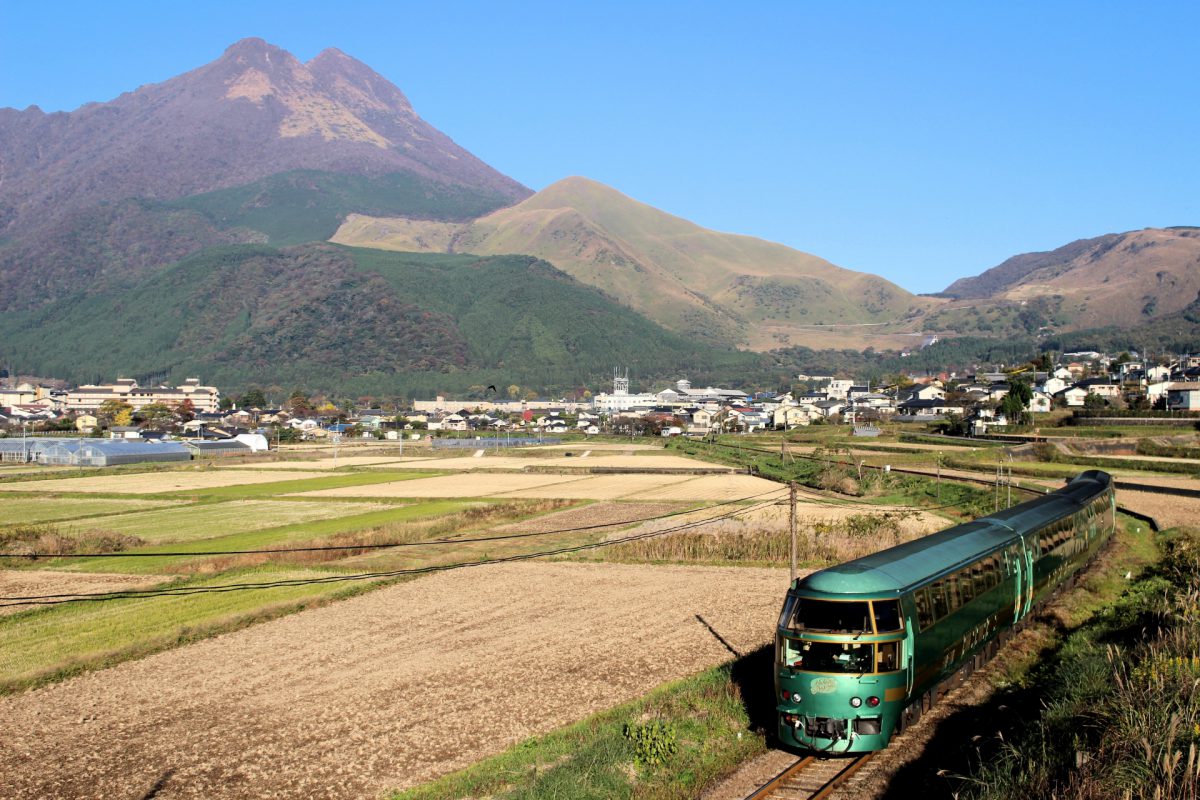
With this 10 day itinerary, you will visit many of the highlights of Kyushu. We recommend you to self-drive, as public transportation is limited especially in the more rural parts including Kirishima and Takachiho Gorge. A car offers you the freedom to visit the tourist hotspots of Kyushu in a short amount of time. This ready-to-use Kyushu itinerary serves as an example of the ultimate Kyushu trip, of course, you can extend this itinerary and stay longer at some places or add other places from your wishlist.
Follow us on Instagram , Facebook and Twitter for more travel inspiration. Or tag us to get featured!
Happy traveling!
If you want to make travel easier, click here to find the best tour package from various operators!

This post may contain some affiliate links. When you click through and make a purchase we may receive some commission, at no extra costs to you
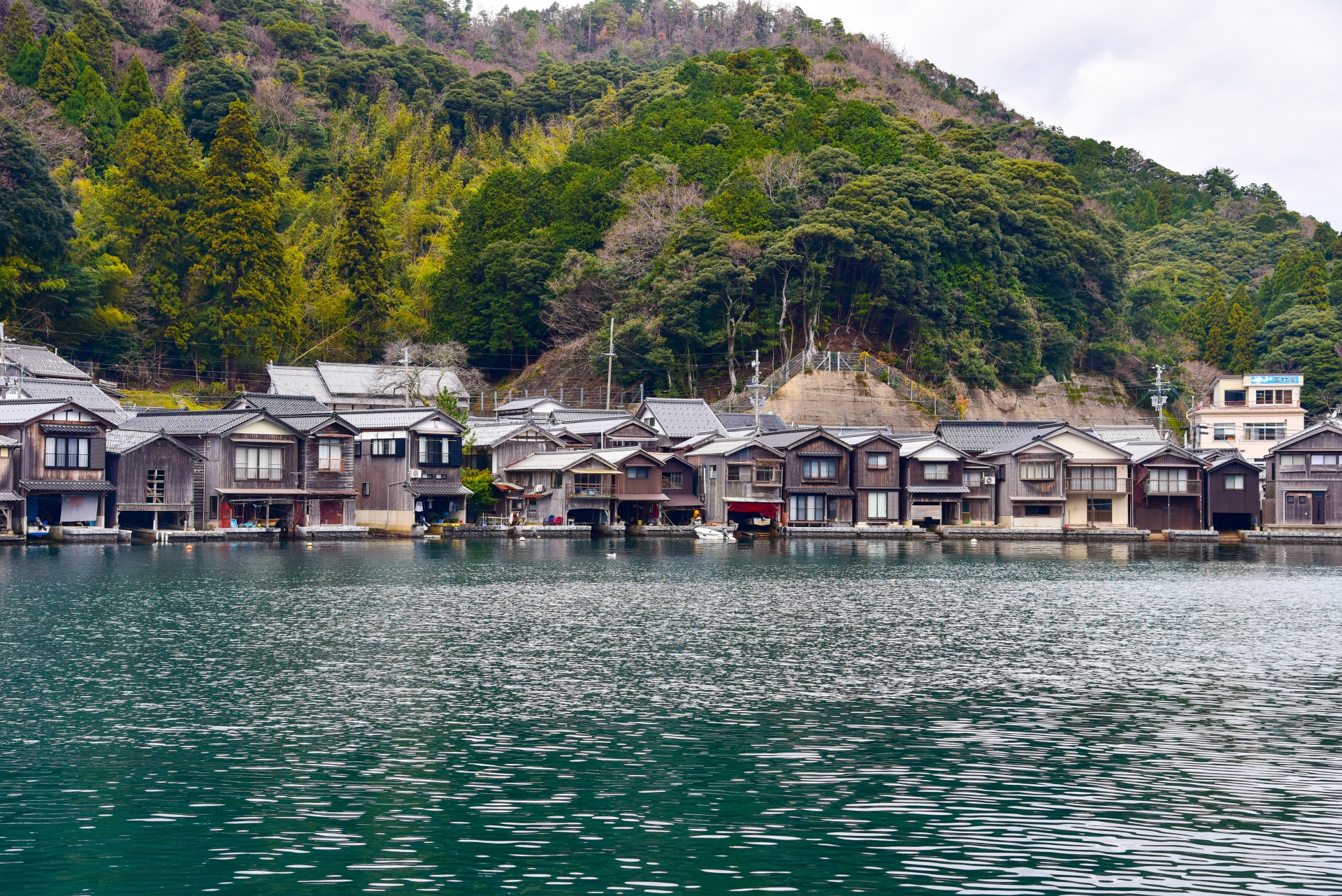
- Popular destinations
- Hidden places in Japan
- Tours and workshop
- Food and drink in Japan
- Itinerary in Japan
- Places to visit in Tokyo
- Food and drink in Tokyo
- Seasonal events
- Tours & workshops
- Tokyo This Week
- Day trip from Tokyo
- Itinerary in Tokyo
- Places to visit in Kyoto
- Food and drink in Kyoto
- Itinerary in Kyoto
- Day trip from Kyoto
- Travel tips
- Accommodation
- Cultural tips
- Transportation
- Tokyo Tours
- Kyoto Tours
- Kimono Rental
- Fukushima Tours
- Mount Fuji Tours
- Tour Package
- Media Kit(English/日本語)

The Perfect Kyushu Itinerary: 5-Day, 7-Day & 10-Day
Jackson Groves
Posted on Last updated: June 24, 2023
Categories JAPAN
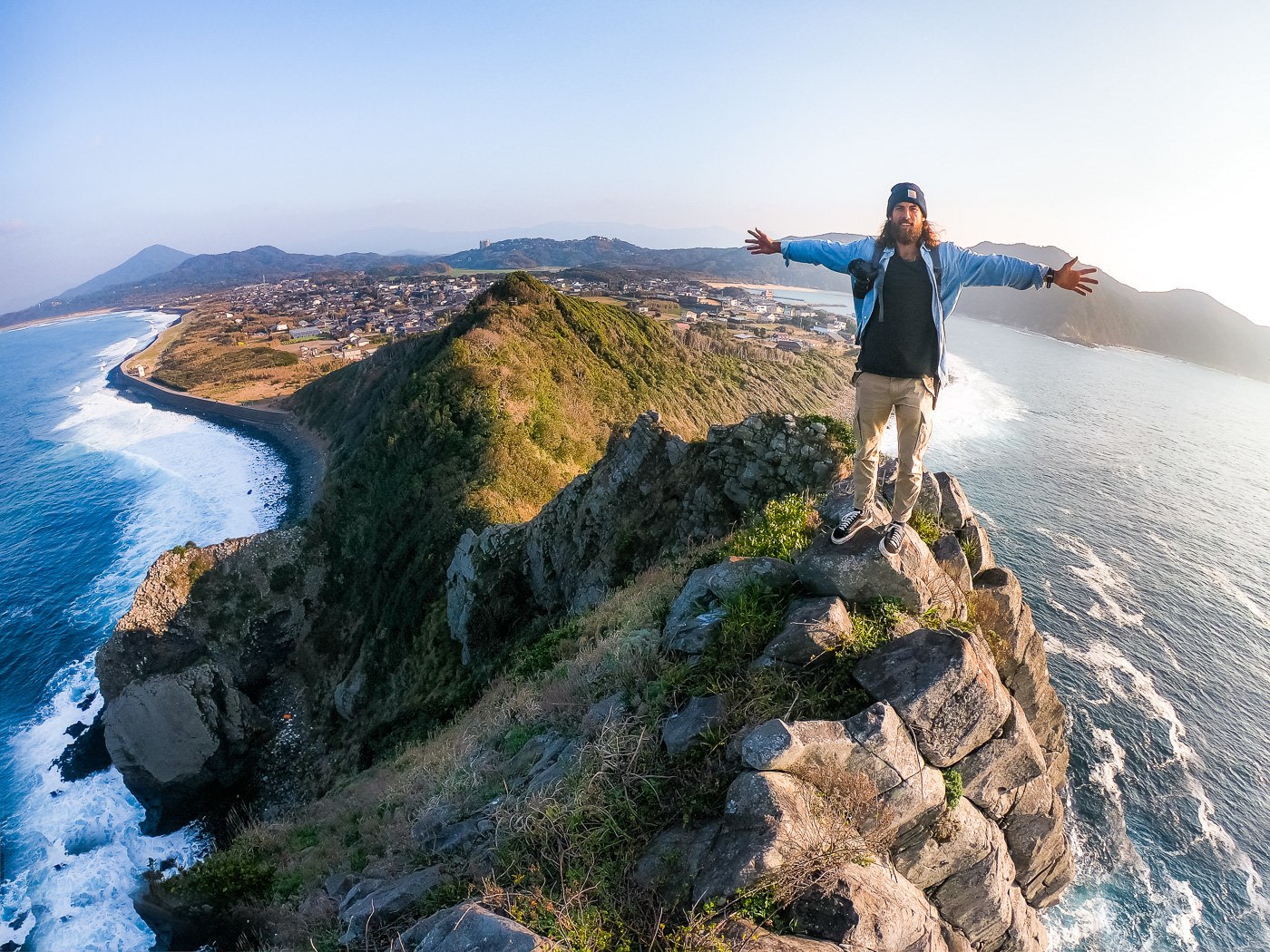
Are you heading to Kyushu for 1-2 weeks and want to pack your itinerary with lots of epic locations and adventures? I have got you covered. This 5-day Kyushu Itinerary (7-day & 10-day also included) will be your best resource for adventurous activities in Kyushu. I’m talking waterfalls, onsens, volcanoes, and some epic viewpoints along the way.
BEST RENTAL CAR COMPANY IN JAPAN
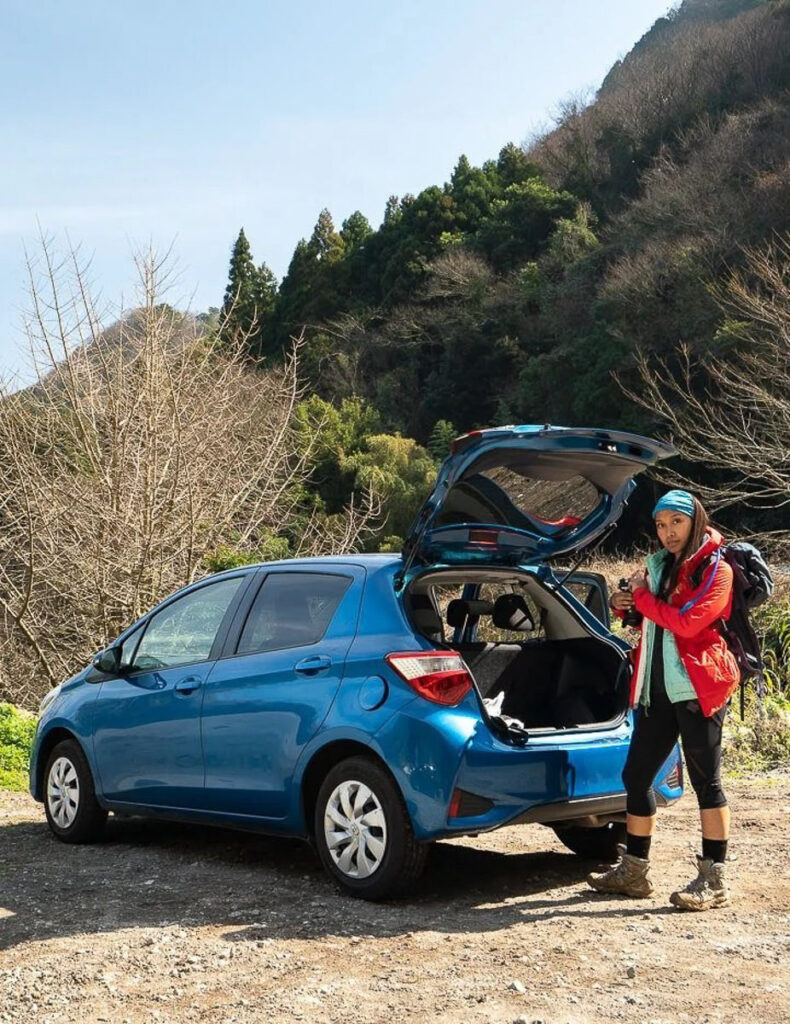
When you book your Rental Car online, I personally recommend and always use Klook for car rentals in Japan. They search for both local and international companies, so you get the best deal!
I spent three weeks in Kyushu so I know the best places to use as your base to maximize your time. This is a self-drive itinerary as it is just too hard with public transport to see all of the tourist hotspots in a short amount of time.
Table of Contents
ULTIMATE GUIDE TO CREATING A KYUSHU TRAVEL ITINERARY
What is included in this kyushu itinerary blog post.
- In this Kyushu itinerary blog post I will first detail how you should structure your five-day itinerary to make the most of your time.
- In each location, I will suggest how to extend the itinerary to 7-days or 10-days or even longer like myself.
- Finally, at the bottom of the blog post, I will share my tips on things to know before you travel to Kyushu ( specific information for adventurous travelers )
So, let’s get into it.
TOP 3 PLACES TO STAY IN KYUSHU
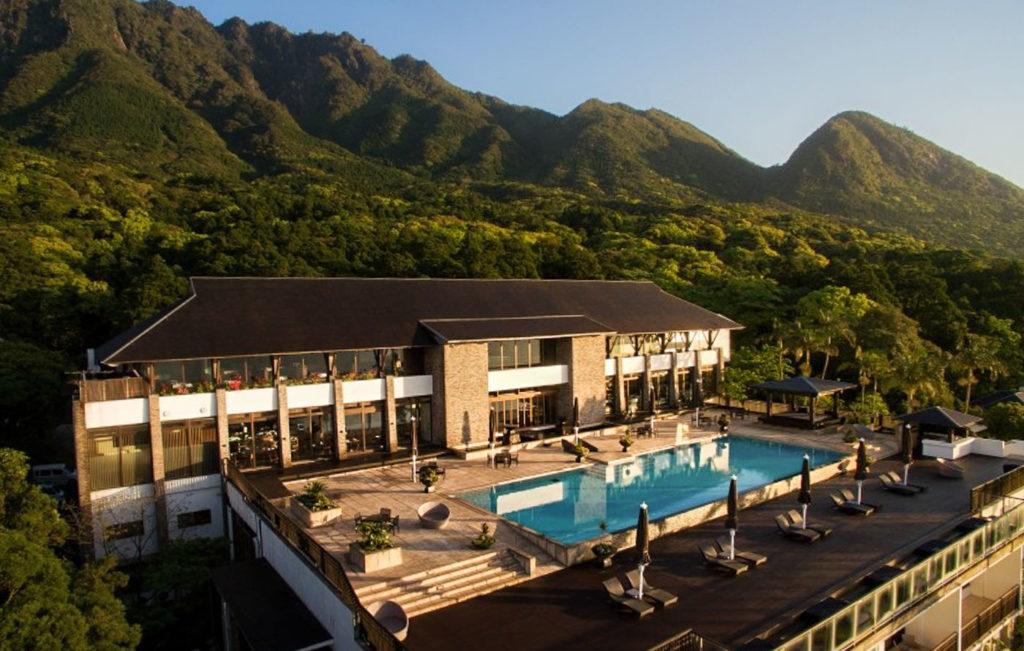
- Ultimate Luxury: Amane Resort Seikai best location and view
- My Favorite: Sankara Hotel & Spa – Natural Forest, Pool & Beautiful surroundings.
- Budget Hostel in Kyushu: WeBase Hakata Hostel is easily the top hostel in Kyushu
HOW TO GET AROUND KYUSHU FOR ADVENTURERS
The Kyushu Itinerary I am creating for you here is based on exploring by rental car . I just didn’t find Kyushu to be a place easy to explore by public transport or even with one base and tour groups etc. It’s spread out and not well linked, especially when we are talking about the hikes, mountains, and waterfalls rather than the city attractions. While the train may suit those in Tokyo, Kyoto, Osaka, and even in Fukuoka, it won’t cut it out here on Kyushu.
When I rent a car in Kyushu, I recommend and I always use Discover Cars , and you can see why below. The best part about Discover Cars ? You can add full coverage insurance for only about $8 per day.
The trains will get you from major towns and even into some regional areas with bus connections but almost all of the adventure spots I visited had no bus connection. When I searched on Google Maps and clicked the public transport option it would just say ‘not available’. It was very clear, very quickly that Kyushu island is best to explore by rental car, especially if you are doing hikes and activities outside of the city (literally everything on this list).

INTERNATIONAL DRIVERS LICENSE FOR KYUSHU
*** It is extremely important to know that you MUST HAVE an international driver’s license to rent a car in Japan. In fact, they won’t even look at your actual driver’s license and only want to see the international driver’s license. Take that seriously as they genuinely will not give you the car and likely no refund if you don’t have that. To get one you need to be in your country of residence and you can get one on the spot or order online and receive it in a week or so. Make sure you organize that in advance as I almost got caught out not knowing that.
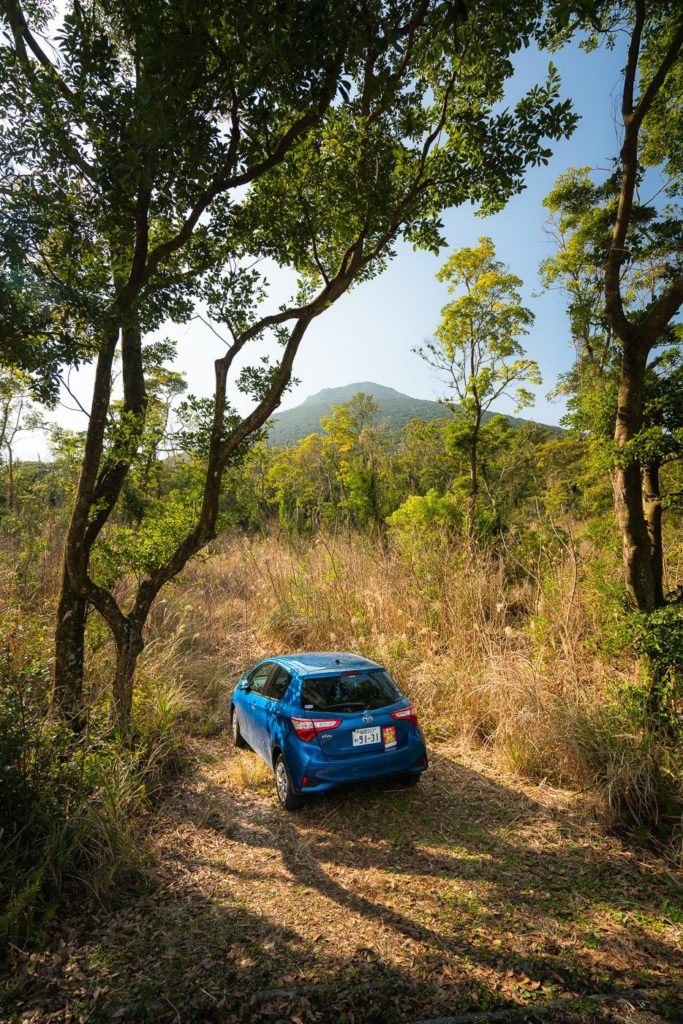
BEST TIME TO VISIT KYUSHU
I visited in February, which was winter and freezing. I don’t advise it but it was still epic. The best time to visit Kyushu is most definitely not winter. It’s not really a ski destination so likely you will be freezing and all of the leaves will be dead so the landscapes will not be as beautiful as at other times of the year. There are a few drawcards for each season so I will go through them below.
- Fall/Autumn: The temperature is mild and comfortable making it great for hikes and adventuring. If you time things right, you will get the beautiful fall colors out on the trails!
- Spring: This is definitely the most popular season to travel to Kyushu with sunny days and comfortable temperatures. It is very popular at this time due to the cherry blossoms and flowers that are in full swing at this time of year.
- Summer: While not known for its beaches, Kyushu does offer a number of great swimming spots and beaches to explore. For hiking, it may get a little hot but (up to 30 degrees Celsius) never reaching temperatures that would limit your adventures.
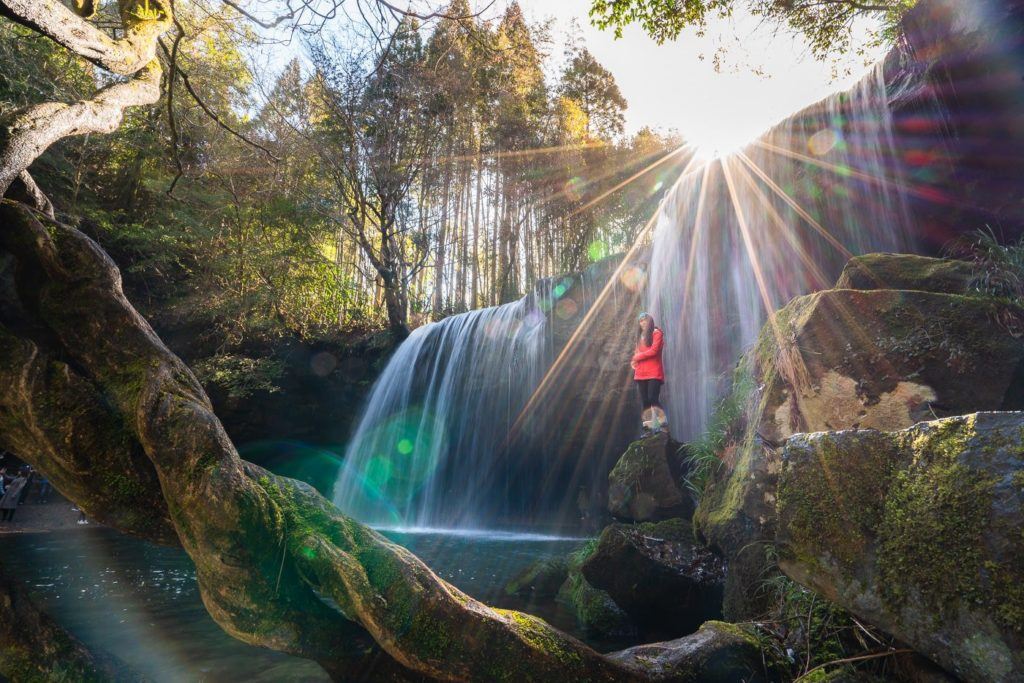
KYUSHU ITINERARY
The way I am breaking this itinerary up is into two locations if you have 5 days and three locations if you have 7 days. The 10-day itinerary will have four locations but will explore more from each base location. So, let’s start with the ideal 5-day itinerary for explorers.
5-DAY KYUSHU ITINERARY
Kumamoto and Beppu will be the home bases for this five-day itinerary so that you can cover the most popular spots and get to all the iconic places in under a week. This is a packed itinerary so don’t be afraid to erase an activity or take a rest day but it is possible with planning to fit them all in. They are all great spots and you won’t be disappointed at any of these locations. I’ve been to them all personally and had an epic adventure. At the bottom of this blog post, I’m going to add a small snippet about each location with a link to the individual blog post I have written for each spot.
Day 1: Mount Aso Day Tour or Mount Aso Hiking/Mount Eboshi
Day 2: GorogoTaki Waterfall in the morning and Mount Neko Hike in the afternoon
Day 3: Takachiho Gorge Tour
Day 4: Onbara Falls mini-hike and Mount Taharamaya/Magaibutsu Buddha
Day 5: Onsen experience and Mount Yufu or Mount Tsurumi
Optional Day 6: Optional extra day in Fukuoka exploring the city and venturing down to Keya No Oto hike in Itoshima
7-DAY KYUSHU ITINERARY
Kumamoto, Beppu, and Kirishima will be the home bases for this seven-day itinerary. You’ll probably need a rest day unless you are a machine but see how you go. I’ve been to all of the spots personally and had an epic adventure. At the bottom of this blog post, I’m going to add a small snippet about each location with a link to the individual blog post I have written for each spot.
Day 6: Drive to Kirishima in the morning and on the way hike Mount Karakuni
Day 7: Mount Kaimondake hike, Ryumon, and Inukai Waterfall
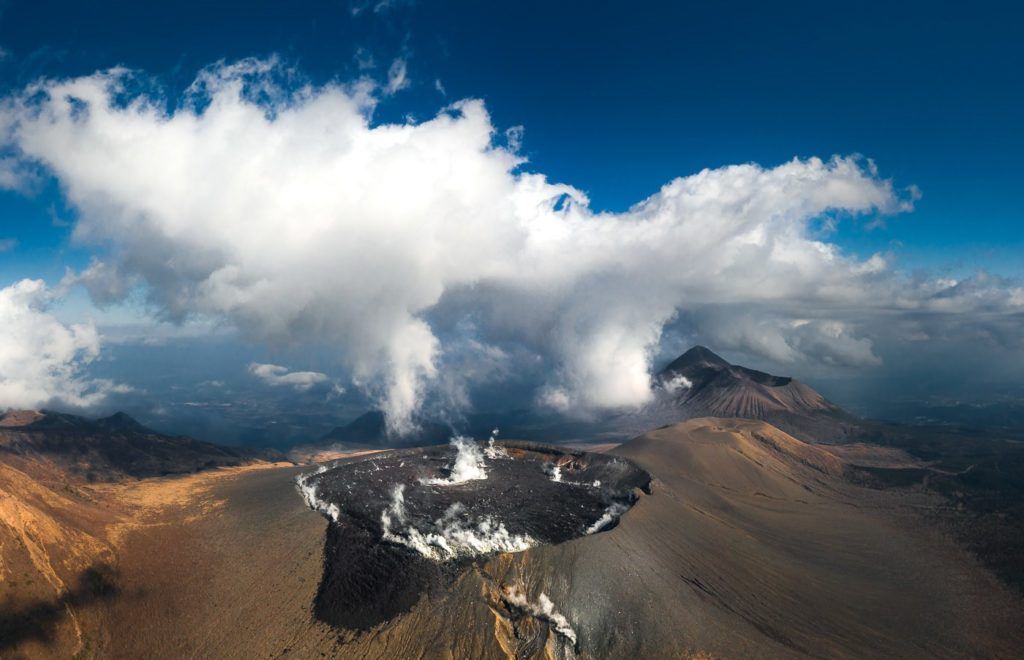
10-DAY KYUSHU ITINERARY
Day 4: Mount Kuju Hiking circuit and transit from Kumamoto to Beppu
Day 5: Onbara Falls mini-hike and Mount Taharamaya/Magaibutsu Buddha
Day 6: Onsen experience and cable car or hike to Mount Tsurumi
Day 8: Visit Sakurajima (active volcano)
Day 9 & 10: Overnight trip to Yakushima with two day-hikes.
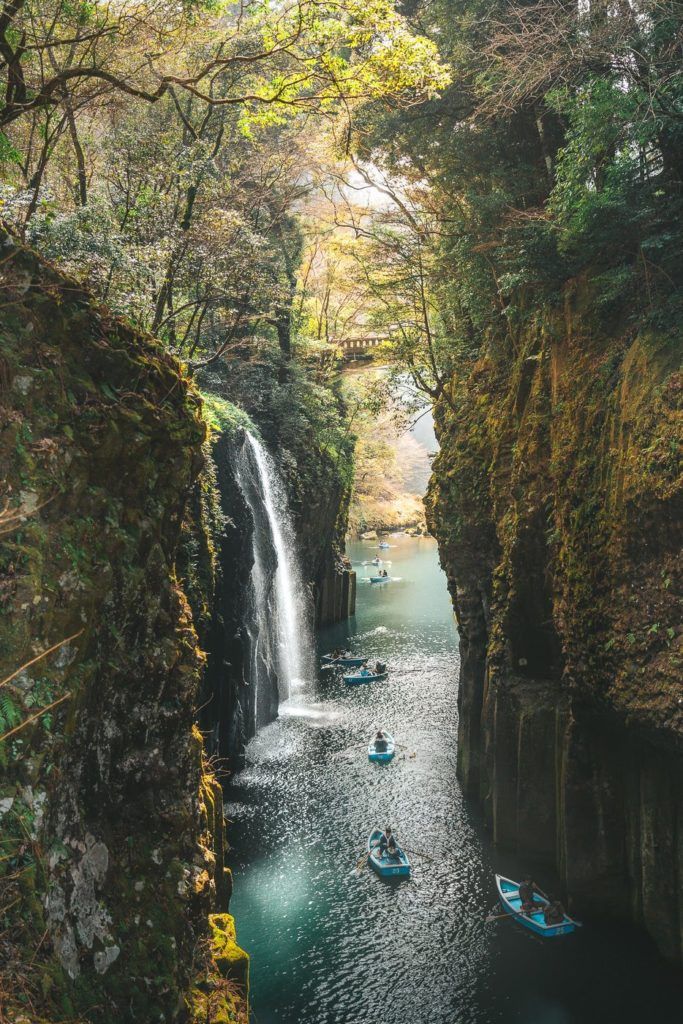
BEST INSURANCE FOR TRAVELERS
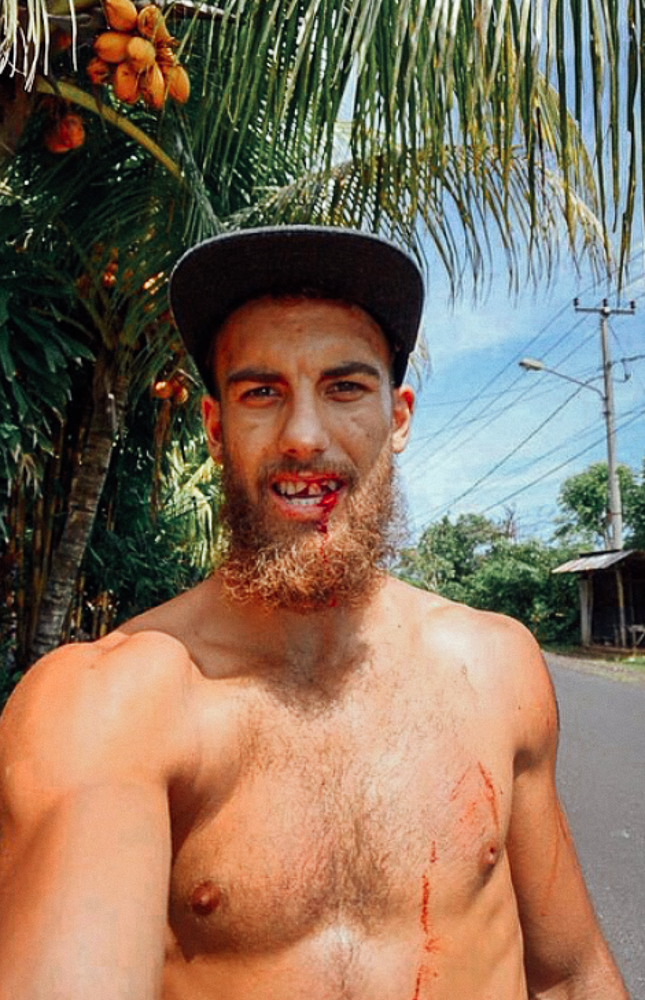
Don’t wait for an accident to happen… get insured! My travel insurance is HeyMondo which offers low-cost travel & medical insurance. That’s me on the left with three teeth knocked out after a motorbike crash in Bali!
You can click to read my Full Review of the Best Travel Insurance .
I’ve made several successful claims with HeyMondo and find their customer service very quick and helpful. Click the button below to get a 5% DISCOUNT
So, those are the three different Kyushu itineraries I’ve put together. I hope you have a great time in Kyushu and enjoy it as much as I did! Remember these are just suggestions and if you don’t like hiking so much, you can change the activities around and do more cultural activities, visit historical sites and castles, or do food-focused tours.
Below are the snippets of all the activities I suggested in the itineraries above so you can see what I am adding to each itinerary.
ONBARA FALLS
The journey to Onbara Falls is a very, very short trek but will remove you from the town of Beppu and immerse you in the jungle making you feel lost beneath the falls. Onbara Falls is a bit of a hidden gem just outside the town of Beppu in Oita Prefecture of Kyushu, Japan. Beppu is one of the most famous Onsen towns in Japan and even the world. However, amidst all of the hot springs and Onsens are some truly epic waterfalls and Onbara Falls is up there with the most beautiful and most accessible.
The trail is short and well-defined with a dirt/rock path leading you up to the falls. With the morning sun shining through it was actually a beautiful little walk, which is only about 2km return.
Read the full blog post for details: ONBARA FALLS IN KYUSHU, JAPAN
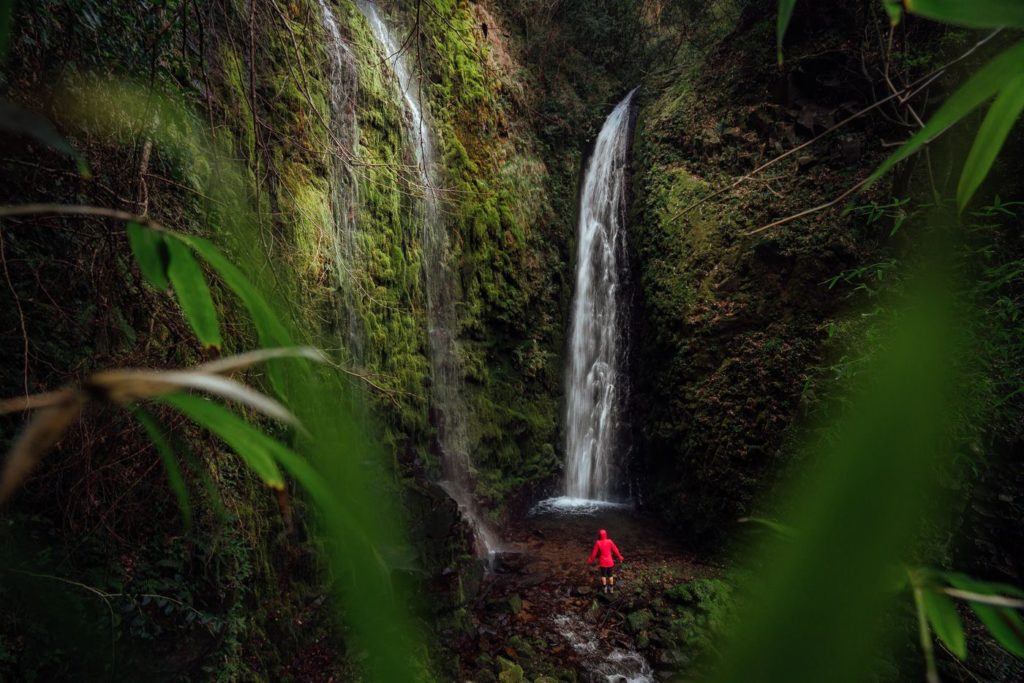
HIKING TO MOUNT KARAKUNI IN KIRISHIMA
Mount Karakuni is the highest peak in the Kirishima Mountain Range of Kyushu Island in Japan with a height of 1,700 meters. Mount Karakuni has a volcanic crater, which is 900 meters and 300 meters deep. The hike up from the visitor center is relatively short with just a few kilometers in distance but quite steep. From the summit, you can look over to the ‘Ring of Fire’, which is the off-limits
The total hike distance for me was 9.6km for my entire lap of the Kirishima area but there are many ways to make it shorter. If you just go up and down Mount Karakuni from the visitor center it will be about 5-6km in total. I added on the lap of Lake Rokkannonmiike and Lake Byakashiike.
Read the full blog post for details and all photos: MOUNT KARAKUNI HIKE (KARAKUNIDAKE) IN KIRISHIMA
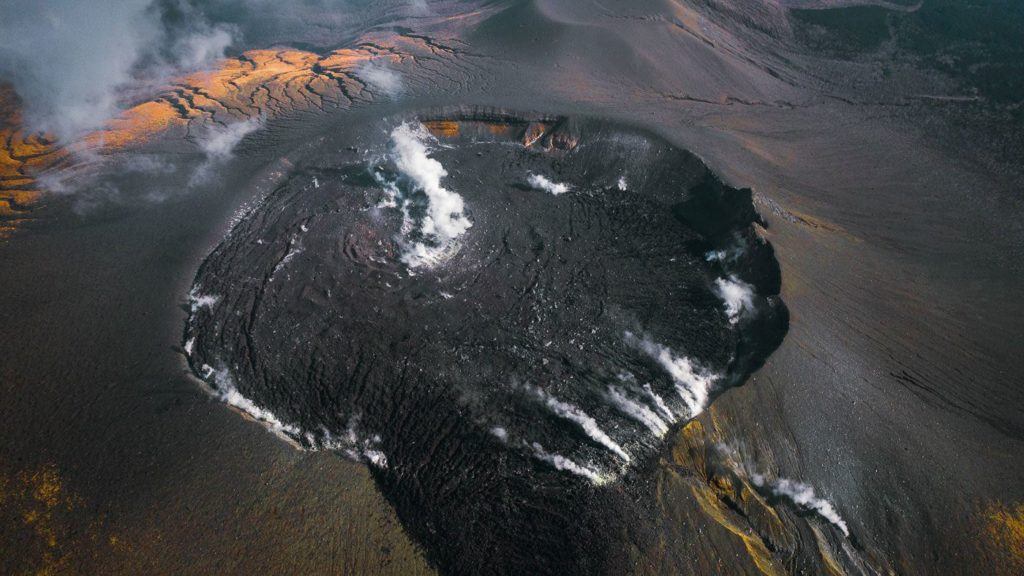
MOUNT TAHARAYAMA
The Mount Taharayama hike leads you on a steep ascent up to an epic, rocky ridgeline before you descend down into the forest to discover a 10th century stone buddha carving into the cliff wall. It’s an adventure with a tomb-raider vibe and is definitely sure to have you off-the-beaten-path and out there amongst the adventure in the Oita Prefecture of Kyushu Island, Japan.
Read the full blog post for details and all photos: MT. TAHARAYAMA HIKE TO KUMANO MAGAIBUTSU (BUDDHA STATUE)
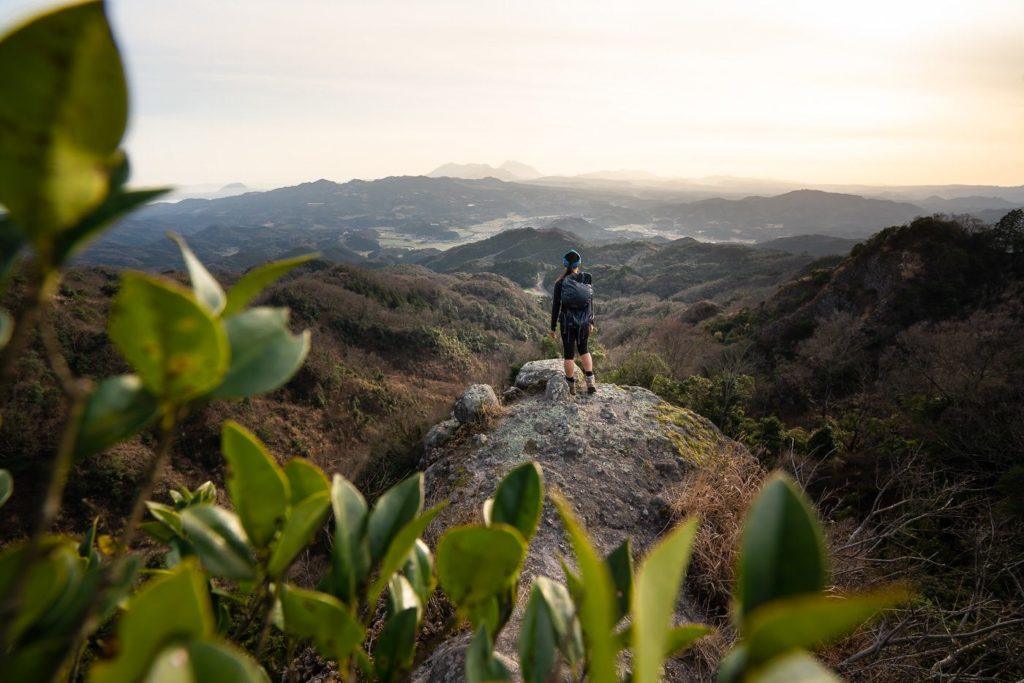
INUKAI FALLS
Inukai Falls was probably my favorite waterfall that I visited while based in Kirishima. It was a booming waterfall but I really loved the gorge that led up to the falls, which was lined by woodland and forest giving it a Pacific Northwest vibe. I actually had to wait a while here for the fog to clear enough to see the falls but when it cleared a little, I was able to record a little video on the drone to show you just how epic this gorge is.
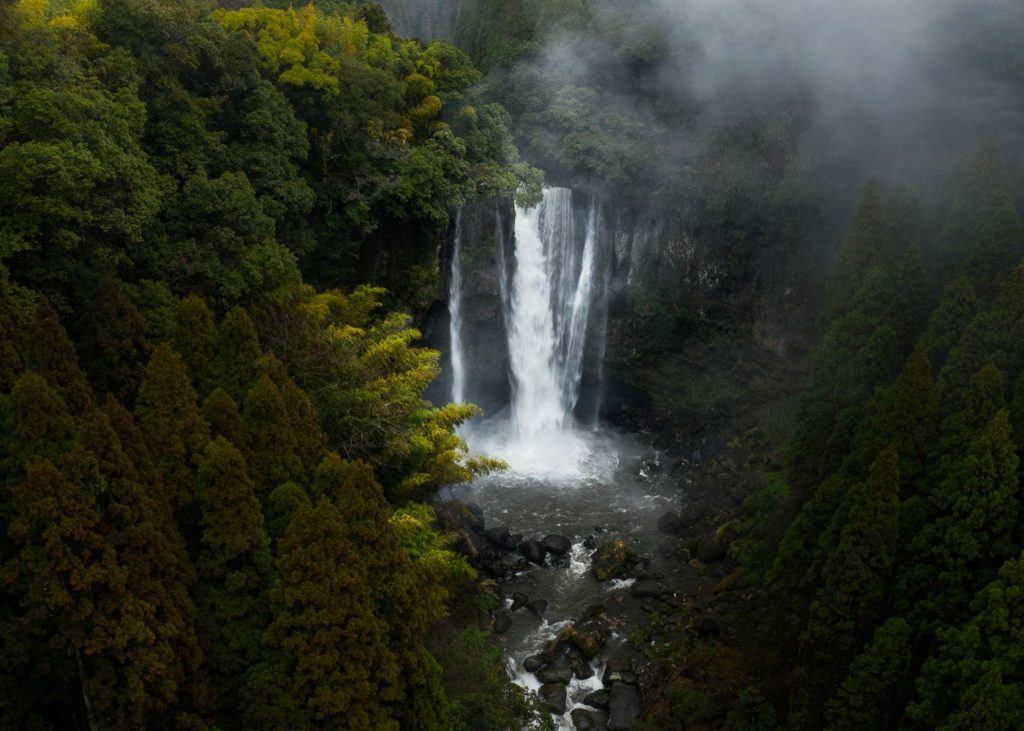
What are my favorite pieces of travel gear?
There are four pieces of gear that I simply never travel without. These are four items that I using right now and this list gets updated every year! Here are my travel essentials.
- Packing Cube Set : Once you cube you’ll never go back. Organize your clothes within your luggage with these smart mesh containers. It will revolutionize your packing.
- Quick-Dry Towel : A quick-dry towel is a must for travelers. It hardly takes up any room and dries in seconds.
- Travel Wallet : Keep your passport, wallet, and vaccine card safe as well as any forms and important documents you need to store.
- Grayl GeoPress Water Filter Bottle : I’ve used this for three years. It filters your water with one press and you can drink directly from it. Never buy a plastic water bottle again!
HIKE MOUNT ASO
In the Aso region of the Kumamoto Prefecture in the center of Kyushu Island is the Mount Aso region, which is one of the largest calderas in the entire world. Hiking in Mount Aso Region is one of the most incredible adventures you can have in Japan. Mount Aso is a volcanic depression, which is essentially a huge crater that has a number of peaks within this region that can be trekked. There are numerous craters within the crater such as the very active Nakadake Crater.
The Caldera spans 17 kilometers from east to west and 25 kilometers from south to north with a total area of 350 square kilometers. When we talk about this caldera it is a huge area but at the center of the caldera is where all of the action is when it comes to volcanic activity, hiking, museums, and tourism. In the middle of the caldera is the central crater group which consists of the five Aso peaks which are Mt. Taka (Takadake), Mt. Naka (Nakadake), Mt. Eboshi (Eboshidake), Mt. Kijima (Kijimadake), and Mt. Neko (Nekodake).
I hiked all of the peaks except for Kijima. The Nakadake and Takadake loop (when open) is my favorite hike in Kyushu… by far. It looks down on the active volcano crater and makes you feel like you are in outer space or trekking through a post-apocalyptic world.
Read the full blog post for details and all photos: HIKING MOUNT ASO VOLCANO – A COMPLETE GUIDE
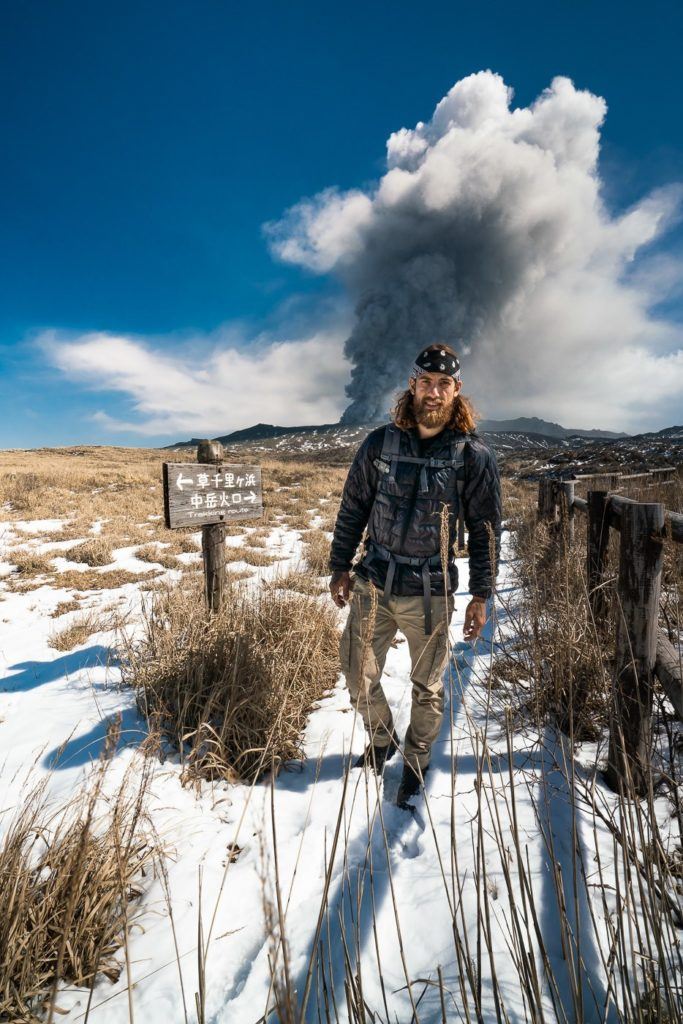
MOUNT EBOSHI HIKE
Mount Eboshi is one of the five peaks of the central cone group of the famous Mount Aso. It’s the easiest peak and probably the safest peak to climb taking just over an hour to get up and down from the summit. The view from the top is quite remarkable as it looks out over the Nakadake Crater, which is where the active volcano of Mount Aso is found.
The Mount Eboshi hike is a great little trail not because of the views or the adventure but because it is usually open! Because Nakadake Crater and the active volcano within it are often spewing ash high into the air, the surrounding trails are often closed. This leaves adventurous hikers feeling a bit stuck. Luckily Eboshi is a bit further away but you still have nice views of the erupting volcano.
At the summit, you have a view out to Nakadake Crater, which is where the eruptions, smoke, and all the action takes place. In the other directions, you can witness the entire caldera and the various rock formations and craters that are scattered throughout the region. I visited Mount Eboshi as part of the ‘ Around Aso Tour ‘, which was the perfect way to explore this region on a full-day trip from Fukuoka.
Read the full blog post for details and all photos: MOUNT EBOSHI HIKE (EBOSHIDAKE) IN MOUNT ASO
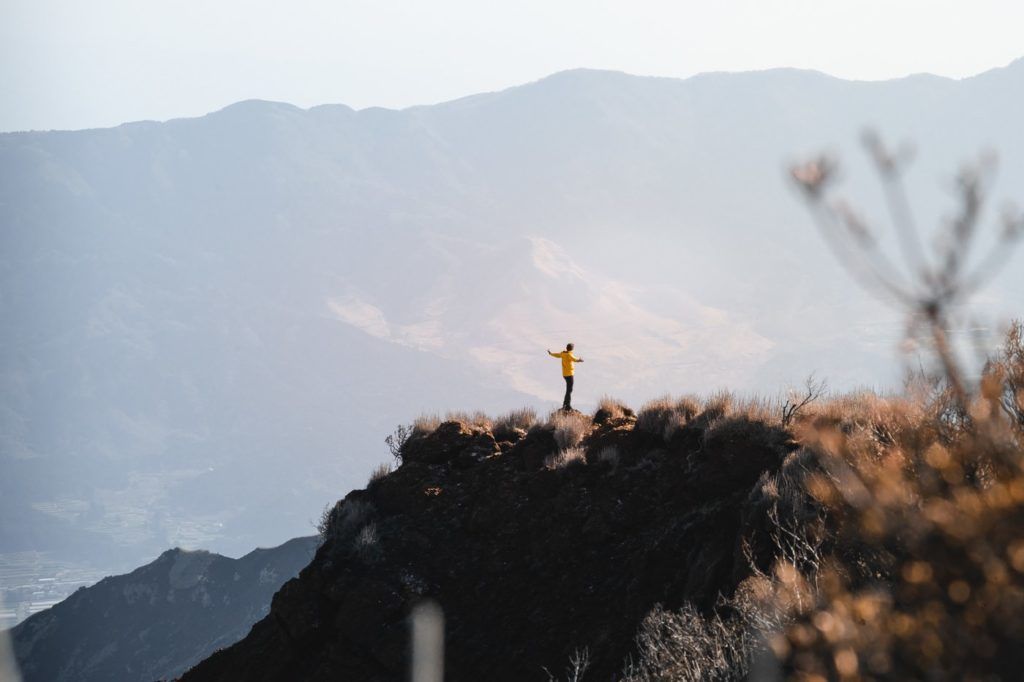
MOUNT NEKO (NEKODAKE) HIKE
Mount Neko is the second tallest peak in the Mount Aso region at 1,443m high for the Tengu Peak and the opposite Toho Peak is 1,408m high. It’s called Nekodake because from Aso it looks like two cat ears when you see both of the peaks. It was an awesome but steep hike and the jagged peaks were just incredible at the summit during sunset.
As well as the numerous ropes to help you up the summit of Nekodake, you will also encounter several ladders, helping you ascend through the forest. None of the ropes, ladders or bouldering is technical or very difficult but be prepared for a bit of action along the trail.
At the summit, you will look out across to the Tengu Peak, which is the most prominent peak and you really can’t miss it. In the late afternoon, the sun sets behind this peak so it’s a really magical spot to take in the whole ridge.
Read the full blog post for details and all photos: MOUNT NEKO HIKE (NEKODAKE) IN KYUSHU
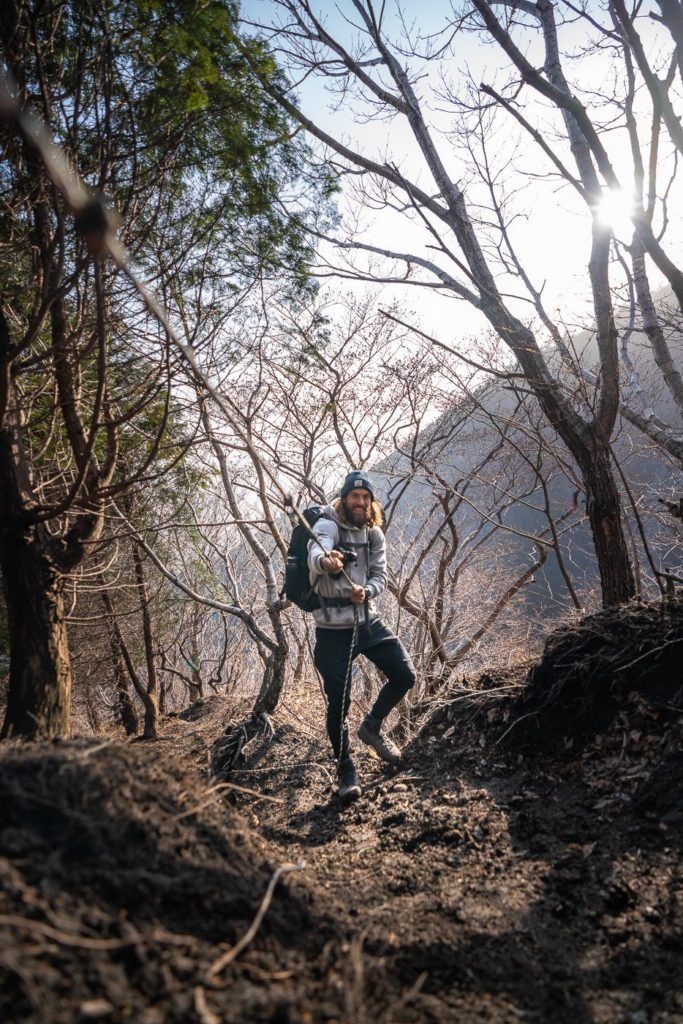
GOROGA TAKI FALLS
The Gorogotaki Waterfall is the largest falls in Yamato, Kumamoto with a 50m drop into the basin below. The beauty of this waterfall on Kyushu Island is that often it is crowned by a rainbow as the water crashed down onto the rocks, spraying up and catching the light perfectly in a stream of color. My favorite part about this waterfall is that you view it from the suspension bridge. There is also a really nice walk around the region through the rice fields and through the gorge to the base of the falls.
Read the full blog post here: GOROGOTAKI WATERFALL NEAR KUMAMOTO
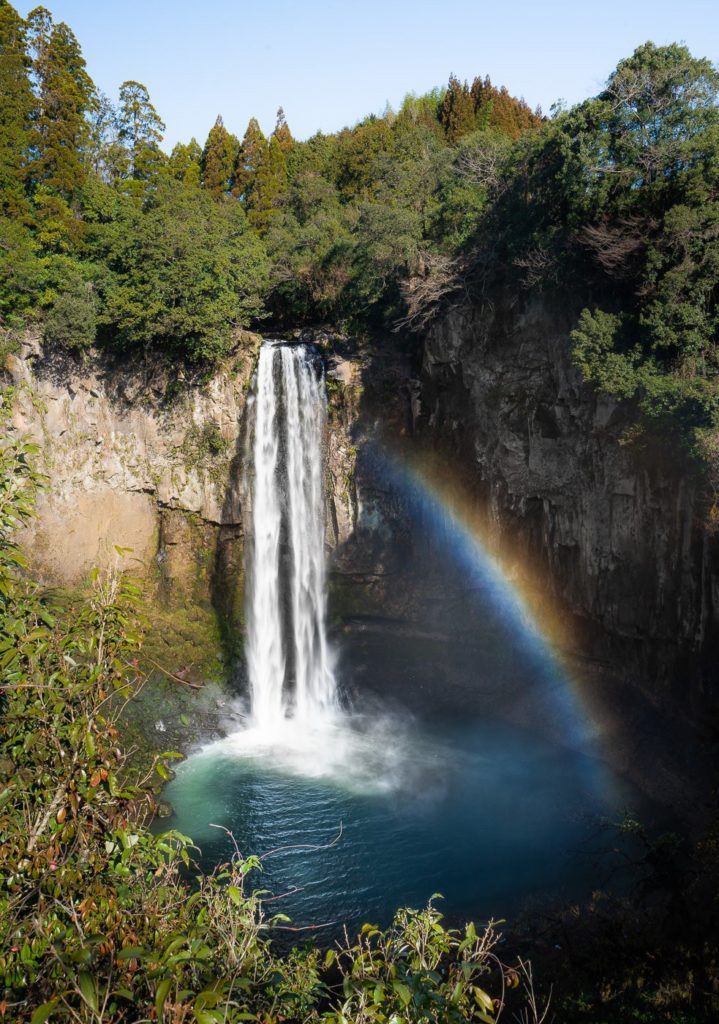
HIKING IN THE KUJU MOUNTAINS
The stunning Kuju Mount range is part of the Aso-Kuju National Park and while Mount Kuju might be the most famous it is actually the nearby Nakadake Peak that is the highest peak in the park, which makes it the highest point on Kyushu Island. These mountains are connected by a series of hiking trails so you can kind of make it up as you go, pushing on to ‘one more peak’ time and time again or following a set route. I did a bit of both.
It’s straight up from the get-go so don’t put too many jackets on you will be working that incline straight away. Once you reach the ridge it’s time for the adventure to start. The trail turns into a rocky ridgeline with a number of ladders and some very low-key bouldering required.
The total day of climbing was 1,026m so it’s always an effort when you grab a vertical kilometer. The trail was rocky but quite well defined and we never had too many difficulties finding our way. At the top of Mount Kuju, we could watch over the erupting Mount Aso in the distance and admire the valley below.
Read the full blog post for details and all photos: HIKING THE KUJU MOUNTAIN RANGE
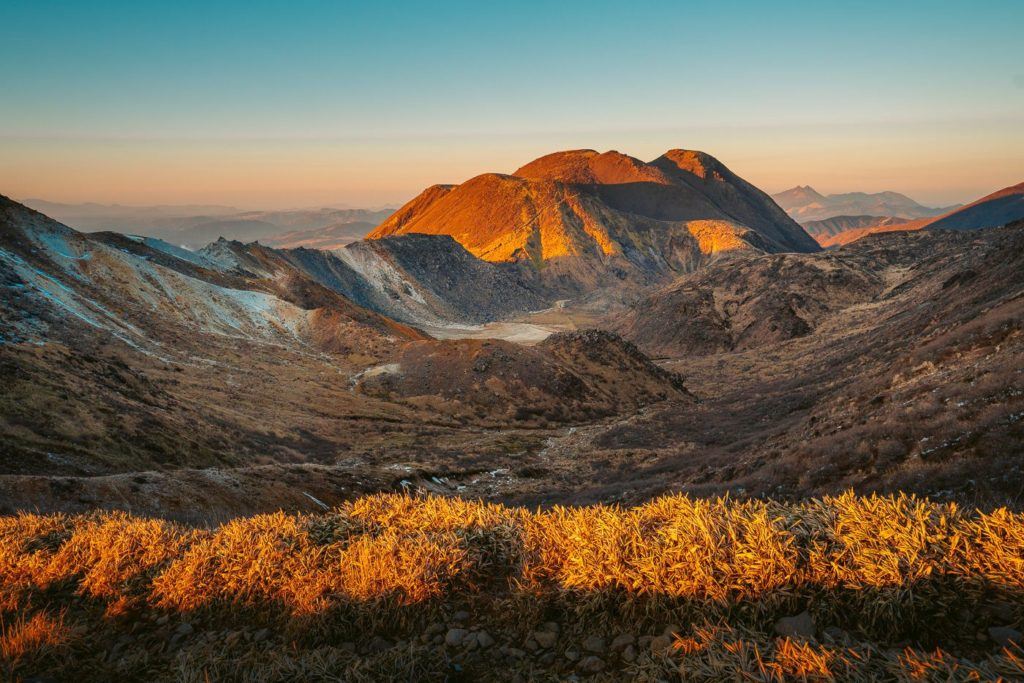
VISIT THE BEPPU HELLS
The ‘Hells’ of Beppu, as they are known, are seven incredible hot springs all in one area. Unlike many of the onsens or hot springs in the area, these specific hot springs are for viewing only as they are far too hot for bathing. They are quite a tourist attraction and it almost looks like zoo enclosures but instead of almost there is a bubbling, steaming pool of volcanically heated water. The reason these ‘Hells’ are so unique is that they each have a different feature such as the orange Hell or the deep blue Hell. I thought the experience of visiting the Hells of Beppu was quite cool but very touristy. I visited the Beppu Hells as part of this full-day tour from Fukuoka including the Beppu Hells and Yufuin Spa Town.
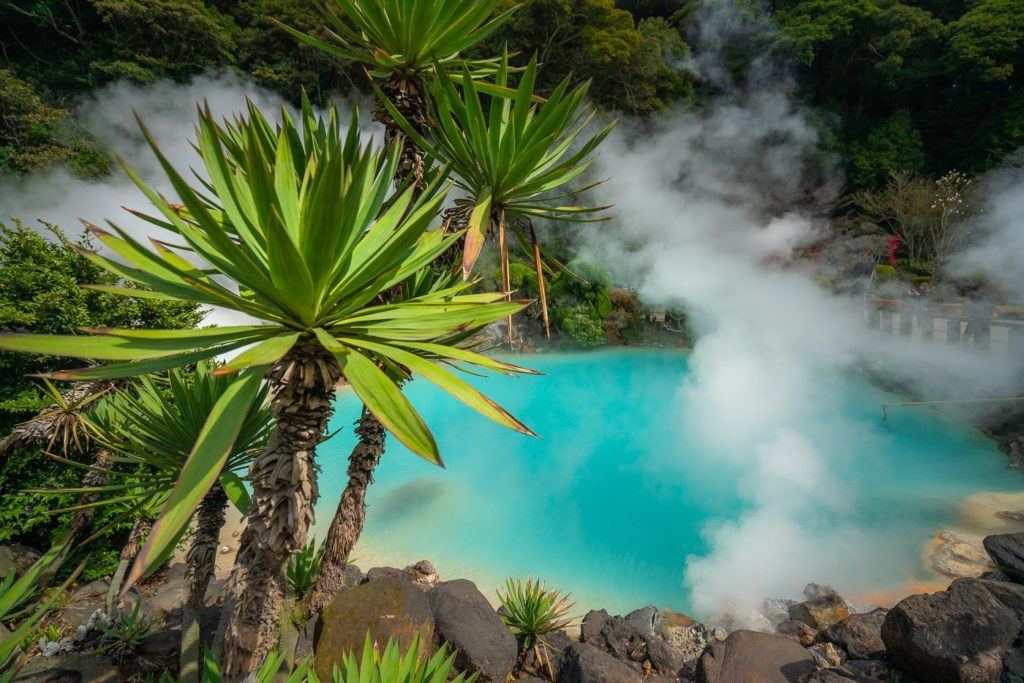
TAKACHIHO GORGE WATERFALL (Minainotaki Waterfall)
Takachiho Gorge is one of the most incredible natural attractions on Kyushu Island, Japan. In the forest of Miyazaki, the Gokase River runs through a gorge comprised of volcanic basalt columns where the 17-meter high Minainotaki Waterfall pours down on the awe-struck tourists below who are paddling the iconic rowboats through the narrow chasm.
Kyushu Island is beautiful in the summer and the fall, which are the most popular times for tourists. In the fall you get the beautiful tinged orange and different colors on the trees and in the summer you are blessed with the best weather. I visited in the winter, which was not the prettiest time as lots of the leaves were dead so there were plenty of sparse trees. However, Takachiho Gorge was at a lower elevation and in a spot that was still beautiful and green in the winter. The conclusion is pretty much that it is a year-round attraction, which will only differ slightly at various times throughout the year.
The first way to enjoy Takachio gorge and the Minaionotaki Waterfall is to paddle underneath the stone bridge and then alongside the Minainotaki Waterfall. It sprayed us a little but mostly we just enjoyed the stunning gorge, which is made of volcanic basalt columns. The columns are said to resemble the scales of a dragon where the stones were twisted when the river flowed in the formation of the gorge.
The second way to enjoy the Takachiho Gorge is from one of the many viewing points. My two favorites were the bridge and the lower (most popular) viewpoint. The bridge gives you a very elevated view of the boats and the waterfall below, framed nicely by the overhanging trees and the walls of the gorge.
TAKACHIHO GORGE DAY TOUR
As I said above, Takachiho Gorge is a bit hard to get to with public transport so unless you have rented a car, the best way to get there is on the Takachiho Gorge Day Tour . The tour includes drop-off and pickup from your hotel, an English-speaking guide for while you are at the gorge. Helen the guide is an absolute legend and we loved this tour and this epic location.
CLICK HERE to check rates and availability for the Takachiho Gorge Day Tour
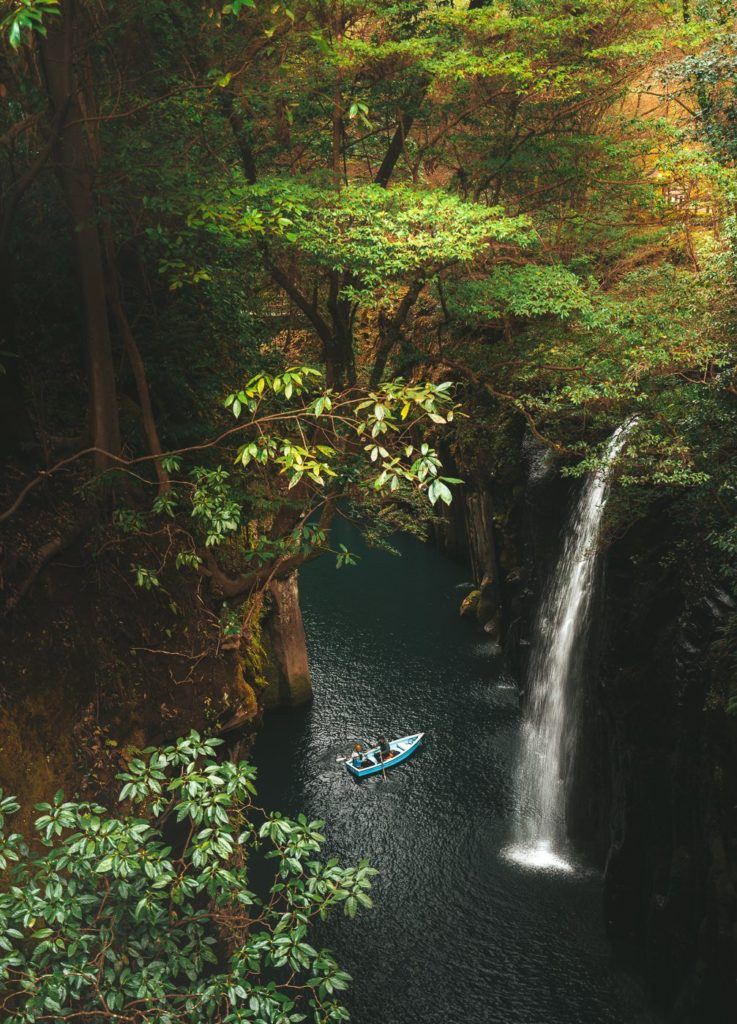
MOUNT KAIMON (KAIMONDAKE) HIKE
Mount Kaimon (Kaimondak) is an inactive volcano along the coast in the south of Kyushu known for its conical shape. The Mount Kaimon hike leads you through the forest on a steep, rocky trail up ladders and boulders to the summit where you are rewarded with coastal views from the top of the volcano.
The trail begins with an incline from the very first moment as you wind your way through the woodlands at the base of the volcano. It was a very beautiful part of the trail as the sunlight shone through the trees and into the mini canyons created by erosion on the path. At some points, the walls on either side of the trail were above head height, which added a unique atmosphere to the trail.
Read the full blog post for details and all photos: MOUNT KAIMON HIKE (KAIMONDAKE) IN KAGOSHIMA
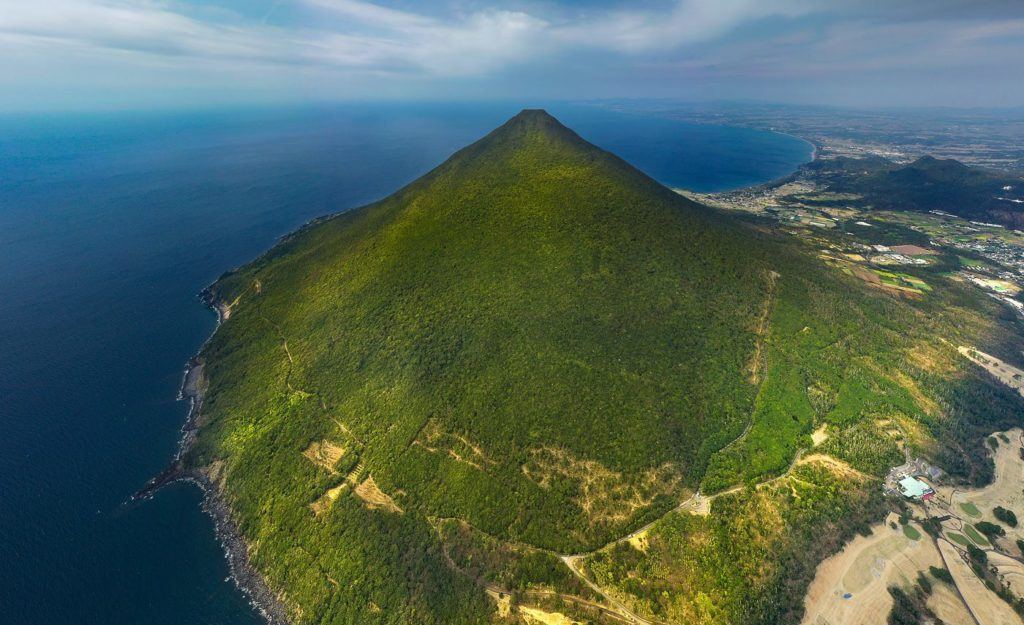
ENJOY AN ONSEN EXPERIENCE
Kyushu is famous for its hot springs and it is one of the most volcanic places in the world. It is Beppu that is at the center of this volcanic activity when it comes to onsens and hot springs with hundreds of different onsens, spa-resorts and hot springs to test out. It’s definitely an experience you want to try at least once. The general premise of an onsen experience is that you will arrive fully clothed, strip down to naked and then bathe in the hot spring water with the other locals and visitors. The minerals, temperature and meditative experience are said to be very beneficial for your health. I visited Hoyoland Onsen as they allowed people with tattoos to bathe whereas many do not due to traditional laws. There are lots of very scenic onsens to choose from but make sure you try it at least once as this is the most cultural experience you can have and one of the best things to do in Kyushu.
I didn’t take a photo at the onsen as it isn’t allowed and would be very weird as everyone is naked so I’ve added in a stock photo below to show you what it looks like.
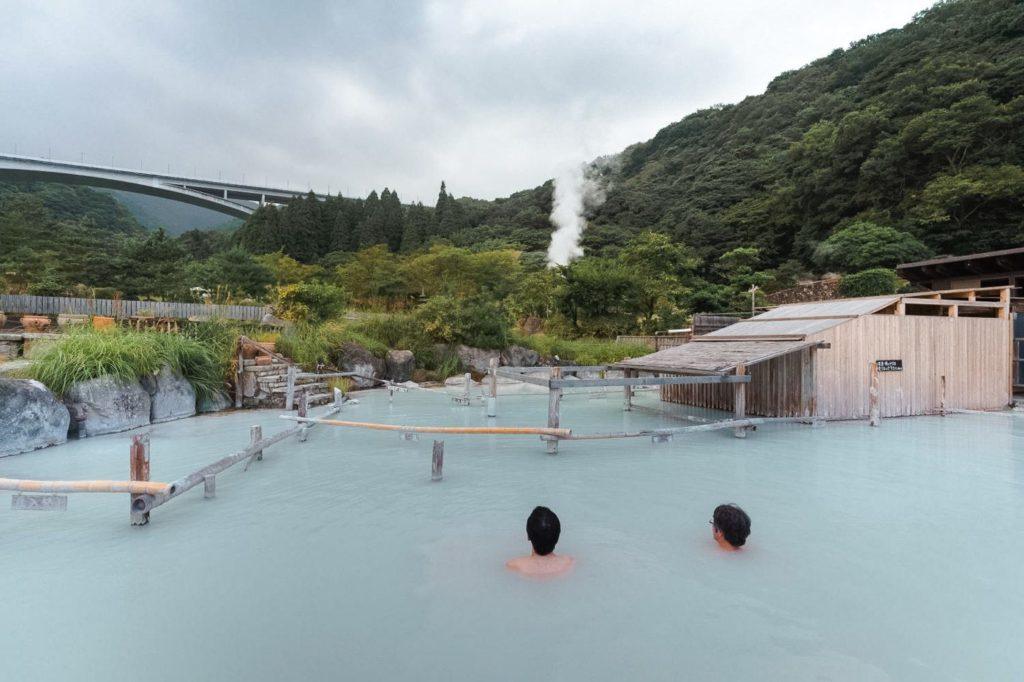
KEYA NO OTO HIKE IN ITOSHIMA
Keya no Oto is a beautiful coastal viewpoint of Itoshima, which has incredible views of the beach from the ominous ridgeline and a 64m cave below! You can hike all the way up onto the top of the ridge as there is a bit of a trail, which includes some basic bouldering/rock climbing. It isn’t a trail I would recommend unless you are athletic and adept at bouldering and climbing.
Atop the ridge, it was a very narrow path. A 50m+ drop on either side meant we had to focus on our steps until we reached a safer, wider spot on top of the ridge. We took a moment to relax up here, taking in the view of the beach and down to the volcanic cone at the other end of the coastline.
Read the full blog post for details and all photos: KEYA NO OTO HIKE IN ITOSHIMA
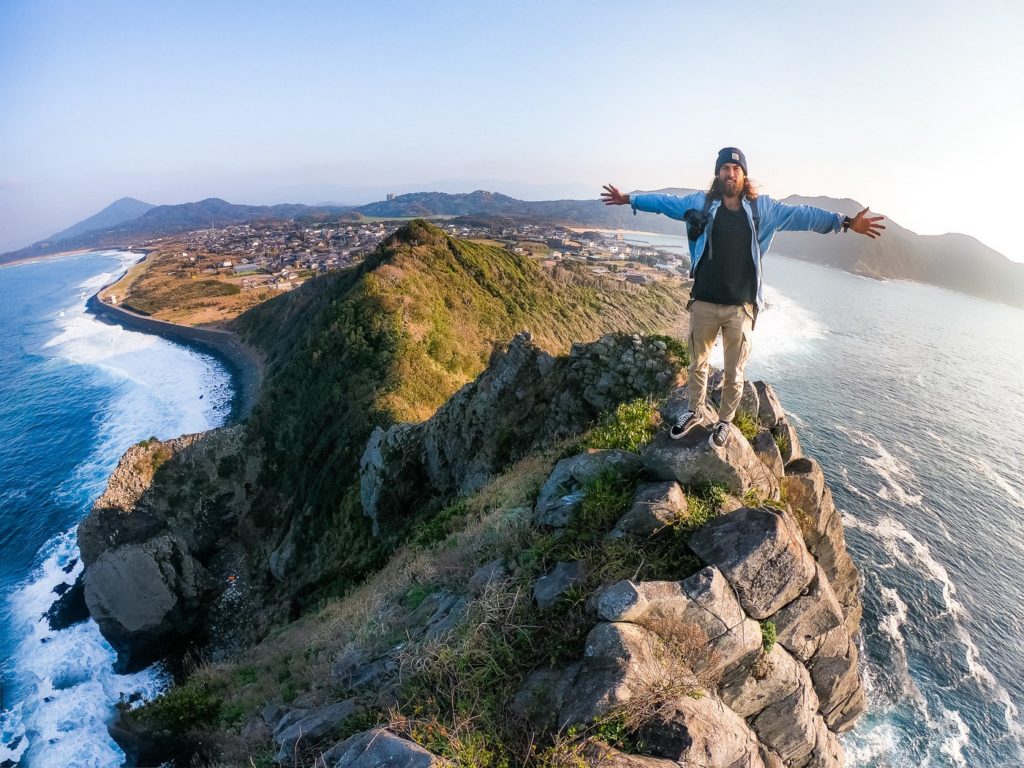
MOUNT YUFU HIKE
While I was based in Beppu I headed up for sunrise one morning to hike Mount Yufu. It’s known as being quite a tough hike due to the consistent incline and relentless switchbacks that lead you up to the two peaks at the summit. However, on the day I visited, it was covered in the cloud at the top. We saw deer along the way and really enjoyed the hike. I know the view from the summit is pretty epic so I’ve added it onto this list with a photo from a day with better weather. It was a 7km round trip with more than 700m of an incline up the switchbacks. I’ve included a photo below of the view from the top and the view from below on a day in better conditions than when I hiked. Keep in mind, it is known for being a peak that is hard to catch on a clear day so do pick the best day of the week regarding weather.
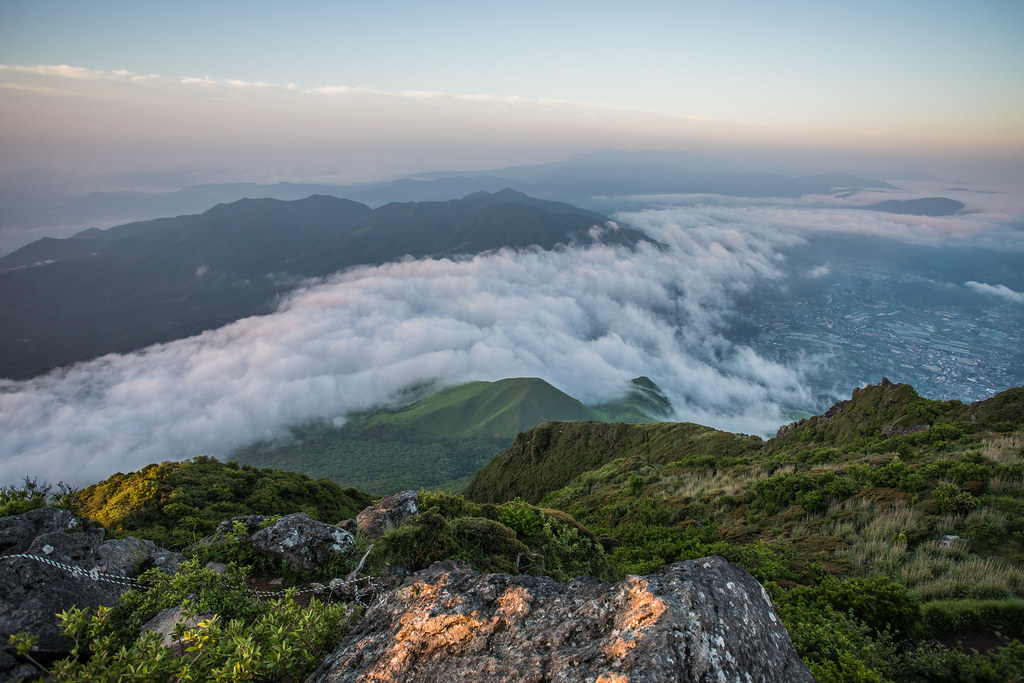
RYUMON FALLS
If you are staying near Kirishima then Ryumon Falls is definitely a spot I would recommend. It isn’t too far from Kirishima town and is a pretty epic waterfall. There is a small parking lot and then you walk about 500 meters to the viewing platform. You can go down closer to the base of the falls as well but it was a stormy, misty day when I visited and I was the only one there. I decided to just enjoy the view from the platform and snapped a photo from right there.
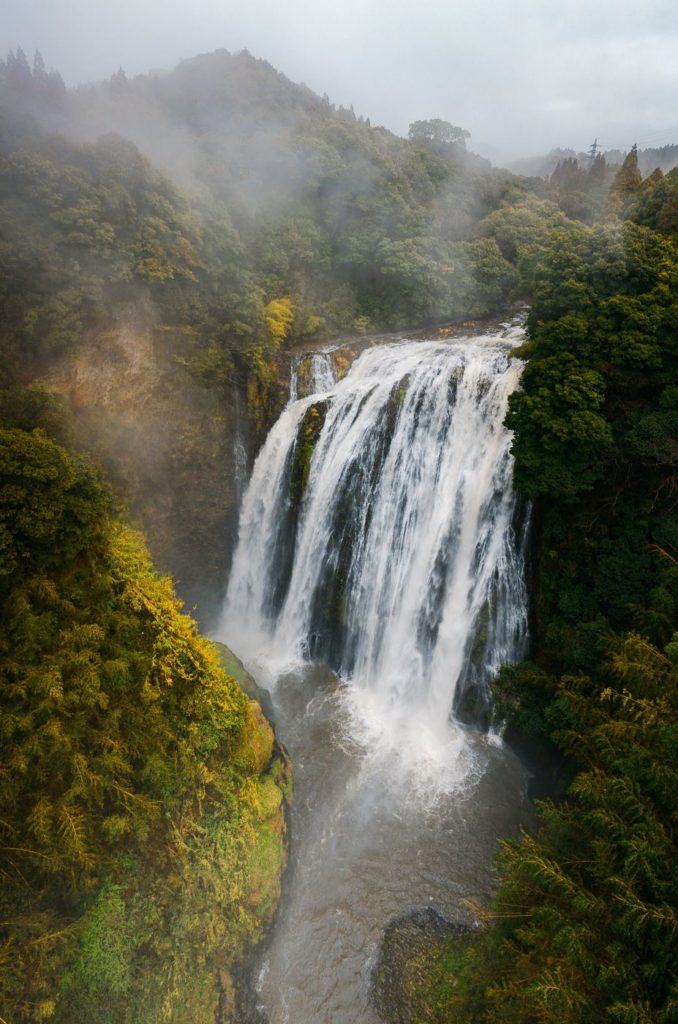
MOUNT TSURUMI HIKE
When you stay in the town of Beppu, you will always notice the mountains looming at the back of the valley. The highest point is called Mount Tsurumi and it’s actually possible to reach by cable car. However, there is a trail to the top if you are up for the very steep challenge.
Of course, if you are just in it for the view, take the cable car but for those who love the adventure and want to spot some deer along the way the trail starts just around the backside of the cable car parking. Drive an extra half mile up the road past the cable car parking and you will find the trail entrance on the right side of the road. It’s on maps.me if you can’t find it.
At the summit, you have a beautiful view down over the town of Beppu and the entire beach. Just like Mount Yufu, on the day I visited, the weather was quite poor visibility with heavy fog so I have included a photo from a clearer day so you can decide if this is a hike you are keen to add to your Kyushu bucket list.
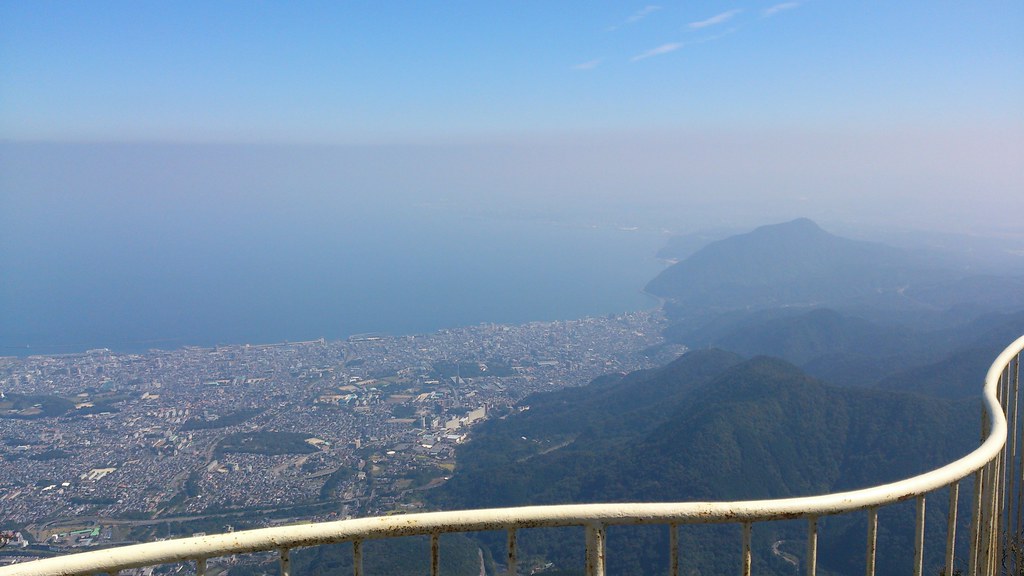
WHERE TO STAY IN KYUSHU
- Best Luxury Place to Stay in Fukuoka: Hotel WBF Grande Hakata (Value): This is by far the most popular hotel and one of the most luxurious in Fukuoka.
- Best Value Place to Stay in Kumamoto: Hotel The Gate Kumamoto (Value): Hotel The Gate is a well-situated accommodation in the heart of Kumamoto, just across the train station and within walking distance to shops and restaurants.
- Best Luxury Place to Stay in Kumamoto: Kumamoto Hotel Castle (Luxury): Set near the infamous Kumamoto Castle, this luxury hotel features a wide range of carpeted rooms from standard rooms to suites fitted with plush amenities.
For a full list of the top-rated places to stay in Kyushu, you can check out my comprehensive guide: WHERE TO STAY IN KYUSHU: BEST REGIONS & HOTELS

ARE YOU FOLLOWING MY KYUSHU BLOG SERIES?
I spent over three weeks exploring Kyushu and visited some incredible waterfalls, hiked some amazing trails, and visited a number of epic volcanoes. I created a number of guides to help travelers find the best spots in Kyushu. You can explore the articles by clicking on the links below.
- The Ultimate Kyushu Bucketlist: 30 AWESOME THINGS TO DO IN KYUSHU
- The best places to stay in Kyushu in each region: WHERE TO STAY IN KYUSHU: BEST REGIONS & HOTELS
- How to plan your Kyushu vacation: THE ULTIMATE KYUSHU ITINERARY: 5-DAY, 7-DAY & 10-DAY
- Interested in chasing waterfalls?: 12 AWESOME WATERFALLS IN KYUSHU
- Keen for some epic hiking?: 11 AWESOME HIKES IN KYUSHU
- Everything you need to know about Oita: 11 AWESOME THINGS TO DO IN OITA
- Your Ultimate Guide to Kumamoto: 13 AWESOME THINGS TO DO IN KUMAMOTO
- My favorite waterfall in Kyushu: TAKACHIHO GORGE – MOST BEAUTIFUL WATERFALL IN JAPAN
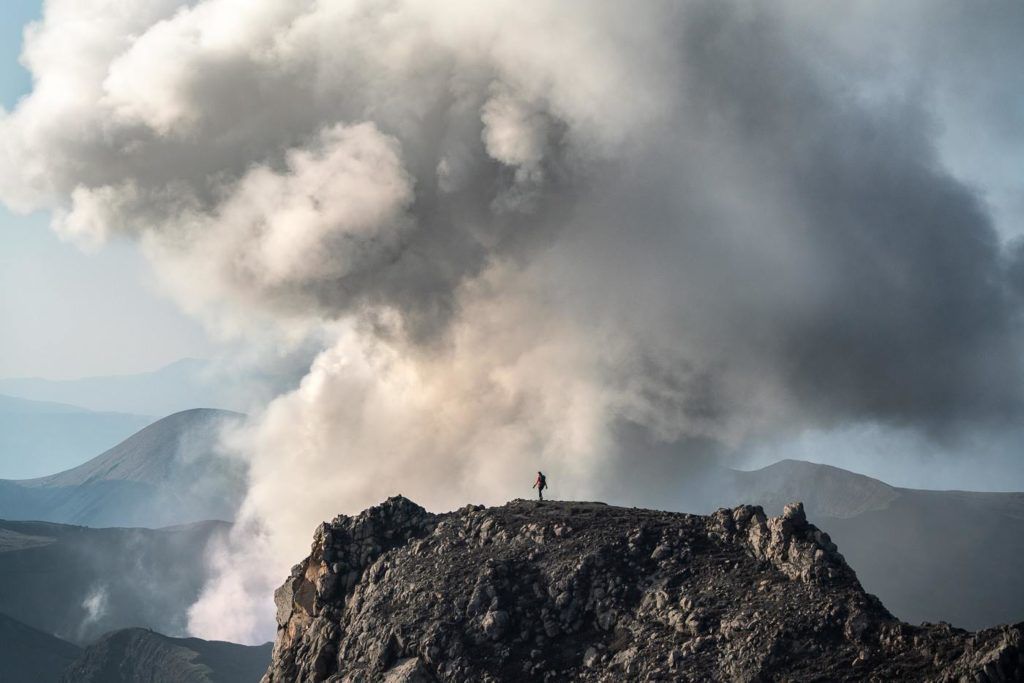
Wednesday 10th of January 2024
Thanks so much for this detailed and informative post!
Wednesday 23rd of August 2023
Heyo! I'd love to do this but I'm going in January, what month did you go in and would you say January might be too cold?
Tuesday 7th of March 2023
Looks great! Based on your blog, we decided to spend a week in this area next month! Do you remember where you rent a car as nothing looks availbe to me :(?
Sunday 1st of November 2020
Thank you for sharing your information about Kyushu and suggestion for sightseeing. Great job

Girl Eat World
A girl's adventure in food and travel around the world, 7-day kyushu itinerary: where to go and what to see in kyushu.
The hardest yet most exciting part of traveling is often the planning stage and narrowing down where to go given the time you have. I visited the Kyushu region in Japan this past September. This is how I planned (and nearly failed to follow said ambitious plan) for the trip!
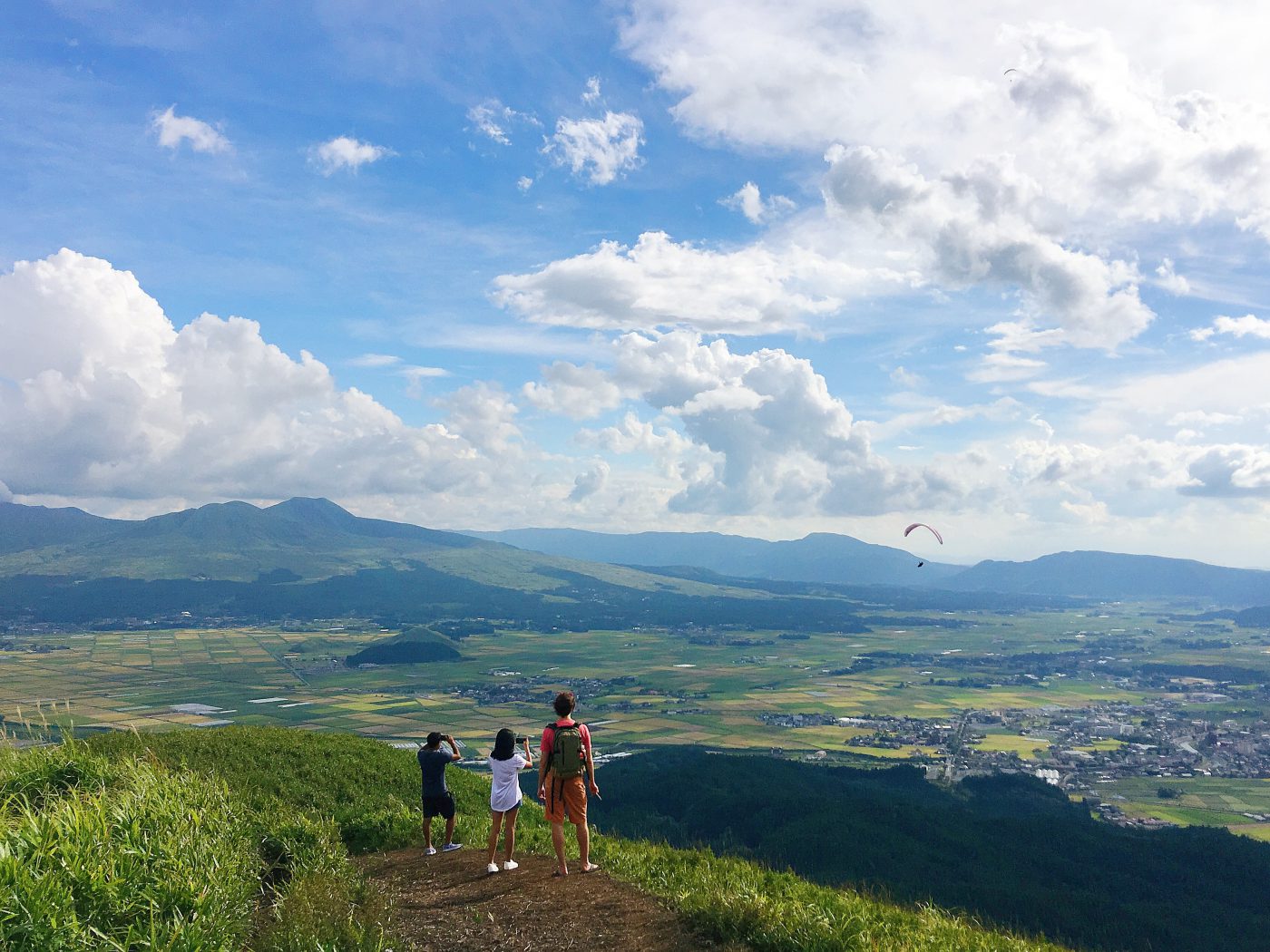
Tips for planning Kyushu Itinerary
Narrow down the city you want to visit – Kyushu is a huge region, and if you have limited time, you need to narrow down the experiences you want to see. No joke – whenever I am in a trip planning mode, I would open up google maps and see if there are any familiar names in the vicinity. I immediately zeroed in on the familiar cities: Hiroshima (not really in Kyushu but it’s very close), Fukuoka , Nagasaki, Kumamoto , and Kagoshima.
Plan out the order to visit the places you want to go to – Once again, I used google maps to see where each place are in relative to each other, then I checked the train routes to map out the best ways to travel between these cities and how long the journey would take. Once I’ve done this, it became clear that we needed to make Fukuoka our base since it’s the center point of the cities we’ve picked.
Yes, You WILL need a JR Pass! JR Pass is the train pass that allows you to take intercity trains in Japan for cheaper. The sights to see in Kyushu are spread apart in different cities, so unless you’re planning to only visit one city, you will definitely need the JR Pass as you’ll likely be using the train to move around. You can buy Unlimited JR Pass or JR Kyushu Pass . Scroll down to the end of this post for more information about the JR Pass and which one is more suitable for you.
You must buy the JR Pass from outside of Japan before your trip . The JR pass is solely for tourists and it used to not be available for purchase within Japan, though there are now limited quantities for sale in Japan for a higher price. You should still buy it ahead of time to make sure and have it sent to your home before your trip, so make sure you get it way ahead of time so that it arrives before your trip.
Check the first and last train out of the city – I also checked for the first and last shinkansen out between cities so that I know the earliest time I can get to a city and the latest time I can leave. This helps me narrow that what activities I can do in the city.
Account for travel fatigue – I have to admit I got over-excited when I planned for this trip. I was really intent on hitting up all 5 cities in 7 days. My biggest advice here and a lesson I had to learn is to account for travel fatigue. You can’t feasibly be moving every other day and not get tired by the end of it. All of the cities I mentioned above are great destinations that I don’t want to miss – but it is very ambitious to hit up all five in 7 days. I had to sacrifice visiting Kagoshima since it isn’t convenient to get to if I want to also include Nagasaki in the itinerary.
My 7-Day Kyushu Travel Itinerary
In the end, after all the research, this is the Kyushu itinerary I went with:
- Day 1: Hiroshima . Land in Osaka in the morning, go to Hiroshima immediately, and spend all day in Hiroshima.
- Day 2: Fukuoka . Travel to Fukuoka in the morning, then spend time in Fukuoka All-Day
- Day 3: Nagasaki . Travel to Nagasaki in the morning and spend the rest of the day in Nagasaki
- Day 4: Stay in Nagasaki All-day
- Day 5: Nagasaki & Fukuoka . Spend time in Nagasaki in the morning, then go to Fukuoka in the afternoon.
- Day 6: Kumamoto Day trip
- Day 7: Spend time in Fukuoka in the morning, Fly back to Singapore in the afternoon
What to do and where to go in Kyushu, Japan
Here are some places you can consider visiting in Kyushu:
1. Fukuoka (2 days)
Fukuoka is the biggest city in Kyushu. It’s a great starting point for Kyushu – lots of direct trains leaving Hakata station, the main station of Fukuoka. Aside from that, they are also known for food! Yep, the Hakata ramen is actually from Fukuoka! You can read about the food in Fukuoka and Yatai stalls here .
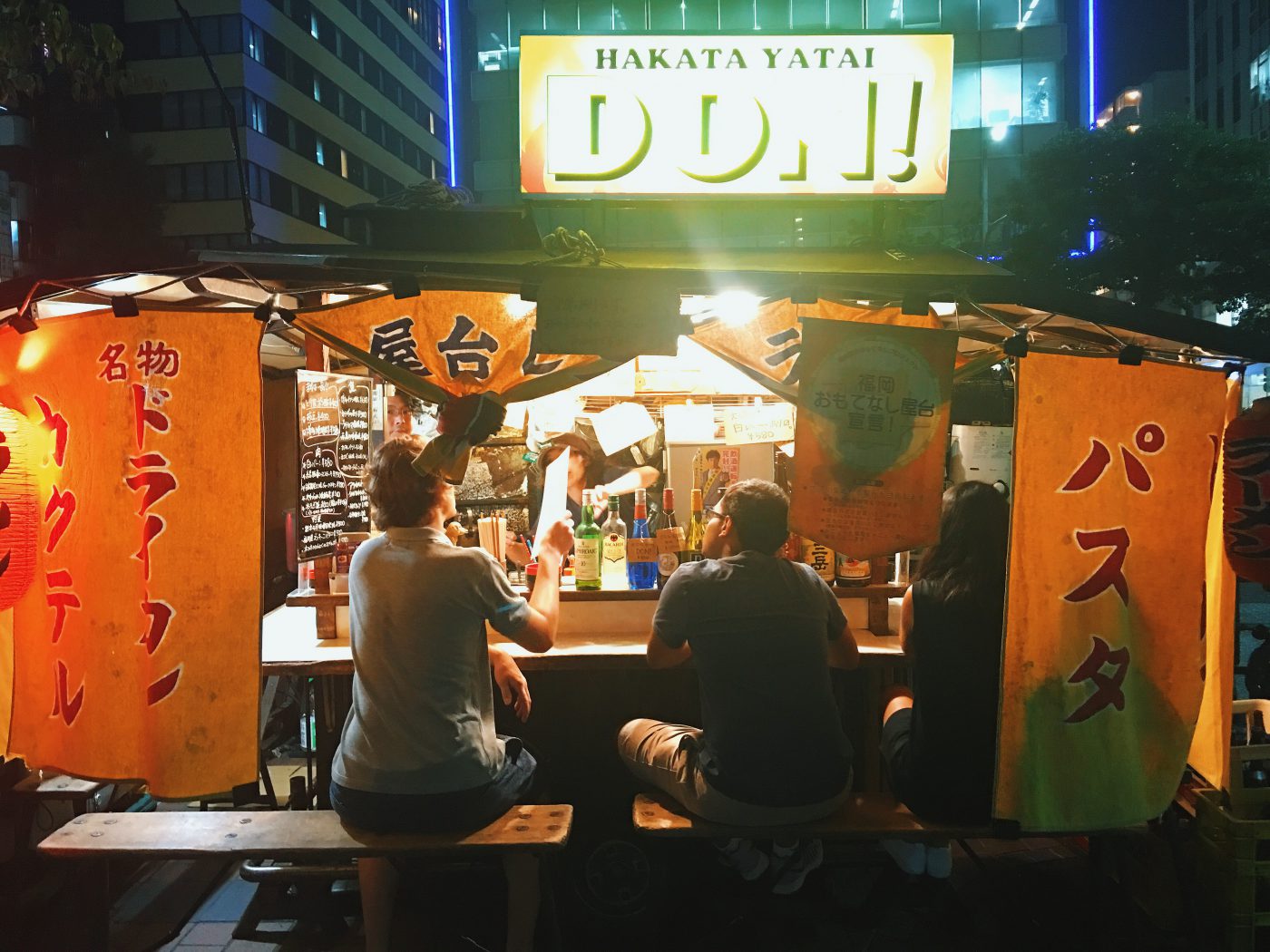
2. Nagasaki (2-3 days)
Nagasaki needs no introduction, the city offers an extensive insight into Japan during the World War II period. Although they are mostly known for its bleak fate as the site of the second atomic bombing, Nagasaki holds an important place in Japanese history. During the era of seclusion called Sakoku, the Japanese were forbidden to leave the country, and the only foreign trade allowed within Japan was done through a manmade island in Nagasaki, called Dejima. Nowadays you can see history from the seclusion period as well as the era that follows after – the Dutch, Portuguese and Chinese influences from the 16-19th century when Nagasaki becomes the only open port in Japan.

3. Kumamoto (Day trip from Fukuoka)
In 2016, Kumamoto was hit by a series of very strong earthquakes. However, it’s still interesting to see the city after the earthquake. The Kumamoto castle, for one, was able to sustain the strong 7.0 earthquake, just as its Japanese architects had intended when the castle was built four centuries ago.
You can also do a road trip or tour to Mount Aso , one of the most beautiful areas in Kyushu. Kumamoto is a very doable day trip from Fukuoka. Read about my day trip to Kumamoto from Fukuoka here .
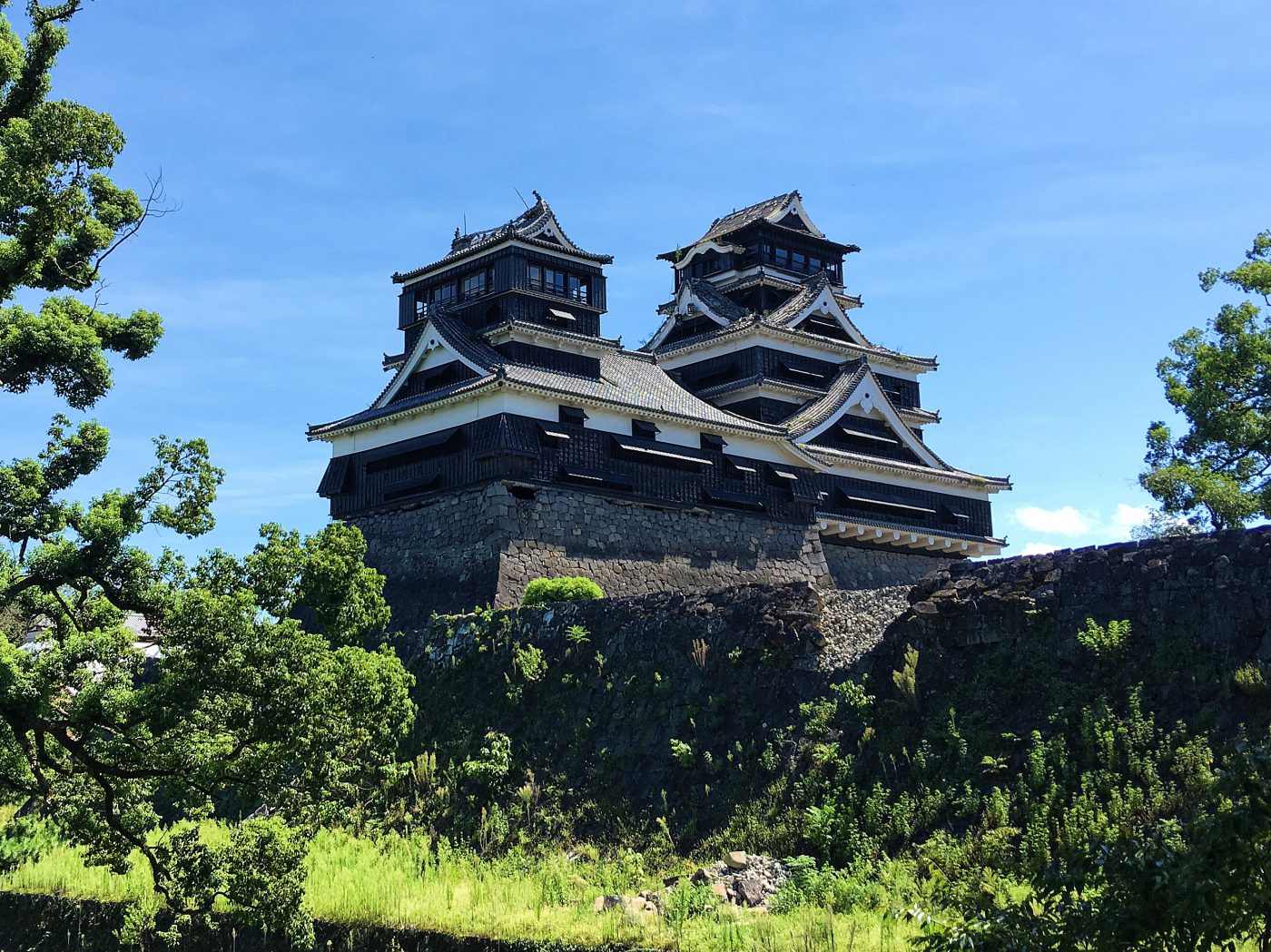
4. Kagoshima (1-2 days)
I did not make it to Kagoshima due to limited time in Kyushu, but I wish I had made it down here. Kagoshima is a seaside city in Kyushu and is best known for Sakurajima, a volcanic mountain often referred to as Japan’s Vesuvius. Aside from that, Kagoshima is also well known for its food and produce – most notably, the Kurobuta aka black pig, which is highly regarded in Japan for being high in protein and low in calories. Kurobuta is normally eaten in shabu-shabu style, aka Japanese hot pot.
If you have time and are interested in nature, you can also visit Yakushima, an island off the coast of Kagoshima. The island is covered in cedar forest that contains some of Japan’s oldest living trees – some as old as 7,000 years.
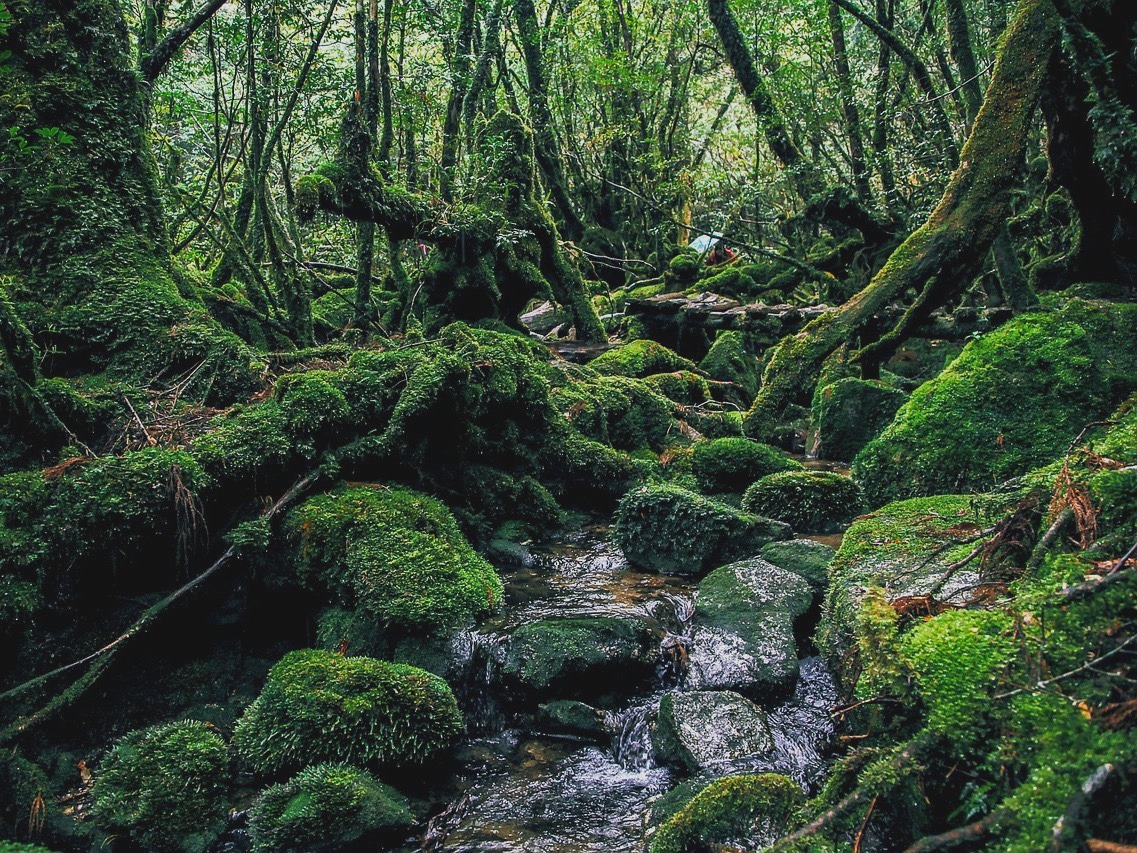
5. Beppu (1 day)
Beppu is a spa resort town, known for its range of onsens (Japanese hot springs) – they have over 2,000 onsens in Beppu! Aside from the usual hot springs, they also have sand baths, mud baths, and steam baths. You can relax in one of the Japanese’s favorite past times – a bath in the hot spring and eating Onsen food after. You can reach Beppu by train from Fukuoka, but if you’re a true Onsen enthusiast, you might want to check out this Beppu and Yufuin Onsen spa tour , which includes hotel pick-up and drop-off!
Booking Accommodations in Kyushu
Tips for booking hotels.
- Book ahead of time – Sometimes I like to “wing it” and book accommodations last minute in the spirit of being spontaneous. I quickly learned this isn’t a very smart move when it comes to visiting Japan, as the good hotels get booked up really fast.
- If you are a non-smoker, pay attention while booking and make sure you tick a non-smoking room in the room type section. Smoking indoors is not illegal in Japan, so some hotels would segregate smoking and non-smoking rooms by floor. I had to stay in a smoking room in Nagasaki because I booked a smoking room by mistake and they had no more non-smoking rooms 🙁
- As we are traveling heavily by train, I find that staying at hotels that are on the main station itself (the station where the shinkansen line stops) really helped us during traveling days since we don’t need to worry about the logistics of getting to the train station. As a bonus point, these areas also tend to be very convenient since in Japan the main station would also come attached with all the amenities like convenience stores, major stores for shopping, and restaurants.
Kyushu Hotel Recommendations
Here are the hotels we stayed in each city. Each of these is very close or attached to the main station of the city, so they are located in a really good location.
- Hotel Granvia Hiroshima is literally on top of the Hiroshima station. Despite this, it was not noisy since the hotel rooms are located high up and they are good with noise insulation.
- JR Kyushu Hotel Nagasaki – yes, JR as in Japan Rail. Nagasaki station is quite small and the lobby of this hotel is right outside the exit of the station!
- Nishitetsu Hotel Croom Hakata , next to the Hakata Central station in Fukuoka – about 5 minutes walk. I ended up staying here because my first choice was booked up.
- JR Kyushu Hotel Blossom Hakata Central – This was my first choice for Fukuoka, but it was booked up during my visit! It would have been really convenient because Hakata is a major station with all the convenience stores, shopping, and restaurants.
Using JR Pass in Kyushu: The FAQs
I have been to Japan many times before, but I’ve never used the JR pass. Getting a JR Pass only makes sense if you are moving around from city to city, it didn’t make economic sense to get the pass. But when visiting Kyushu, there is a big chance you actually need the JR Pass since the attractions in the Kyushu region span many cities.
What is JR Pass exactly?
JR pass is a form of rail pass that gives you unlimited access to all JR trains in Japan for 7, 14, or 21 days. I bolded the JR train part for emphasis since this gets confusing for some people – in Japan, there are many train companies and Japan Rail (JR) is one of them, and this pass is only valid for JR trains!
If you are coming to Japan, you HAVE to have already bought the JR Pass before your trip, from outside of Japan. The pass CAN NOT be bought from inside of Japan.
Which JR Pass do I need?
If you are planning to go all over Japan, you might want to get an unlimited pass. You can buy the unlimited JR pass here, which can be valid for 7, 14, or 21 days depending on the length of your trip.
However, if you are just going to places in the Kyushu area and your travel schedule fits within 3-5 days, then you can take a look into the JR Kyushu Pass since it’s much cheaper than the unlimited JR Pass.
I found this page to be very useful in terms of pass validity information. Since I was in Kyushu for 7 days and will be moving around a lot, it made sense for me to get the 7-day ticket for 29,110 yen (US$260), even though it was more expensive.
How do I find out the train schedules?
Surprisingly, the most user-friendly way is through Google Maps ! Use the public transport filter (The icon that looks like a train) and play with the “Depart at” filter to see the next train available from point A to B. I find their schedule to be quite accurate. Other than that, you can go to the station and look at the schedule there or use local websites like HyperDia .
Which Shinkansen train can I use with JR Pass?
Shinkansen is the famous Japanese bullet train. It is a much, much faster way to travel than taking a regular train and thus it became the preferred mode of transport for tourists and locals alike.
There are different types of Shinkansen trains running on the same route. Most of the time you don’t have to worry about it since they are all the same, and will get you from point A to B. However, in Kyushu, if you want to use your JR Pass you cannot take Mizuho or Nozomi trains . During my trip, I took mostly Sakura and Haruka trains.
How do you know which train is what type? You can tell the type of trains by looking at the schedule at the train station itself. If you are looking at Google Maps, it is the colored label next to the JR Logo. For example:

The screenshot above is a sample route from KIX to Osaka. In this case, this Shinkansen type is the blue ribbon with the JR logo next to it, which is Haruka . Since it is not Mizuho or Nozomi, you can take this train on JR Pass.
Cool, so how do you use the JR Pass?
First, a voucher for a JR pass must be purchased from outside of Japan , so you have to sort this out before you go on your trip. Once you have arrived in Japan, and on the day when you want the pass to be activated, you trade in the voucher at any major JR station for the actual pass.
The pass looks like this:

Once you have received the pass, you have to keep it with you for the duration of your travel and must always bring it with you when you do a train journey. Don’t lose your pass! It’s like your passport to take the train in Japan.
Also, whenever you want to use the JR pass, you don’t go through the automated gate like everyone else. Instead, you walk up to any JR station gate and show your pass to the ticket officer, usually to the left or right of the automated ticket gates.
Tips on how to travel on unreserved seats on Japanese Trains
JR Pass allows you to reserve seats for free, but in case you ever need to take unreserved seats (which is cheaper when you aren’t on JR Pass), such as if you are traveling with a friend who does not have JR Pass, here’s what I have learned from my experience:
1. Make sure you know ahead of time which cars are designated for unreserved seating
The digital signboard at any major Shinkansen station tells you all the information you need. It flips between Japanese and English, so don’t worry if you can’t read Japanese! Just wait a few seconds until it flips to English.

Things to note here are the Non-Reserved car indicator on the far right. In the picture above, it’s Cars 1-3. Also note the train type to the left of it, usually 8 or 16 cars. In the picture above it is 8 cars. I’ll explain why later.
2. Plan to line up 15-20 minutes before the schedule
During peak travel time it is entirely possible you might not get to sit next to your travel buddies when the train is full. Or worse, you may not get a seat at all! I have seen people standing up in the space between train cars. So to avoid this, allocate some time for lining up ahead of the scheduled train arrival time.
How do you line up properly in Japan? Easy! Get to your train platform and look down on the floor to find out where you are supposed to line up – usually, there would be a mark that looks like this:
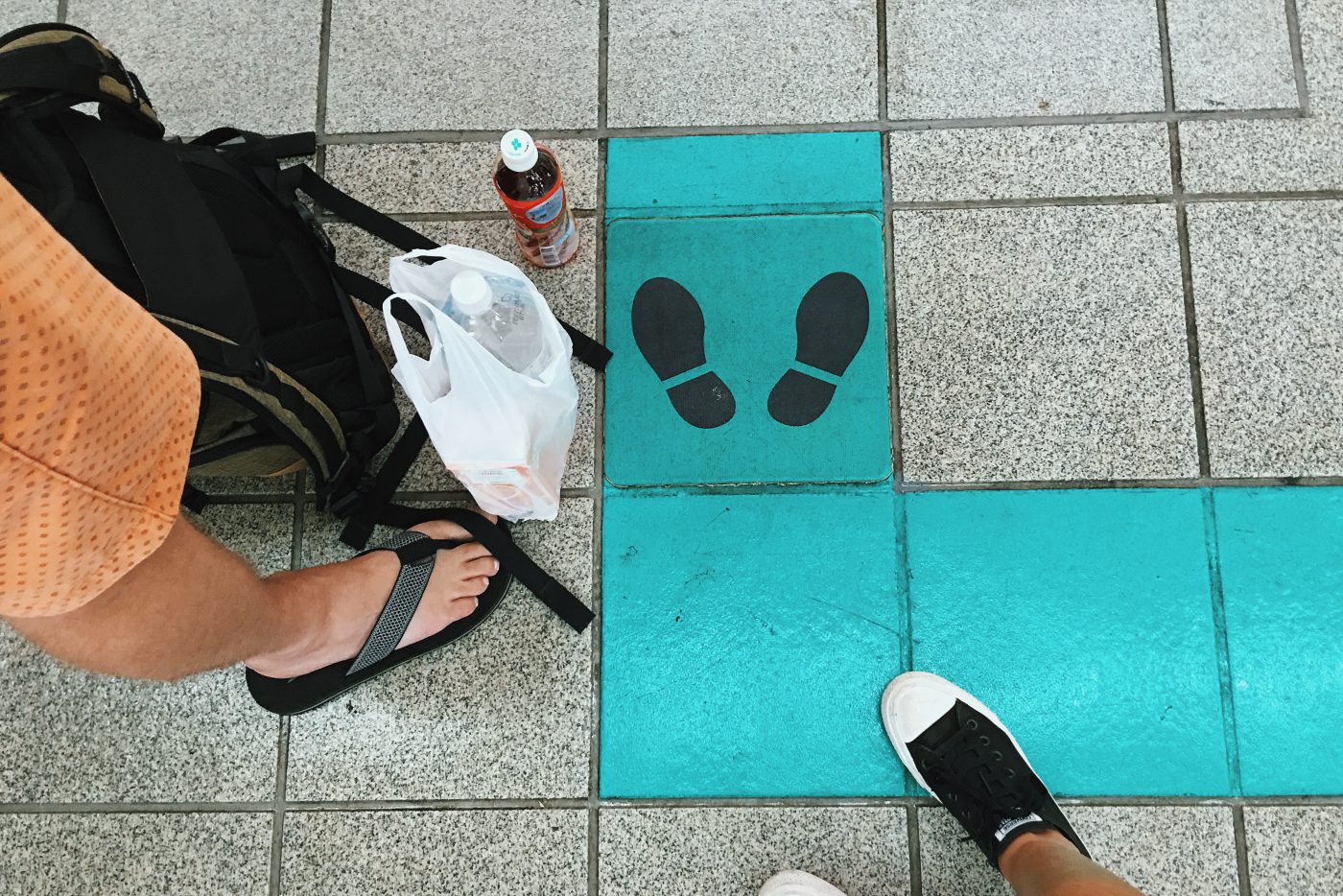
3. Find out where exactly you are supposed to line up
Remember when I said to note the Non-Reserved car numbers and train type ? This comes in handy when you need to find out where the train will stop, so you know where exactly to line up. On the floor, they would normally have something a sign that looks like this:
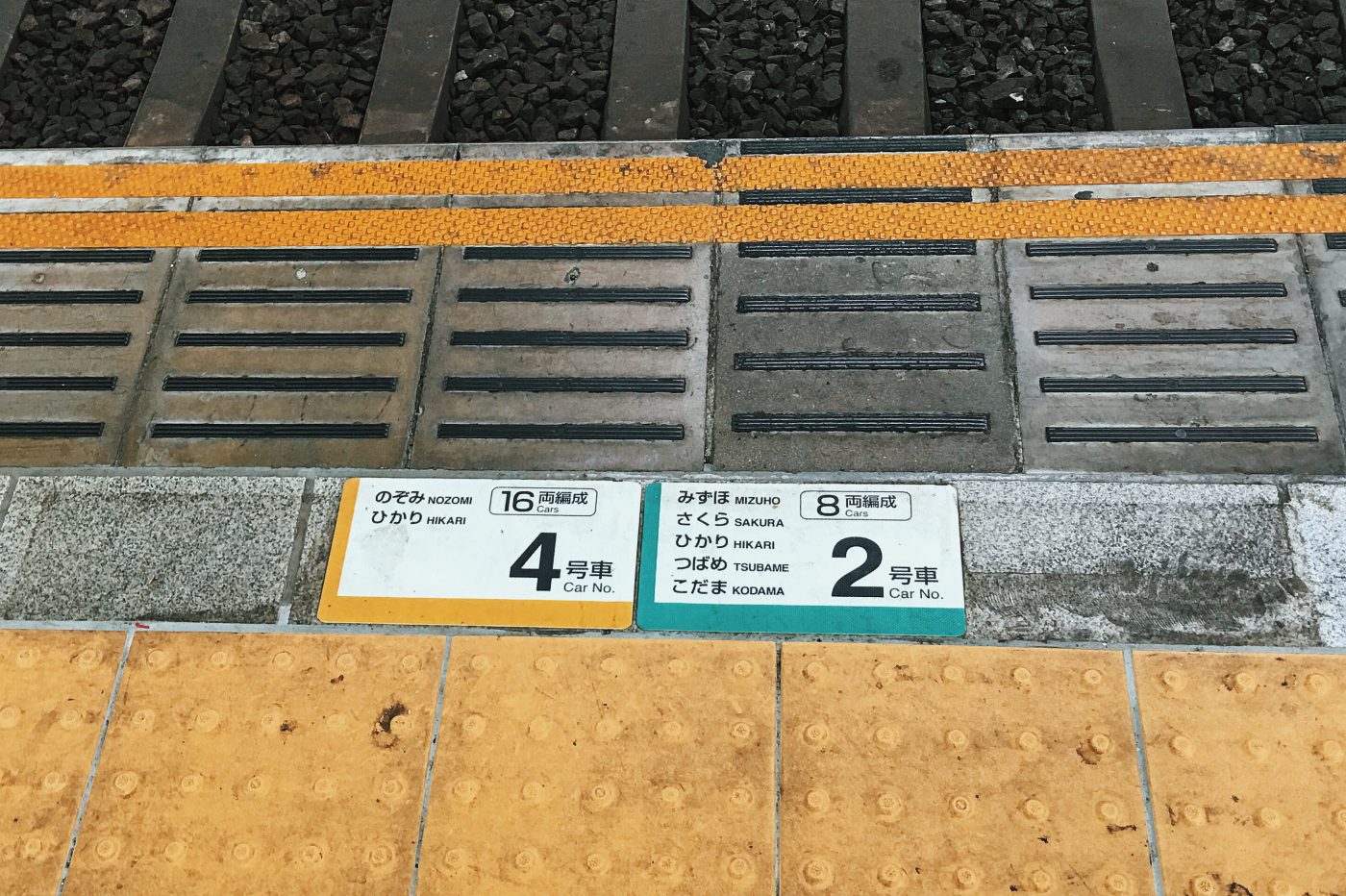
This is when the train type matters – whether it’s 8 or 16 cars or whatever number. In the picture above, if your train is an 8-car train then you look at the green box. But if your train is a 16-car train then you look at the yellow box. So just match up the car numbers to the Non-reserved cars from the signboard to make sure you are lining up at the correct spot designated for unreserved seats. When the train comes, the door will open up exactly at this spot!
That’s all! It might seem complicated, but after doing this a few times it’s pretty easy 🙂
Are you planning a trip to Japan? I’ve written loads about the beautiful country. Check out the ‘Japan’ category of this blog for some travel inspiration.
23 Comments
- September 14, 2023
Hi and thanks for this article, it’s very informative. Just wondering, if you follow your day 1 arrival in Osaka then back to Singapore on day 7 from Fukuoka? Then what rail pass you need to use from Osaka-Hiroshima and Hiroshima-Fukuoka? Thanks again
- March 15, 2023
THANK YOU!! I am SO glad I read this, especially about the shinkansen, how to work out the unreserved cars and also where to line up. There is just so much to know, I’d be lost if I hadn’t read it. Plan to go in May with my son. I can speak Japanese but am still overwhelmed by all this. Hope I get it right!!
I’m glad it helped you, Helen! Just note that if you travel with JR Pass you can reserve seats at the train station, so you won’t need to go on the unreserved car.
- April 26, 2020
Hello! This is actually quite informative. I’ve been to Fukuoka too, but I think I’ve missed out a lot of places once I’ve read your blog. Haha!
- January 7, 2020
Hello Melissa, what a wonderful blog!! I really like the way you present Japan in such a natural way. If you ever come back to Kyushu, let me show you around my hometown, Kobayashi. Kobayashi is in Miyazaki, so most travellers with limited time don’t put it on their list. But it is more than worth a visit! The Kirishima mountains are great for hiking and the lack of tourists makes for a very authentic Japanese experience. I’d be happy to help you with planning your trip or take you to the mountains or the other fabulous sights in the area.
- December 9, 2019
Hi Melissa, Did you buy subway pass for travel in Fukuoka? Was it useful or convenient to visit tourist sites around Fukuoka? Please advise.
Hey Soo, I didn’t buy travel pass in Fukuoka since we were mostly using it as a base for nearby attractions.
- October 4, 2019
Hi, good article but I do believe if you’re from Osaka and only going up (down to) Kumamoto in 7 days, you should consider the Sanyo san’n pass instead. 7 Day JR Sanyo-San’in-Northern Kyushu Area Pass Obtain your Exchange Order in prior by delivery / pick up, activate your 7 consecutive days rail pass that covers unlimited rides from Osaka/Kyoto to Northern Kyushu at a great price https://www.klook.com/activity/5769 It is not only save you a bit of money but also allows you to take faster Sanyo shinkansen which is not allowed only using ordinary JR Pass.
- September 14, 2019
Hi Melissa,
Have you been to Oita and Yufuin before? are both of these places near to beppu?
- September 15, 2019
Hey Ellisha, I haven’t been to those places unfortunately, but they are very close to Beppu.
- July 1, 2019
can i just buy the train tickets without having a JR pass? do they sell it over the counter?
- July 2, 2019
yes they sell tickets over the counter at the station at regular price
- May 15, 2019
Hi, if I am scheduling to hang around in Fukuoka area for 5 days only. Which pass are you recommending to me? JR Kyushu Pass or JR Pass? Tq
- May 16, 2019
depends on your travel plan, but if you are only going to be in Kyushu then JR Kyushu will be sufficient.
- May 13, 2019
Hi! How much did you spend for the entire tour?
Can i rearrange the line up? Example will start in Kagoshima on Day 1 and so on?
- May 14, 2019
Hey Kaye, This was so long ago that I unfortunately don’t remember the budget. I think we spent less than $1500 per person though including flight from Singapore which was about $700. You can definitely rearrange the line up, as long as you are ok for long travel on Day 1. Kagoshima is located the furthest down from Fukuoka.
- January 30, 2019
hi thanks 4 sharing. hope you’ll explain more abt fukuoka n nagasaki soon becoz i’ll be there on april. and i need extra info for my iti. tq
- July 2, 2018
Thank you for the article. Very clearly written
- March 13, 2017
Just wondering why you didn’t get the JR Kyushu pass instead?
i think its because i needed it to be valid for 7 days
- November 21, 2016
Nice article! Wish to have JR pass experience. Thank you Melissa.
- November 14, 2016
Yes! They are very exact and punctual too!
last photo its so curious and funny. Train really stop in the place??
Leave a Reply Cancel reply
Your email address will not be published. Required fields are marked *
Save my name, email, and website in this browser for the next time I comment.

- PLAN MY TRIP
- All Destinations
- Discover Hokkaido
- Discover Honshu
- Discover Kyushu
- Discover Shikoku
- THINGS TO DO
- Japan Travel Deals
5 Days In Kyushu: An Unforgettable Itinerary
2 comments
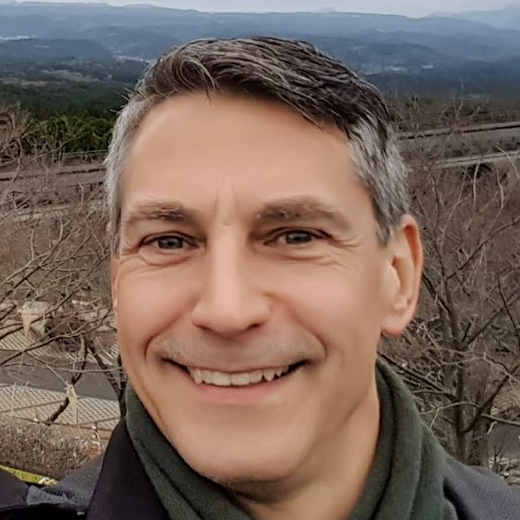
ACROS Building, Fukuoka
Day 2: Fukuoka
Activity: Stroll around Ohori Park (walk across bridges connecting three islands in a large lake) Lunch: Restaurant Mizutaki Nagano (top quality, proper nabe, reservations essential) Coffee: Cafe 'Knock' (run by an 89 year old lady for more than 40 years) Buy: Traditional sweets from Ishimura Manseido Deitos (gorgeous original shop and sweets)

Dinner: Restaurant Yossou ( chawan mushi - steamed egg custard specialist, incredible pork) Stay: Hotel Forza (rated #1 hotel in Nagasaki on Trip Advisor)
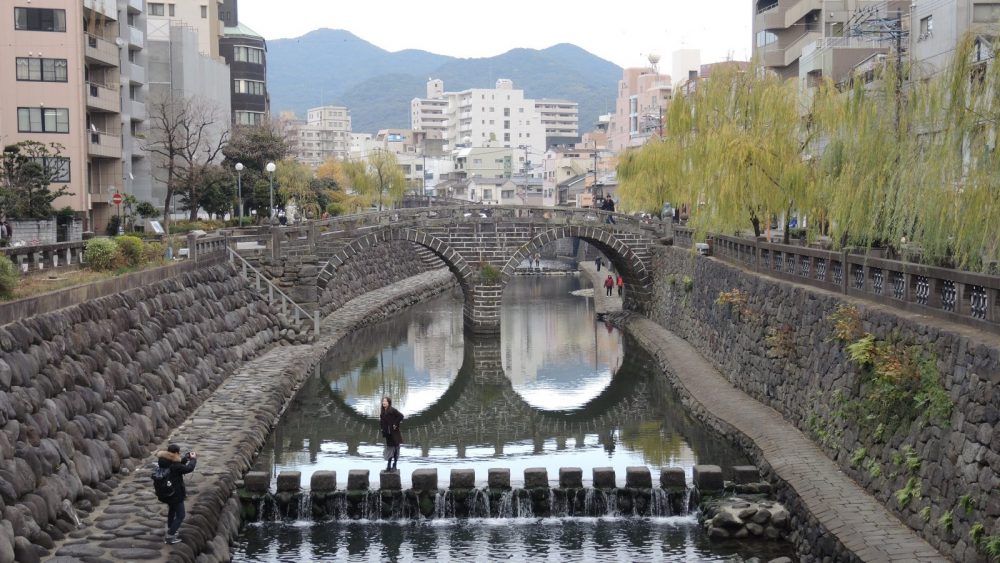
Nakashima River district, Nagasaki
Want to see the famous 'Spectacles Bridge' for yourself? Use this self-guided tour of Nagasaki (ideal for couples).
Your Personal Travel Concierge Service in Japan
Thinking of spending 5 days in Kyushu or more? Then start your Japan vacation on the right foot with this convenient Meet & Greet service.

Day 4: Nagasaki > Saikai
Ride: The Nagasaki Electric Tramway for a cool retro way to get about the city Experience: Atomic Bomb Museum, Nagasaki (sobering, be sure to visit the blast hypocentre outside) Train: 15:00 Sea Side Liner from Nagasaki Station to Huis Ten Bosch Station See: Omura Bay (sit on the left hand side of the train when leaving Nagasaki Station for the best views) Stay: Minshuku (stay in a regular home with a local family)
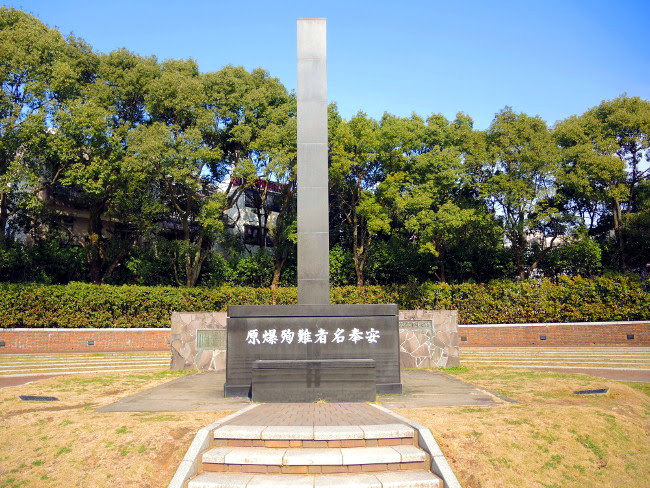
Atomic Bomb Museum, Nagasaki
Day 5: Saikai > Kobe
Experience: Mikan picking at Saikai Genkimura eco-village (thoroughly recommended - full article to follow!) Lunch: Restaurant Kasayama (good quality Japanese staples, reasonably priced, large portions served in private dining rooms) Bus: From Huis Ten Bosch (we didn't go inside the theme park) to Nagasaki Airport Fly: 17:20 Nagasaki to Kobe Airport
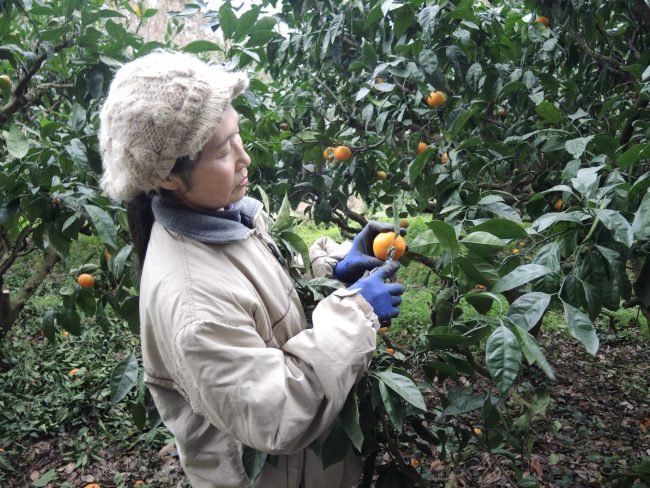

Kyushu With Kids: Enjoying Japan’s Most Southern Mainland Island
Born in England, raised in Canada and now living in Australia, I love travelling and experiencing new cultures. On Family Forays, I share our family travel experiences (in Australia and overseas) as well as provide travel advice, sanity-saving tips and feature family-friendly destinations.
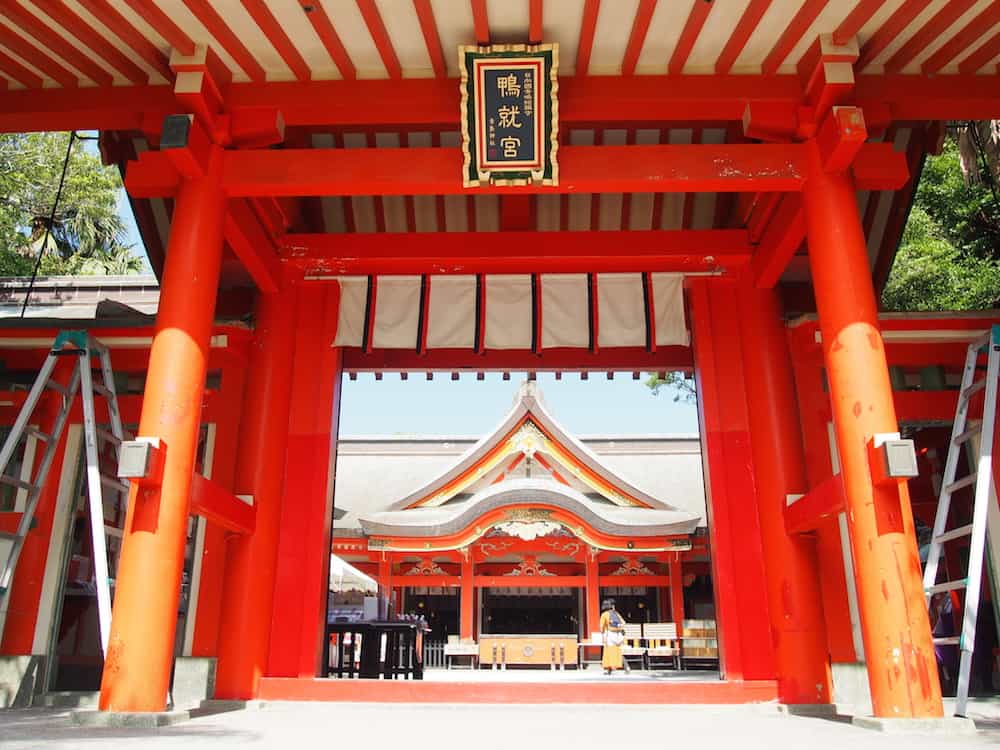
Get off the beaten track and visit Kyushu, Japan with your kids on a family holiday. Whether you want to get up close to a volcano or a feudal castle or dip your feet in volcanic water or ride a kids train, Kyushu is the place to go. This is Japan’s most southern mainland Island and was our favourite destination on our trip to Japan.
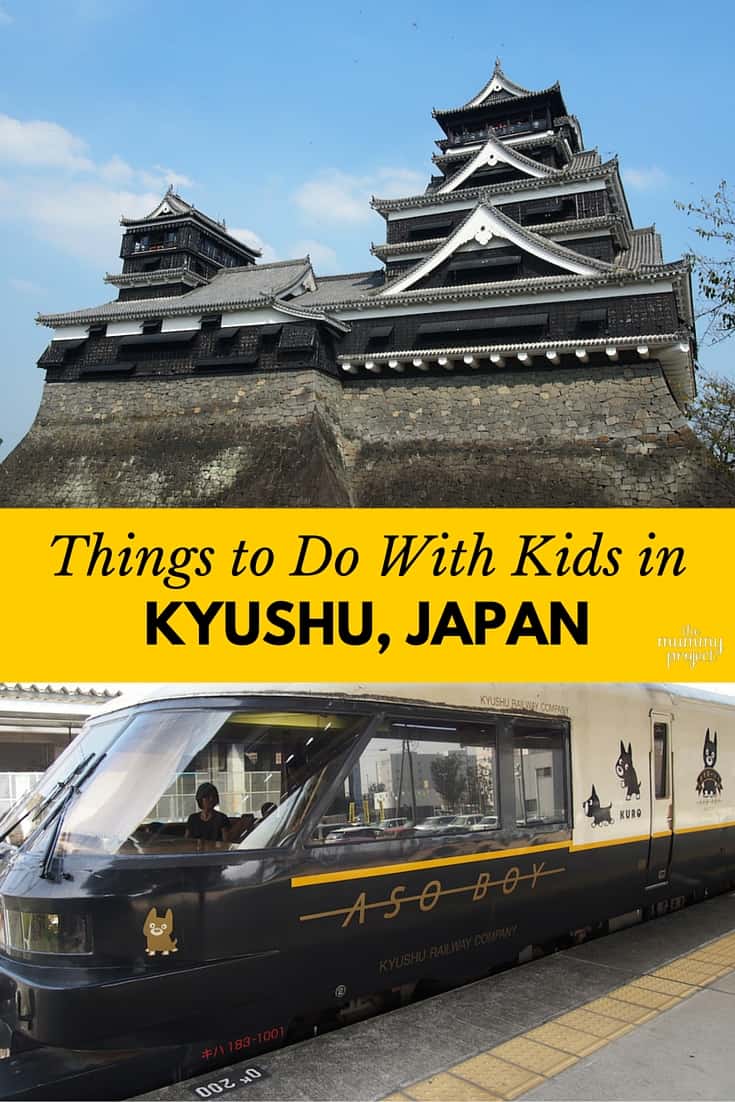
Kyushu with Kids
After leaving Hiroshima, we head to the city of Kagoshima dubbed the Playground of the South. Located on the southern tip of Japan, it is more than 1483 kilometres away from Tokyo. However, the completion of the Shinkansen bullet train line in 2011 means that the delights of Kyushu are easily accessible to Japanese and foreign visitors alike.
We’ve chosen to use the city of Kagoshima as a base to travel around Kyushu. We arrive in Kagoshima train station and immediately check into our hotel, the JR Kyushu Hotel Kagoshima. It’s conveniently located within the train station.
We start our Kyushu sightseeing in the town of Kunamoto, a 45 minute ride from Kagoshima by bullet train. We’ve heard about a scenic train heading to Mount Aso that’s geared to kids and we’re keen to give it a go. (JR Kyushu rail lines operate a number of specialty trains that are included at no extra charge for JR Pass holders)
We love trains and this one Aso Boy looks especially fun. It’s aptly named as asobouyo means ‘Let’s Play’ in Japanese. We reach the designated platform at Kunamoto Station and we immediately spot Aso Boy.

The train is covered with different pictures of Kuro, the JR Kyushu mascot.
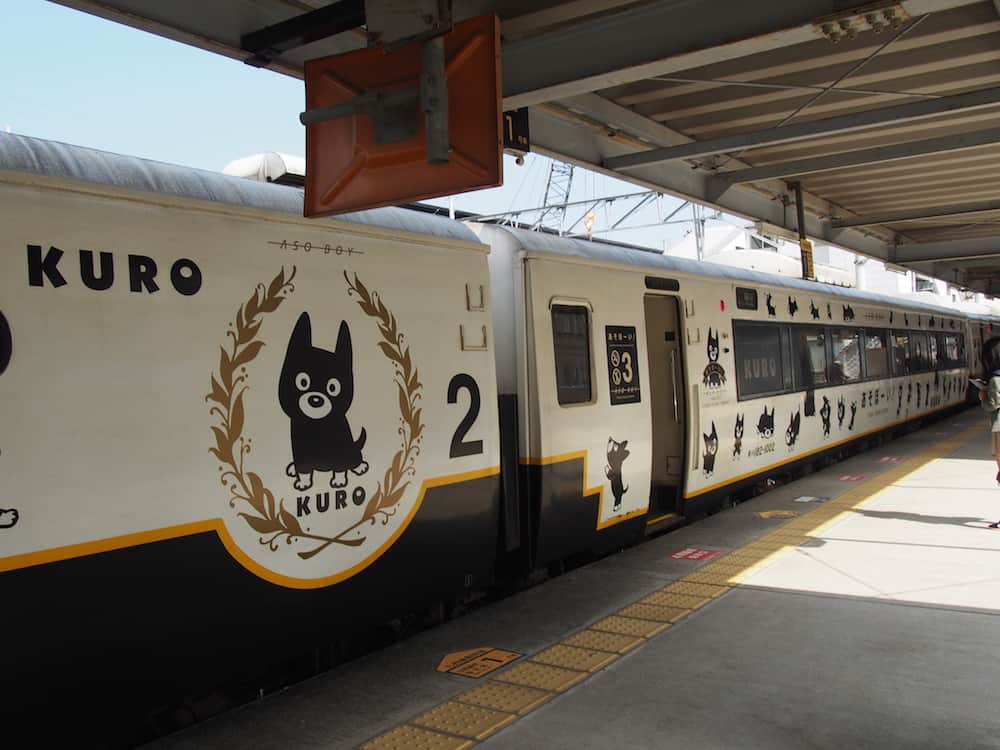
We clamber onto the train and the excitement builds. As we walk though the train, we marvel at the different seating styles all incorporating Kuro in some way.

We then discover Car 3 and my daughter squeals with delight.
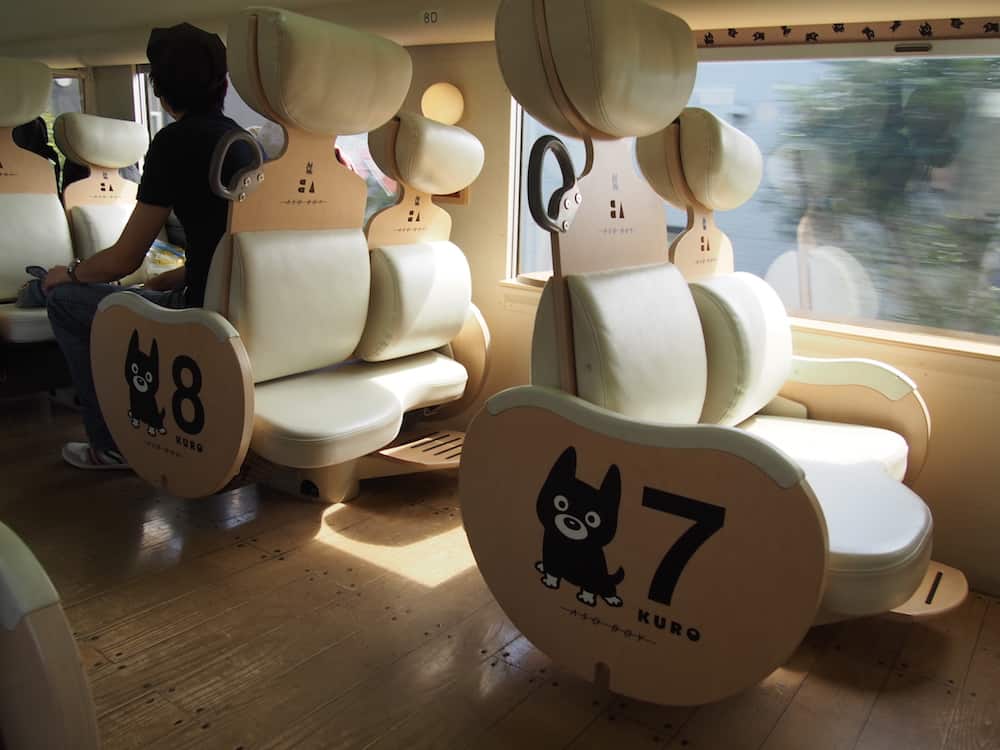
This is the family carriage and features specially designed adult and kids seats, a kids ball pit area, children’s library and attendants that amuse and entertain your kids. As soon as the train departs the station, kids immediately jump into the pool full of small wooden balls and start playing.

They are having a ball, pun intended!
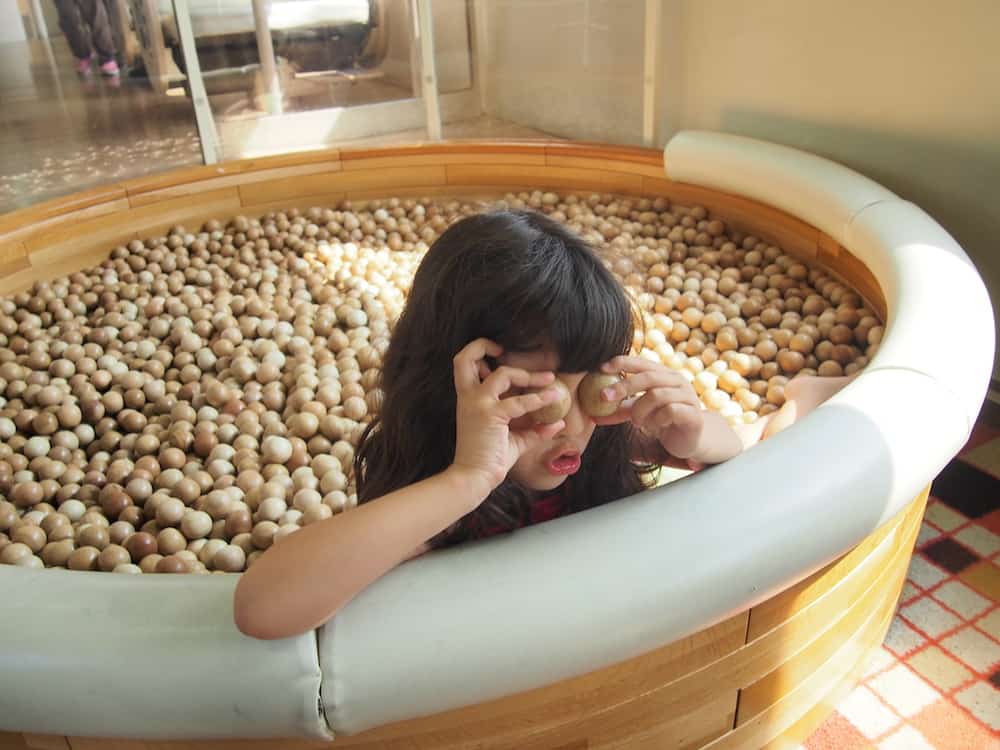
There’s a lovely cabin attendant clad in a special Kuro uniform who watches over and plays with the kids. This patient woman reads children’s books in both Japanese and in English and shows them how to fold origami.

It’s an educational experience for my child who learns a few phrases of Japanese while making origami puppies and then promptly teaches her new Japanese friends some English. She also invites them to our house in Australia. How’s that for promoting cross-cultural diplomacy, kid style?
It’s then time for the obligatory photo with the train placard.
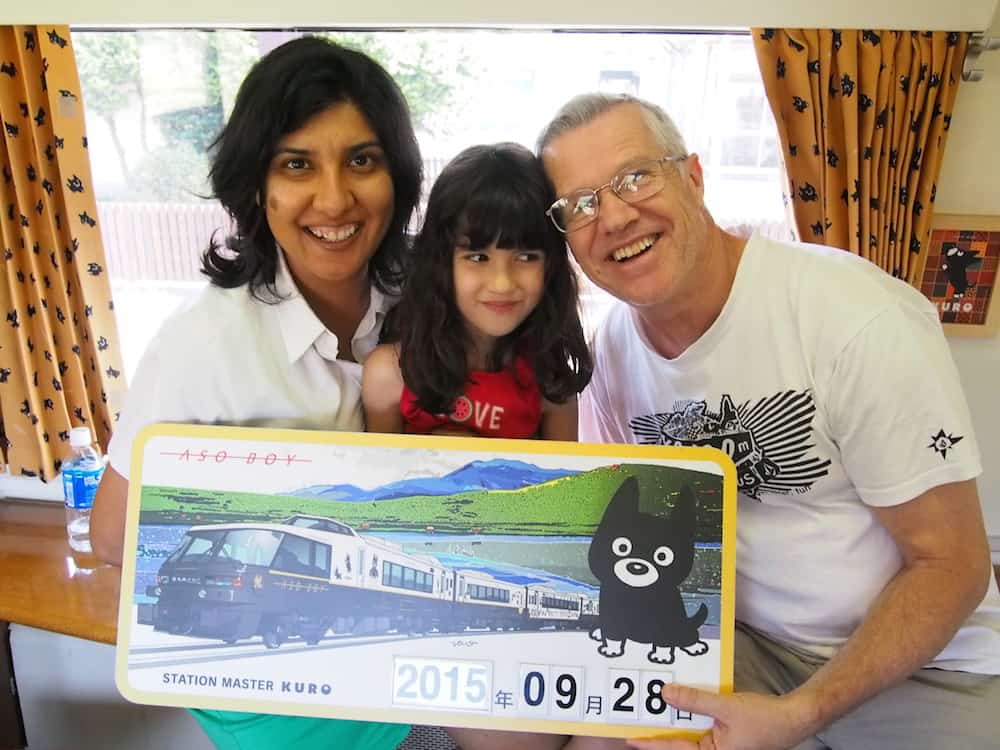
There’s also a library located next to the ball pit which contains different pictures book for kids to read.
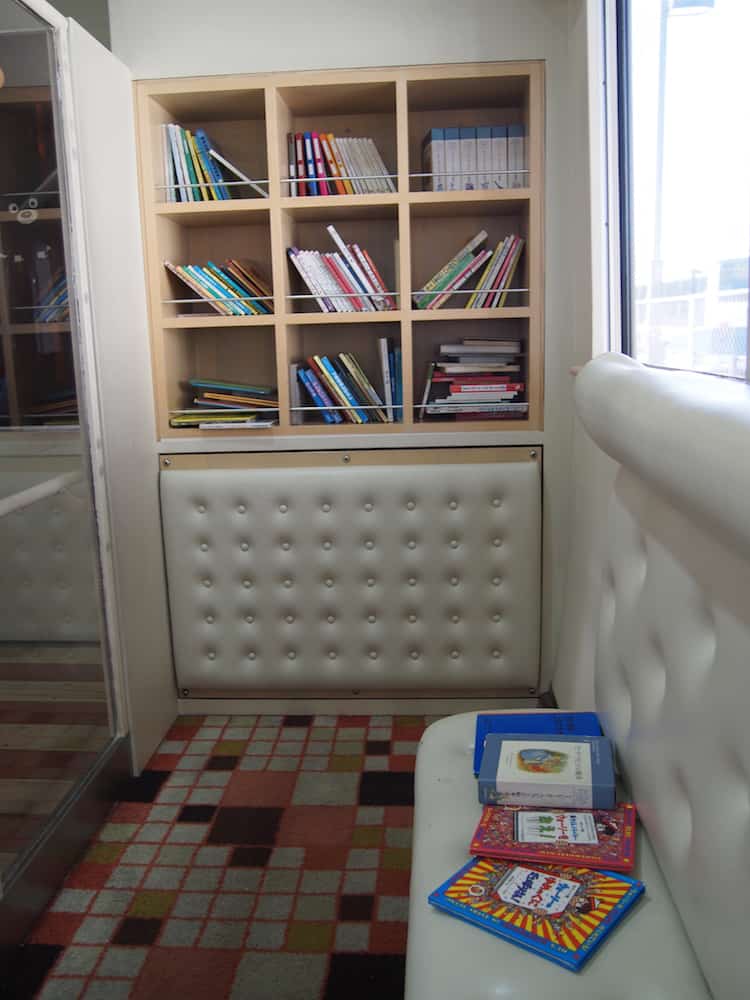
We pick up a selection of familiar books like Where’s Spot and Peter Rabbit and marvel at the Japanese text. We find a copy of Where’s Waldo as well which doesn’t require any Kanji language skills to decipher.

After reading for a while, we it’s time to visit the Kuro Cafe to purchase some snacks and Kuro souvenirs.
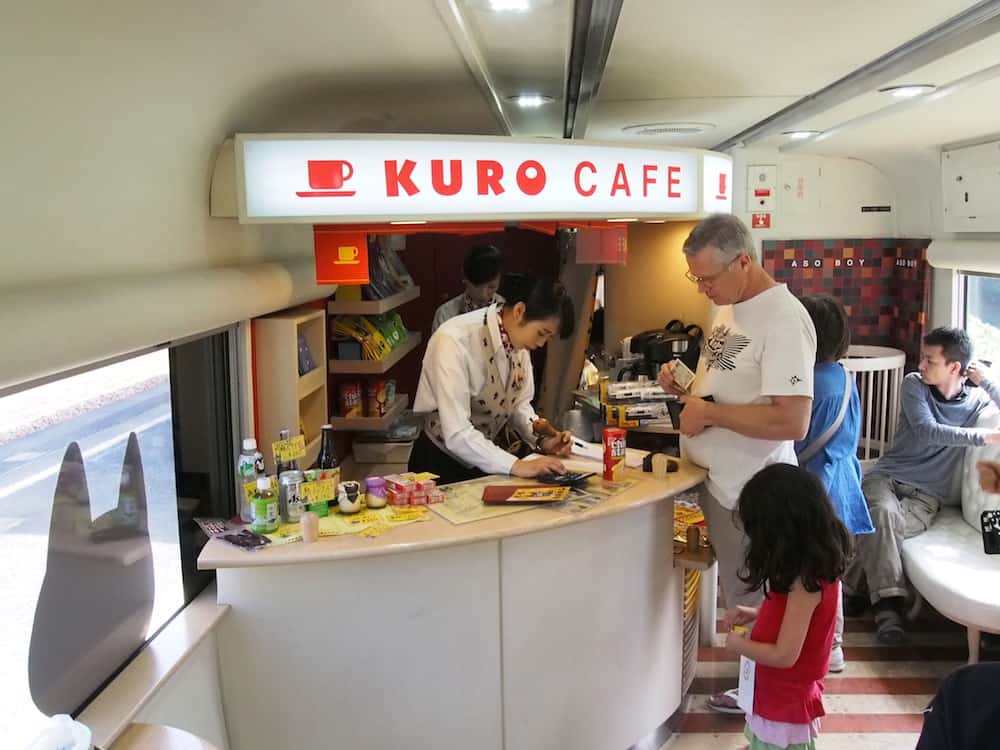
After snacktime, my daughter returns to playing with her new friends and my husband and I gaze out of the window. Our journey to Mount Aso begins with a series of switchbacks to climb up a steep gradient. It’s not long until we are informed that we are in the caldera which covers an area of 350 square metres.

A caldera is a large depression which has been created by a volcano over a series of eruptions. The Mount Aso caldera is one of the largest in the world which provides an indication of the power and frequency of this volcano’s eruptions. From here, we can see one of the volcanic cones of Mount Aso and it’s impressive.
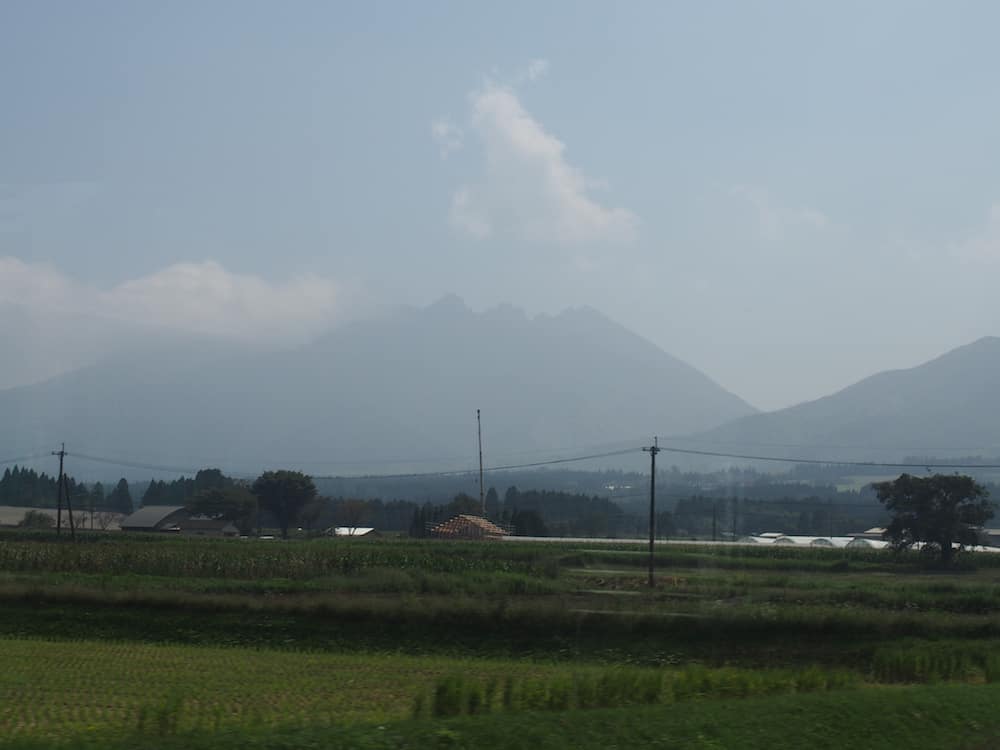
After an hour and a half, the train stops at Aso station. Most of the other passengers depart to take the bus to Mount Aso . However, we decide to forgo the experience as tourists are limited in how close they can get to Mount Aso, the largest active volcano in Japan.
The Mount Aso ropeway which takes visitors to the craters edge has been shut down indefinitely due to an eruption the previous month and subsequent seismic activity. The volcano also spews out noxious gas on a regular basis. We instead hang around the station and find Kuro’s kennel before embarking on the train for its return back to Kumamoto.
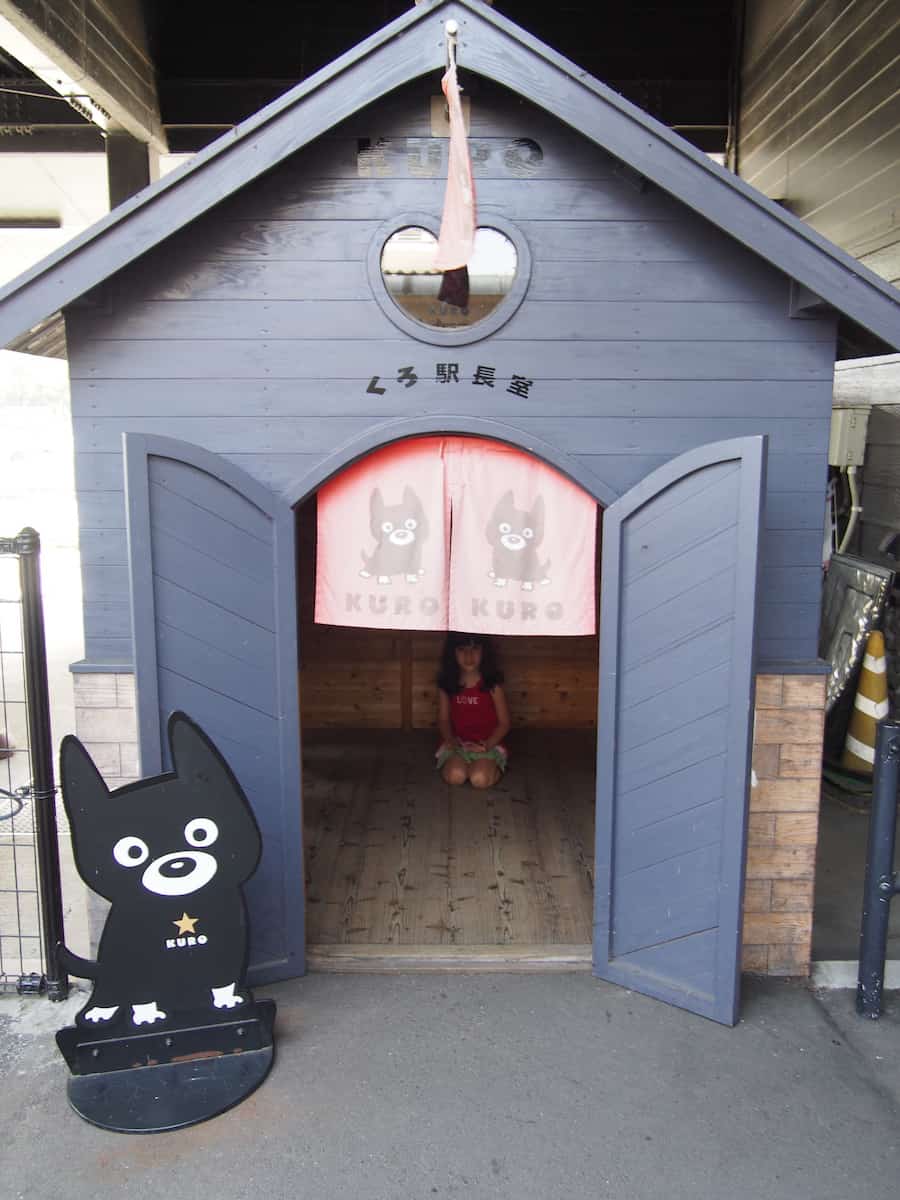
Once back in Kumamoto, we decide to stop and visit the famed Kumamoto Castle. It’s easy to reach with the tourist shuttle Kumamoto Castle Loop Bus which visits the castle as well as other tourist sites.
UPDATE: Kumamoto Castle was damaged in an earthquake in 2016. However, you can still visit the castle which is being restored via a temporary observation pathway.
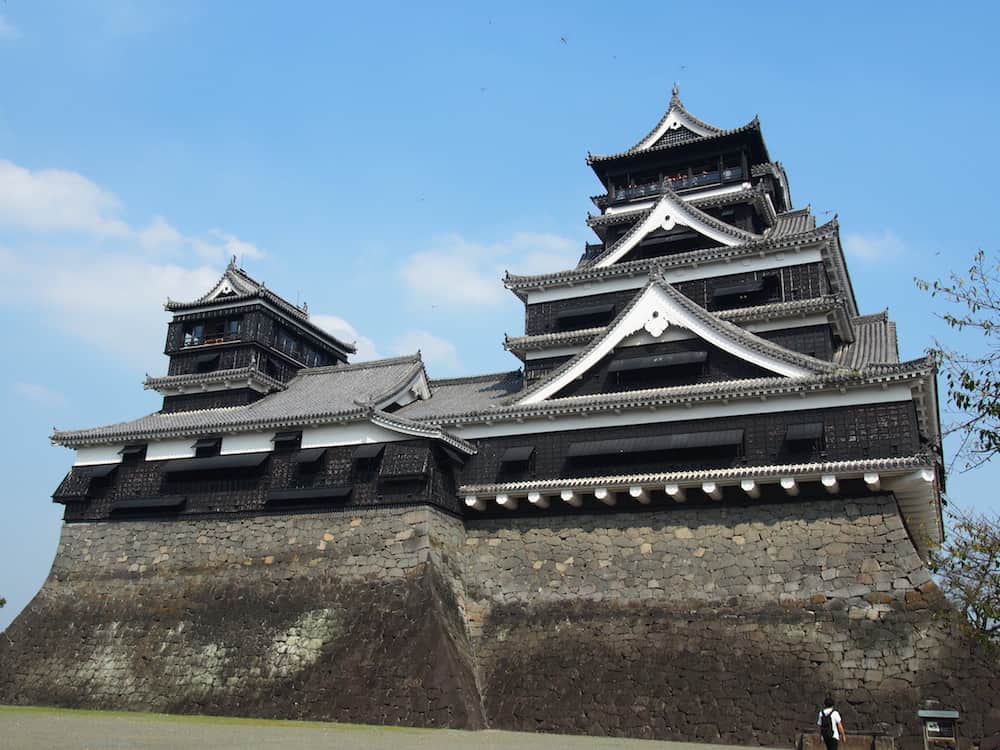
Kumamoto Castle, Japan’s third-largest castle, is a remarkable structure completed in 1607. As we enter the castle, we notice the high walls designed to prevent intruders. To access the castle, we have to go through an underground passage known as The Passage of Darkness where we keep expecting ninjas to jump out at us.
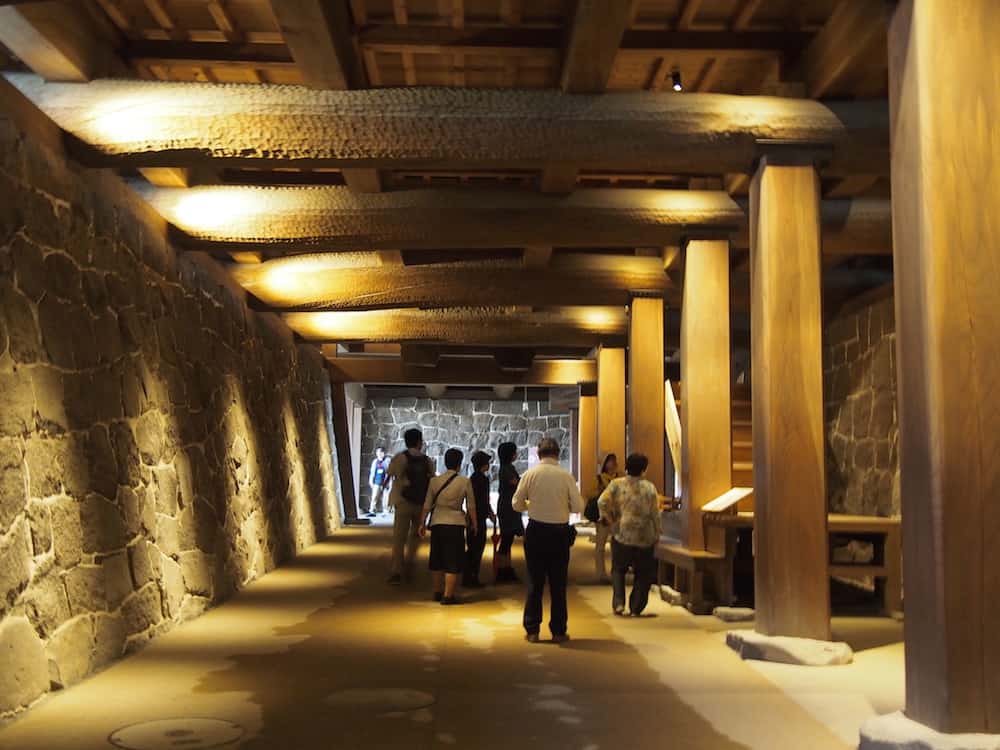
We don’t see any ninjas but we do spot Japanese warriors entertaining the crowds with sword display as we emerge.
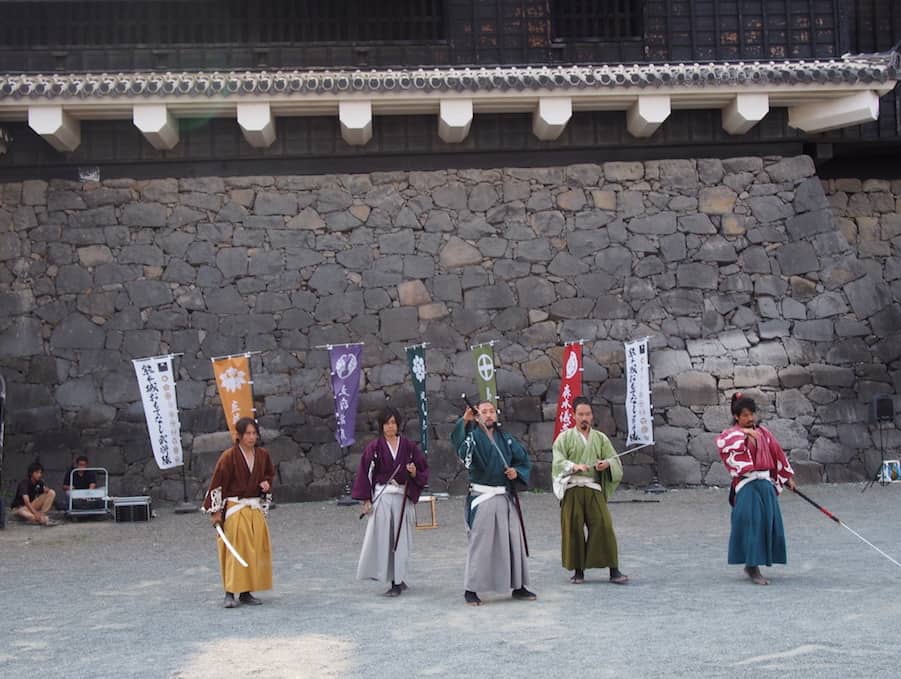
My daughter is enjoying herself immensely which is a relief. We weren’t sure if a feudal Japanese castle would keep her interested but apparently it does. She’s fascinated by the castle and is keen to climb up to the top of Uto Turret. Although much of the castle was destroyed in 1877 by a group of samurai, it was reconstructed in 1960. However, there are original buildings dating back to 1607. This includes the three-tiered, five-storey Uto Turret.
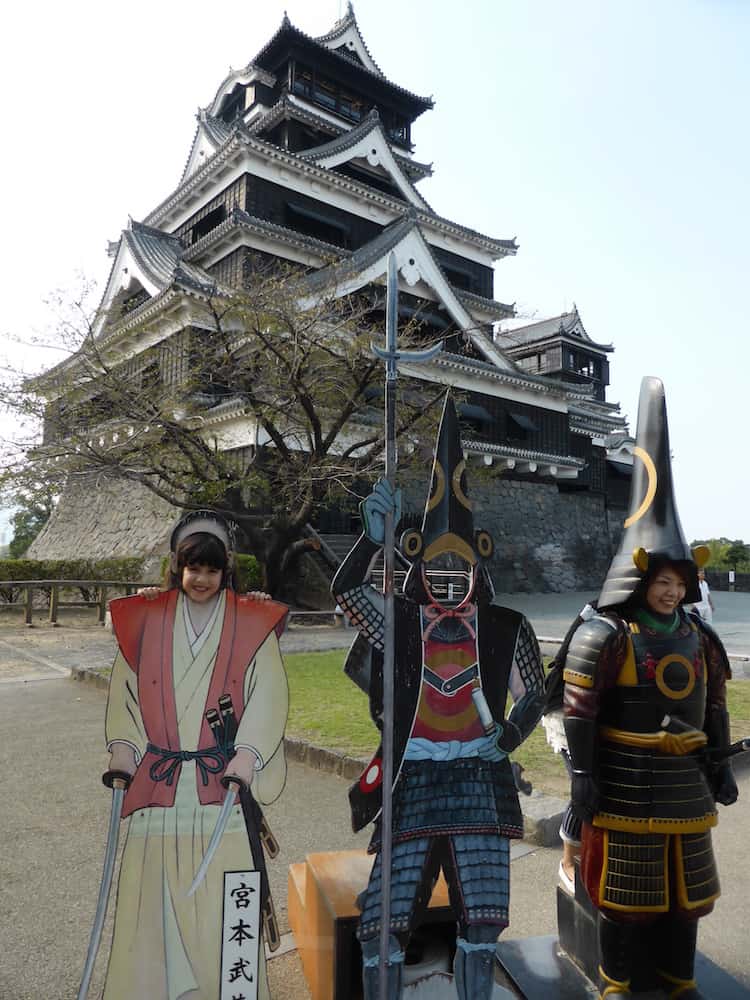
A wooden staircase takes us from ground level to the top, a distance of five stories. We stop on each floor to read the interesting history panels but eventually, we reach the top. From here, there are views all around Kumamoto including the expansive castle grounds.
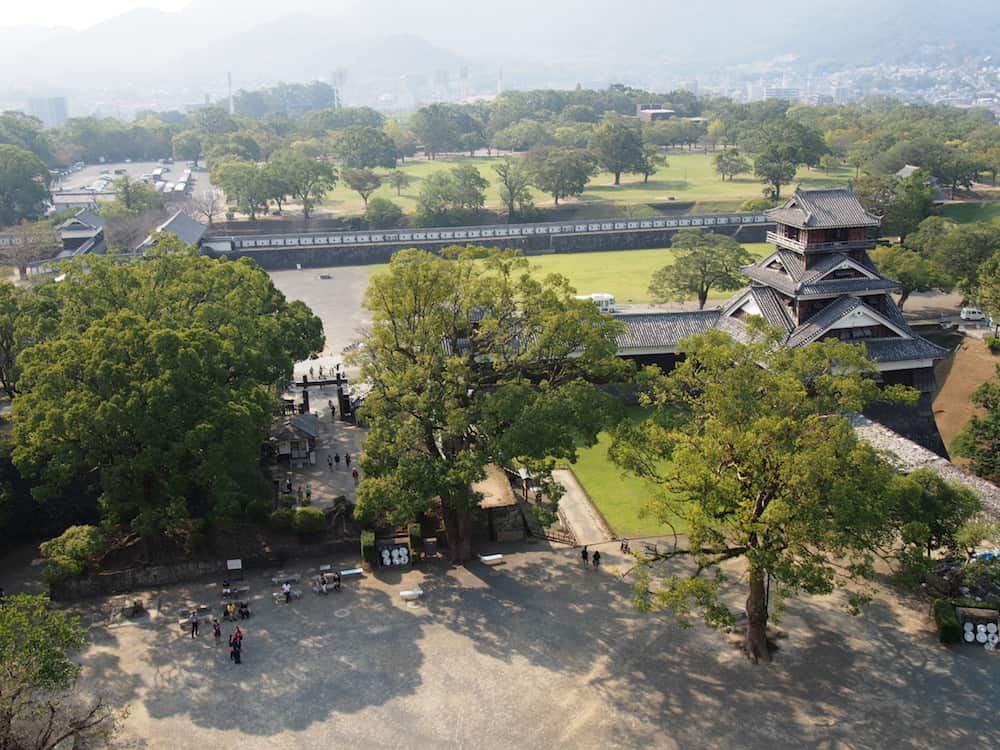
After gazing at the vistas for a while, we descend down the stairs. As expected, it’s much easier going down five stories in the castle.
We hop on to the shuttle bus and head to our next location, the Children’s Culture Center, a government-funded centre that’s open to tourists. This three-storey building is full of free activities for children and families to enjoy. The staff at the centre are friendly and welcoming even though they don’t speak much English.
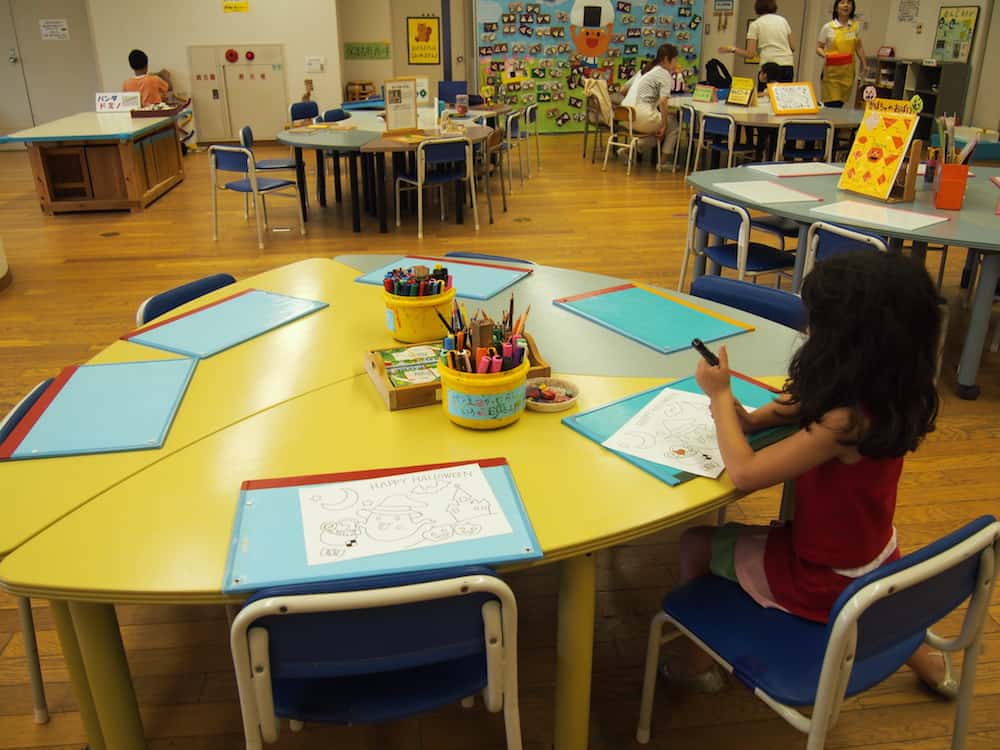
They explain that all of the activities at the centre are free but we just need to sign in. We soon meet some other Japanese families and they explain they come here often to socialise with their friends. They advise that each floor has different activities.
We start on the ground floor with a soft play area.

It’s then up to the second floor for some play time and then we finish on the third floor with a large play space where kids can do kindergym activities.
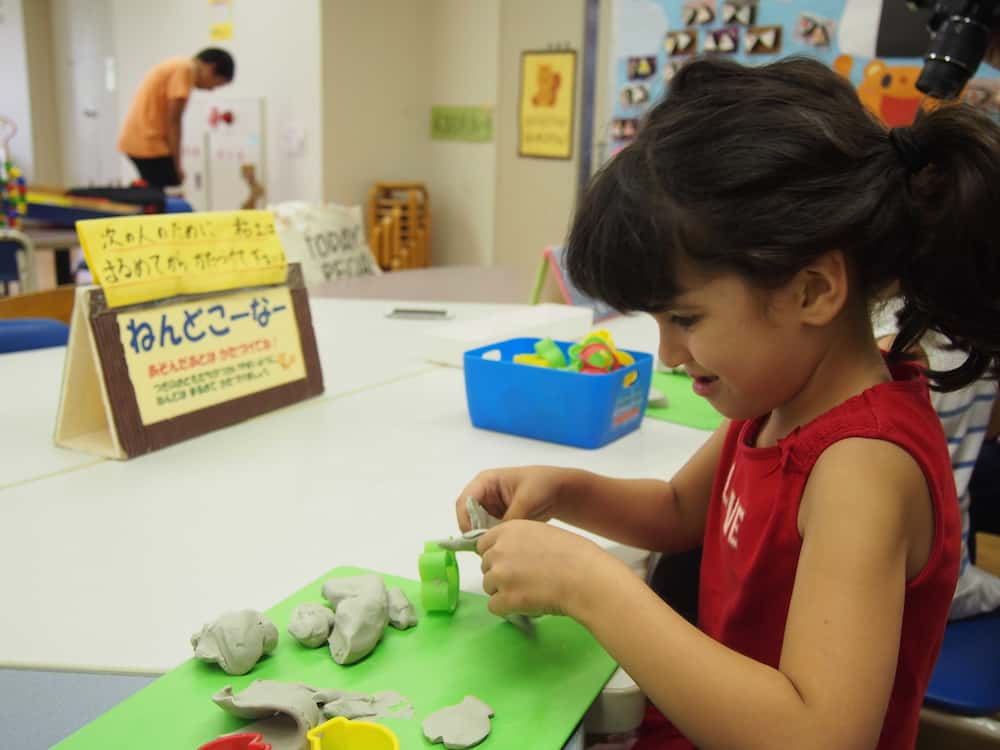
Being a centre for kids, it’s very child-friendly with elevators, kids sized amenities in the toilets and even vending machines that distribute hot food and ice cream.

The closing time announcement then comes over the intercom in Japanese and English and it’s a cacophony of tears as parents try to extricate their kids from this fun place. We say sayonara to our new friends and leave to get back on to the Shinkansen bullet train back to our base in Kagoshima.
The next day, we wake up to torrential rain in Kagoshima. Our plans of strolling around Kagoshima are dashed. It’s time for Plan B. After eating express, we hop on to the Shinkansen bound for Fukuoka, just 75 minutes by train. This is the largest city in Kyushu with over 1.4 million people. We arrive in Fukuoka station to a warm and sunny day. Our destination is Ohori Park.
We ask for directions and we’re advised to take the subway as it’s faster. (Japanese subway systems are easy to navigate with automatic ticket machines and friendly station staff).
Ohori Park is a beautiful scenic park in the middle of Fukuoka and is a great spot to hang out for a few hours. The park surrounds a pond and three islands and features a 2km track around the lake. The large pond was originally part of the moat for Fukuoka Castle. Ohori actually means moat in Japanese.
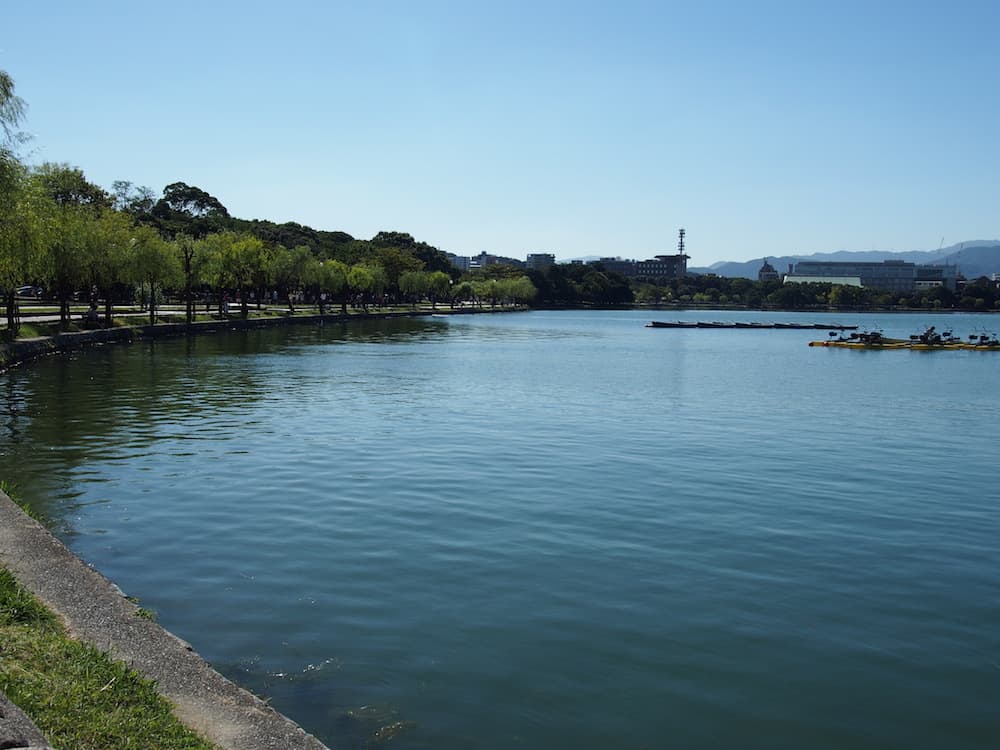
The park is full of walkers, runners, dog owners and families. As we walk around the park, we can hear a saxophone and notice a musician practising in the trees. It’s especially family-friendly with two playgrounds located within the park.
The first playground we visit is for younger tots and is a popular spot for Japanese mothers groups. The playground is full of mums and bubs, many of whom favour baby carriers. It has small play equipment which is perfect for this age.

The second playground is for preschoolers and up and covers a larger area.
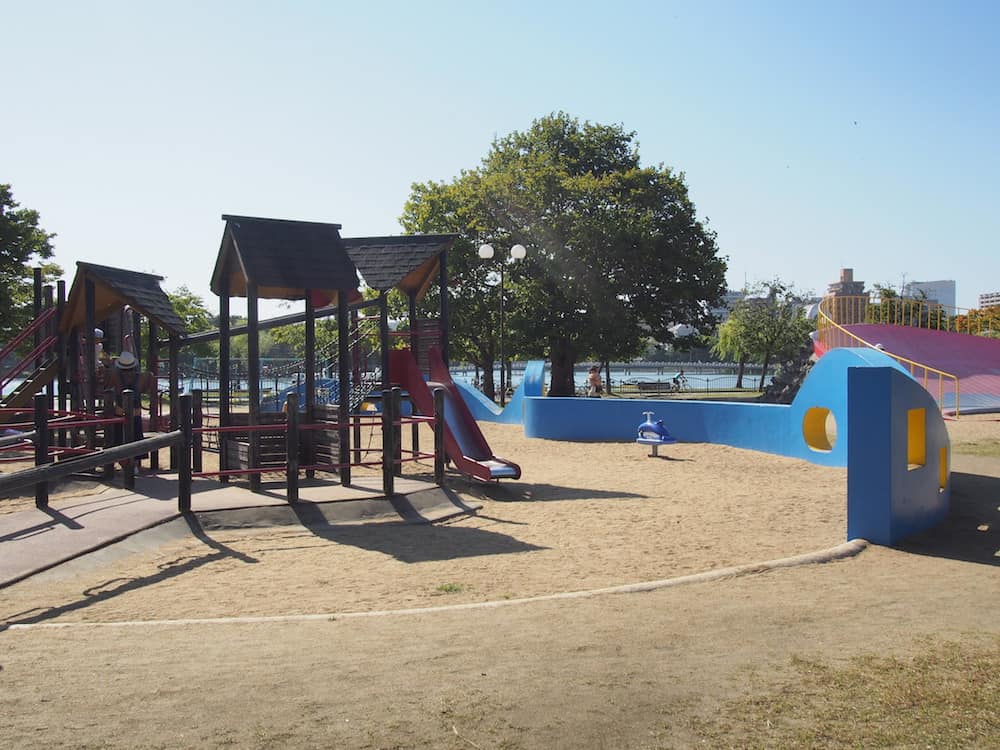
It features your usual playground far such as slides, swing and climbing equipment.
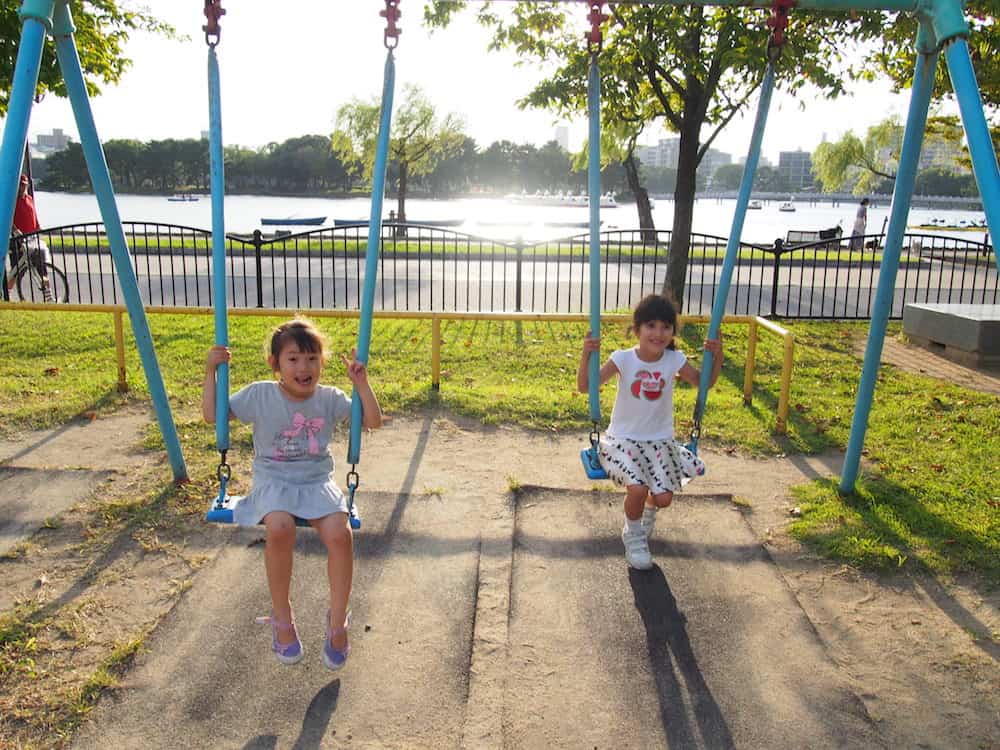
There are lots of kids here and it’s not long until my daughter makes a friend.
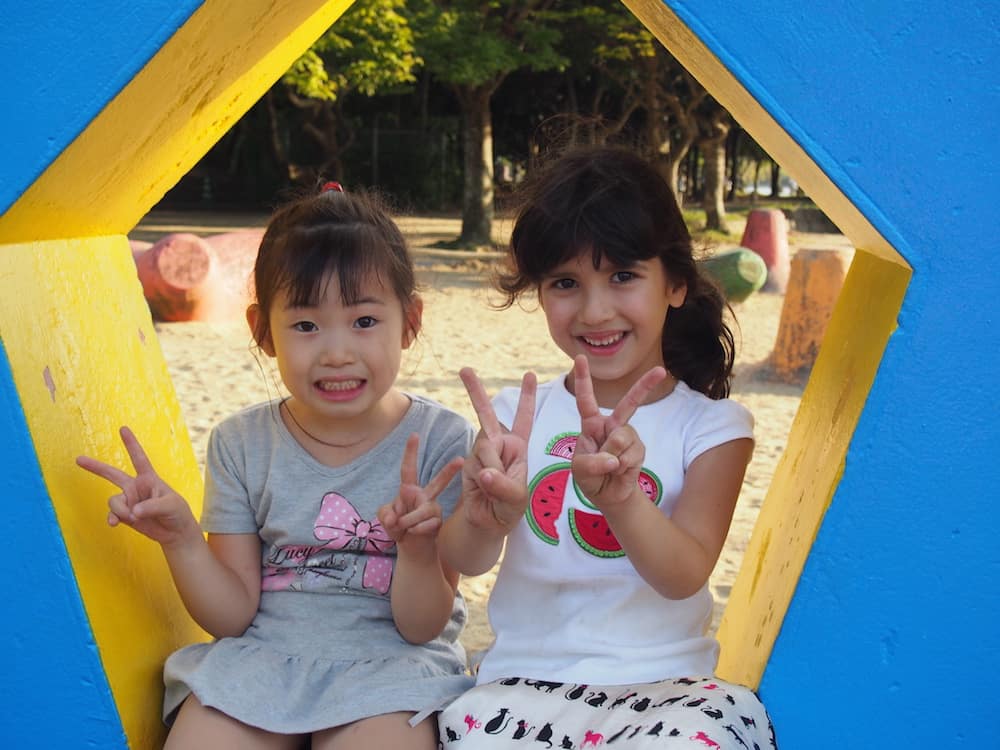
Her new friend shows her how to climb up and slide down the massive concrete bowl.
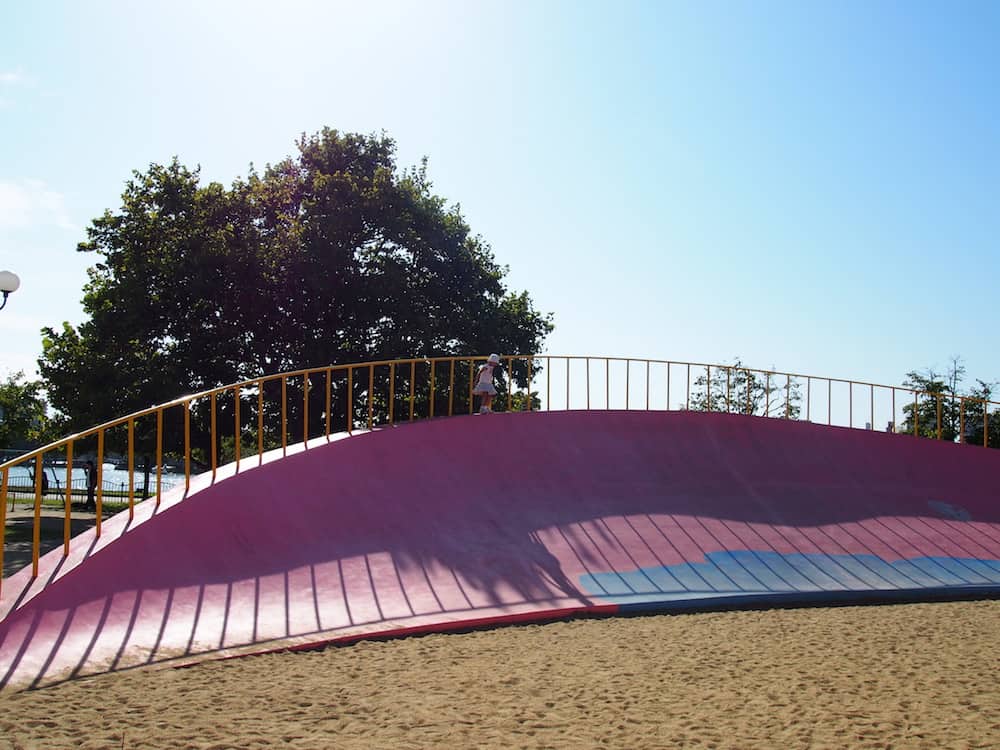
We stop for lunch at the lakeside cafe and watch people paddle giant swans around the lake. You can rent the boats and bikes at the cafe.
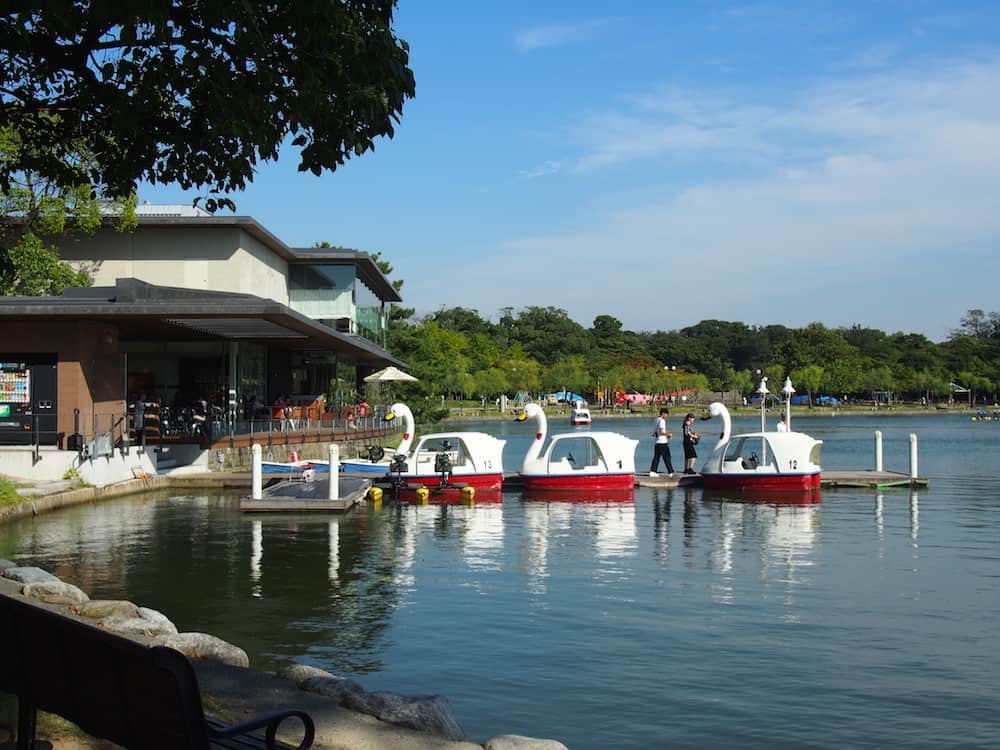
The sun is starting to disappear behind the clouds, so we get back on the shinkansen to a still rainy Kagoshima.
The next day it’s off to Ibusuki. We travel down on another specialty sightseeing train, the Ibusuki no Tamatebako which features large panoramic windows. This train also has a unique feature. Steam known as ‘Dragon’s Palace Smoke’ is expressed from vents at the top of the train when the doors open. This is based on a popular Japanese folk tale.
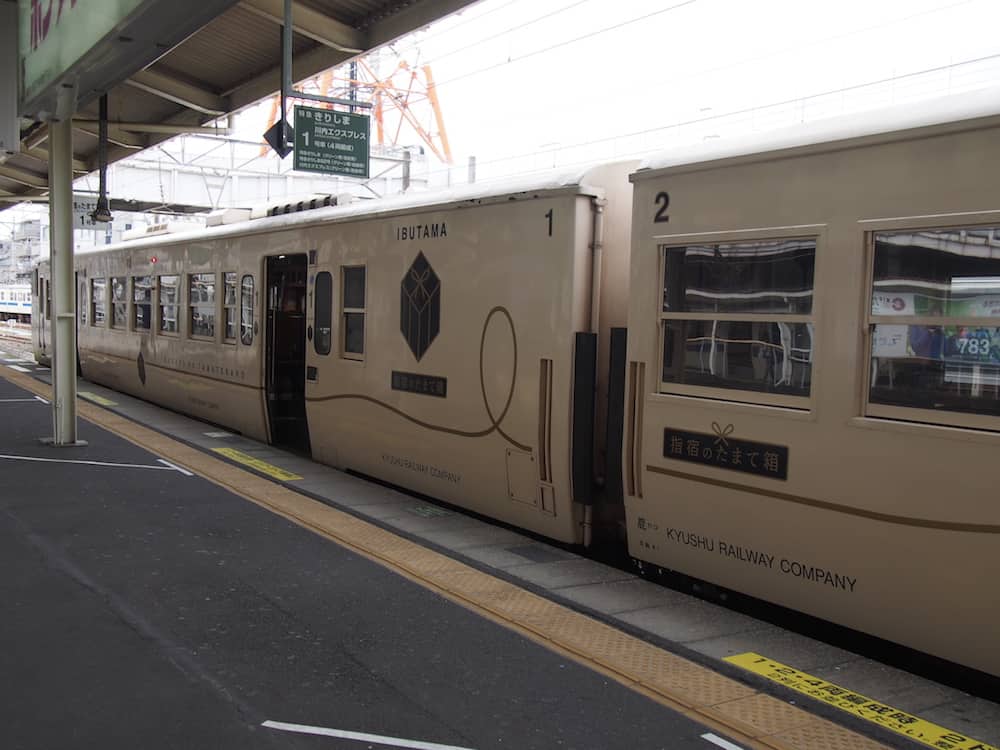
The train hugs the coast as it travels down to Ibusuki with views of Kinko Bay. Ibusuki is famed for its sand baths using hot spring water that bubbles up from the beach at Ibusuki. I’ve arranged a visit to Ibusuki Sunamushi Onsen to experience the natural sand bath for myself.
Here I’m greeted with the instructions for the bath: Go the ladies changing room, strip naked and wear the supplied yukata (cotton kimono) and thongs. Once changed, I follow the walkway outside to the beach and are directed to a shallow hole in the beach. I can see the steam coming off the sandy beach.
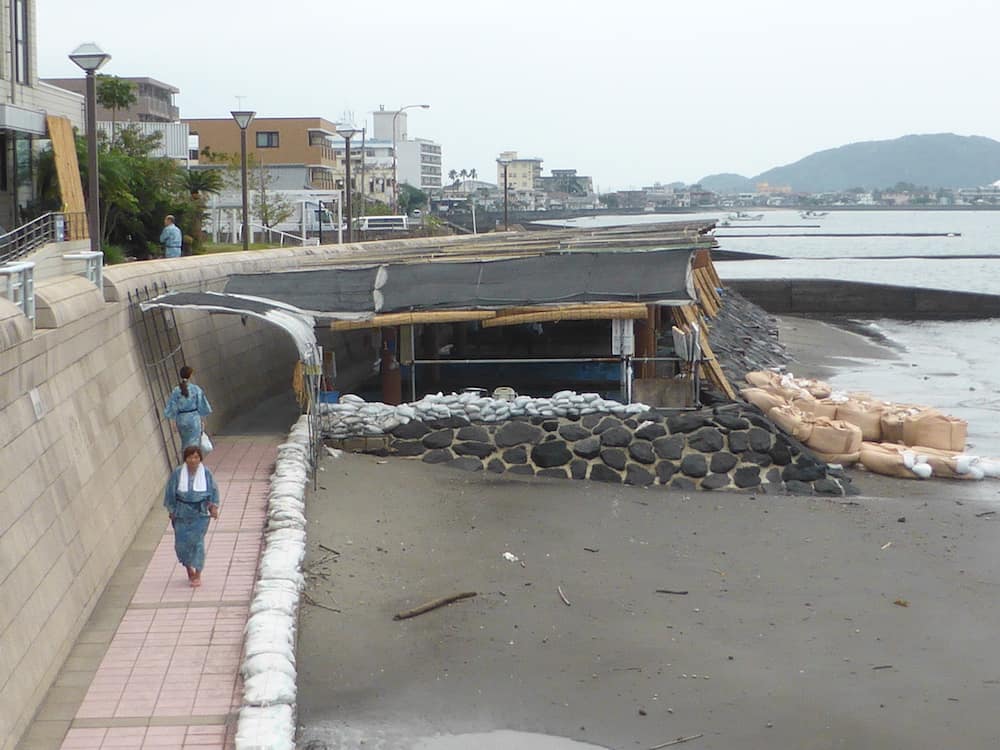
I lie down trying to prevent myself from inadvertently flashing the attendant and place my arms down at the side as directed. He then starts shovelling sand onto me. The sand is hot and heavy and I feel a moment of panic as it does feel like I am being buried alive. The panic subsides and I start to enjoy the experience.
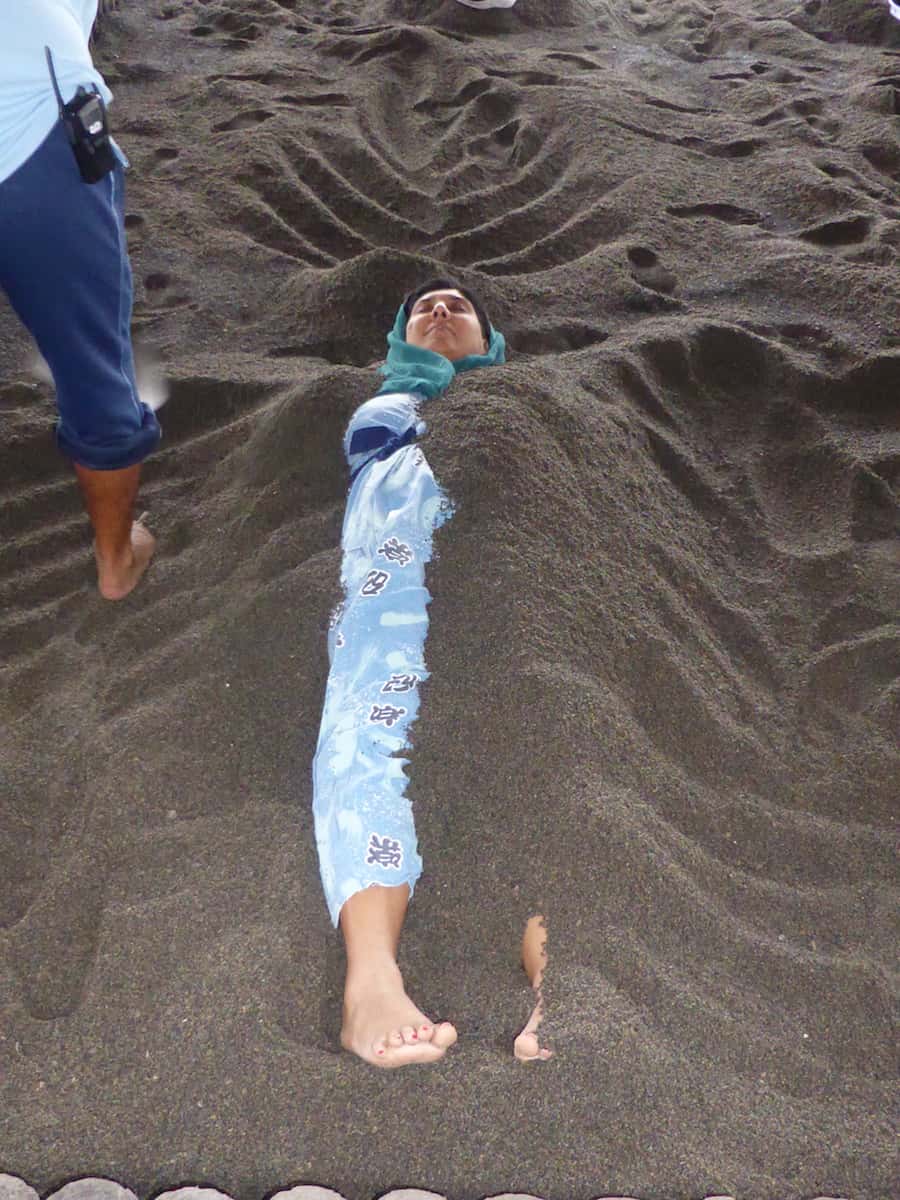
My sand cocoon is warm and relaxing and is reputed to be therapeutic. The composition of the sand is supposed to draw out impurities and relieve conditions such as rheumatism, muscle aches, asthma, diabetes, poor circulation as well as skin ailments.
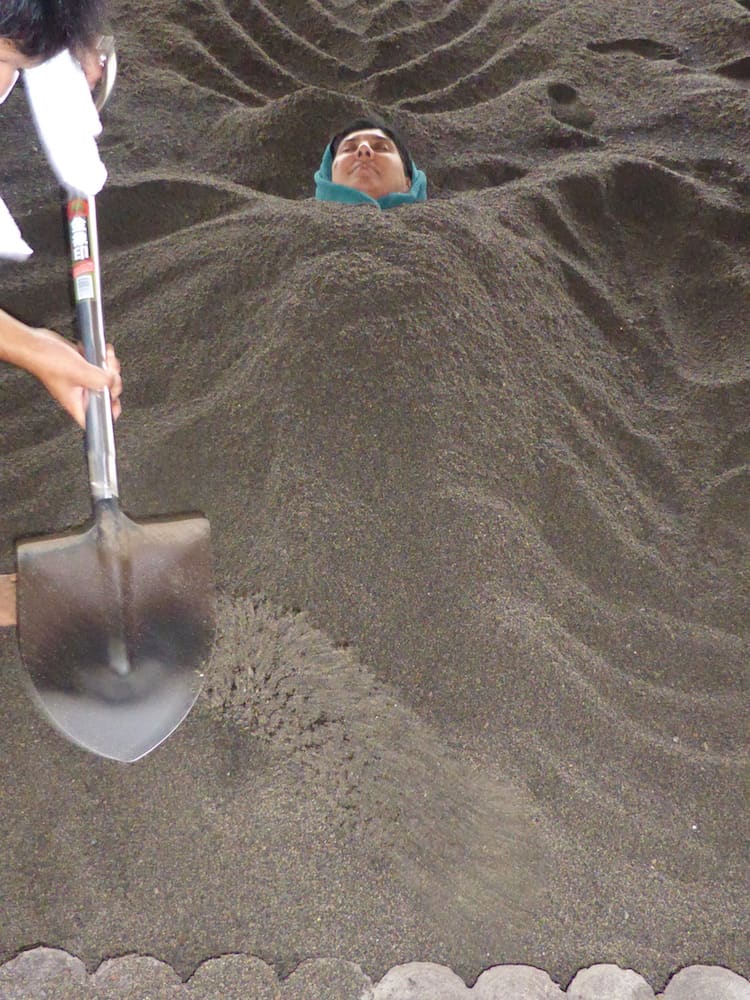
It’s advised that you only remain buried for 10 minutes and the time passes quickly. I move my arms and legs and easily extricate myself from the sand. It’s then back to the changing room to rinse off the sand and soak in the onsen, a hot Japanese pool.
After my therapy, I rejoin my family who have been relaxing near the beach. My husband inquires how I feel after the session. I tell him I definitely feel more relaxed and refreshed. Whether that’s from the hot sand bath or the hot spring bath, it’s unclear but it’s been an interesting experience and I’m keen to catch the train back to Kagoshima to relax more.
The next day, we discover that the weather gods are finally on our side as we wake up in Kagoshima to clear skies. It’s time to visit the volcano Sakurajima which rises out from the bay. Kagoshima is dubbed the Naples of Japan due to this active volcano which regularly blows out ash.
We board a large ferry from Dolphin Bay pier and approach the island looking in vain for the summit of the volcano. In the three days that we’ve been in Kagoshima, we have yet to see the top of the volcano as it is obscured by steam and cloud. Once across, we visit the Sakurajima Visitor Centre which provides us with information about the volcano and the island.

A major earthquake in 1914 killed 35 people and created massive lava flows. More recently, in 2013, the volcano erupted with a plume of ash rising 5000 metres high. Based on seismic data, researchers are predicting a major eruption could occur soon.
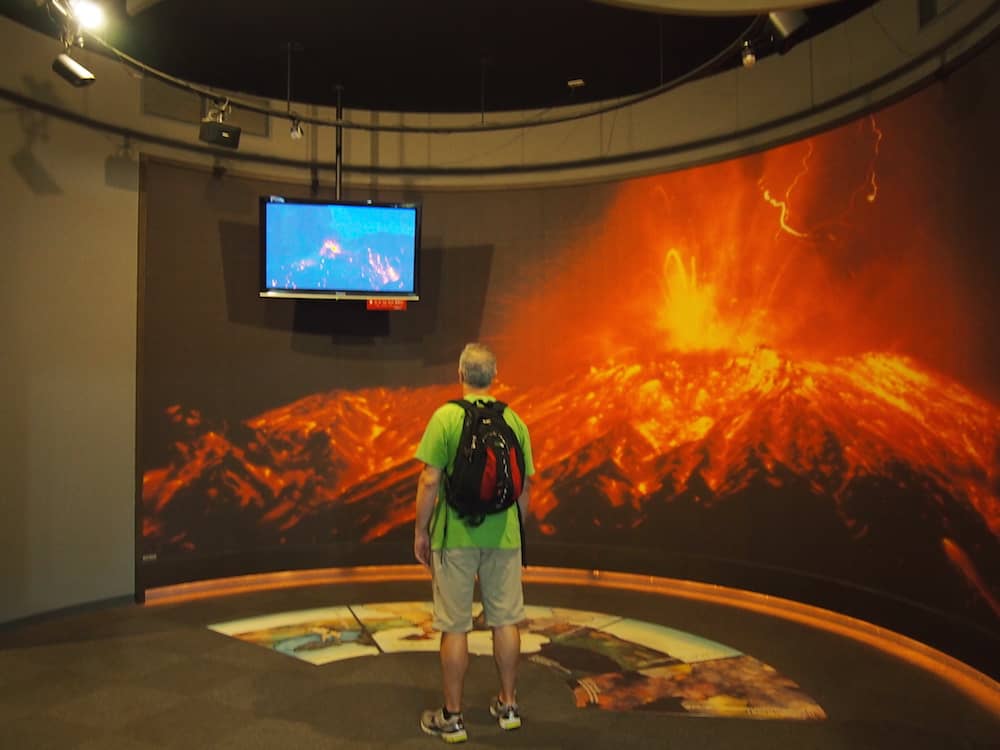
We learn interesting facts about Sakurajima:
- Every house on the island has a concrete shelter.
- Every school kid wears a plastic helmet to and from school instead of a fabric school hat to protect against volcanic ash.
- The volcanic soil of the island yields massive radishes the size of basketballs and tiny mandarin oranges.
There’s also real-time videos and seismic charts which record the volcano’s activity.
We wander out from the centre and board the tourist shuttle bus, the Island View Bus which takes us to various points of interest around the island.
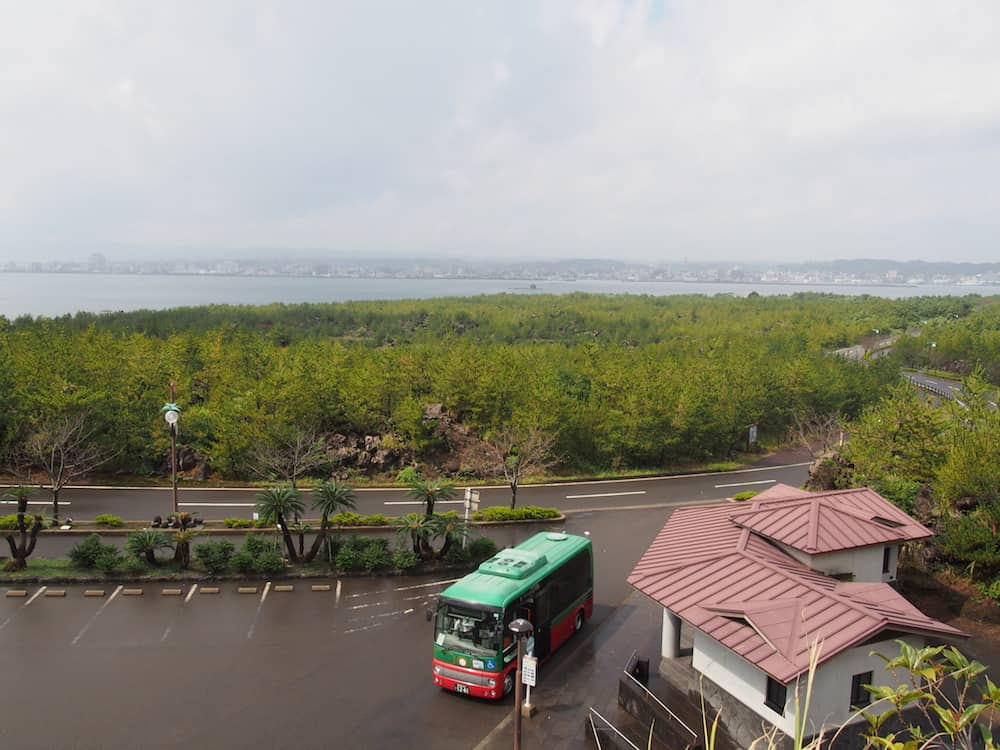
The first stop is Akamizu View Park, a harbourside park with large volcanic rock scattered around. The most notable feature is a large monument of a singer and guitar made entirely of volcanic rock called “Portrait of a Scream”. This sculpture commemorates a massive all-night rock concert in 2004 which attracted 75,000 people,
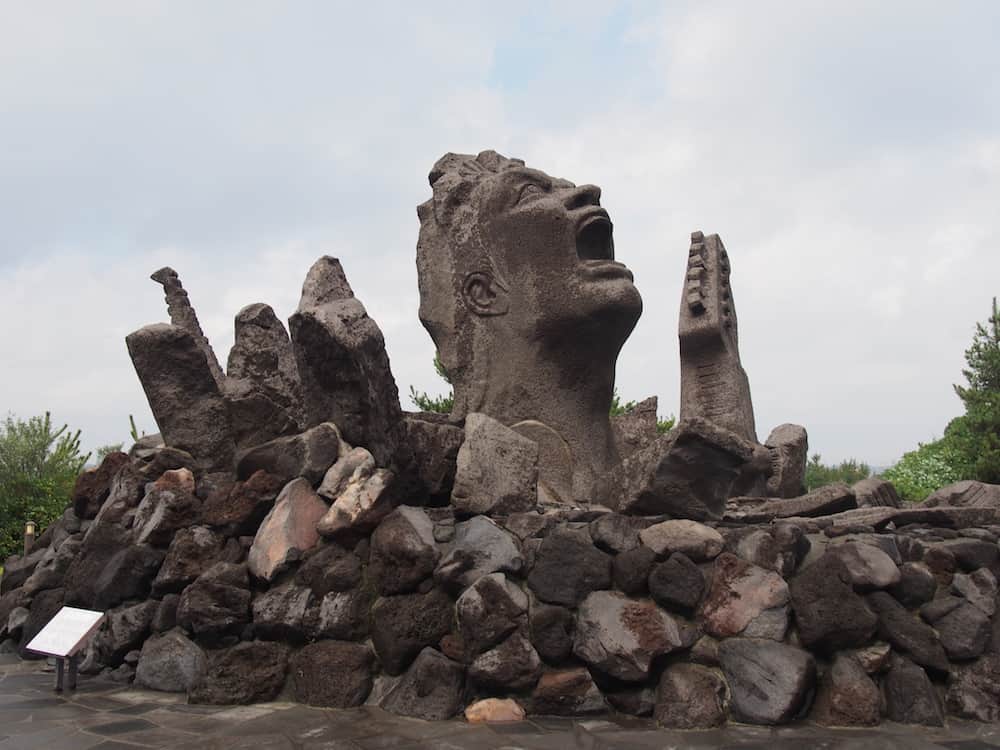
Our next visit is to the Yunohira Observatory station which is the closest that visitors can get to the volcano. Although we’re closer, we still can’t see the top of the volcano as cloud and steam obscures our view.
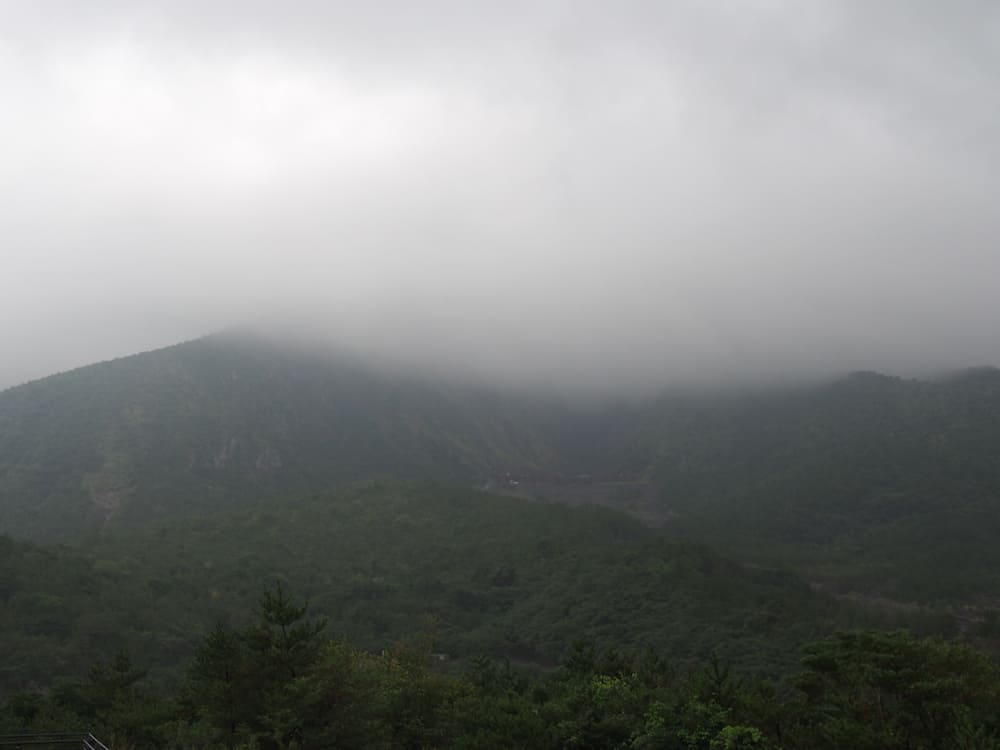
The bus tour ends near the ferry station and we venture to the harbourside Nagisa Lava Trail, a 3km trail through lava fields that were formed after the 1914 eruption.
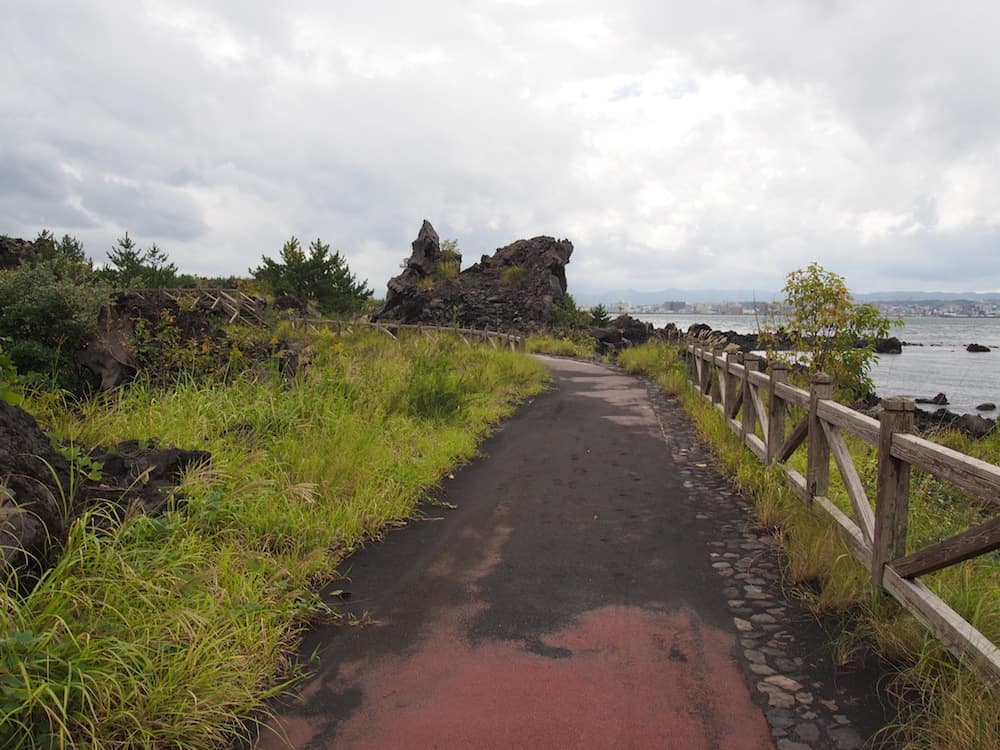
It’s like walking through an alien landscape with black rocks of differing shapes of sizes around us.
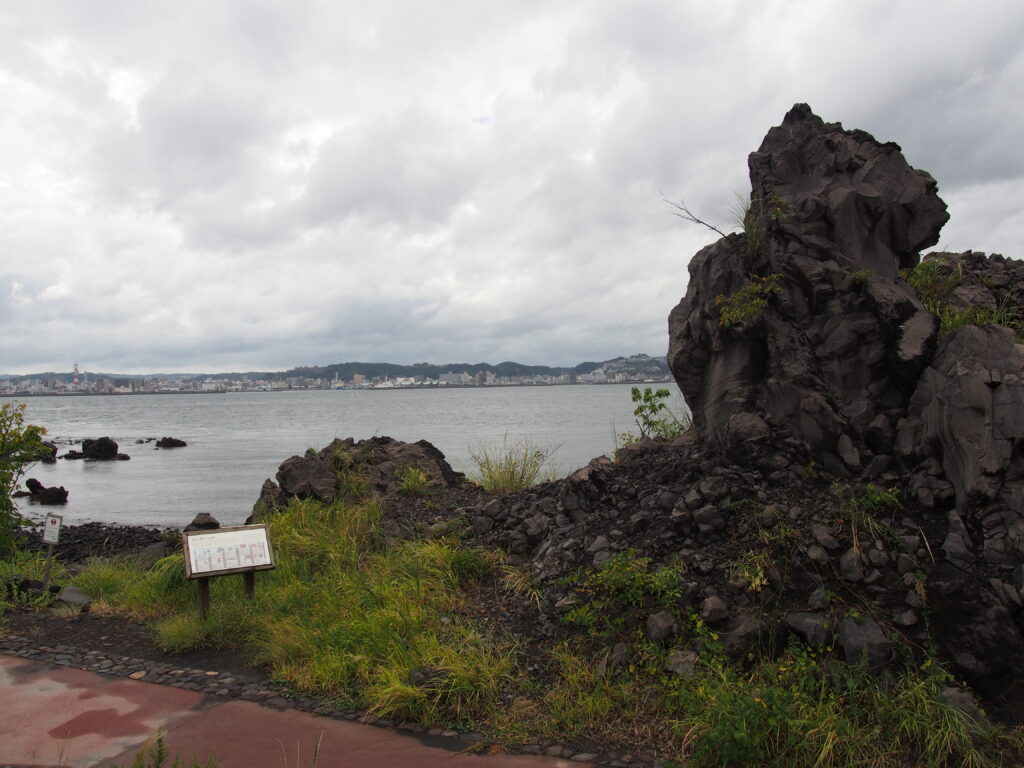
Nearby is a 100-metre long free Nagisa Park Foot Bath which is fed from underground hot spring water.

The weird green-yellow colour is due to the minerals in the water. We submerge our feet in the hot water and it’s heavenly. We rest there for a while enjoying the water while enjoying views back towards Kagoshima and up to Sakurajima.
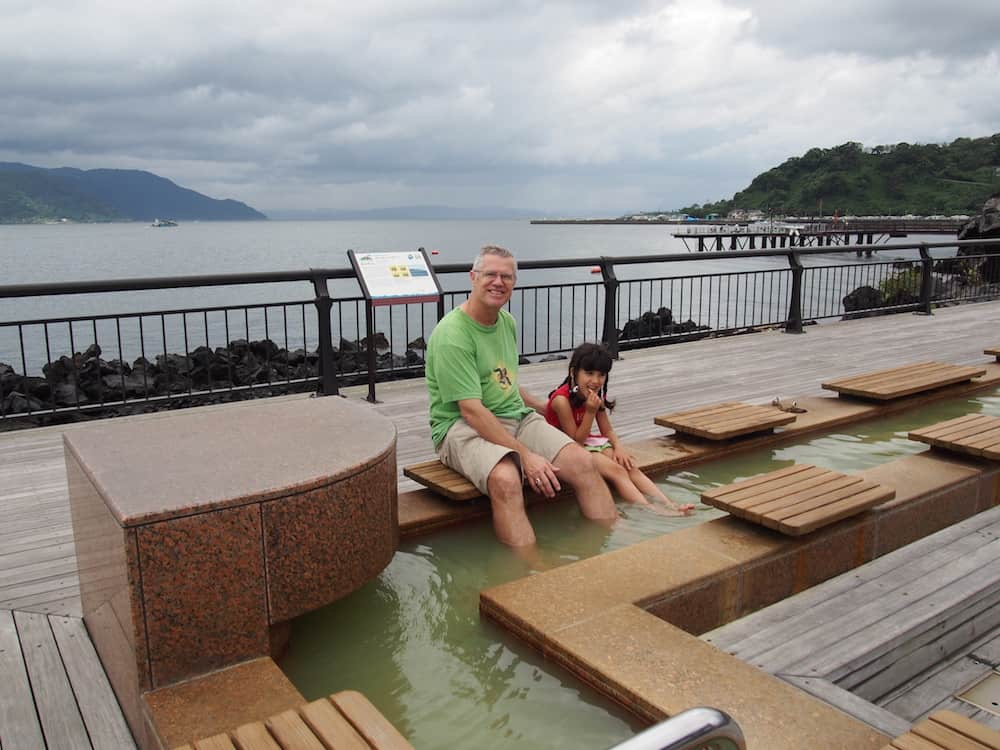
We finish our Kyushu holiday a few days by the beach. A two-hour train ride east from Kagoshima takes us to Miyazaki and then we head out to the northern beaches.
We’re staying in the Holiday Inn Miyazaki resort right on the beach.
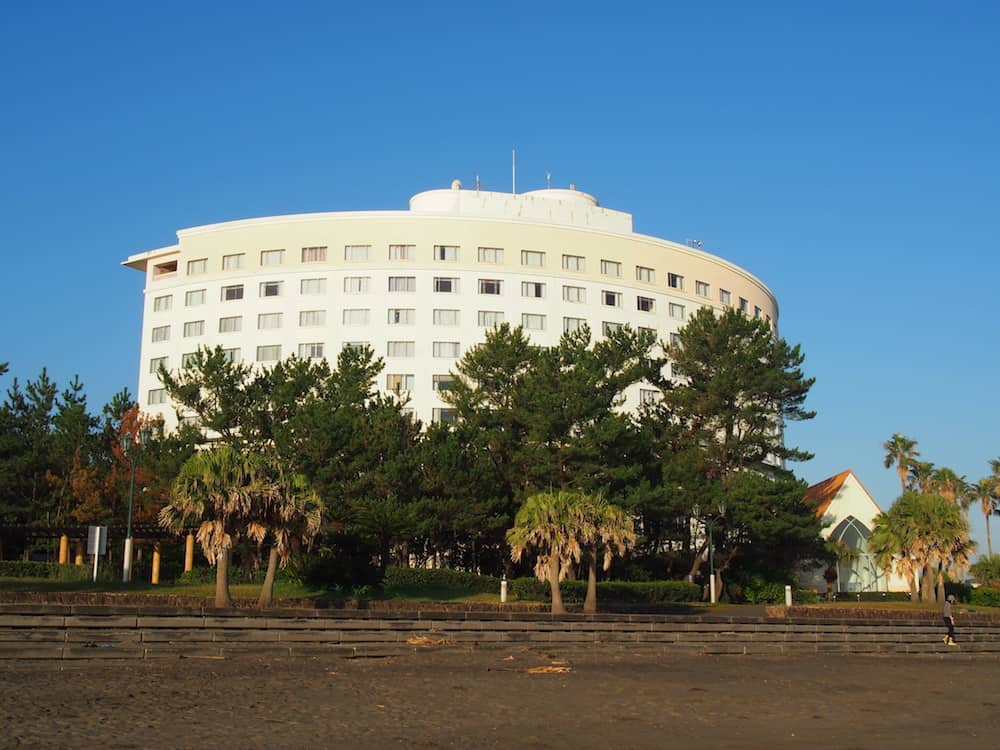
Our room is massive (for Japan) and comprises of a king bed and separate single bed as well as incredible beach and ocean views. It’s slightly retro with a Hawaiian theme but we appreciate the quirkiness.
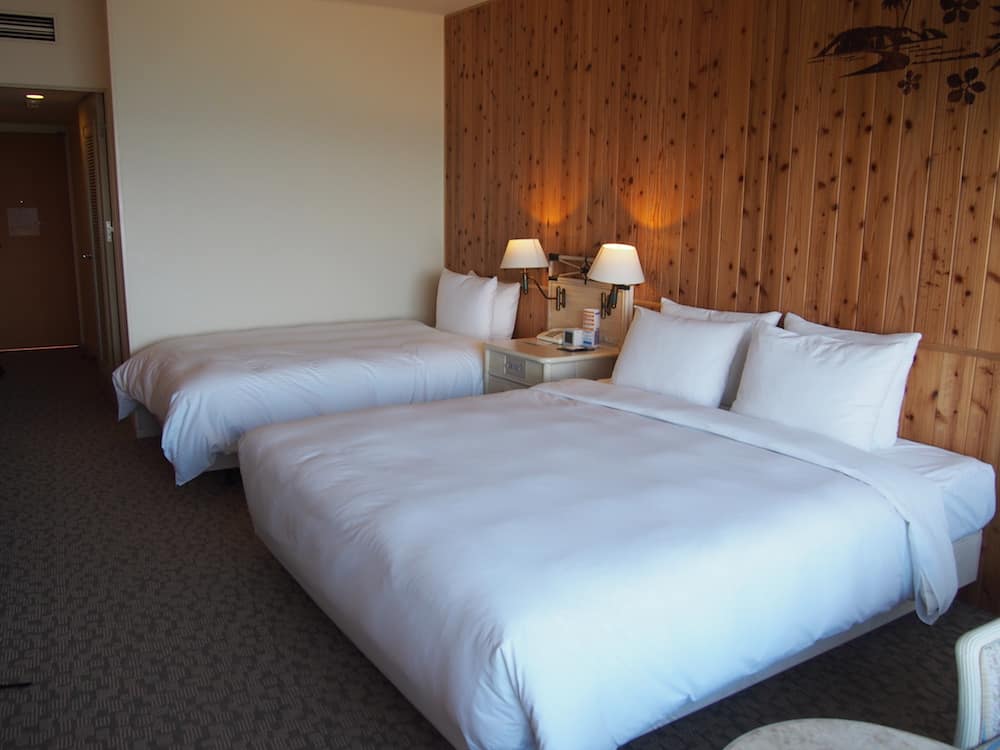
My husband quickly nabs a chair by the window and relaxes enjoying the magnificent views of Aoshima.
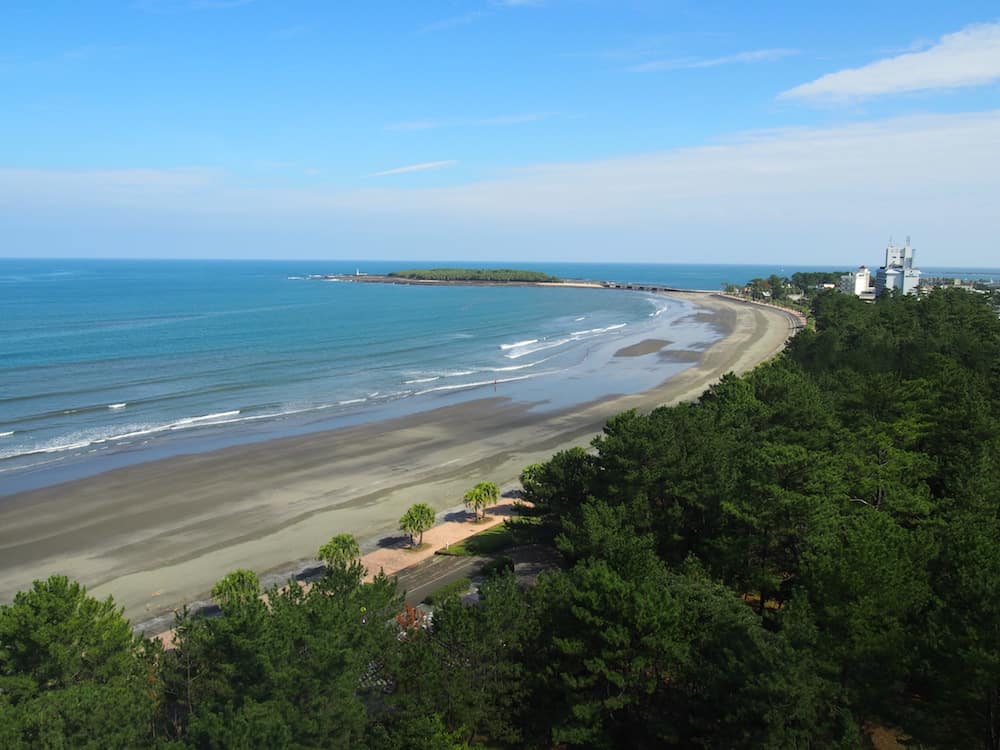
In summer, this resort is a popular holiday spot packed with surfers, swimmers and stand up paddleboarders. We’re visiting in off-season and officially the beach is closed (no patrols) but that doesn’t stop us from swimming at the beach every day. Due to the currents around this area, the water is a balmy 22 degrees with gentle waves.
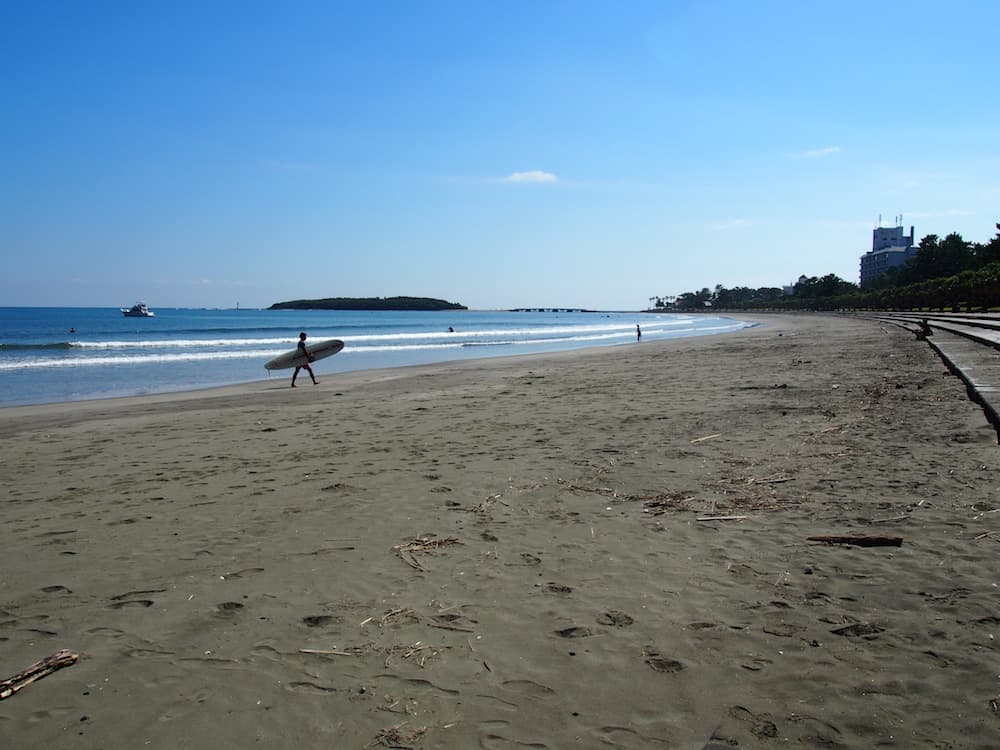
On our way to the beach, we frequently run into wedding parties. As the hotel includes a wedding chapel, we see many brides and grooms celebrating their nuptials.
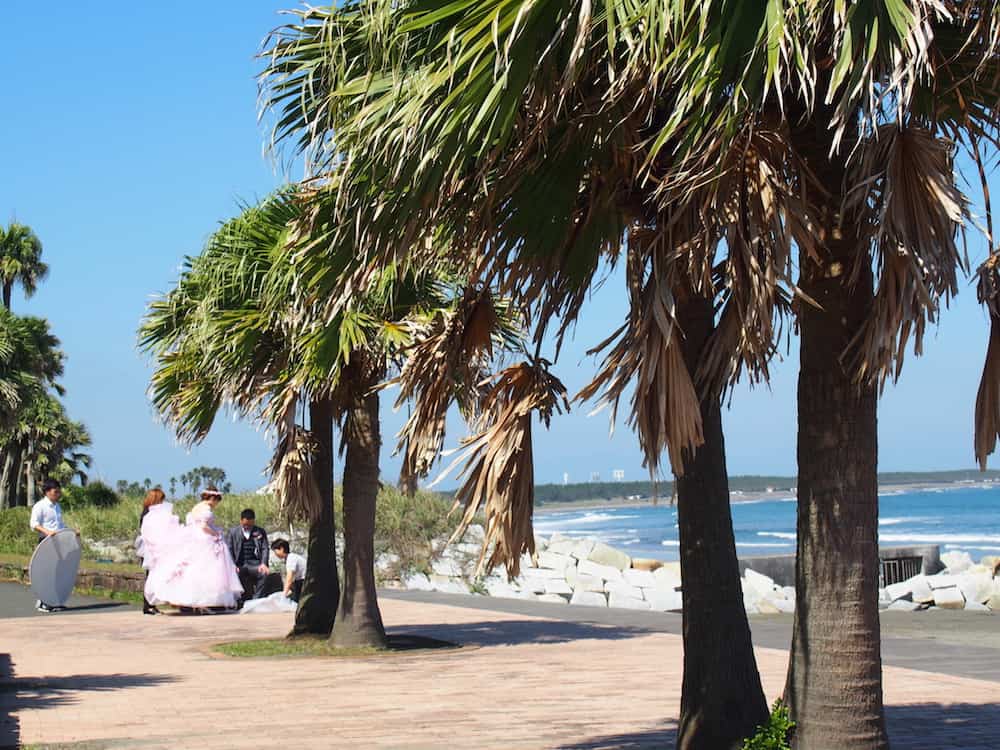
The hotel also includes an onsen, a segregated bathing area with pools of different temperatures as well as a sauna. Visiting an onsen is a daily occurrence for some Japanese and we make it a daily custom. I have to admit it’s an experience bathing nude in front of female strangers.
In between the relaxation, we explore the town and surrounds. It’s a beautiful area.
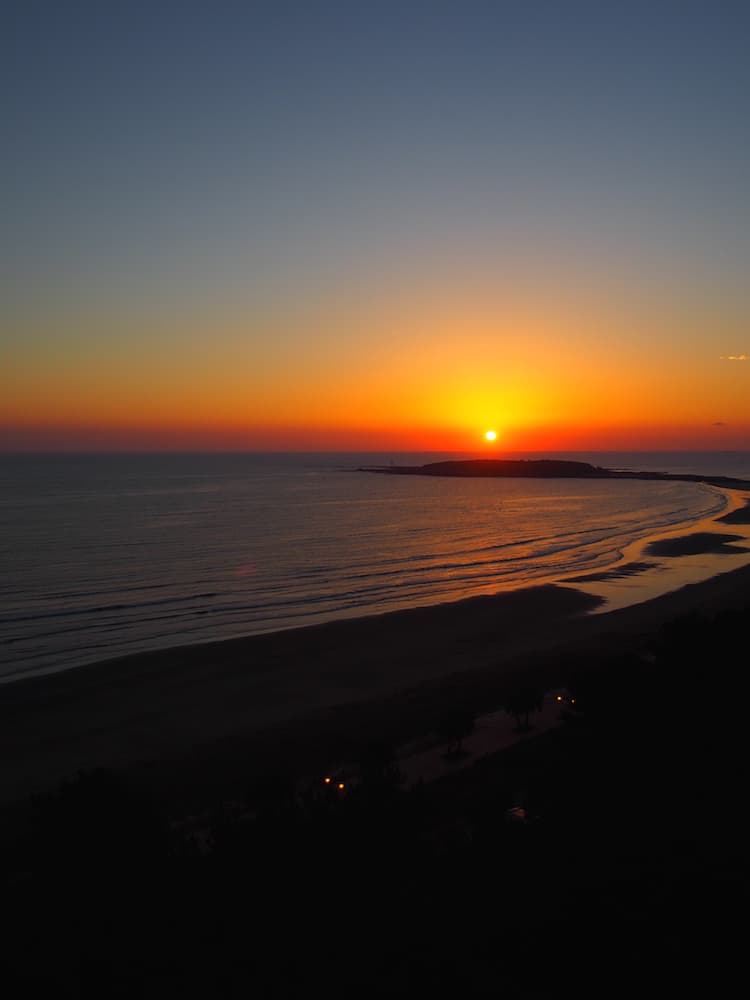
Aoshima is a small island which is connected to the mainland by a bridge.
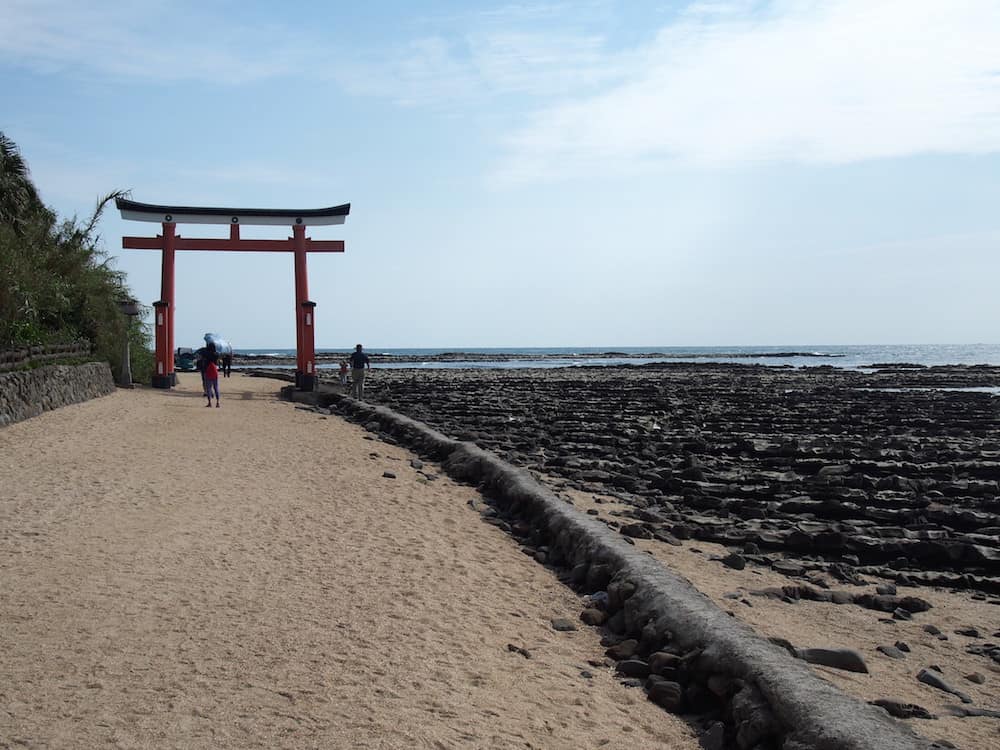
Many visitors come to pray at the Aoshima Jinja Shrine, which is especially popular with newlyweds as praying at the shrine is said to bring luck to married couples.
It’s 1.5km walk around the small island and during low tide on Aoshima Island, you can see the geological formations named the Devil’s Washboard. This is a series of straight, basalt rocks which look man-made.
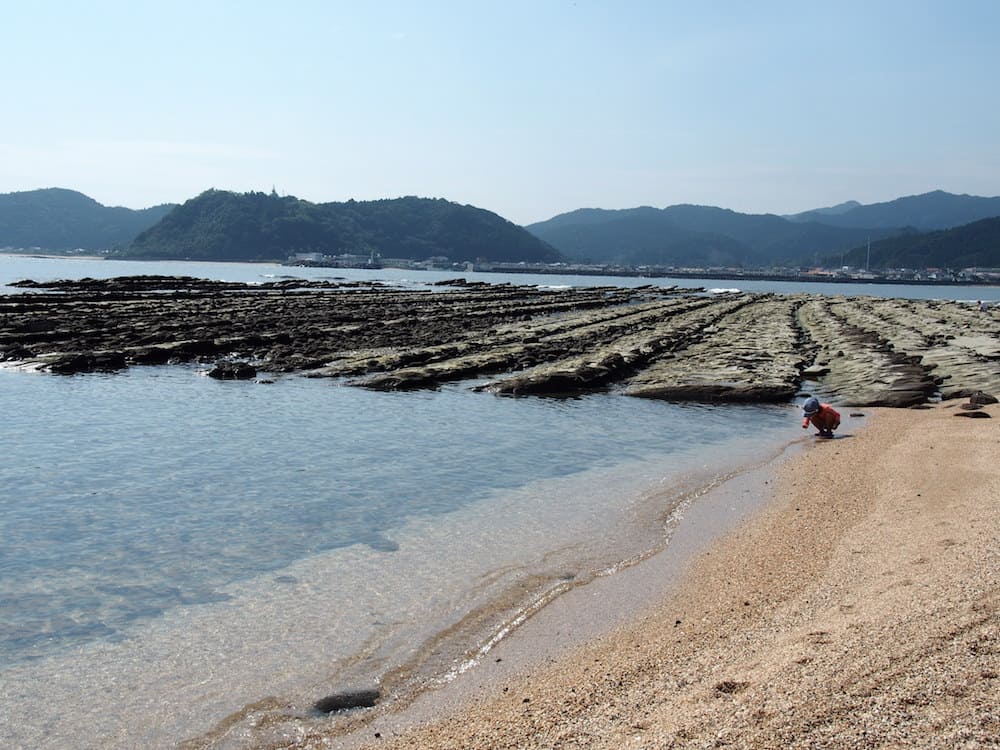
Another day, we catch the local bus and visit Udo Shrine 30 minutes away.
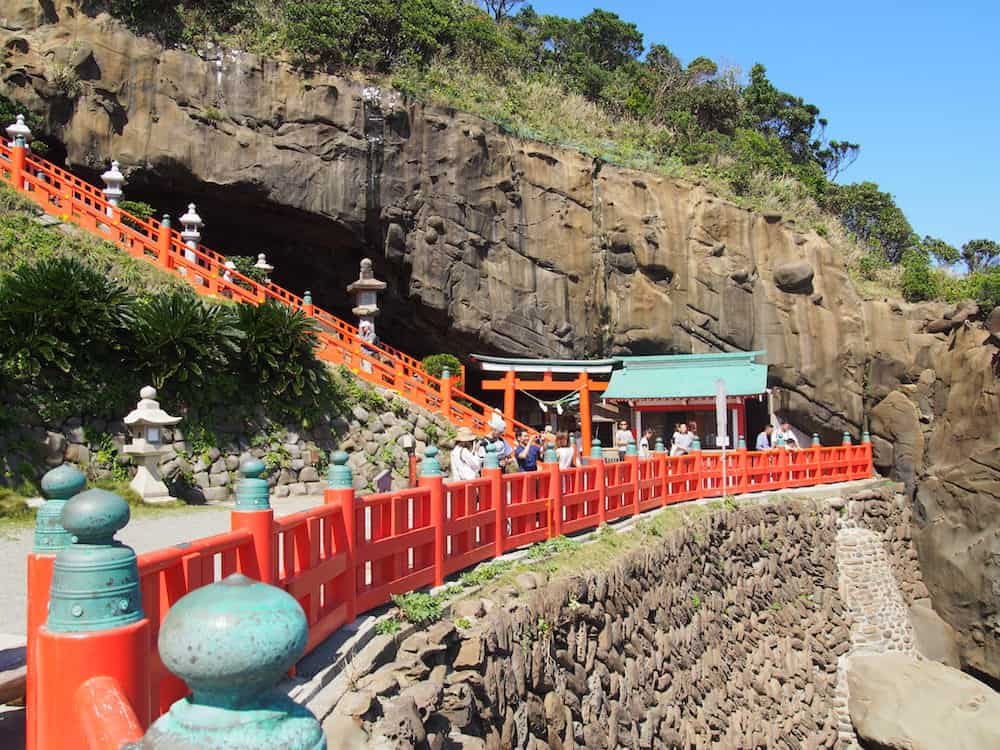
This colourful shrine is situated in a cave near to beach cliffs and is supposed to be lucky for couples and newlyweds. In fact, drinking the water that drips from the rocks is thought to help with conception, pregnancy and birth.

Outside of the cave is a clifftop terrace. From here, visitors throw ceramic lucky balls below hoping to reach a target marked by rope. The lucky balls are available to purchase at the shrine for 100 yen for 10 balls.
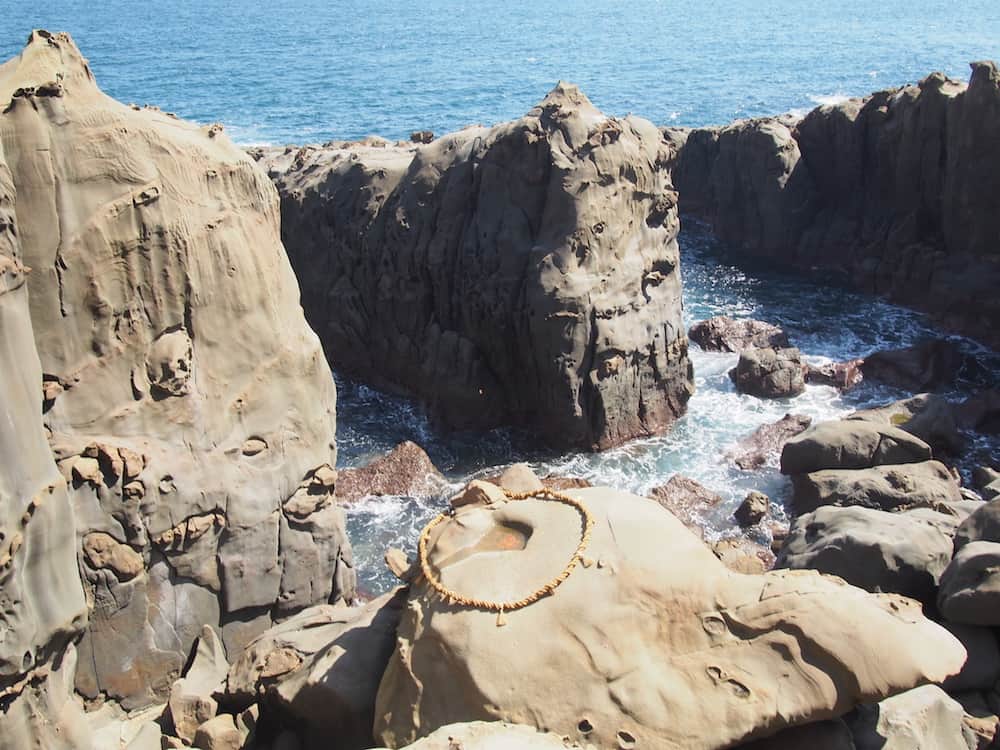
If your ball lands in the ring below, you’ll receive good luck. Women are supposed to throw with their right hand while men throw with their left.
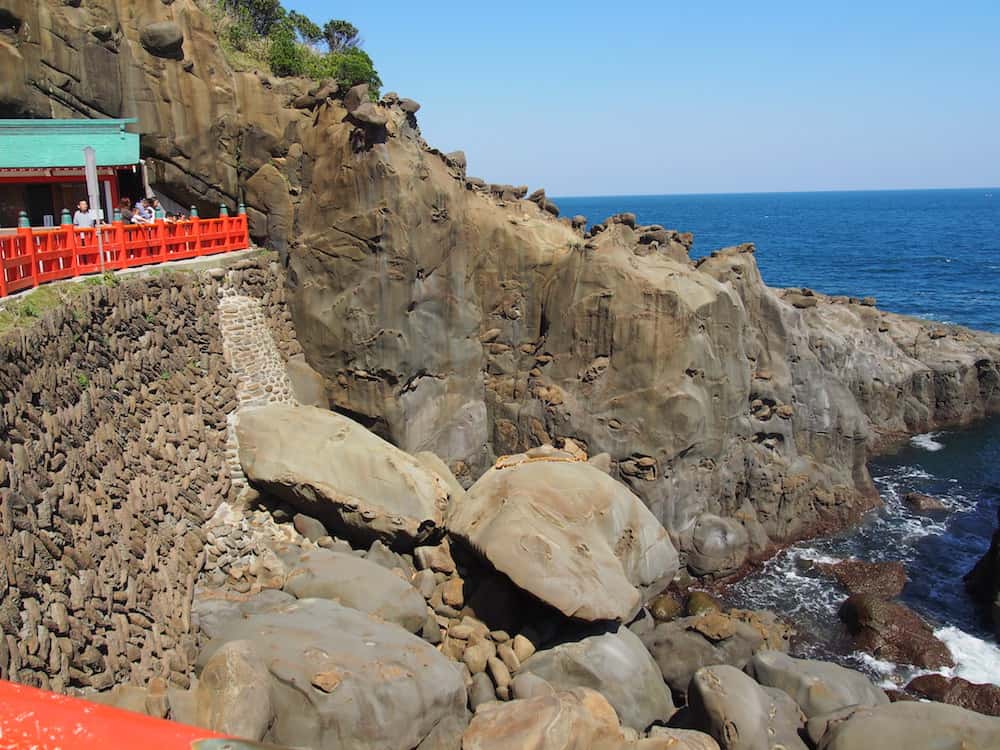
We purchase a few dozen balls and have fun throwing them off the cliff. Unfortunately, none of our balls land in the ring but we considered ourselves bestowed with plenty of luck.
After all, we’re enjoying a fabulous family holiday in Kyushu!
For more Japan family holiday information, visit my articles about our visits to Kyoto and Hiroshima
USEFUL INFORMATION
Getting There
It takes 8 hours to travel from Tokyo Station to Kagoshima Station with a transfer of trains at Shin-Osaka station.
I highly recommend that you you purchase a Japan Rail Pass (only available outside Japan). Available in durations of 7, 14 and 21 days, it’s a cost-effective way to travel around the country using JR train network. You can use it for all JR trains (excluding the superfast Nozomi trains) and JR ferries. There are two classes, Green (First class) and Ordinary.
We purchased Ordinary tickets and found them to be excellent. Kids 6 and under travel free on the trains. In 3 weeks travelling around Japan, we never once reserved a journey on the Shinkansen. Instead, we would arrive at the station and line up at the unreserved carriage area of the platform. This is ideal when you are traveling with children as you never have to stress about missing a train.
Make sure you bookmark the website Hyperdia as it contains train schedules and is indispensable in planning your trip.
Where to Stay
In Kagoshima, we stayed at the JR Kyushu Hotel Kagoshima in a Twin Room located within the JR Kagoshima train station. (JR Hotel Group, a subsidiary of Japan Rail, own and manage numerous properties around Japan adjoining train stations. They offer comfortable rooms and there’s discounts for JR Pass holders). Also adjoining the train station is a large shopping centre AMU Plaza with department stores, restaurants and grocery store. I’m in heaven when I find a Uniqlo and GAP stores.
In Miyazaki, we stayed at the Holiday Inn ANA Resort Miyazaki .We had a wonderful beach break at this hotel. Sign up to the IHG Rewards Club to earn points on your stay.
Getting Around
Getting around Kyushu, use a JR Rail Pass.
In cities like Kumamoto, Kagoshima and Sakurajima, there are tourist buses that take visitors around to designated sightseeing spots. All are reasonably priced. In Fukuoka, the subway is convenient and easy to use as well as the local bus system.
Kagoshima-Chou Station is next door to the AMU Plaza which is full of department shops, boutiques and eating places. We breakfast every day at Seattle’s Coffee and for dinner, just choose one of the many restaurants within the shopping complex.
We visited Kyushu prior to the pandemic. However, this article has now been updated with current information.
Kyoto with Kids: How to Enjoy Japan’s Cultural Capital
Why You Should Visit Hiroshima in Japan with your Kids
Want to work together?
© 2024 Family Forays
- Member registration/ログイン Mr./Ms. pt
- Search from experiences
- Search from area
- Search from features
- Online Experiences
- Setting・Help

- Play experience cheap reservation Activity Japan
- Special feature list
Recommended for families traveling with children in Kyushu! Accommodations, hotels, and sightseeing spots where you can spend a day

Huis Ten Bosch, Beppu Onsen, Sakurajima, etc. There are many popular tourist spots Kyushu Would you like to travel to
This time, Recommended hotels and tourist spots for families traveling with children in Kyushu Special feature. Activities and experiences to enjoy nearby I will also introduce you.
Kyushu If you are planning a family trip to Japan, please use this as a reference!
table of contents
- 1 Recommended hotel for families traveling with children in Kyushu 1: Hilton Fukuoka Sea Hawk/Fukuoka
- 2 Recommended hotels for families traveling with children in Kyushu 2: Hotel Amsterdam/Nagasaki
- 3 Recommended hotels for families traveling with children in Kyushu 3: Beppu Onsen Suginoi Hotel/Oita
- 4 Recommended tourist spots in Kyushu for families with children 1: Miyazaki Science and Technology Museum/Miyazaki
- 5 Recommended sightseeing spots in Kyushu for families with children 2: Kamino Park Children's Amusement Park/Saga
- 6 Recommended sightseeing spots in Kyushu for families with children 3: Kagoshima City Hirakawa Zoological Park/Kagoshima
- 7 Summary of recommended accommodations and tourist spots for families traveling with children in Kyushu
- 8 Feature articles recommended by the editorial department
Recommended hotel for families traveling with children in Kyushu 1: Hilton Fukuoka Sea Hawk/Fukuoka
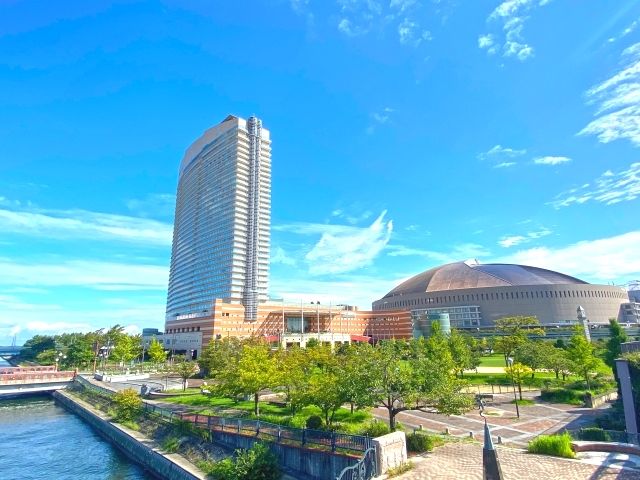
Located about 20 minutes by car from Fukuoka Airport, Hilton Fukuoka Sea Hawk "teeth, Fukuoka's largest resort hotel .
All rooms have ocean views! You can see Hakata Bay right in front of you, and the view from your room is amazing.
Restaurants with kids spaces and amenities for children, etc. Plenty of services for those traveling with children doing.
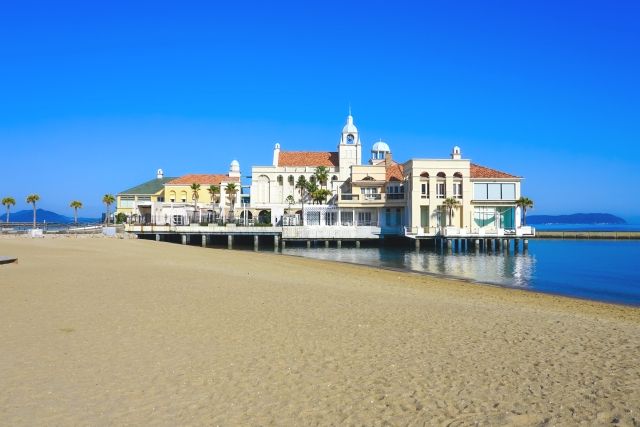
Artificial beach Seaside Momochi Seaside Park ” is also right in front of the hotel, where you can enjoy playing in the water and walking around.
You can enjoy various leisure activities. Uminonakamichi Seaside Park "or" Fukuoka Tower ” access is also good!
Also, around the Hilton Fukuoka Sea Hawk Traditional craft experience Also popular. Participating with your family will create wonderful memories of your trip!
[Fukuoka/Hakata] Hakata doll “painting experience” even small children can enjoy! 1 minute walk from the station
How about painting a Hakata doll as a memory of your visit? Something for everyone to enjoy. You can take your completed work home on the day. At one of the largest stores in Japan, you can take your time to browse a wide variety of Hakata doll works. We have a wide selection of Hina dolls, zodiac dolls, May dolls, and Hakata dolls from master craftsmen to works by young artists.
[Fukuoka Traditional Craft Experience] Make your own original strap with a braid experience! [Plan with tea and sweets]
This plan is not available in English.
You can try your hand at braiding at one of the few braiding classes in Fukuoka. Create your own original strap using the braided cord that became a hot topic in popular animated movies. Since the thread uses "silk", you can make authentic items. You can choose from a wide variety of combinations using the cherry blossom round stand, so you can create an original work that suits your taste.
Recommended related articles

Recommended hotels for families traveling with children in Kyushu 2: Hotel Amsterdam/Nagasaki
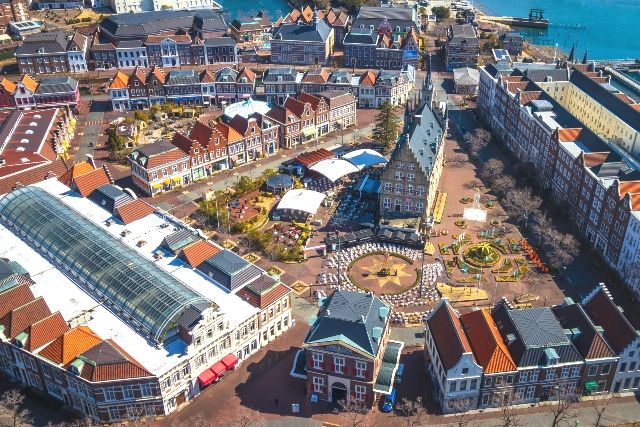
Nagasaki ・ Sasebo City It is in" hotel amsterdam "teeth, popular theme park " Huis Ten Bosch ” Hotels within .
Easy access to all spots in Huis Ten Bosch, All rooms are over 45 square meters It is spacious and offers a comfortable stay. .
In addition, Hotel Amsterdam Free co-sleeping for children up to elementary school age . There are also amenities for children, so you don't have to worry about traveling with children, who tend to have a lot of luggage.
Being located within the Huis Ten Bosch theme park zone, Even if your child gets tired, you can return to the hotel immediately. I'm happy about that. If you're visiting Huis Ten Bosch with your kids, consider staying at Hotel Amsterdam.
The area around Sasebo City where the Amsterdam Hotel is located is Tatsunokuchi and Kujukushima such as, Marine activities There is a sea where you can enjoy. Why not try participating with your children?
[Nagasaki/Sasebo/Kujukushima] Easy trial kayak tour (from 2 people)
[Response to the new coronavirus and requests] (Responses from the host company) - The guides who guide customers and all other staff members are checking their physical condition every day.・Kayaking supplies and equipment are disinfected after each tour. <Requests and Precautions> ・Please make sure that you do not have a fever or cold symptoms on the day of your participation. [Other/Notes when applying

Recommended hotels for families traveling with children in Kyushu 3: Beppu Onsen Suginoi Hotel/Oita
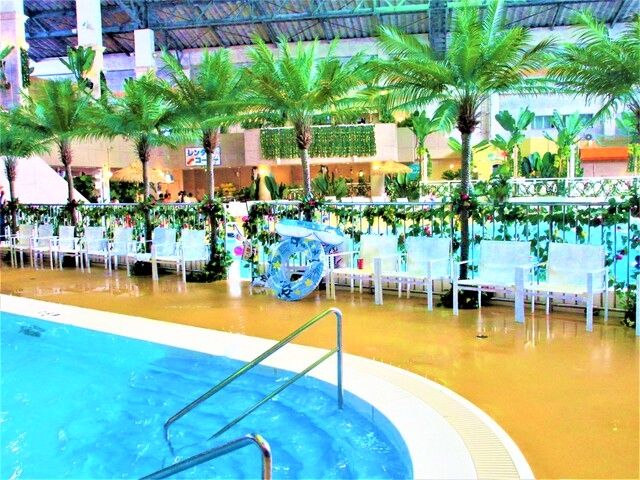
Oita ・Speaking of Beppu Onsen, the amount of hot spring water gushing out ranks first in Japan! " Suginoi Hotel "teeth, The largest resort hotel in Beppu Onsen There are plenty of facilities and programs that the whole family can enjoy.
A hot spring pool unique to Beppu Onsen and an open-air bath with a spectacular view . Fountain art show event at night There are plenty of things to enjoy at the hotel, such as events held at the hotel.
Meal menus and amenities for children, etc. Tips for keeping your family safe has been done.
In addition, there are spots and plans around Suginoi Hotel where you can enjoy Beppu Onsen even more. Why not enjoy even more of the charm of Beppu Onsen, which boasts the highest amount of hot spring water in Japan?
Oita/Beppu Onsen [Elementary school students/meat BBQ] No fire or garbage to take home! After your meal, take a break in the footbath. [Recommended for couples, families, and women])
●Relax and enjoy a barbecue at a semi-outdoor seat where the Beppu hot spring mist wafts in the air! ●Charcoal-grilled meat is exquisite! ●Enjoy to your heart's content with your favorite toppings ♪ Experience BBQ at the hot spring resort of Beppu ♪ We'll make a fire here according to your arrival time Feel free to bring your own without having to worry about the 3Cs in the spacious grounds BBQ♪ Treat yourself or your loved ones to a walk along the river, or take a footbath at the hotel.
[Oita/Beppu] The world's best hot spring town "Beppu tour" welcomes inbound tourists! Introducing courses tailored to you while taking a taxi or walking ♪ Hot springs, city walks, cafes, shrines
Inbound welcome! Our Japanese staff who can speak English will guide you through the world's best hot spring town, focusing on places that only locals know! Beppu is one of the world's leading hot spring resorts. You can also try unusual hot springs such as steam baths and sand baths. Courses can be changed flexibly for each group and can be combined to suit just you, depending on your hobbies and age.
Recommended tourist spots in Kyushu for families with children 1: Miyazaki Science and Technology Museum/Miyazaki
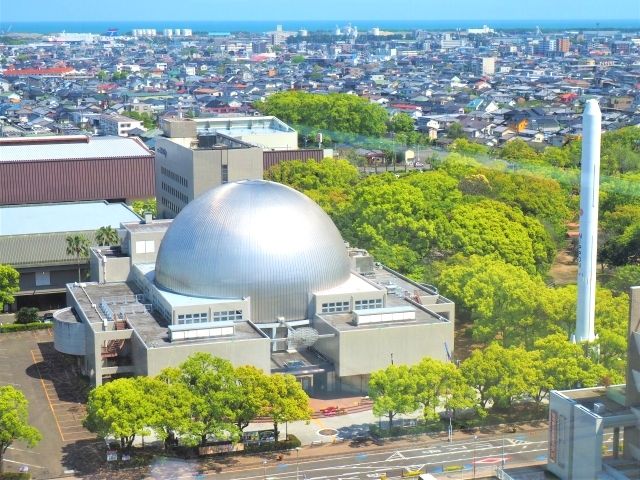
Located about 2 minutes walk from JR Miyazaki Station, Miyazaki Science and Technology Museum” teeth, Kyushu A technology museum with one of the largest planetariums in Japan. is.
In addition to the impressive planetarium, there are also plenty of experience facilities and classrooms that will pique your curiosity!
You can only see it at Miyazaki Science and Technology Museum. Full-scale models of spacecraft and experimental equipment and exhibits where you can actually experience the fun of science. " play with science ” A place where you can enjoy learning about space and science. is.
It's not only a place that kids can enjoy, but adults can also get excited about.
In addition, various activities are popular around the Miyazaki Science and Technology Museum. Miyazaki using special products from Manufacturing experience It will be a great memory of your trip to Miyazaki!
[Miyazaki Prefecture/Miyazaki City] Milk hearth made using milk from Miyazaki Prefecture
This is Lala Kitchen, a cooking and baking class in Miyazaki City. We will teach you the basics, so even beginners can participate with confidence. Now that we have more time at home, why not start a hobby that you can do at home?
[Miyazaki/Aya] Feel free to weave a tea mat with an old-fashioned loom! Beginners and small children welcome! No need to bring anything.
This is a tea mat weaving experience at Genta Dyeing and Weaving Studio. Just choose your favorite color thread and weave it with a flick of a button! We welcome everyone from small children to the elderly, as well as those weaving for the first time.Even foreigners can have fun weaving and go home with hand gestures. We have received feedback that it is ``pretty good'' as a mouse pad. Since this is an indoor activity, please check the weather.
Recommended sightseeing spots in Kyushu for families with children 2: Kamino Park Children's Amusement Park/Saga
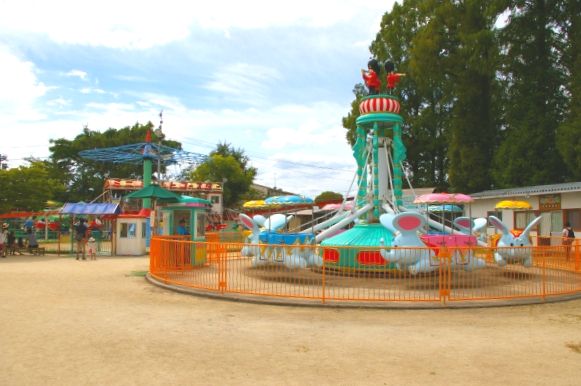
Saga ・ Saga City It is in" Kono Park Children's Amusement Park "teeth, An amusement park located in Kamino Park, a famous spot for cherry blossom viewing. . Most of the attractions are aimed at young children. Therefore, you can let small children play with peace of mind.
And what's more, Admission and parking are free ! You can play with just a vehicle ticket, so it's easy on your wallet.
There is also a shop, You can bring in food and drinks So bring your own lunch and enjoy the picnic atmosphere! Events are held every season, so you can enjoy it all year round.
Also, around Kamino Park Children's Amusement Park, Manufacturing experience or Food making experience is popular. Please stop by after playing at the amusement park!
[Saga/Saga City] Even small children can enjoy it! Made with buckwheat grown without pesticides (soba making experience)
The buckwheat flour, which is made by grinding homemade pesticide-free buckwheat seeds, is proud of its aromatic flavor. Smooth and cool. When you add buckwheat flour and water, you can smell the aroma of buckwheat. The pleasant sound of the knife. The firmness of the finished soba... You can enjoy making soba using all five of your senses. The soba you make yourself has a special taste. Family, friends, and work colleagues
[Saga, Saga, Yoshinogari] Woodworking experience. Parent and child! With family! As a couple! With friends! alone! Even children can do it. By appointment only. 2 minutes walk from the bus stop. Parking lot also available
This is a small group woodworking experience plan that requires reservations. Morotomi-cho, Saga City, Saga Prefecture is adjacent to the furniture town of Okawa City, Fukuoka Prefecture, and is the second largest furniture production area after Okawa. Why not try making your own spoons and plates in this woodworking town? It can be made by elementary school students and above. It can even be made by children as young as 4 years old. Even if you receive a lecture directly from the craftsman,
Recommended sightseeing spots in Kyushu for families with children 3: Kagoshima City Hirakawa Zoological Park/Kagoshima
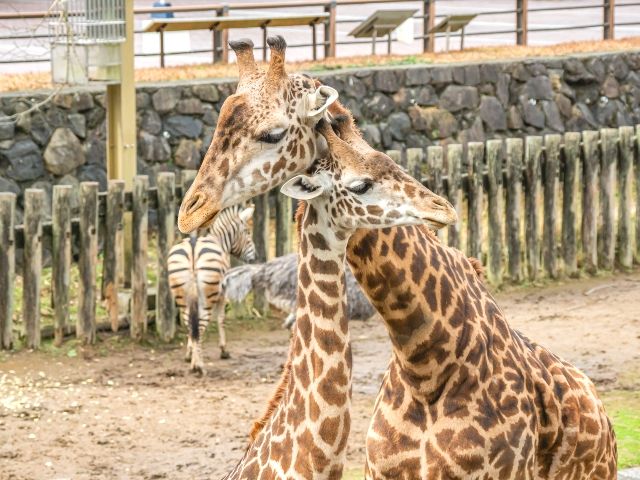
Kagoshima ・ Kagoshima City It is in" Kagoshima City Hirakawa Zoological Park "teeth, " An animal park where you can learn and have fun A facility based on the concept of .
More than 130 types of animals are kept in the park, and you can actually interact with them, such as observing their ecology and feeding them. .
An area where Kagoshima's symbol, Sakurajima, is likened to Africa's Kilimanjaro. African Grassland Zone (African Garden) ”, which is rare even in Japan. masai giraffe can be observed. The collaboration between the majestic Sakurajima and the Masai giraffes walking across the vast grassland is a sight to behold!
There is no need to worry if your child gets tired of walking, as there is a bus that goes around the park. A nursing room is also available. Inside Hirakawa Zoological Park amusement park There is also an amusement park after the zoo, so you can have fun all day long without getting bored.
Also, around Hirakawa Zoological Park, Kagoshima Unique Manufacturing experience is popular. Why not take part in making memories of your trip to Kagoshima with your family?
[Kagoshima Prefecture/Kagoshima City] (Admission ticket included) Even beginners can do it! Plant-dyed stall experience
Vegetable dyeing is the process of boiling flower petals, grass, tree branches, etc. to extract pigments and dyeing cloth. This vegetable dyeing is also used in some of the dyeing techniques for Oshima Tsumugi. At Amami no Sato, you can experience making original stoles with deep colors by dyeing handkerchiefs and other fabrics with plants. After the experience, you will be able to enjoy the beautiful Japanese garden and Amami that show off the expressions of each season.
[Kagoshima/Hioki] “Rokuro pottery experience” at Miyama Toyukan, empty-handed!
Miyama Touyukan is an experience-based recreational facility built in ``Satsuma Yaki no Sato Miyama'' in Hioki City, Kagoshima Prefecture. At our facility, we currently offer pottery experiences to 4,000 groups of customers a year. In addition, the sales floor sells products from Modern Satsuma Co., Ltd., which runs the museum, and exhibits and sells works made at potteries and workshops scattered throughout Miyama.
Summary of recommended accommodations and tourist spots for families traveling with children in Kyushu
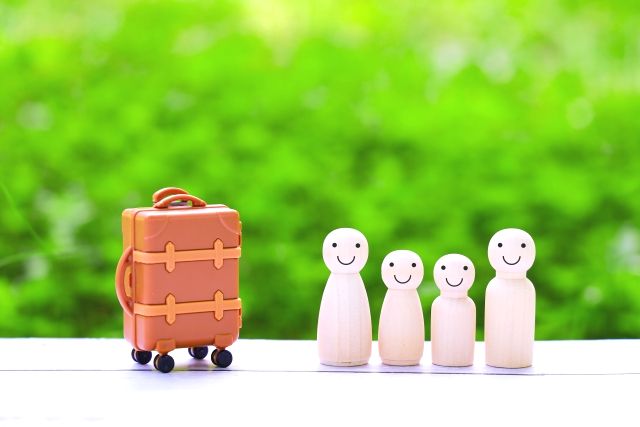
This time Hotels and sightseeing spots that you can enjoy with your family in Kyushu with peace of mind We mainly introduced.
When traveling with children, you may be concerned about where they play and where they stay.
Kyushu Please use this as a reference if you are planning a family trip to Japan.
*The content of this article is current as of September 2023.
Feature articles recommended by the editorial department
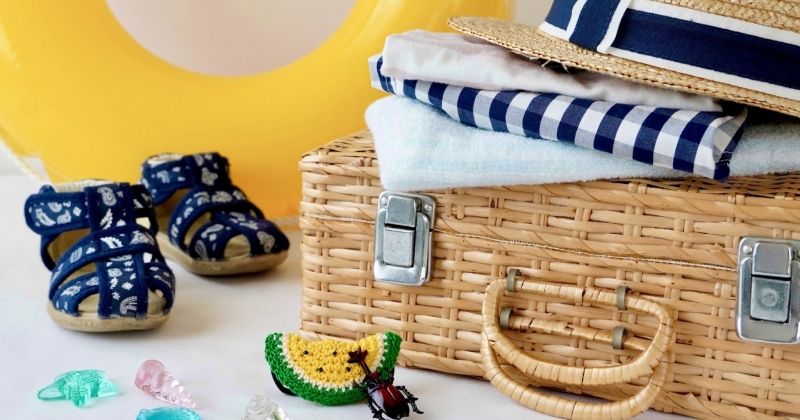
We would like to express our sincere gratitude for your continued patronage.
At our company, in order for many customers to enjoy various activities all over Japan safely and with peace of mind, the Ministry of Health, Labor and Welfare's " Basic Policy for Countermeasures against Coronavirus Infectious Diseases " and " Let's Avoid the Three Cs "・ Based on the " new lifestyle ", we recommend the following infectious disease countermeasures to the operator.
- Instructors and participants keep a sufficient distance
- Use masks as much as possible while participating
- Ventilate frequently, avoiding closed spaces
- Thorough hand washing and disinfection
- Thorough disinfection of equipment
- Health management of customers and employees, etc.
For infection prevention measures of the operating company, please refer to [Appeal points for safety] or [Notes on participating in the course ] of each operating company information at the bottom of the plan reservation page, and for details, please contact each operating company directly. Please contact us.
You can also check the following page for information on the efforts of activity companies in each region!
How to enjoy new activities in the after / with corona era
Even if you are a customer, when you continue to go out, in addition to avoiding so-called [three secrets], cough etiquette, thorough hand washing and alcohol disinfection, etc., on June 19, 2020 (Friday), Ministry of Land, Infrastructure, Transport and Tourism, sightseeing Please be aware of the [new travel etiquette ] announced by the Japan Tourism Agency, take actions to avoid the risk of infectious diseases, and enjoy activities and leisure activities safely.
Even now, there are tourist facilities and activity operators whose business hours and dates have changed. Please check the calendar status at the time of application and check the latest information with each operator even after the reservation is completed. Please check with each operator regarding whether or not there is a cancellation fee due to sudden closure of the facility, cancellation of the activity experience, etc.
In addition, Activity Japan also offers an "online experience" service where you can enjoy various activities!
[Online experience] New experience online anywhere
The "online experience" service is digital content that can be expected to create a new community by connecting customers with local and tourism businesses on a daily basis. Those who have difficulty going out due to circumstances, those who want to try but are uneasy about having a real experience suddenly, those who want to collect local information to plan future trips and stay plans, etc. Feel free to meet local instructors and guides online and enjoy a conversation while experiencing a simulated experience!
Please use it together.
Find experiences nationwide
7 days, 6 nights
The following is a suggested, very fast paced itinerary for travelers who spend 7 days and 6 nights in Kyushu . This itinerary is designed around using a rental car for some of the rural areas where public transportation is inconvenient. Public transportation can be used instead of a rental car, however, it will result in longer travel times.
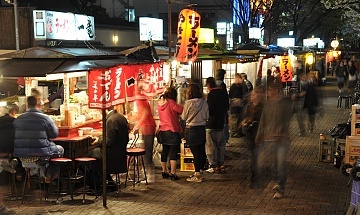
Day 1 - Arrive in Fukuoka
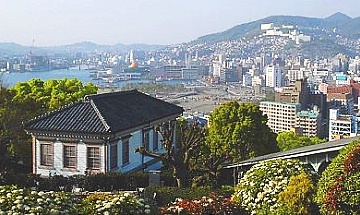
Day 2 - Nagasaki
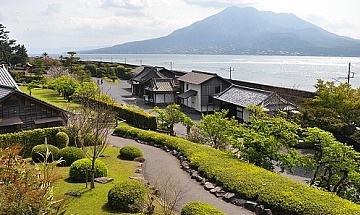
Day 3 - Kagoshima
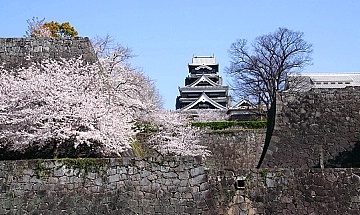
Day 4 - Kumamoto
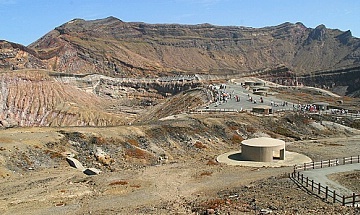
Day 5 - Aso and Kurokawa
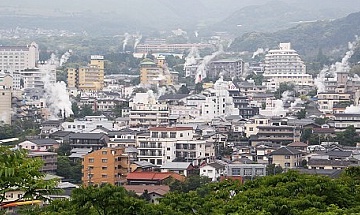
Day 6 - Beppu
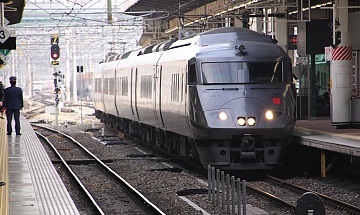
Day 7 - Return to Fukuoka
A 7-day All Kyushu Rail Pass pays off for this itinerary. A rental car is recommended for days 5-6. Alternatively, public transportation can be used for the entire itinerary at a possibly lower cost, but with appropriate adjustments made to account for the longer travel times. Below are some sample budgets for the itinerary, excluding airfare. Find out more about the sample budgets and about the current yen exchange rates .
Questions? Ask in our forum .

- What to do in Shanghai
2 Weeks in Iceland Itinerary
A week in north eastern vietnam.
- What to do in Berlin
1 Week Shikoku Itinerary
Renting a car in shikoku.
- 3 Days in Lisbon – What to see and do
- What to do in Karakol – Hiking to Jeti Oguz
- X (Twitter)
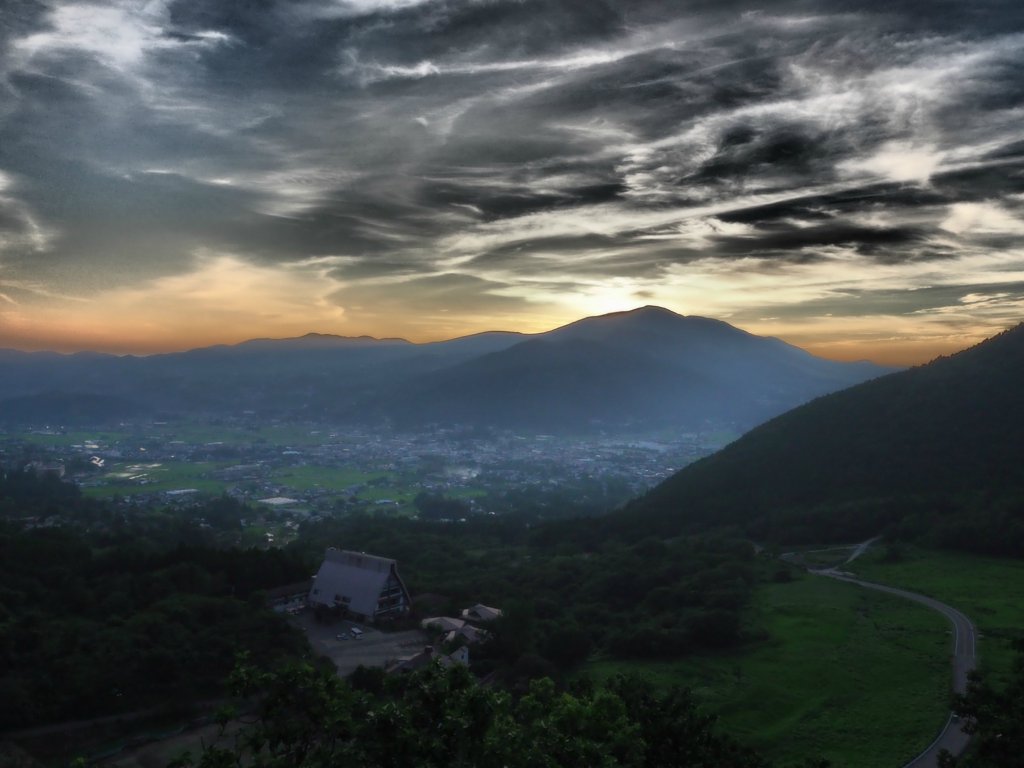
2 Weeks in Kyushu – A suggested itinerary
2 weeks in kyushu.
T he most south-westerly of Japan’s 4 main islands, Kyushu is certainly off the beaten track and barely makes it onto the radar of many travellers and hopefully, it will stay that way. With a rugged coastline and mountainous centre, onsens galore and some of the best food in Japan, Kyushu is truly one of Japan’s highlights.
Getting to Kyushu
Kyushu’s main airport hub is in the northern city of Fukuoka. With good connections from across Asia, especially from China, South Korea and Taiwan, Kyushu is easily accessible for those in East Asia. Further afield and the number of direct flights drops dramatically. From further afield you will most likely fly through Seoul or Tokyo en route to Fukuoka.
Getting around Kyushu
The JR network here is pretty good with excellent connections between Kyushu’s major cities. However, to really explore the best bits of Kyushu is with your own set of wheels . This will allow you to access some of the island’s most stunning locations. We have an article on renting a car in Kyushu , however, if you want information on renting and driving in Japan we have an additional post on renting a car in Hokkaido .
However, it is very important to remember that you need an International Driving Permit (IDP) to drive in Japan. If you do not have an IDP then you are not going to be eligible for a refund when you arrive at the rental car depot.
We rented our car through the Japanese firm ToCoo .
When to visit Kyushu
Kyushu has a similar climate to Taiwan and Shanghai; hot, wet summers and cold winters. Like Taiwan and Shanghai, the best times to visit are spring and autumn, and understandably these are peak travel times. We visited in July which gave us scorching weather and a couple of huge typhoons. Japan is extremely well prepared for typhoons, but naturally, they can lead to road closures and landslides as per 2018.
Winter is certainly not as cold as in Hokkaido where the mercury regularly plunges below zero and the roads are hammered with snow. With the temperature hovering around the zero mark, winter could also be an excellent time to visit as the crowds will certainly be smaller than during the rest of the year.
What to do in Kyushu
In short, a lot. The itinerary below is what we did when we visited Kyushu. There were certainly things that we missed and we’ve detailed some of those at the end of the article.
Kyushu has numerous onsen regions, most notably the Oita region which is home to the very famous onsen town of Beppu as well as the smaller and prettier town of Yufuin. There are plenty more hiking areas than what we were able to visit; typhoons prevented visits to the Kirishima National Park and climbing Kaimon Dake at the very southerly tip of the island.
There is great reward in exploring the island. The coastline, particularly in the Miyazaki region is incredibly beautiful with numerous points that are worth checking out. Additionally, Unzen, Hirado, Takachiho and Kagoshima are littered with undiscovered gems.
Our itinerary
We began and ended in Fukuoka, Kyushu’s most captivating city. We were in Kyushu for a total of 15 days and whilst we were able to see a huge amount there was plenty we missed out on, most notably the island of Yakushima, Kirishima National Park, Dazaifu and the islands northeast.
Additionally, we have an article on budgeting in Japan to offer you a few money-saving tips and show that Japan is not as expensive as you think.
Day 1: Fukuoka
Starting in Kyushu’s main city of Fukuoka we spent the day exploring the city and wandering around the temple district very close to Gion subway station. Located in the Hakka half of the city the area is home to a stunning collection of temples and gardens, many of which are free. The largest temple in the area is the Tocho-ji Temple and in addition to being home to a gorgeous temple, it is also home to a stunning carved Buddha.
Fukuoka is home to some excellent cuisine, with the central area around Tenjin being jam-packed with excellent izakayas. The city is famous for its live squid sashimi, delicious if a little morally questionable.
Getting Around
Fukuoka has an excellent subway system with a variety of day cards and travel passes. To take the subway from international arrivals take the free bus outside and get off at the domestic terminal. Here you can jump on the subway to get into the city centre.
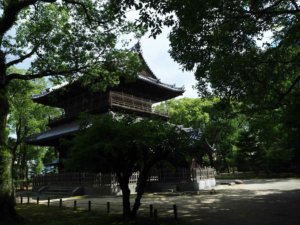
Day 2: Hirado
We picked up our hire car and headed west towards the port town of Hirado. We arrived early afternoon and headed straight for Hirado Castle. Expect awesome architecture and stunning coastal views.
At one point Hirado was the port of entry into Japan for Dutch traders and missionaries. However, this changed with the creation of Dejima in Nagasaki followed by Japan’s period of isolation.
We headed to Ji-in to Kyokai no Mieru Michi to check out the Dutch church and a couple of temples. The town has a bunch of secluded beaches and some excellent museums that are well worth checking out. Sadly our time was limited.
We then headed up to the Kawachi Pass which offers stunning views over the island. Despite the fact it had been raining most of the day we caught a break and had clear skies for a gorgeous sunset.
We could have easily spent 2 or 3 days exploring the island of Hirado, however, there were so many other awesome things to do in Kyushu!
We then drove on to Nagasaki where we had an Airbnb booked for 3 nights. Driving in Nagasaki is confusing. There are a number of toll roads, some of which are covered by the Kyushu Expressway pass, one-way systems and various other bits and bobs that can make it a hair-pulling experience. Fortunately, the drivers of Nagasaki were extremely forgiving to a confused tourist.
Parts of the city are made up of alleyways that work their way up the hills that surround the city. In places, these alleys are just slightly wider than the average car. Safe to say it was an interesting experience.
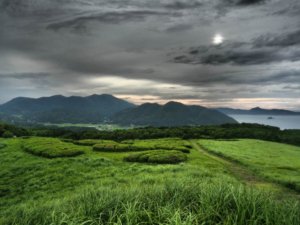
Day 3: Nagasaki
Nagasaki will always be synonymous with the events of August 1945, however, like Hiroshima, it has risen from the ashes and has developed into a gorgeous city with heaps to see and do.
We were greeted with our first typhoon and spent most of the day seeking shelter and drying our clothes, however, it certainly didn’t dampen our experience.
Although Nagasaki does not have a subway its tram network is excellent and can get you all over the city.
We first headed to the Atomic Bomb Museum and the accompanying Memorial Hall. Safe to say it was an incredibly moving experience and gives you insight into one of the most turbulent periods in history.
Sadly the typhoon closed Dejima so we spent the rest of the afternoon playing in a Japanese arcade.
Day 4: Mount Unzen
Fortunately, the typhoon had moved on we were left with clear blue skies for a day trip to Unzen.
We first headed to Mount Unzen and were treated to some lovely views en route.
There are plenty of hikes, however, the typhoon the previous day meant that there were a number that were inaccessible. However, after taking the cable car partway up, the trail to Mount Kunimi was still open. The trail is pretty easy until the end where you will need to use chains to get to the summit, but the views are worth it.
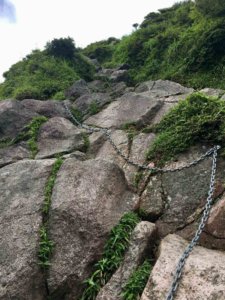
We then headed on to the town of Unzen and checked out some temples and Unzen Jigoku before heading to a public onsen which was easily the hottest onset we’ve ever experienced.
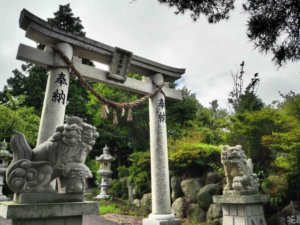
A tori gate in the town of Unzen
Day 5: Kumamoto
After visiting Peace Park in Nagasaki in the morning we drove to Kumamoto. You can take a ferry but be warned, it is expensive. When we hit a typhoon on the way down the further vindicated our decision to avoid the ferry.
Kumamoto is famous for two things; its stunning castle and the town mascot, Kumamon. Sadly the castle was badly damaged by an earthquake in 2016 and is still undergoing extensive repairs. Sadly visitors cannot go in, but Kumamoto is certainly a nice place to spend an afternoon.
The city has some decent museums and a fair few awesome restaurants.
Day 6: Chiran
For the majority of our drive down to Chiran, we had to contend with a huge typhoon on the highway. After passing through Kagoshima and continuing south we arrived in the small town of Chiran, famous for its old Samurai houses.
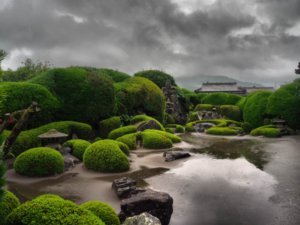
Interestingly the storm drains in the town are full of koi carp!
We then returned to Kagoshima where we stayed for 3 nights.
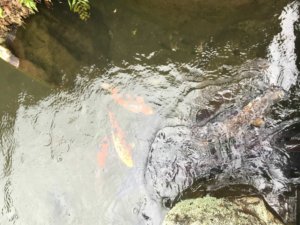
Day 7: Ibusuki
The typhoon of the previous day had moved on to pastures new. We began by heading to the Kamikaze Museum on the outskirts of Chiran for a fascinating insight into the Kamikaze division of the Imperial Japanese Airforce.
As the USA moved closer to Japan’s home islands, with Japan short on pilots, planes and raw materials leaders in Tokyo believed that the Kamikaze division would halt the American’s progress and potentially turn the tide of the war.
The excellent audioguides provide a lot of information on one of the most well-known military units in history.
From here we headed down to the small town of Ibusuki famous for hot sand bathing which we dutifully sampled. The sand spa was twined with a huge open-air onset perched on the edge of a cliff with amazing coastal views. Probably the best onsen we visited in Japan.
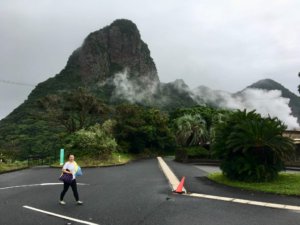
Day 8: Kagoshima
We finally had clear blue skies and took the opportunity to check out Kagoshima. It’s certainly not the biggest Japanese city but there’s enough to keep you occupied for the day. The waterfront has a bunch of free foot spas and great views of Sakurajima, which is consistently burping out ash.
For sunset head up to the hill to the east of the city for spectacular sunsets with some local cats.
Had the area not been hit by a typhoon Kirishima would have been the order of the day, however, there were numerous landslide warnings so we decided to play it safe.
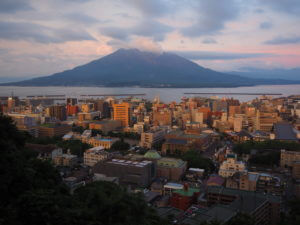
Day 9: Mount Sakurajima
A definite highlight of any trip to Kyushu is a trip to Sakurajima. A very active volcano just over the bay from Kagoshima, it is constantly pumping a little bit of ash into the sky.
From Kagoshima, the best way to get to Sakurajima is to take a 20-minute ferry across the bay. If not it’s an hour and a half drive.
Sakurajima is chock full of short hikes, free foot spas and awesome viewpoints. After spending the day exploring Sakurajima we head on towards the tiny surf town of Aoshima.
Outside of peak surf season, the town is deserted – a pleasant and eerie experience. That evening we headed out to explore the Aoshima shrine and sampled one of the region’s most unique dishes – chicken sashimi.
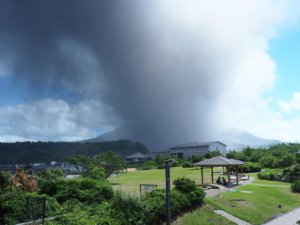
Day 10: Aoshima, Udo Jingu, and Hyuga
From Aoshima, we headed south to the Udo Jingu Shrine, which is probably one of the most stunning on the island.
We then headed north and spent the afternoon hiking around the Hyuga peninsula. Offering deserted trails and stunning coastal views this was definitely one of our most surprising finds. Kyushu itself is very much off the beaten track and this is off the beaten track on Kyushu, so go figure!
We then drove into the island’s centre, to the small town of Takachiho famous for its gorge of the same name.
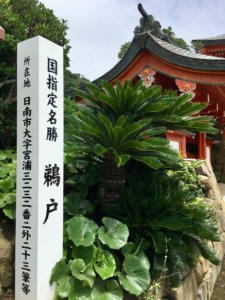
Day 11: Takachiho
Takachiho is absolutely gorgeous. Country roads wind their way through mountains, valleys and rice paddies.
We spent the morning in Takachiho Gorge. The trail from the car park through to the end of the gorge is certainly not one of the most strenuous hikes you will ever do. However, the views certainly are nice. You have the option to take a boat ride or sample a wide variety of local dishes including the famous flowing noodles.
From here we headed to the Takachiho shrine and onto a couple of stunning viewpoints that we found thanks to a combination of road signs and maps.me . We finished off our day by heading to the Amano Iwato Shrine.
For dinner, we headed to a tiny little izakaya close to the gorge where we had possibly the best chicken nanban in all of Kyushu.
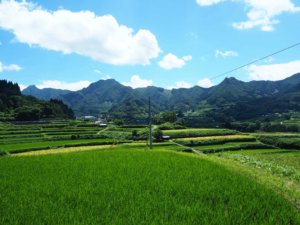
Day 12: Aso San
Aso San is stunning, however, we were unable to go up to the crater as the poisonous gas levels were too high. There are plenty of hikes and stunning views to be had. We did a couple of short walks and hot-footed it to our onsen hotel in the small town of Yufuin. We then spent the rest of the day soaking in onsens. Perfect.
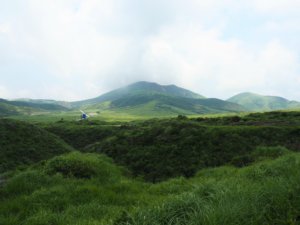
Day 13: Yufuin
With clear blue skies, I took the opportunity to hike to the top of Yufu-Dake a short but reasonably challenging hike offering stunning views of the town of Yufuin and the surrounding countryside. The trail is well marked, although take care when walking through the forest as it’s easy to get lost. After the forest section, the path is clear all the way to the summit. There are a number of peaks to check out, however, some of them will require nerves of steel to climb.
It took me around 4 hours total including a well-earned break at the summit. The last two-thirds of the hike is steep without any shade. If you are doing this trail in the summer like I was, take plenty of water and slather yourself in suntan cream.
Relaxing in an onsen that afternoon was a feeling of complete bliss.
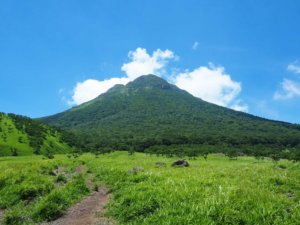
Day 14: Fukuoka
We dropped the car back to Fukuoka and got to our accommodation around 2 pm. We’d found a great hostel about 30 minutes by train from Fukuoka station. Every hostel, guesthouse, and Airbnb we found in the centre was in the region of 200 GBP a night! Certainly not what we’d experienced our first night in Fukuoka two weeks earlier. It turns out the next morning was the culmination of the Yamakasa Festival, one of Kyushu’s most important and vibrant. Teams push around huge floats, whilst being doused with water from those on the float and the crowd themselves. Festivities would begin at around 4:30-5 am the next day. Since our flight to Tokushima wasn’t until 10 we had plenty of time!
We spent the afternoon exploring the Tenjin and the Kushia Shrine.
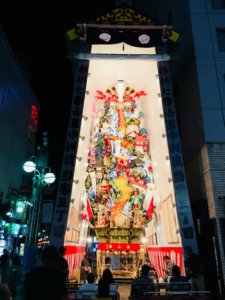
Day 15: Yamakasa Festival before flying to Tokushima in Shikoku
We jumped on a packed train at some ungodly hour of the morning and joined thousands of other sleep-deprived souls grabbing a spot. We were by no means the first there but we could see a reasonable amount. The only way to get a spot at the front is to stay in Fukuoka itself.
Everything calmed down just after 6 and after a quick coffee, it was off to the airport to take a flight to Tokushima on the island of Shikoku.
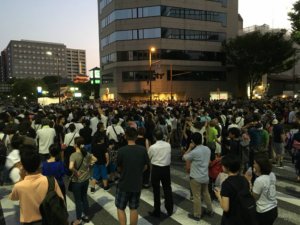
Anywhere we missed?
This small town which is an easy day trip from Fukuoka is famous for its Buddhist Temples.
Kirishima National Park
This gorgeous National Park to the north of Kagoshima is one of Kyushu’s best hiking regions. Sadly when we visited typhoons had led to a warning of potential landslides meaning it was closed.
This city on the northern fringes of Kyushu is famous for its castle and gardens.
Kitamatsura Peninsula
The peninsula on which Hirado is located. This gorgeous expanse of land is pretty much deserted with plenty of places to explore.
This island south of Kagoshima is famous for its forests, hiking trails, and almost incessant rain. You can take a boat or plane from Kagoshima, but be aware that taking a car over is ferry expensive.
Related Posts
Well done guys, you fitted so much in and hit all the right spots! The only thing I might add is to include a visit next time to some of the wonderful old pottery villages here. Some of the families have been producing for 14 generations straight! Love the photos too.
Hi Simon, thanks for the kind words! It certainly is a beautiful part of Japan. Fingers crossed we will have the chance to head back there soon.
Write A Comment Cancel Reply
You must be logged in to post a comment.
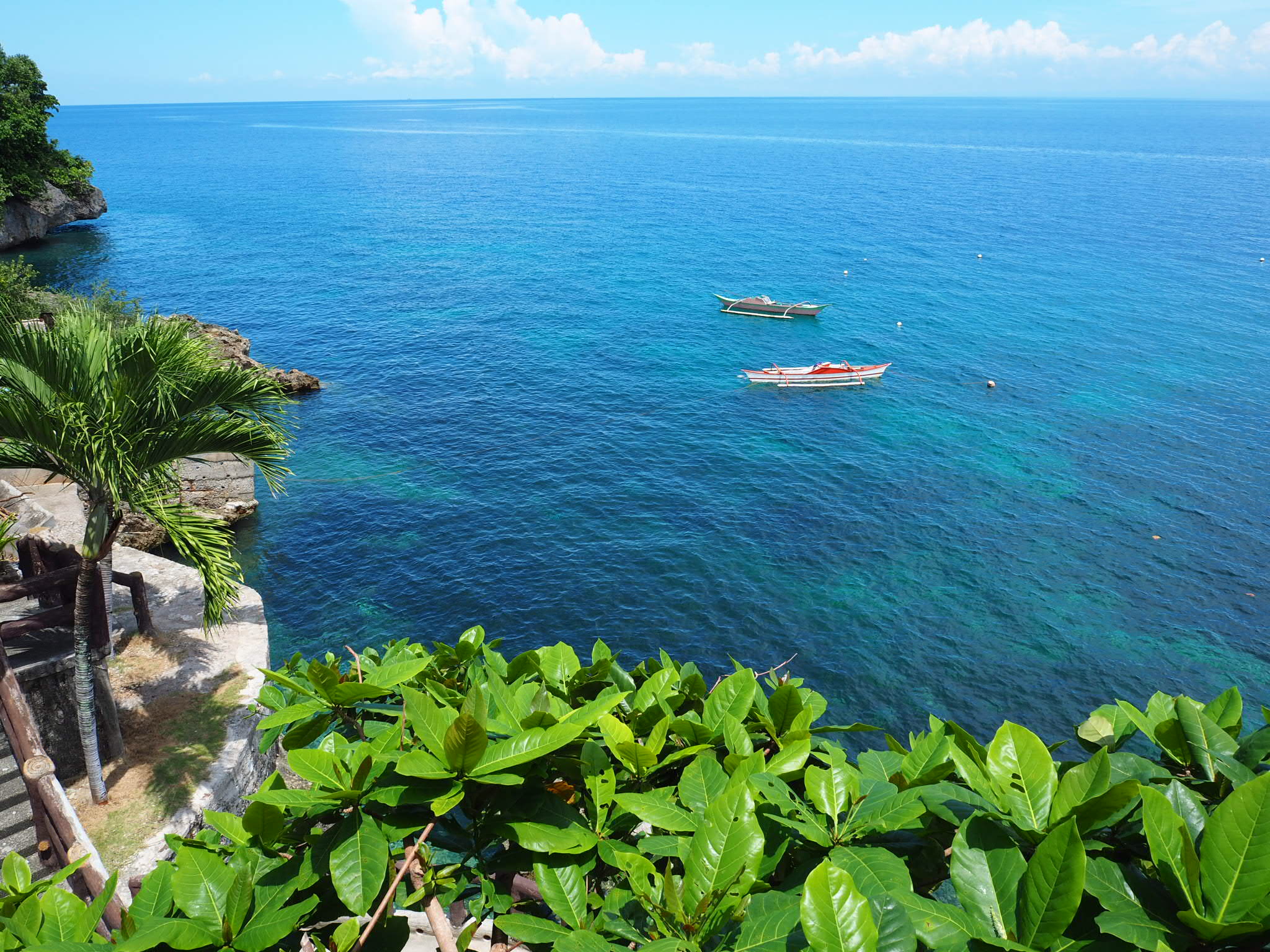
Type above and press Enter to search. Press Esc to cancel.

One Week in Kyushu Itinerary: Explore the Best of Northern Kyushu, Japan
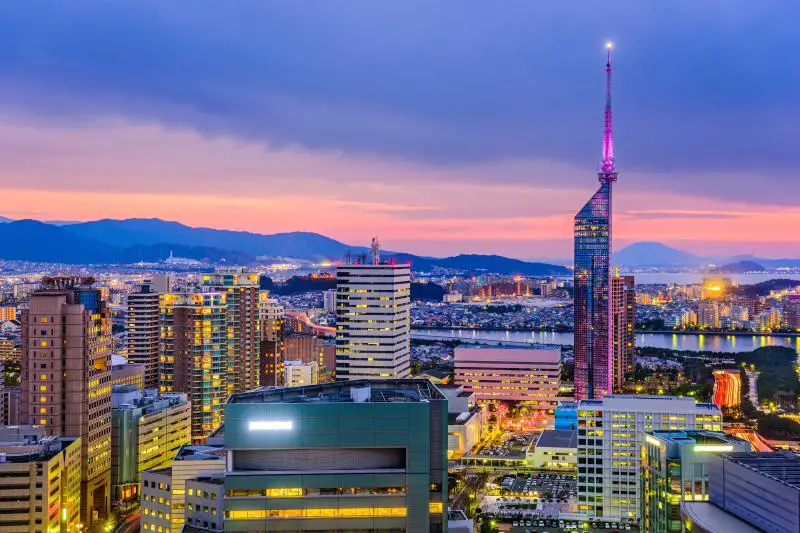
While most people associate Japan with Tokyo , Kyoto , and Osaka , one area that needs to be on your Japan itinerary is Kyushu Island. Kyushu is the third largest island in Japan’s archipelago and is located in the southern area of the country.
Where are the best places to visit in Kyushu? Since the island is HUGE, we suggest that you spend the time in Northern Kyushu, specifically Fukuoka, Beppu, and Nagasaki. These underrated cities will give you an introduction to its beautiful landscapes and mountains, history, and mouthwatering local cuisines. Plus, these areas don’t attract huge crowds like in Tokyo and Kyoto.
We suggest that you spend at least 1 week in Kyushu. This Kyushu 7 days itinerary highlights the cities to visit in Kyushu, transportation options, and recommended places to stay. As with any travel itinerary that we share, feel free to mix up the sightseeing attractions based on your interest and time.
Now let’s visit these Kyushu must-see tourist attractions!
Click on the links below to jump to certain sections of this Kyushu itinerary for 7 days.
- Map of Kyushu
- How to Travel Around Kyushu
- Fukuoka (Days 1-2)
- Beppu (Days 3-4)
- Nagasaki (Days 5-6)
- Free Day or Departure (Day 7)
*Disclaimer: Traveling to Kyushu, Japan? This post contains affiliate links to Kyushu tourist attractions. If you click on them and make a purchase, we receive a small commission. There is no additional cost to you. Appreciate the support.
Map of Kyushu Itinerary for 1 Week
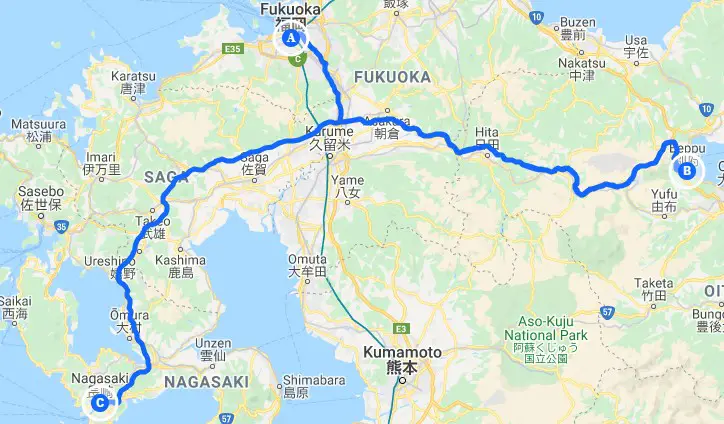
Click on the image above to see a larger version of where you’ll go on your Kyushu itinerary. Credit: Map data: Google
How to Travel Around Kyushu Using JR Pass
The best way to travel around Kyushu and all of Japan is by using the shinkansen high-speed train operated by Japan Rail (JR) Group. The shinkansen is convenient to use since they are fast, always arrive and depart on time, have comfortable seats, and run constantly. They also connect to the local train lines. Using the shinkansen is also a sustainable way to travel since you reduce your carbon footprint for long-distance travel.
All visitors with a temporary visa have the opportunity to use the shinkansen if you have a wide-area Japan Rail (JR) Pass , JR Sanyo-Sanin – Northern Kyushu Pass , or JR Kyushu Pass . With the pass, you’re able to travel within a large area (basically all of Japan), take JR local and fast-speed train lines. You won’t be able to take the Nozomi and Mizuho fast line but the Sakura and Hikari still are quite fast with a few extra stops along the way.
You would need to calculate if it’s more cost-efficient to have a wide-area JR Pass, Sanyo-Sanin – Northern Kyushu Pass, or Kyushu Pass. Once you have your Kyushu itinerary ready, you can use this scheduler to determine the cost and the departure/arrival times of the shinkansen.
The wide-area JR Pass is beneficial if you plan to visit different areas of Japan. They have a 7, 14, and 21-day pass. Buy your JR pass for a discounted price here .
The Sanyo-Sanin – Northern Kyushu Pass is for the Kyushu area and also travels to/from the Osaka area. This pass lasts 7 days. Buy your pass here for a discounted price.
JR Kyushu Pass is available but has duration of 3 or 5 days. This pass is good if you fly to Kyushu and don’t plan to travel outside of the island. Buy your JR Kyushu Pass here .
You’ll need to purchase the JR pass in advance and exchange the voucher for the physical ticket at the shinkansen ticket office on your arrival. It’s recommended that you also reserve seats in advance so you don’t need to worry about not getting one in the non-reserved seating car. You can reserve seats in person at the ticket office.
This post will focus on using the shinkansen between the cities since that was our main mode of transportation.
Kyushu Itinerary Day 1-2: Fukuoka
Fukuoka ( 福岡市) is the main city in Fukuoka Prefecture. As the northern city in Kyushu, it’s the perfect introduction to this island. With a mix of traditional and metropolitan architecture and culture, you’ll love spending a few days in Fukuoka (also referred to as Hakata in the Hakata area). If you are a huge ramen eater, you’ll love eating your way through this city.
Read our detailed Fukuoka itinerary here.
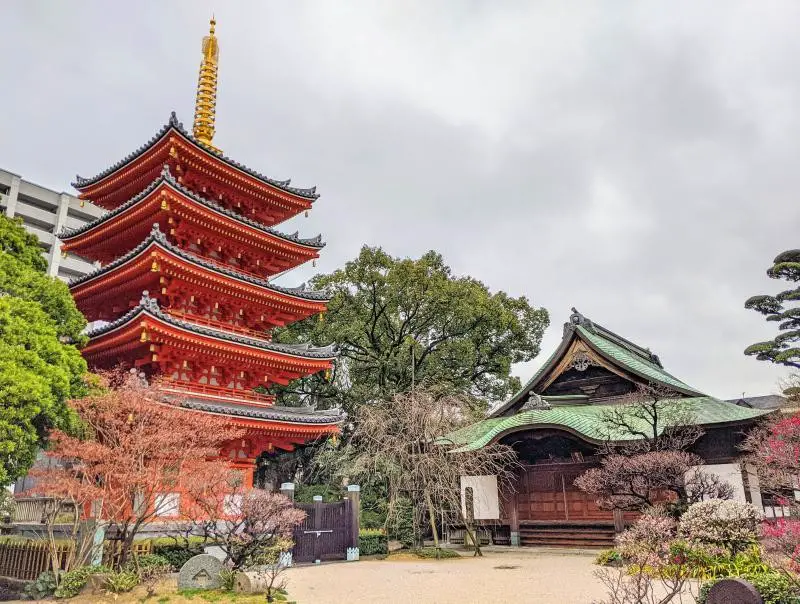
Tochoji Temple is a recommended place to visit in Fukuoka.
How to Get to Fukuoka
Fukuoka has an international airport and it’s only 6 minutes away to get to the main station, Hakata Station ( 博多駅) by train. From the Fukuokakuku Station ( 福岡空港駅) at the airport, hop onto the local train on the Kuko Line and go two stops to Hakata Station.
By Shinkansen
If you’re coming from Honshu Island where Tokyo, Osaka, and Kyoto are located, you’ll need to take the shinkansen directly to Hakata Station. Travel times will vary depending on your starting location.
Top Things to Do in Fukuoka
- Eat Hakata ramen (also referred to as tonkotsu ramen) when you’re in Fukuoka. Many of your favorite ramen shops originated here such as Ippudo, Ichiran, and Shin-Shin Ramen. You can easily spend the day trying different ramen branches.
- Take a historical walking tour . Visit important temples and shrines such as the Kushida Shrine and Tochoji Temple which is close to Hakata Station.
- Walk along the riverfront and try the Yatai food stalls in the evenings. It’s similar to hawker food stalls in Singapore .
- Go shopping at Canal City , a multi-level shopping center that has boutique and popular stores.
- Check out the old ruins of the Fukuoka Castle .
- See the views of Fukuoka city from Fukuoka Tower .
- Explore Dazaifu on a day trip . It was originally Fukuoka’s former government area so you can see ancient ruins of the buildings and also check out the shrines and temples.
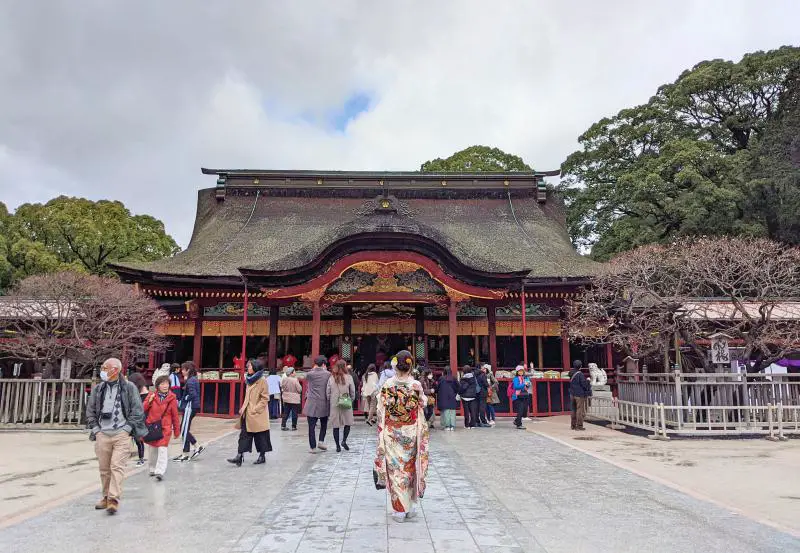
Tenmangu Shrine is one of the best attractions to visit in Dazaifu.
Places to Stay in Fukuoka
We stayed at Hotel Mei which is within walking distance to Canal City. It’s a new hotel that offers various rooms whether you want a suite or an executive room. We had a budget-friendly room that was spacious and had the amenities needed for our stay. Book a room at Hotel Mei here .
For other options, check out accommodation reviews and book a room in Fukuoka here.
Kyushu Itinerary Day 3-4: Beppu
Beppu ( 別府市) is a famous onsen (hot springs) location in Japan. Located in Oita Prefecture, this mountainous city is unique to visit as you see steam coming from the rooftops of the onsen. You’ll love the opportunity to relax in a hot spring and also get a chance to see the multi-colored bubbly hot springs up close. Two days is a good amount of time to relax in the middle of your Japan itinerary.
Click to read more about our Beppu itinerary here.
How to get to beppu from fukuoka.
Take the shinkansen high-speed train from Fukuoka’s Hakata Station ( 博多駅) to Beppu Station ( 別府駅). It’ll take 2 hours.
Top Things to Do in Beppu
- Relax at an onsen . You can choose to stay overnight at an onsen or spend time in one with mineral spring water, mud bath, or in the sand.
- The main highlight of Beppu is to visit the Seven Hells of Beppu . Take the Jigoku Meguri (Hells Tour) to visit the seven hot springs – Chinoike, Tatsumaki, Shiraike, Oniyama, Kamado, Umi, and Oniishi Bozu. You’ll love the different colors from cobalt to mud pits for the hot springs. There are 8 Jigoku in the area but one isn’t a part of the Jigoku Meguri ticket combination. This attraction will take about half a day.
Read our Seven Hells of Beppu guide here.

Out of the Seven Hells of Beppu, Umi Jigoku is our favorite!
- Eat Beppu specialties such as steamed foods, steamed custard pudding and eggs, and toriten (tempura battered chicken).
- Take a day trip to Yufuin, one of the best onsen towns in Japan . Although it’s a smaller town, you can’t miss the relaxation opportunities and go hiking up Mount Yufu.
- Visit Harmonyland , an outdoor Sanrio amusement park. See Hello Kitty and friends here or visit them in Tokyo’s Sanrio Puroland .
Places to Stay in Beppu
We stayed at Beppu Hostel U&T which was an affordable option and close to the Beppu Station. The rooms are larger than other places that we stayed at. Plus, this place has unlimited tea and beverage services! Book a room at Beppu Hostel U&T here.
For other options, click here to read reviews of Beppu accommodations and make a reservation .
Kyushu Itinerary Day 5-6: Nagasaki
Nagasaki ( 長崎) is a location that has both Japanese and Western influences. As the largest city in the Nagasaki Prefecture and former port city, you’ll see influences with the Portuguese and Dutch with the architecture and Christianity. It’s also known as the second location to experience the atomic bomb on August 9, 1945 (3 days after the Hiroshima incident). Since Nagasaki is a large area with lots of local attractions, you can easily spend 2-3 days here.
Read more about our Nagasaki itinerary here.
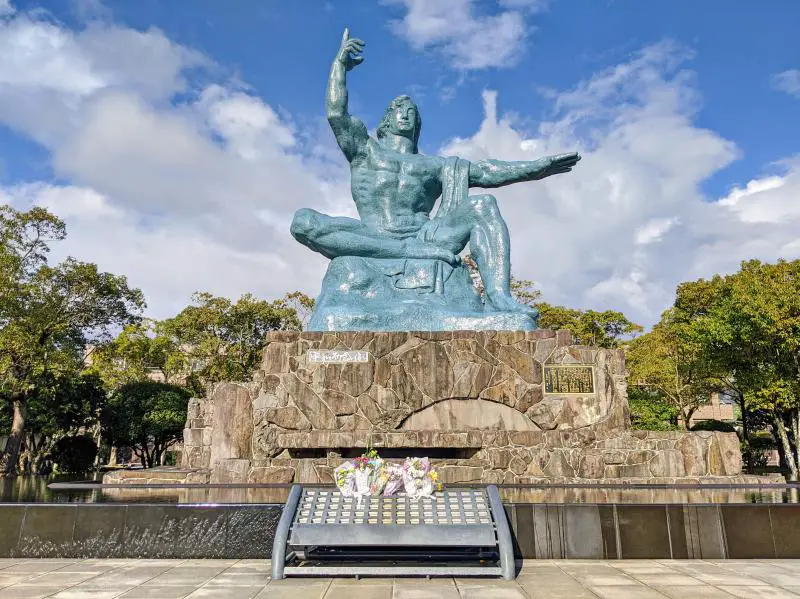
The Peace Statue at the Peace Park is a lovely place to visit in Nagasaki.
How to Get to Nagasaki from Beppu
To get to Nagasaki from Beppu, you’ll need to allocate 4 hours and do one transfer on the shinkansen fast-speed train. From Beppu Station ( 別府駅) to Fukuoka’s Hakata Station ( 博多駅) , the shinkansen ride will take 2 hours. Afterward, transfer at Hakata Station to go on a different train that goes to Nagasaki Station (長崎駅) . This will take another 2 hours. It’s a long journey so it’s recommended that you purchase a meal or snacks ahead of time for your ride.
Top Things to Do in Nagasaki
- Learn about the history and events leading up to the atomic bomb incident at the Atomic Bomb Museum and the National Peace Memorial Hall for Atomic Bomb Victims. Pay your respects at the Peace Park and also see the atomic bomb hypocenter at the Hypocenter Park .
- Visit Nagasaki’s churches such as Oura Church and Urakami Cathedral.
- Explore the isolated island for Dutch merchants at Dejima .
- Eat champon , a noodle specialty dish from Nagasaki. It’s one of our favorite Japanese foods to eat!
- Visit Chinatown to shop and eat. If you can visit during the Nagasaki Lantern Festival , you’ll see over 15,000 lanterns light up the area. Nearby Chinatown is also the Spectacles Bridge that looks like a pair of glasses.
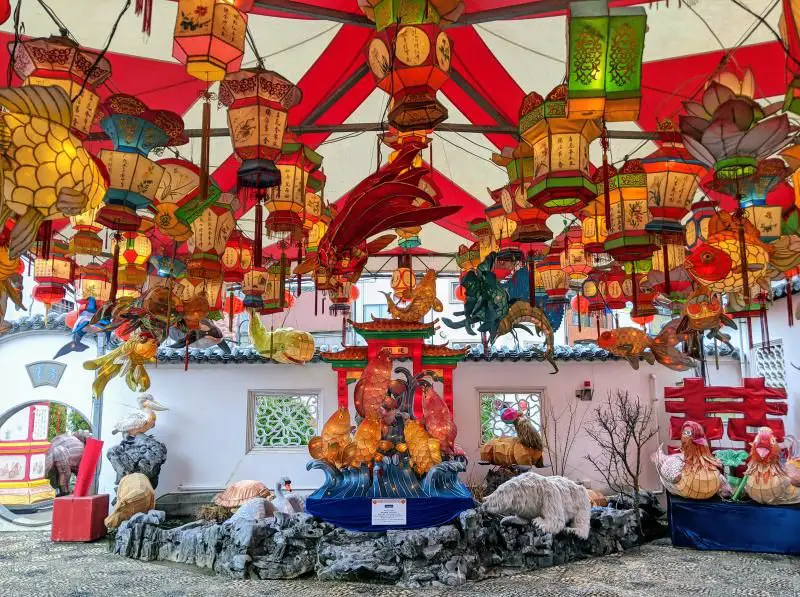
If you have a chance to visit Nagasaki during the Lantern Festival, you’ll see incredible decors and displays.
- Check out the nighttime views from the summit of Mount Inasa at 333 meters (1,093 feet) above sea level. You can take the ropeway to the top of the mountain.
- Take day trips to visit the Huis Ten Bosch , the Netherland-inspired amusement park, or see the abandoned island of Hashima Island (Battleship Island).
Places to Stay in Nagasaki
We stayed at MP Hotel Nagasaki Mizubenomori which is a quiet location in the residential area. This place is great if you’re looking for an apartment-style hotel room. The best part is that this room has a washing machine. Regardless, this place is close to the streetcar so you can travel around the city. Book a room at MP Hotel Nagasaki Mizubenomori here.
For other options, click here to read reviews of Nagasaki accommodations and make a reservation .
Kyushu Itinerary Day 7: Travel Day or Departure
On your last day in Kyushu, this is your free day to do whatever you’d like! Depending on your schedule you can visit neighboring areas in Kyushu, head to the neighboring Honshu Island, or depart back home via plane at Nagasaki or Fukuoka airport.
If you have extra time to explore Kyushu, take a day trip to Kumamoto ( 熊本市). The city is known for the Kumamoto Castle ( 熊本城) so you’ll get an opportunity to explore a historic landmark.
How to Get to Kumamoto from Nagasaki
From Nagasaki to Kumamoto, take the shinkansen for a two-hour ride. From Nagasaki Station ( 長崎駅) , head to Shin-Tosu Station ( 新鳥栖駅) . The ride takes 1.5 hours. Transfer here and take the shinkansen to Kumamoto Station ( 熊本駅) for another 25 minutes.
How to Get to Honshu Island from Nagasaki
If you are planning to head to Honshu Island, you’re in luck as there are many places to explore. Honshu Island is the largest island out of Japan’s archipelago. It has popular cities such as Hiroshima, Kyoto, Osaka, Tokyo, and other exciting places.
The nearest main city that is closest to Fukuoka is Hiroshima. We recommend that you stop by Hiroshima for two days to learn more about the Hiroshima atomic bomb , visit the Hiroshima Castle , and do a day trip to Miyajima Island .
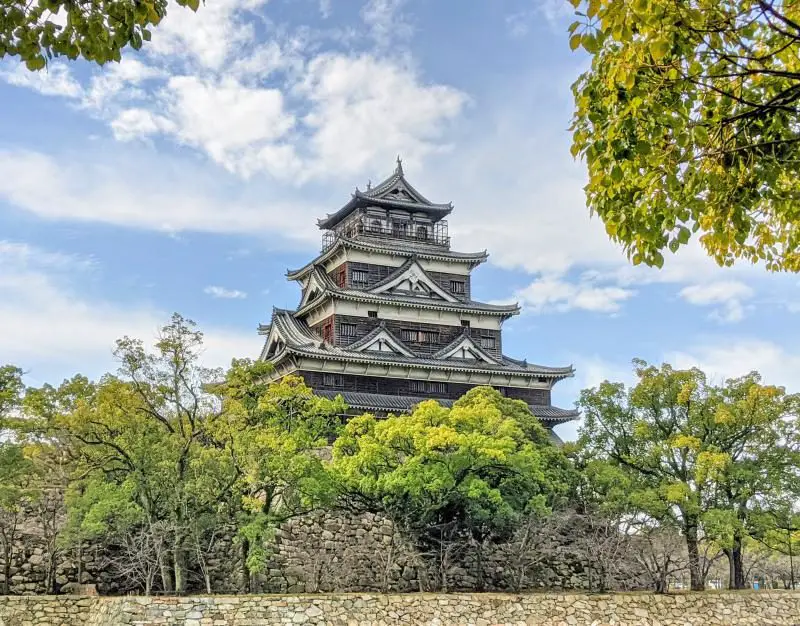
Although Hiroshima Castle is rebuilt, it’s still gorgeous to see!
How to Get to Hiroshima from Nagasaki
From Nagasaki to Hiroshima, take the shinkansen for a 3.5-hour ride. From Nagasaki Station ( 長崎駅) , head to Shin-Tosu Station ( 新鳥栖駅) . The ride takes 1.5 hours. Transfer here and take the shinkansen to Hiroshima Station ( 広島駅 ) for another 1 hour and 20 minutes.
Have a safe departure!
This one week in Kyushu went by quickly! This island has so many hidden gems to explore. We hope you enjoyed Kyushu as much as we did so you can return to visit Southern Kyushu in the future.
What are you most interested in seeing in Northern Kyushu? If you have questions about this Kyushu travel guide or itinerary, ask one in the comments below.
Save this post to your Japan Pinterest board.
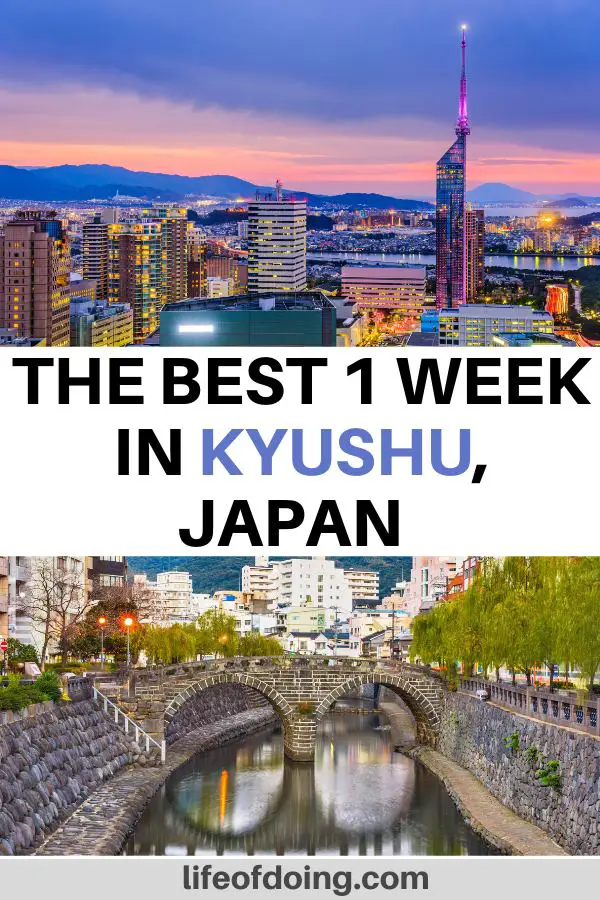
Featured photo & pin #1 photo credit: sepavone via Depositphotos.com
I'm Jackie - world explorer, hiker, and wanderer. I love planning things whether it is a trip or an upcoming event, exploring nature, hiking up mountains, and seeing new places. I'm notorious for getting lost, so you may see me circling a place a few times.
One Day in Fukuoka, Japan: A Fukuoka Itinerary That Is Great for Ramen Lovers
Himeji day trip: a fabulous one day from osaka or kyoto, japan, you may also like, how to travel from ipoh to penang georgetown..., 18 must try places to eat in penang’s..., a step by step guide on taking the..., exploring melaka, malaysia in one day – a..., hiking moongate station 5 in penang, malaysia, indonesia’s top 5 scuba diving spots to not..., 11 must have apps for traveling in malaysia, where to go in bali: the best 8..., 16 things to know before visiting ipoh, malaysia, visiting qing xin ling leisure & cultural village..., 15 comments.
This looks like such an amazing place. Unfortunately, when we were in Japan we didn’t have enough time to go to Nagasaki. We do hope to go back to visit places like this instead of all the big cities! Saving for later.
Thanks Pamela. There is so much to see in Japan! Once the current situation is over, hope you can make a plan to return to Japan. We would love to go back to Kyushu and spend time in the southern areas to see waterfalls and more beautiful landscapes.
Interesting places in Kyushu and we already know that Japan has many amazing places where we can spend our time. I love this place and will plan to go there.
Thank you! Kyushu Island is underrated since it takes a while to get there from Osaka and has fewer crowds. Look forward to hearing about your experiences when you visit.
I’ve always wanted to go to Japan!! What an amazing guide you’ve created. There’s so much to do and see especially in the Kyushu area. I’ll save this for my trip!
Thanks Katie! If you have any questions during your future Japan planning, I’m happy to help!
This is a great guide you’ve created for Japan. I’ve been to some Asian countries like India and I’m always excited to explore more countries there!
Thanks Olga! Glad you enjoyed this Kyushu itinerary! I’m overdue for a return trip to India. I’ve only been to Bangalore for work so I can’t wait to explore other tourist attractions.
I am truly blown away by everything Japan has to offer. We returned from our trip to Japan in February and I never thought to visit Kyushu – thank you for taking the time to write this. I feel like one could spend years in Japan and still not see it all!
Hi Sarah. We returned from our trip to Japan in February as well! Where did you go? Hope you get a chance to visit Kyushu in the future.
Just by your photos I already want to go Kyushu area! Great post!!
We visited Tokyo, Hakone, Kyoto, Osaka and Nara! So much we still need to see!
Hi Sarah – I agree! There is never enough time to explore all of Japan. Justin and I haven’t been Hakone yet, but it’s on the bucket list.
I’m late to this post but am planning a trip to Kyushu later this year for my first visit to Japan. Thanks for the insight, can’t wait to see what the island has to offer.
Hi JJ. Thank you for sharing a comment. Enjoy your time in Kyushu! Would love to hear back from you on your experience. We can’t wait to go back and explore more on Kyushu island.
Leave a Comment Cancel Reply
Save my name, email, and website in this browser for the next time I comment.
By submitting a comment, you agree with the storage and handling of your data by this website. Refer to the Privacy Policy and Disclaimer for more information. *
This site uses Akismet to reduce spam. Learn how your comment data is processed .
This website uses cookies to improve your experience. Please accept or opt-out if you wish. Accept Read More
Visit Kyushu The Official Kyushu Travel Guide
- Activities & Experiences
- Art & Culture
- Heritage & History
- Wellness & Relaxation
- Food & Drink
- Nature & Outdoors
- Art & Culture
- Heritage & History
- Nature & Outdoors
- Leisure & Entertainment
- About Kyushu
Adventure Travel
Book Kyushu Experiences
Getting to Kyushu
Getting around kyushu, good to know, staying in kyushu, downloadable pamphlets.

- Plan Your Trip
Essential Information for a Smooth Trip to Kyushu
Kitsuki Castle Town
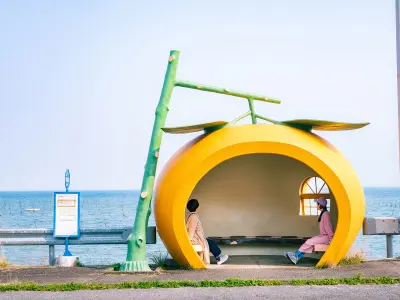
Kyushu is well-connected to the rest of Japan and the world, with international ports and airports and direct access to the island of Honshu by shinkansen and road. Whichever way you travel, you will find a warm welcome.

Kyushu has an extensive network of trains and buses within the major cities, and connecting each prefecture. Some of the more distant areas are easier to reach by car, or even ferry. You can also fly to many of Kyushu's beautiful islands, including Yakushima and Amami Oshima.
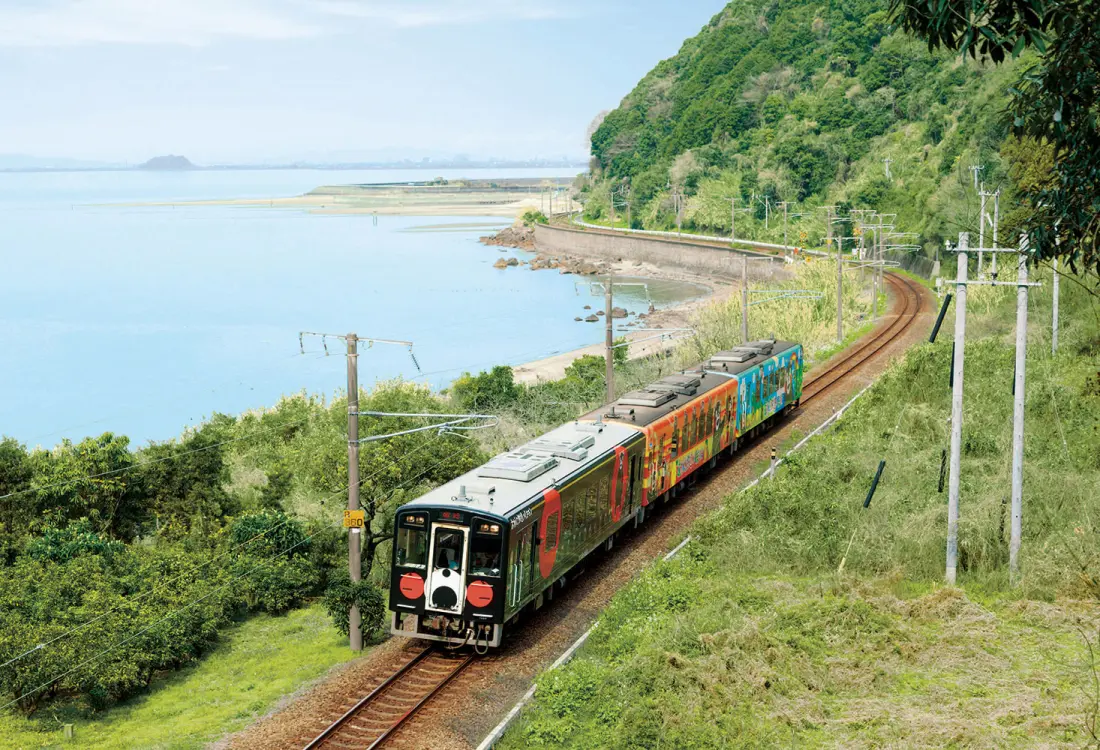
Kyushu is Japan's warm and friendly southern island, with verdant green hills, active volcanoes, abundant hot springs and delicious food. It's also well connected to the world, with many transport options, lively cities and free Wi-Fi in many areas. Here are some tips on when to go, where to stay and how to make the most of your trip.

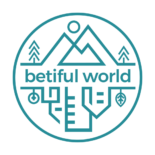
Kyushu 7 Days Itinerary – Scenic Road Trip in Japan
- Post author: Beti
- Post published: March 16, 2023
- Post category: Japan
- Post comments: 6 Comments
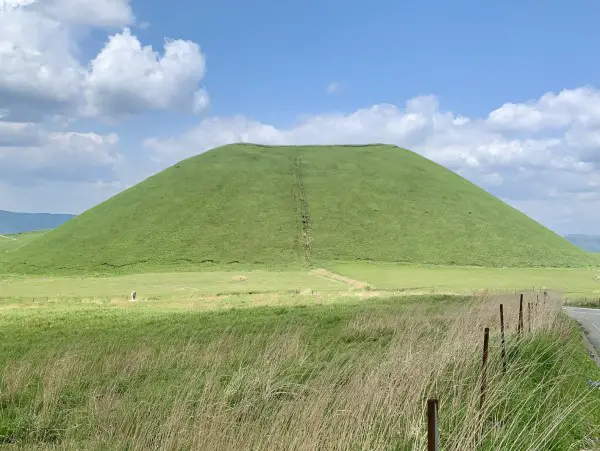
If you are thinking of a road trip in Japan – this 7 days Kyushu itinerary might be exactly what you need! Kyushu is the southernmost main island in Japan, famous for its active volcanoes, relaxing hot springs and beautiful mountain ranges. It offers dramatic landscapes, vast spaces, unspoiled nature, no crowds, so it’s fantastic to escape from a big city life and… to eat some authentic Neapolitan pizza! As you can’t just live with ramen and sushi or… actually maybe you can?! 🙂
What's in this blog post?
KYUSHU 7 DAYS ITINERARY: HIGHLIGHTS
One week in Kyushu is perfectly enough to explore the best of Kyushu Island if you are a nature lover. Here are the highlights of this road trip:
- MOUNT ASO: the largest active volcano in Japan, famous for its huge caldera!
- VERY ACTIVE VOLCANOES: constantly monitored by the Japan’s Meteorological Agency: Aso and Kirishima as well as Japan’s most active volcano – Sakurajima.
- PRISTINE LANDSCAPES & PEACEFULLNESS: less crowds than in other parts of Japan.
- BEST OF JAPAN’S NATURE: 2 out of 34 Japan’s National Parks: Aso-Kuju National Park & Kirishima-Kinkowan National Park.
- STUNNING GORGE, WATERFALL & RICE TERRACES: those kind of places you probably don’t expect to see in Japan, or at least I did not expect 🙂
- GREAT SCENERY FOR A ROAD TRIP: kilometres of scenic drive through the mountain grasslands.
- ITALIAN PIZZA in “Naples of Japan” – the city of Kagoshima.
- SUBTROPICAL CLIMATE of southern Kyushu to escape colder weather in other parts of Japan.
- TICKING OFF 4/47 PREFECTURES: Kumamoto, Oita, Miyazaki & Kagoshima, if you plan to visit them all 🙂
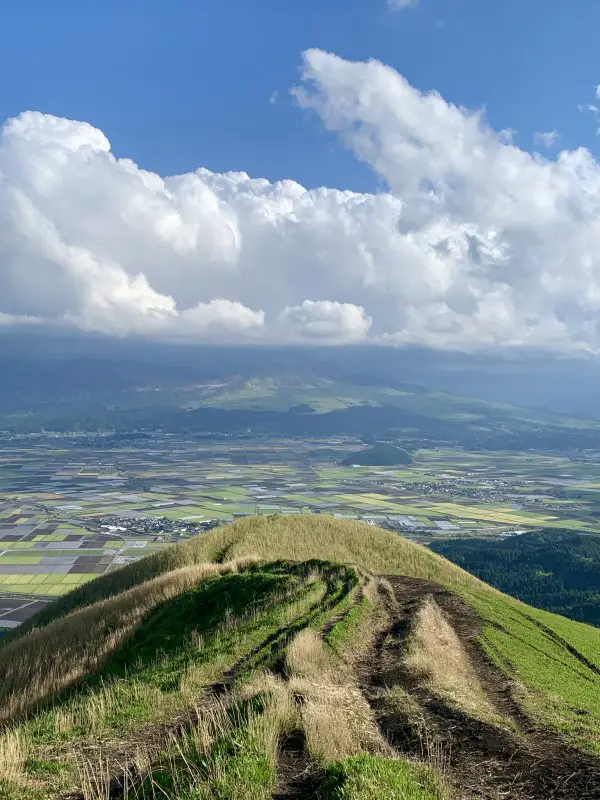
How do you get to Kyushu island from Tokyo?
Travelling from Tokyo to Kyushu by plane is much cheaper than a journey with a bullet train. I flew with Solaseed Air – a regional airline operating mainly between Tokyo and the island of Kyushu, which was cheap and convenient. The flight was less than 2 hours and cost half of the price of a 7-hour train journey.
To make the best use of your time and fully enjoy the stunning nature of Kyushu, Kumamoto is probably the most convenient place to start your 1 week Kyushu road trip. Alternatively, you can start from Kagoshima and drive your way up to Kumamoto. Renting a car is essential to fully enjoy stunning nature in Kyushu. You can travel by public transport but it’s not very convenient, especially if you plan hiking. Buses do not run frequently.
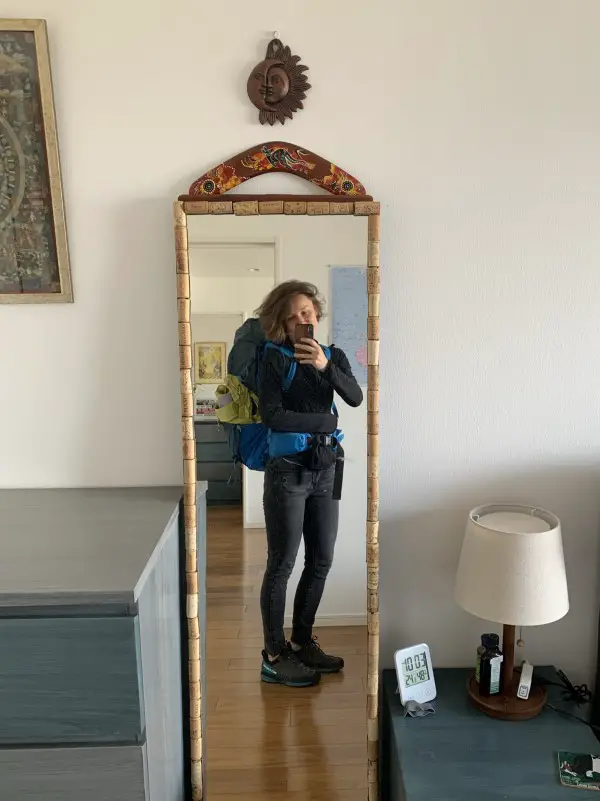
KYUSHU 7 DAYS ITINERARY: ROAD TRIP DAY BY DAY
Day 1. milk road & daikanbo lookout: a scenic drive from kumamoto airport to aso.
Kumamoto Airport is situated between the city of Kumamoto and Mount Aso. Therefore, depending on your arrival time, you might directly head towards the volcano paradise and skip visiting the city. That’s what we did. It’s only a 40-minute drive from Kumamoto Airport to Aso via the main road (30 km). However, it is worth taking a slightly longer, but more picturesque route called “Milk Road”, marked as number 339.
The Milk Road takes you through grasslands along the rim of the caldera and gives you a first glimpse of the beautiful landscapes. In short, it’s a great start to your 1-week trip in Kyushu. It is dotted with numerous scenic viewpoints, of which Daikanbo Lookout is by far the most impressive. It is a perfect place to experience the immensity of the Aso caldera.

Driving time and distance from the Kumamoto Airport to Aso
- Kumamoto Airport – Daikanbo Lookout: 55min ~ 40km;
- Daikanbo Lookout – Aso town: 25min ~ 15km
Cheap accommodation in Aso
Guest House Asora is a clean, affordable and strategically located simple accommodation with free parking. There are two types of rooms – with single Western-style beds (double beds are not so common in Japan), or with traditional Japanese tatami mats and futon mattresses. The bathroom, as usual in Japan, is shared. It is definitely not a fancy place, but when you are surrounded by wonderful nature, it really doesn’t take much to be happy.
Guest House Asora on Booking.com
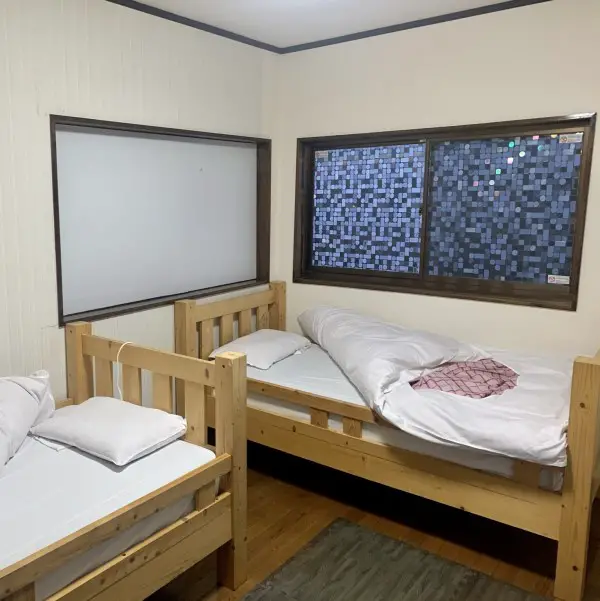

DAY 2. Exploring Mount Aso caldera & Nakadake crater
Mount Aso is not a single mountain. It consists of five peaks (Takadake, Nakadake, Eboshidake, Kishimadake and Nekodake) and one of the largest calderas in the world with a circumference of over 100 km resembling the magical landscape of Mount Bromo in Indonesia.
Unfortunately, I was not able to hike to the smoking crater and the peaks of Naka and Taka to see the spectacular crater from above, which was my original plan. Due to the increased volcanic activity, during my stay in Aso, the area within 1 km of the crater and most of the trails were closed.
On the first day, when I got to Mount Aso, the crater was still open, but the weather was bad. It was cloudy and rainy. Therefore, I decided to put off the most awaited highlight of my 7-days Kyushu itinerary until the next day. The weather forecasts were fantastic. The next day it was indeed sunny and the sky was blue. Unfortunately, on the same day, the area around the crater was closed.
how close I got to Nakadake crater...

Maybe next time...
Well, this is a good lesson for the future: you should visit an active volcano even in bad weather, because you never know when it will get more active again. 🙂
When planning your itinerary around Aso, always check the volcano’s activity status on the official website for live updates via this link: Mount Aso activity updates
What to do if Aso crater is closed?
If the crater is closed, it’s still not the end of the world either, as the surrounding area is very interesting. There are nice lookouts, as well as the Aso Volcano Museum, cafes and restaurants, so you will still enjoy your time. There is also an alternative way to explore the inside of the crater.
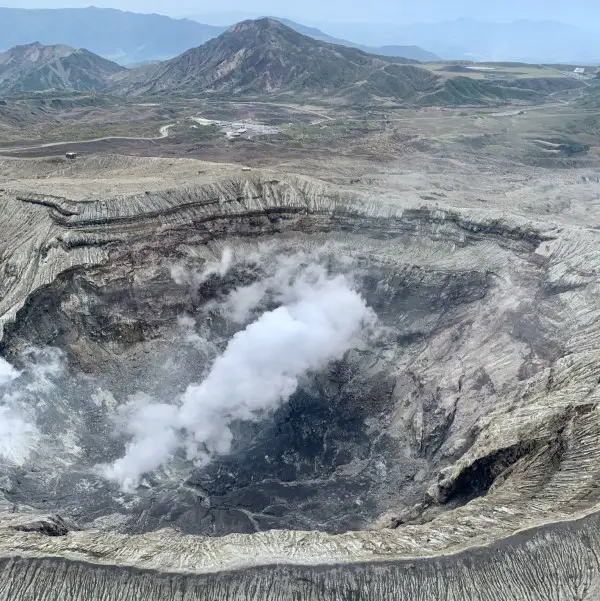
You can explore the crater from the helicopter...
...or explore alternative ways to enjoy your time....
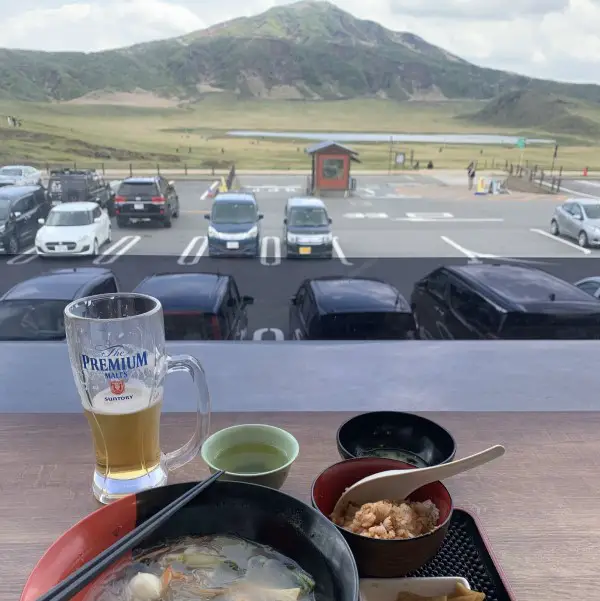
Read more about this extraordinary experience – helicopter flight over the crater in “Hiking in Kyushu – complete guide” – COMING SOON!
Driving time and distance from Aso town to Mount Aso
- Aso town – Mount Aso: 20 min ~ 35km (one way) and return to the town of Aso for the second night at Guest House Asora
DAY 3. A green volcanic cone, hiking one of the Mount Aso peaks & stunning rice terraces
Komezuka's perfect cone.
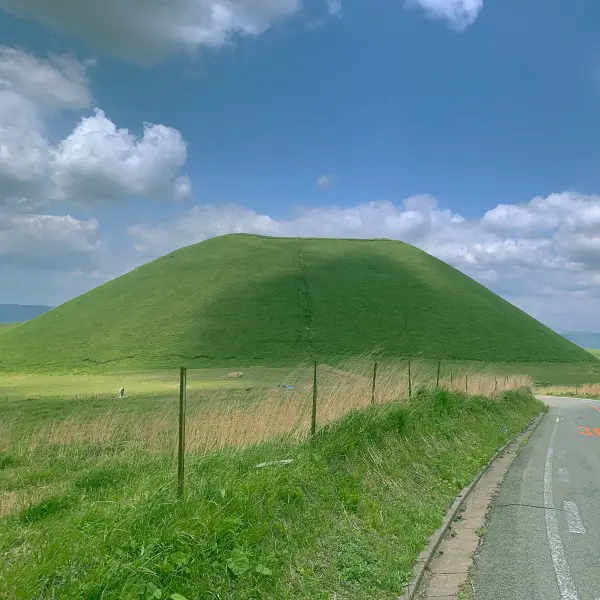
Start your day visiting the perfectly shaped volcanic cone, Komezuka. The green grass slopes of this baby volcano, which is only 80 meters high, make it a very picturesque place. There are several viewpoints in the area where you can park your car to take a photo and take a walk in the meadow. Driving around the area is very picturesque.
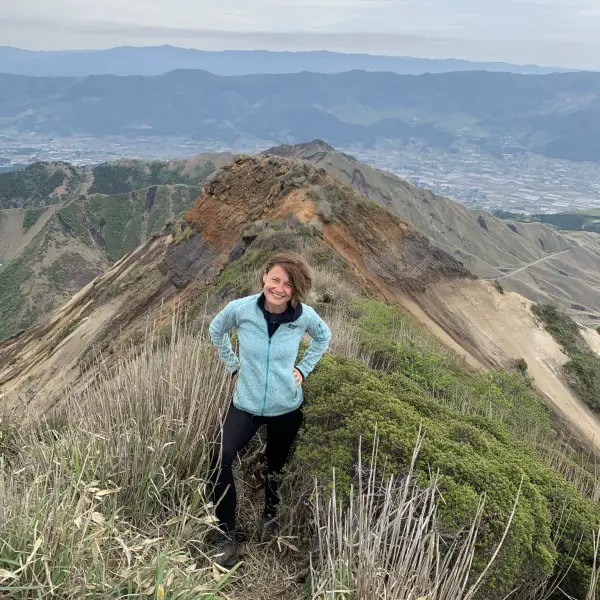
Mount Eboshi hike
The drive from Komezuka to the Eboshidake trailhead takes only about 10 minutes. Mount Eboshi (1,337m) is the easiest peak among all five Mount Aso peaks. The hiking trail (round trip takes around 2h) is usually open, even when the rest of the area is closed. You can get pretty good views over the caldera and Nakadake crater from the top. You can also hike Eboshidake the day before, if Nakadake crater is closed.
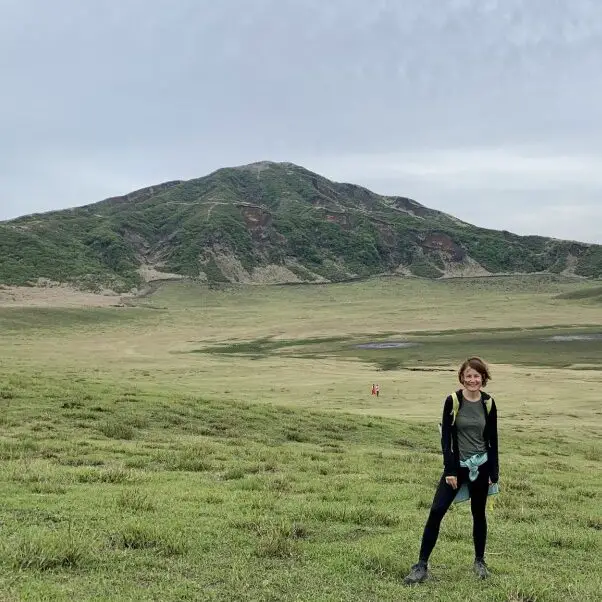
Read more about my Mount Eboshi hike in “Hiking in Kyushu – complete guide” – COMING SOON!
OGI RICE TERRACES
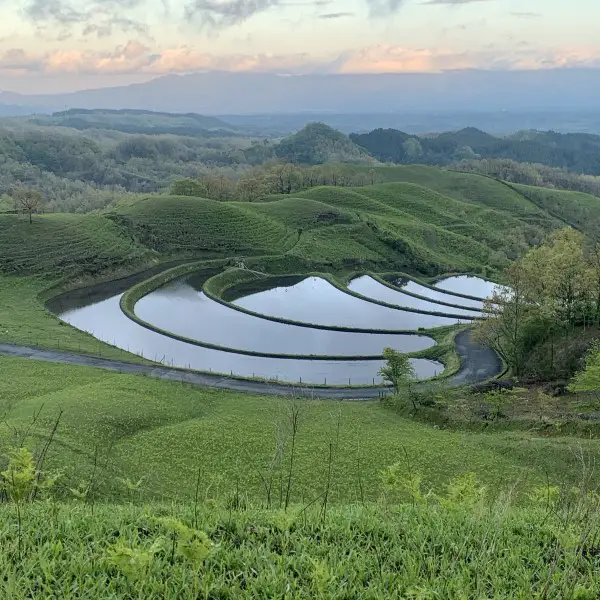
After hiking, if you still have time, drive to one of the most beautiful rice fields I have ever seen in my life. Despite their small size, Ogi Rice Terraces are worth visiting because of its particular fan shape. In order to reach them, you will need to drive through winding narrow roads. You can also take a slightly longer, more scenic route through the Milk Road to complete the entire scenic route you have started on Day 1.
Ogi Rice Terraces are not very popular among tourists, so most likely you will have them all to yourself. There is a small hill opposite the rice fields to take the best photos. From what I learnt from a little map I received at the guesthouse, according to the Ministry of Agriculture these picturesque rice fields are among the most beautiful in Japan.
If you do not have enough time for all the attractions mentioned in this blog post, try to combine 2 days of visiting Mount Aso into one (Day 2 & Day 3). It won’t be easy though!
Driving time and distance from Aso town to Komezuka, Eboshidake and Ogi Rice Fields
- Aso town – Komezuka: 15 min ~ 11 km;
- Komezuka – Aso Volcano Museum (parking lot for Mount Eboshi hike): 10 min ~ 5km,
- Aso Volcano Museum – Ogi Rice Terraces: 65min ~ 40km
On the way back there are 2 options depending on your accommodation for the 3rd night:
- Ogi Rice Terraces – Aso town: 45min ~ 28 km (Guest House Asora) or;
- Ogi Rice Terraces – Minami Aso: 45 min ~ 31 km (Camping ground in Minami Aso).
Where to stay for the third night: Aso or Minami Aso?
I can recommend two options. You can head back to Aso for the 3rd night at Guest House Asora, or move to the campground across the caldera to Minami Aso. Kyukamura Minamiaso Family Auto Camping Ground is located in a beautiful forest and offers, which is very convenient, both tents and camping equipment rentals. The showers are new and spot lessly clean. Reservations can be made online via the link: Kyukamura Minamiaso Family Auto Camping Ground
Initially I didn’t plan to move from Guest House Asora, but due to the lack of room availability, I had no other choice. I am glad about how it all turned out as the camping experience was an amazing adventure!

Our home for next 2 nights: Kyukamura Minamiaso Family Auto Camping Ground
Day 4. beautiful drive to the makinoto pass and hiking in the kuju mountains.
The Aso – Kuju National Park offers not only Mount Aso with its great caldera, but beautiful Kuju Mountains as well. Driving to the Makinoto Pass, which is a main starting point of the hiking trails, is very scenic. Hiking Mount Kuju ( 1,786 m) and Mount Naka ( 1,791 m) is very pleasant as the path rises gently.

It never gets too steep and the views are splendid. Mount Kuju is known for its particularly stunning views, while Mount Naka is the highest peak on the entire island of Kyushu.
Read more about the Kuju Mountains hike in “Hiking in Kyushu – complete guide” – COMING SOON!
Those who do not feel like hiking can explore walkways around the Chojabaru Visitor Centre, located 5 km from the Makinoto Pass. A walk on a 2.5 km comfortable wooden path over the wetlands takes around 30-40 minutes. The Kuju Mountains can be seen in the distance.

Wetlands nearby the Chojabaru Visitor Centre
Driving time and distance from aso town to the kuju mountains (makinoto pass).
Again, there are 2 options depending on your accommodation for the 4th night. The Kuju Mountains are slightly closer from Aso than from Minami Aso.
- Aso town – Makinoto Pass: 50 min ~ 37 km (+return) or;
- Camping ground in Minami Aso – Makinato Pass: 65 min ~ 50 km (+return).
DAY 5. A dreamlike place: Takachiho Gorge
I fell in love with the beautiful Takachiho Gorge as soon as I saw its photos while planning my 1 week Kyushu trip . It’s really stunning. Before moving to Japan, I did not expect to come across such magical places here. Takachiho Gorge is a narrow valley formed by ancient lava flows from the Mount Aso eruptions hundreds of thousands years ago. The unusual rock formations, which look unreal as if they were carved by a man, can be admired from the 1-kilometer path along the gorge.

Renting a boat is the best way to explore the Takachiho Gorge and the impressive 17-meter Manai waterfall on the Gokase River flowing within the gorge.
A 30-minute boat rental costs 3,000 JPY (27 USD) per boat + 1,000 JPY (9 USD) per passenger. The boat has a maximum capacity of 3 people. Each additional 10 minutes costs 300 JPY (3 USD). Due to the high water level, boat rental might not be always available, which you can check at this website: Takachiho Gorge Boat Rentals
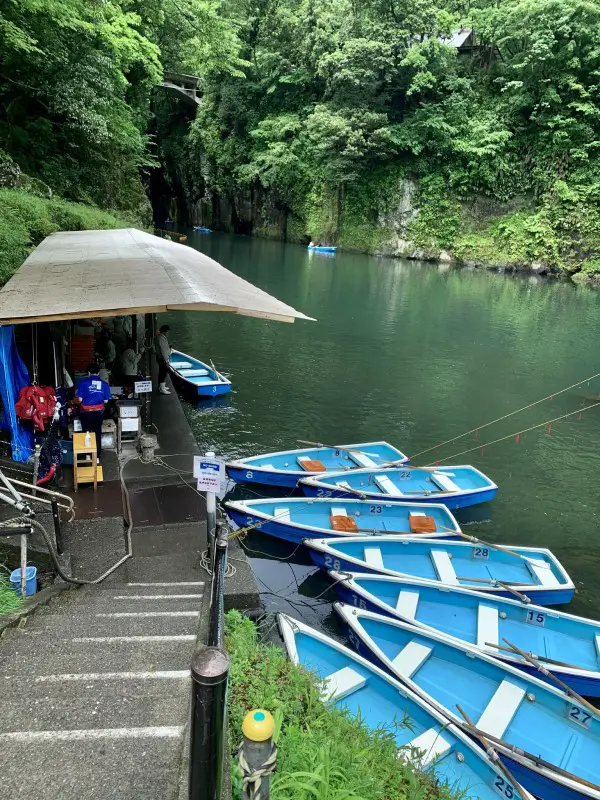
Visiting Takachiho Shrine
On the way back, make a short visit to Takachiho Shrine, located in a mystical cedar forest. I couldn’t believe it was my first visit to a shrine after 5 days of exploring Japan – a country famous for its countless temples and shrines. A visit to this Shinto shrine is simply a must, as Takachiho town is the setting of one of the most important Japanese mythology legends.
If you have enough time, you can also park your car at Takachiho Shrine and walk to the gorge as a picturesque path connects those two places.

Driving time and distance from Aso to Takachiho Gorge and to Kagoshima
It’s slightly closer from Minami Aso than Aso to reach Takachiho Gorge.
- Camping ground in Minami Aso – Takachiho Gorge: 45 min ~ 38 km or;
- Aso town – Takachiho Gorge: 75 min ~ 55 km;
- Takachiho Gorge – Kagoshima: 3h 25 min ~ 230km.
Where to stay in Kagoshima?
Gracias – simple, affordable and comfortable apartments offering views of Mount Sakurajima. Strategically located in front of the ferry terminal to Sakurajima and Yakushima, close to the city center and the best sushi restaurant in the city. What else do you need? Cold beer? You have it – a very friendly and a bit eccentric lady owner gave us two beers upon arrival. I’m not sure if it is her normal way to greet all the guests, but I really hope it is. 🙂 The only drawback of Gracias Apartments is the lack of a free parking lot. But it’s not a big deal as affordable public car parks are situated nearby.
Check out the apartments here: Gracias in Kagoshima – Google Maps
DAY 6. Japan's most active volcano Sakurajima & pizza in Naples of Japan
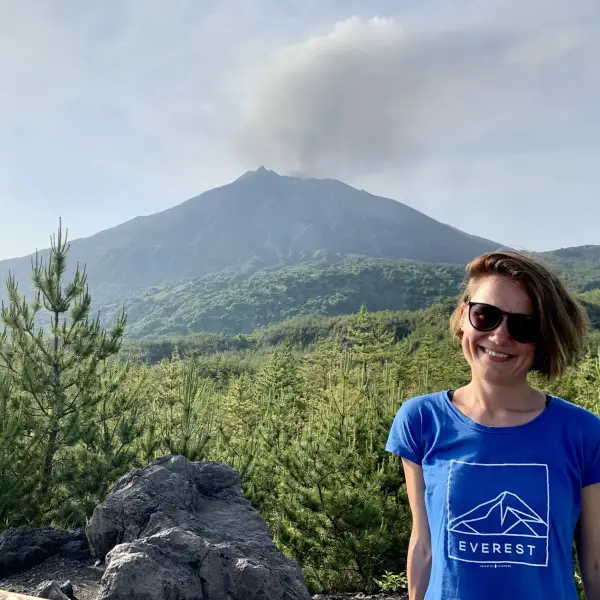
Visiting Mount Sakurajima
Mount Sakurajima is Japan’s most active volcano and the symbol of Kagoshima. It smokes constantly, and minor eruptions happen every day. It is easily accessible by ferry and best to explore by car. The trip around the peninsula takes around 1 hour. The total transportation cost (2 people and a car) starts from ~1,500 JPY (14 USD) for the smallest vehicle. Ferries depart from the Kagoshima Port every 15 minutes and the journey takes 15 minutes. Easy and hassle free!

Among several observation points situated around the volcano, the Arimura Observation Point is my favourite spot. Although it is not the closest to the crater, the scenery is the most breathtaking. A smoking volcano crater surrounded by beautiful green pine trees, no signs of any human presence, the lack of any buildings and the blue sky over Sakurajima’s picturesque coastline won my heart.
A perfect day in nature - Sakurajima

Naples of Japan - the city of Kagoshima
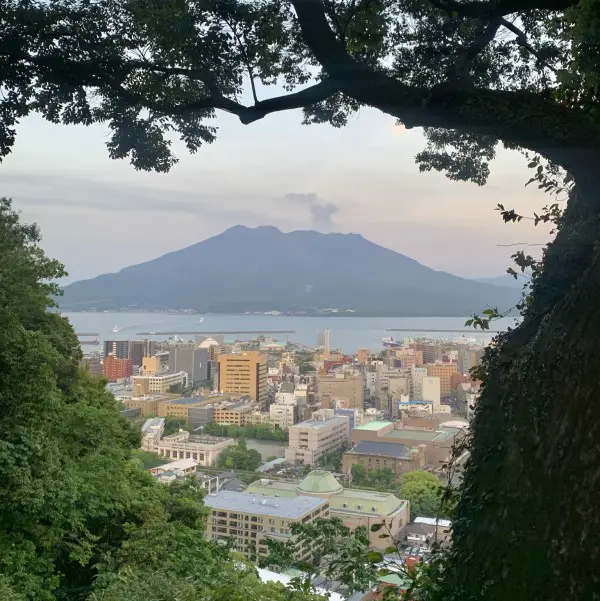
After visiting Sakurajima, make your way to the Shiroyama Observatory situated on the hill in the heart of the city. It is a great sunset spot offering fantastic views over Mount Sakurajima, the city of Kagoshima and Kinko Bay. This is where the similarities between the landscape of the cities of Naples and Kagoshima are most noticeable.
But wait, what am I talking about? Naples in Italy and this remote corner of the world? Oh, yes. Due to the similar seaside location and dominating stratovolcanoes over the cities, Kagoshima and Naples are considered twin cities. Apart from hiking volcanoes, it was one of the reasons why I went to the very end of Japan and it meant only one thing … Time for pizza!
At L’oro di Napoli (which translates from Italian to “Gold of Naples”:)) you can have a really good Neapolitan pizza. Just remember to stick to the Italian classics. You won’t get disappointed with margherita. In addition, the restaurant interior design and music are great. I highly recommend it to all who want to have a break from eating raw chicken or black pork 🙂
L’Oro di Napoli – pizzeria in Kagoshima – Google Maps

Driving time and distance around Mount Sakurajima
Driving around Mount Sakurajima takes about an hour ~ 36 km.
DAY 7. Kirishima-Kinkowan National Park & hiking in the Kirishima Mountains
If you are staying in Kagoshima and flying off from Kagoshima Airport, it is most convenient to hike the Kirishima Mountains on the last day of your 1 week Kyushu trip. It will allow you to save some overall driving time. It is a 90-minute drive from Kagoshima to Ebino Plateau (1,200 m), which is a starting point of the trails, whereas the airport is halfway in between.

Welcome to the Kirishima Mountains - the land of volcanoes
The Kirishima Mountains offer spectacular volcanic landscape and unique hikes through the land dotted with perfectly shaped volcanic cones and craters. Here too, you should check volcanic activity updates. Due to recent Shinmoedake eruptions, the most scenic trail through the Kirishima Ridge is closed until further notice. You can check trails status here: Kirishima Ridge closure update
Hiking Mount Karakuni (1,700 m) – the highest peak of the Kirishima Mountains is still possible. This 2.5 – 3 hours round trip from the Ebino Plateau offers breathtaking views of numerous craters, volcanic cones and lakes.
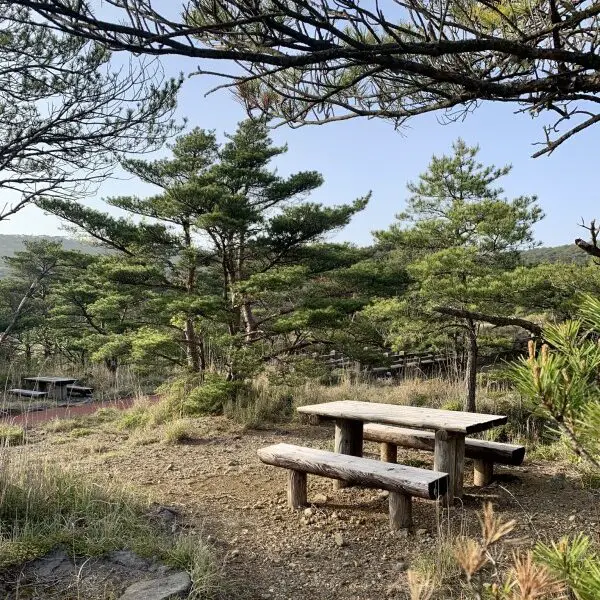
Read more about my Karakunidake hike in “Hiking in Kyushu – complete guide” – COMING SOON!
Driving time and distance from Kagoshima to Kirishima Mountains
Kagoshima – Ebino Plateau: 90 min ~ 72 km;
Ebino Plateau – Kagoshima Airport: 45 min ~ 33 km.
DAY 8. (EXTRA) Satsuma Peninsula
What to do if you have an extra day in Kyushu? That’s very easy – drive to Satsuma Peninsula to visit Mount Kaimon – a cone shaped volcano, try black sand baths and local cuisine!
The Satsuma Peninsula lies at the southwestern tip of Kagoshima prefecture, which you can feel. During my visit I did not meet any other tourists here, and I was greeted by the locals with both on their faces – a great smile and surprise 🙂
And if you have a bit more time in Kyushu... I guarantee you - won't be bored
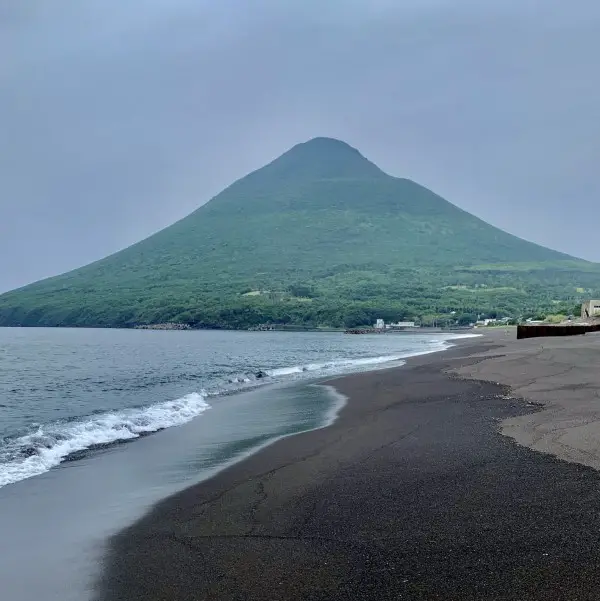
Things to do in Satsuma Peninsula:
- MOUNT KAIMON – A spectacular cone-shaped inactive volcano rising 924 meters above the coast. Kaimondake is sometimes proudly called “Mount Fuji of Satsuma” (Satsuma is the old name of Kagoshima Prefecture). Frankly speaking, it reminds me more of the majestic Mount Agung surrounded by splendid black volcanic beaches in Bali than Fujisan. You can hike to the top of Kaimondake, but I had no chance to check it out.
- LAKE IKEDA – Kyushu’s largest volcanic lake with a beautiful view of Mount Kaimon. Although I haven’t met the local version of the Loch Ness monster supposedly inhabiting the depths of the lake called Isshii, visiting the lake was enjoyable. I finally had a chance to try the local specialty – the purple sweet potato ice creams, which are sold in very old-fashioned little shops by the lake.
- IBUSUKI ONSEN SAND BATHS, where bathers are buried in hot black sand. Unfortunately, I did not have the opportunity to find out about their healing properties myself, but give it a try, it looks great! While visiting this part of Kyushu, I had terrible back pain and was afraid that if they bury me in the sand, I would never get up again. 🙂
- REGIONAL CUISINE served in local restaurants in Ibusuki Onsen: satsuma-age (deep-fried fish cake), Kibinago (small silver herrings eaten raw), chicken sashimi (raw chicken meat) and Satsuma shochu (traditional sweet potato spirit). I can recommend Satsuma Aji restaurant – not only was the food tasty and authentic, the menu was available in English as well! Check it out here: Satsuma Aji Google Maps
Southern Kyushu Vibes are very different from what you probably think of Japan and sweet potatoes (satsumaimo) icecream is simply a Must!

Driving time and distance from Kagoshima to Satsuma Peninsula
Kagoshima – Ibusuki Onsen: 80 min ~ 45 km;
Ibusuki Onsen – Mount Kaimon: 25 min ~ 16 km;
Mount Kaimon via Lake Ikeda back to Kagoshima: 90 min ~ 60 km.
KYUSHU 7 DAYS ITINERARY: MORE PLACES TO VISIT, NOT INCLUDED IN THIS ROAD TRIP
- HOT SPRINGS – there are numerous hots springs in the island of Kyushu. The most famous are located in Beppu (Oita Prefecture).
- YUKUSHIMA – a subtropical island off the southern coast of Kyushu, covered with some of the oldest cedar trees in Japan (Kagoshima Prefecture).
- FUKUOKA – the largest and most vibrant city in Kyushu with its traditional street food stalls (Fukuoka Prefecture).
- NAGASAKI – Japan’s most multicultural city, which is one of my favourite cities in the Land of the Rising Sun, full of history and interesting sites (Nagasaki Prefecture).
KYUSHU 7 DAYS ITINERARY: COSTS
The total cost of this 1-week itinerary in Kyushu was around 200,000 JPY (two people, food expenses not included). We travelled in May during the Golden Week Holidays and booked everything well in advance. Here’s the breakdown:
- Return flight ticket from Tokyo for 2 pax ~ 70,000 JPY;
- Car rental ~ 50,000 JPY;
- Petrol ~ 7,000 JPY;
- Road toll ~ 5,000 JPY;
- 6 nights for 2 pax ~ 70,000 JPY.

KYUSHU 7 DAYS ITINERARY: MAP
I hope this article will help you plan your 1-week road trip around the beautiful island of Kyushu. Let me know in the comments if you need anything else or… how did your trip go. Because you are going, aren’t you? 🙂
This Post Has 6 Comments
Hi mam. We are retired couple from India interested to see Japan. Your narration is too good. It seems you went on your own in a rented car. Can you please name any Japanese Tour operator for a road trip. Thank you.
Hi Anuradha, thank you for your good words and for looking into my blog. Unfortunately I can’t recommend any tour operator for a road trip as I always travelled on my own and rented a car from Toyota Rental or sometimes from Orix or Nissan car rentals.
Thank you for your detail itinerary. I am planning a road trip to Kyushu in early October. We will fly into Fukuoka and thinking of driving to Saga, Nagasaki, Kumamoto, Mt. Aso, Takachiho, Beppu then back to Fukuoka. Would 7 days enough for this visit? Thanks in advance!
Thank YOU for reading my blog 🙂 Your schedule is very tight, but I’ve been so many times in your shoes trying to squeeze as many places as possible with limited time available, so I’ll try to help. If you don’t plan to visit Fukuoka and will just drive through Kumamoto, it might be doable. How about this itinerary?
Day1 Arrive to Fukuoka, drive to Arita (90km/1h30min) and visit this lovely town. I think it’s the nicest attractions in Saga pref. Day2 Drive to Nagasaki (80km/1h). I spent 4 days in Nagasaki and loved it! Day3 Morning – sightseeing in Nagasaki, afternoon drive to Mount Aso (250km/3h-3h30min) via Kumamoto. Day4 Mount Aso <3 Day5 Drive to Takachiho from Aso town (55km/75min), visit the gorge and drive to Beppe (125km/2h30min) Day6 Relax in hot springs in Beppe (I have never been there!) Day7 Drive to Fukuoka (150km/2h) - depending on your flight schedule you might be even able to see a bit of Fukuoka.
Good luck with planning and enjoy beautiful Kyushu!
Hi Beth, Thank you for such a detailed travel log , so helpful. Due to my wife’s recent knee operations , hiking/climbing/trekking is not an option for us. Would Kyushu still be very interesting? The Japanese golden holiday period is to avoided for a visit? Thank you
Hi Anilkumar,
First of all, thank you for reading my blog. To answer your question – I think even if you don’t hike, Kyushu is still a wonderful destination for a road trip if you are seeking to experience Japan’s nature. There are plenty of lookouts / beautiful sights easily accessible by car and amazing onsens in Beppu. If you can, it is better to avoid the Golden Week period as it’s when all Japanese go on holidays and all places are crowded and more expensive. Hope it helps!
Leave a Reply Cancel reply
Save my name, email, and website in this browser for the next time I comment.
You Might Also Like
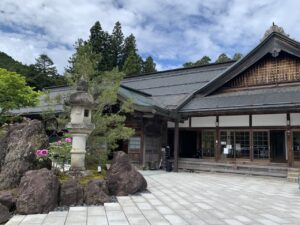
Koyasan 2-Day Itinerary & Honest Temple Stay Review
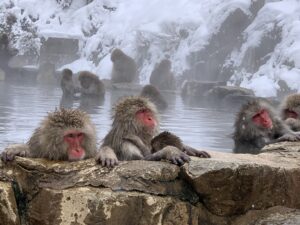
Wild Monkeys In Hot Springs – Snow Monkey Park
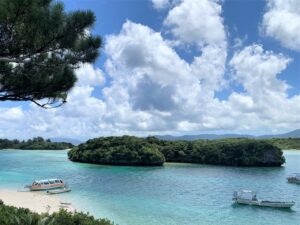
Ishigaki Island On A Scooter – A Tropical Paradise In Japan
- Skip to primary navigation
- Skip to main content
- Skip to primary sidebar
- Skip to footer

at the chias
making a home | finding beauty in the ordinary | living for things that matter
Yufu Child Farm – Family friendly Farm Stay in the Japan Countryside
August 18, 2023 · In: Motherhood , Travel
Finding this gem of a family friendly farm stay in the Japan countryside was a major highlight of our Kyushu trip. In this post, I share about our 3 day 2 night stay at Yufu Child Farm. (For our full week-long itinerary, check out – One week in Kyushu with Kids ).

We planned our Kyushu trip to focus on time in nature, and I found some information about farm stays in various towns on the island. However, these were all in Japanese, a language we don’t speak. While looking for accommodation on Airbnb, I chanced upon this listing titled “ Yufu Child Farm ”. Despite not having many reviews, the few reviews that were present painted an attractive picture of what the farm stay entailed. We decided to give it a shot.
From the moment we arrived at Emma and Riku’s home, we were overwhelmed by their hospitality in the best possible way.
The host, Emma
The house, a traditional rural japanese home, the activities and food, amazing on every account, the overall experience, highly recommended.
Emma is a single mother of 5 year old Riku. She moved to the countryside after 25 years in the city, because she wanted to spend more time with her son and build a better life for him. Despite having no farming experience, she decided to purchase a farm stay property and learn the ropes from scratch. She spent time with other farmers, learning how to tend the land.

Having spent her adulthood in the city and not cooking meals from scratch, she had to learn how to use the produce she would grow to feed her guests. She shadowed a retired farm stay host, learning how to cook a great variety of dishes based on what would be available to her from the local area. In her words, while she could read recipes online and follow them, good food depends on the quality of ingredients you have. A different type of soy sauce, water, salt, all change the taste and texture of the food you make. There is no substitute to learning from someone with first-hand experience.
The home is a two-storey traditional Japanese house. The first floor has two adjoining connected rooms for guests. One has two single-sized Western style beds, and the other room is a tatami area which can fit four futons. In total, the farm stay can host one group of up to six guests. Next to the guest room is a playroom filled with a great variety of toys and books. My kids spent so much time playing there!

Emma and Riku share a room upstairs, which is where the kitchen and living area are also located. We had our meals in their living room, together with the family. Being part of a local family was such a treat, and it showed us a different way of life. All those tiny dishes in Japanese-style plating? So cute and it makes food look so much more appetizing!
As part of the farm stay, we were to help Emma harvest some fresh produce. She grows a large variety of produce as her intention is to provide exposure for her guests, especially children, as she wants to be a kid-friendly farm stay. She does not grow with the primary intention of selling, and so there is no pressure on the kids to “get it right” or worry about trampling on plants or accidentally destroying part of a crop.
We visited in mid-July, and that morning, we were able to harvest blueberries, tomatoes, pumpkins, carrots, green peppers, zucchinis, okra, and blue pea flowers.

Breakfast and dinner are provided as part of the farm stay. Apart from the fresh produce from her farm, Emma also makes a trip to collect special spring water before each group of guests arrives, as the Japanese believe that cooking with special water makes for better tasting food. Perhaps it was the special ingredients and water, or Emma’s love and heart poured into the cooking, or both, that made every meal so very delicious.
We stayed for two nights, and so we had a lunch on the second day with no plans for. Emma suggested a few local options, and we decided to go with her recommendation of somen at a special local restaurant up in the mountains. We followed behind her in the car up the narrow mountain road, and were rewarded with the most mind-blowing noodle eating experience.

The naturally occurring water in the mountain was carbonated, cold and slightly sweet. We sat at a bar where the water was piped into clear bowls in front of us, constantly running over the somen that we would then pick up, dunk into dipping sauce, and enjoy. The set meal we chose also came with freshly grilled fish. After we ordered, we watched the owners catch the fish from the tank for our meal!

There are no words to adequately describe the explosion of flavours and sensations in the mouth when eating the somen. The cold temperature, carbonated water, sweet-salty dipping sauce, slightly spicy citrus paste in the sauce, all combine together in perfect harmony.
Later in the day after harvesting, we helped prepare for dinner by making skewers, or yakitori, with the freshly harvested produce and some meat Emma had prepared the day before. Emma also made tempura using some of the produce. She invited some friends over to join us, and they taught us how to make onigiri, Japanese rice balls.

That night, we enjoyed a feast for dinner, with the onigiri, yakitori, and tempura all made from scratch and with our own hands. After dinner, we enjoyed kakigori, a Japanese shaved ice dessert. While most kakigori are simply shaved ice with coloured syrups, Emma had made her own strawberry jam and condensed milk for us to use as better toppings for the summer dessert. It was so much fun putting food together, and then enjoying it all with great company!

The second morning, Emma offered us a few options of outdoor activities, but we decided to spend time indoors as the children were playing very well together. Emma decided to let us try our hand at making traditional sweets out of hattaiko, a roasted barley flour. It was really easy and even our 1.5yo enjoyed rolling her own sweets and eating it!

Emma started her family friendly farm stay with the intention of hosting families with young children, exposing them to farm life while also giving her son Riku the opportunity to meet other children. As a family with young children, we felt comfortable in the environment, knowing that we were in a home that understood and accepted how young children behave (this is rare in a country like Japan!). The opportunities to observe and participate in farm life and home life were invaluable to us city-dwellers.
If you’re looking for a way to embrace slow travel, support local tourism, and provide authentic learning experiences to your kids, this is it.
you’ll also love

5 tips to love travel with kids, from experienced travellers
Follow along.
@atthechias

On the Blog
- Home Living
- Shop My Favourites
- Gift Guides
stay in the know
Copyright © 2024 · Theme by 17th Avenue
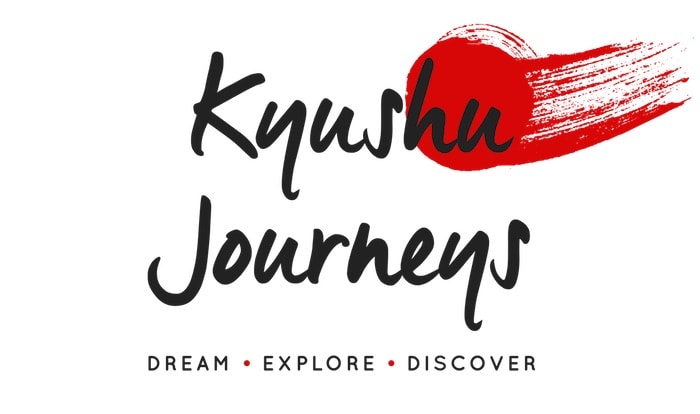
Kyushu Private Tour
Kyushu private trip, if you want to travel around kyushu on a private trip with just your family and friends you have come to the right place. please check the two options below., option 1: private guided tour.
You want to travel on a private tour bus with your friends or family and an English-speaking guide. You want an all-inclusive tour with meals, accommodation and entrance fees already included in the price. You want to visit the best places and eat the best food. Visit this page to learn more about our private guided tours .
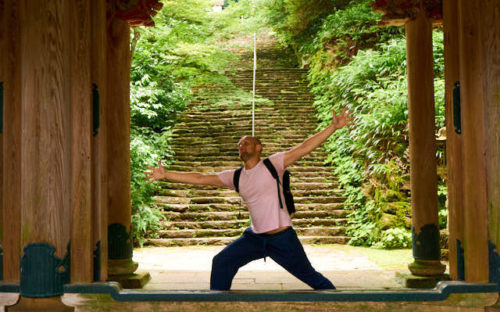
Option 2: Private non-guided tour ("free and easy")
You want to travel by rental car self-drive or by train. You are happy to travel without a guide. You need advice and support from a specialist Kyushu travel agency to suggest the best itinerary, do all the planning and make all arrangements. You need a private trip planning and arrangement service.
Read the FAQ below to get all the details.
Why use a private trip planning and arrangement service?
You need help to overcome the language barrier. You want the best restaurant and hotel recommendations, transport and travel advice. You want to visit the best places and do the best things. You want to avoid the tourist traps.
You’re busy living your life and you don’t have time to plan. You just want to book your flights and enjoy your trip.
How does this private trip planning and arrangement service work?
First send us whatever plans you have about your trip. Perhaps you don’t have any ideas yet just questions. That’s fine too. We can help you decide when to come and how long to stay.
We’ll give options of activities you can do, things you can see and food you can try. You choose how much you want to spend on hotels and how you want to travel. Tell us anything you’ve read about or seen on TV.
We put all this together and plan your itinerary. We’ll give our suggestions too (ideas that only a Kyushu local knows). We’ll consult with you as we plan your vacation.
We do all the time-consuming planning and arrangemnts; you just enjoy your trip.
How much does this private trip planning and arrangement service cost?
Kyushu Journeys will plan a visit to Kyushu up to 7 days (6 nights) for a group of 5 pax for a Planning & Arrangement Fee of ¥140,000 ( currency converter here ). It’s an excellent deal because you just pay the fee once even if you are a couple, a family, or a group of friends. Think of all the time and hassle you’ll be saving too!
For any additional days after 7 days add ¥9,500 per day.
For any additional participants after 5 pax add ¥9,500 per person (there is no additional charge for children aged 5 years or younger at time of travel).
Please note last-minute Planning & Arrangement Fee surcharge:
- 30 days or fewer before Kyushu arrival date: 25% surcharge
- 15 days or fewer before Kyushu arrival date: 50% surcharge
- 7 days or fewer before Kyushu arrival date: 75% surcharge
Don’t worry about sending your initial enquiries. You won’t be charged anything until you’ve made a firm decision to use us as your trip planners.
Let us know how many travellers and how long you plan to stay. We’ll get back to you with everything you need to know to get started and answer any questions you want to ask first.
How much will my tour cost?
This depends on you. We arrange everything based on the standard of travel and accommodation you request. Then we add all those costs together + our planning fee = final price. We charge your travel and accommodation at cost price so you get the best value holiday.
What if I’m on a tight budget?
At the start of the planning process we will give you some accommodation and transport cost options. We’ll check with you before booking any hotel. It means you will always be in control of the budget.
Can you plan a self-drive Kyushu itinerary?
Yes we can. Most of our clients choose self-drive. We’ll book a suitable rental car for your group size with English GPS. The itinerary we plan will include simple navigation codes to punch into your car navigation system. It couldn’t be easier! We’ll also include Google Maps links for all destinations on your itinerary as a backup.
Can you plan a trip by train?
Yes we can. If you don’t want to drive we’ll plan your trip by train. We’ll include detailed train information on the itinerary so you’ll know exactly where you need to be and at what time for each journey. We’ll also advise about the best tickets to purchase and will make reservations for you if it is required for any journey. For places off the rail network we can plan trips by bus and/or arrange a private taxi. We’ll include Google map links for all places on your itinerary ~ each sightseeing spot, hotel, restaurant, train station etc.
Where will my tour start and end?
You just need to get yourself to and from Fukuoka (the main city of Kyushu island) and we’ll take over the arrangements from there. You can fly into Fukuoka International airport from your own country or arrive by train or plane from another part of Japan.
Will I be on a group tour?
No you won’t. It’ll be just you and your friends or your family, or perhaps you’ll come alone.
If you want to join a group tour instead message us and ask us to send details of our latest package tours. Our package tours include meals, transport and accommodation with an all-inclusive price. You’ll travel by private bus and be accompanied at all times by an English-speaking tour leader.
How long is my tour?
Most of clients stay 7-10 days but you can come come for as long as your travel plans allow.
Will I be with a guide?
No you won’t. We’ll give you all the info you need to explore Japan for yourself bother-free. However if you do prefer the inside knowledge a local guide can provide we’ll be happy to arrange one for some or all of your trip.
What if I have language problems?
Give us a call or a WhatsApp message. We offer a fully bilingual (English/Japanese) hotline completely free of charge. It’s available out of hours too in case of emergency.
What kind of accommodation will I stay?
You can choose depending on your prefered style and budget. There are western hotels budget or luxury. For Japanese style choose from family-run inns ( minshuku ) or traditional hotels ( ryokan ). We’ll suggest some hot-spring ( onsen ) resorts too. In rural areas you can stay at a f armstay and in summer you can camp. We’ll give you different options as we plan your trip. We won’t book anything without asking you first.
How soon should I book?
If possible contact us 6 months or longer before your trip. If you trip is closer than that get in touch ASAP. Don’t worry if your dates are not confirmed yet. It’s especially important to contact us as soon as possible if you plan to visit Kyushu during peak periods like cherry blossom season. Japan is enjoying a tourist boom so flights and hotels fill up quickly. Don’t forget too that most hotels become more expensive the closer you get to the travel date. However we do understand that for many reasons you may not be able to book so far in advance.
Whenever you plan to come contact us as soon as you can.
If your trip is less than one month away please note the late booking surcharges mentioned in the ‘How much does this private trip planning and arrangement service cost?’ section.
What kind of things can I do in Kyushu?
Oohh, lots …
Eat at the famous riverside food stalls, Visit ancient temples, Take country walks, Explore medieval castles, Ride on a steam train, Gorge yourself at seafood huts, Soak in onsen hot spring waters, Do hanami (cherry-blossom viewing), Buy a pot, a plate and a mug, Wander the autumn colours, Take a sake brewery tour, Wear a kimono, Browse the latest electronics, Savour the best Wagyu beef, Explore primordial forests, Roam around ceramic towns, Buy sake or shochu, the best green tea or an exquisite Hakata Doll, Go scuba diving, Do Paragliding or motorized mountain boarding, Eat ramen and hotpot, Take your kids on a fun-themed train, Experience authentic kaiseki (multi-course) cuisine, Gallop through the countryside, Peer into bubbling volcano crater, Enjoy tempura and sushi, Shop ’til you drop, Pick fruit, Dance the night away, Watch sumo, See a traditional dance, Go to traditional theatre, Watch a baseball match, Visit rural villages, See tea plantations and rice terraces, Row a boat, Do star-gazing, Stay at traditional ryokan inns.
Get more ideas >
Where are the best places in Kyushu?
We’ve compiled the COMPLETE list of Best Fukuoka & Kyushu Travel Spots . Take a look to get some ideas.
What if I want to visit Kyoto, Tokyo or other parts of Japan?
From Kyushu to Kyoto takes less than 3 hours by shinkansen bullet train. You can fly to Tokyo from Kyushu in less than 2 hours. You can easily visit those places before or after your Kyushu trip. Unfortunately we can’t help with any travel planning outside Kyushu because we only know about what we love.
Your Kyushu Vacation Starts Here
Let us know as much or as little about your travel plans as you know yourself. We’ll get right back with everything you need to know to start planning your Kyushu holiday.
Discover More: Kyushu trips, pics and videos
Thanks for everything! Yes we thoroughly enjoyed ourselves. Kyushu is definitely a place to go back to. Hope to get… Read more →
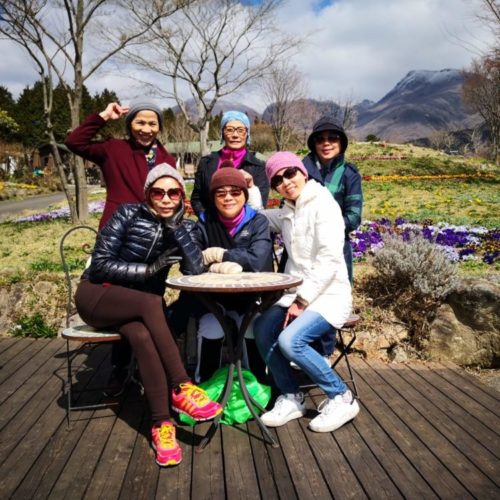
Kyushu Journeys was awesome in helping out with our itinerary. They were very helpful especially with the local reservations and… Read more →
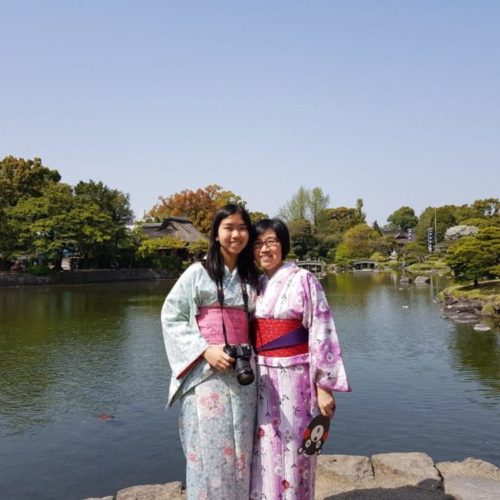
Kyushu journeys were attentive and knowledgeable in organising our specialised itinerary for Kyushu. Despite having been to Japan many times… Read more →
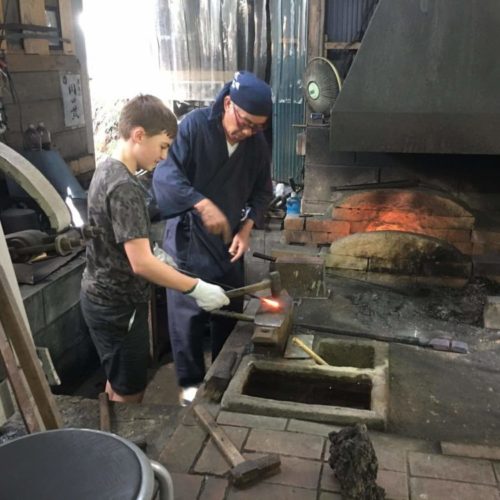
Kyushu & Fukuoka Trip Planning
Send us your basic information. We’ll get back to you with everything you need to know.
Share your love of Japan travel
- Custom Travel
- Family Vacation in Japan
- Family Travel: Kyushu
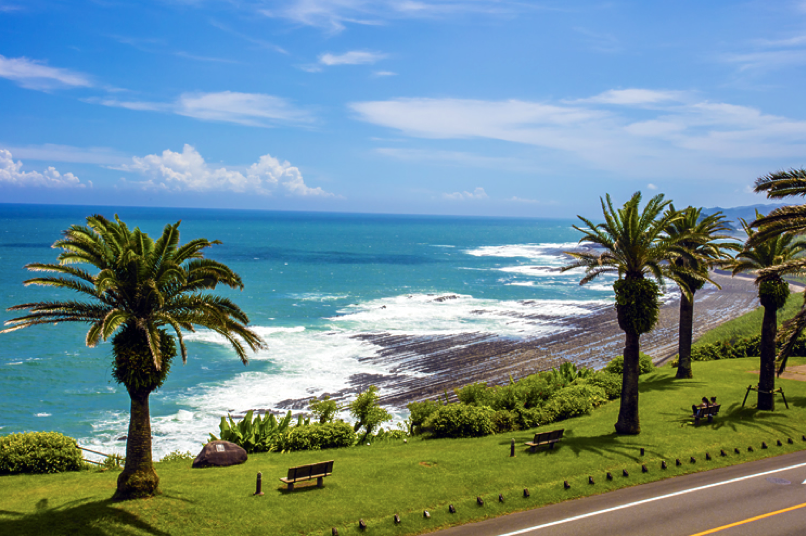
Kyushu, the third largest island located in the southern part of Japan, can be a perfect destination for a family trip. Thanks to the warm climate throughout the year, the island is blessed with both green mountains and clear blue ocean. The island is also well-known for volcanic mountains offering quality hot springs. There are a wide range of activities, too. Farm visits in the mountains, marine sports at the ocean are just a few that can be enjoyed with all family members. With this itinerary, you will encounter different charms of Kyushu Island.
Sample Itinerary Overview
Day 1 arrive at fukuoka airport, sightseeing in fukuoka/hakata.
Arrive at Fukuoka Airport. Move to the center of Fukuoka city, known as Hakata . In this largest and liveliest city of Kyushu Island, enjoy exploring a variety of sites such as shopping area in the city center and modern spots along the seaside. If you would like, visit Dazaiifu Tenmangu Shrine by one-hour train ride from Fukuoka city, which is worshipped as the god of academic achievements.
In the evening, experience Fukuoka's local cuisine such as Mizutaki chicken hot pot or Tonkotsu ramen noodles in pork bone broth. Stay at a hotel in the city.
Day 2 Transfer to Beppu Hot Spring Town / Explore around Beppu
Enjoy around 2 hour trip by an express train from Fukuoka city to Beppu Onsen Town . After meeting your guide, enjoy the private tour in Beppu. Beppu boasts the largest quantity of hot spring water in Japan, and the hot spring resort consists of eight hot springs, each with different quality of water. First attraction is Jigoku Meguri (exploring hells) which is one of the must-see spots in Beppu. It is impressive to see the dynamism of different types of "hells" (hot spring sources with different colors, all natural). After lunch, visit another fun spot, Takasakiyama Natural Zoological Garden , where you can observe the large number of wild monkeys very closely.
At night, rejuvenate yourself in hot spring water at an authentic Japanese ryokan.
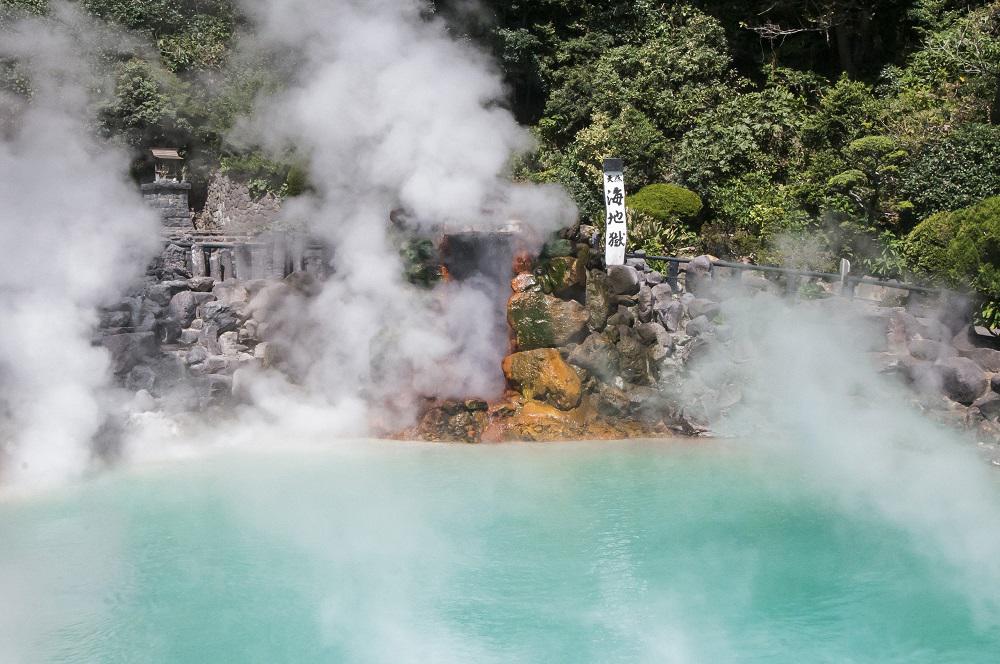
Day 3 Takachiho
Have a relaxing morning at ryokan. After breakfast, travel to Takachiho by a private car. Takachiho is known as "The Land of Myths", in Miyazaki prefecture. There are many places in Takachiho which relate to Japanese mythology such as Amano Iwato Shrine . Takachiho Gorge , a mysterious V-shaped gorge, created by the Gokase-gawa River, is also must-visit. The main attraction today is a boat ride in Takachiho Gorge. Appreciate a stunning view of gorge during for 30 mins boat ride. Getting close to Manai waterfall by the boat will be thrilling. There is a walking path too, where you can overlook the spectacular scenery of gorge.
Stay at a traditional ryokan in Takachiho where your family will be welcomed with the warm Japanese hospitality.
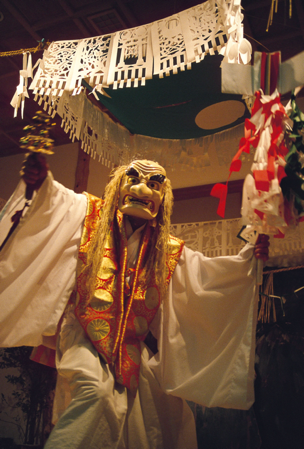
Every evening, " Yokagura " dance ritual is performed at Takachiho shrine. An hour-long performance of four dances depicts a scene of Japanese mythology. The mysterious performance will let you feel you are in the land of myths where gods are believed to be descended from heaven.
Day 4 Miyazaki
On this day, you will travel to the southern part of Miyazaki prefecture through the east coast of Kyushu Island. On your way, you will be able to appreciate the magnificent view of Pacific Ocean and feel the tropical atmosphere.
First stop is Hyuga. Visit Hyuga Umagase . This is the precipitous cliff created by volcanic activities since 15 million years ago, stretching 70 meters high and 100 meters deep inland. Next to the cliff, there is the Sea Cross , where the eroded columnar joint creates the shape of a cross. Pray here as it is said your wishes will come true. Then, visit Omi Shrine located right in front of the sea. Move further to south, and you will arrive at another unique spot, Aoshima Shrine . Iconic vermilion torii gate is standing right next to the ocean which is one of the most major photo spots. Close to the main shrine surrounded by tropical trees, you can find interesting pattern of rocks, called "Demon's Washboard", created naturally.
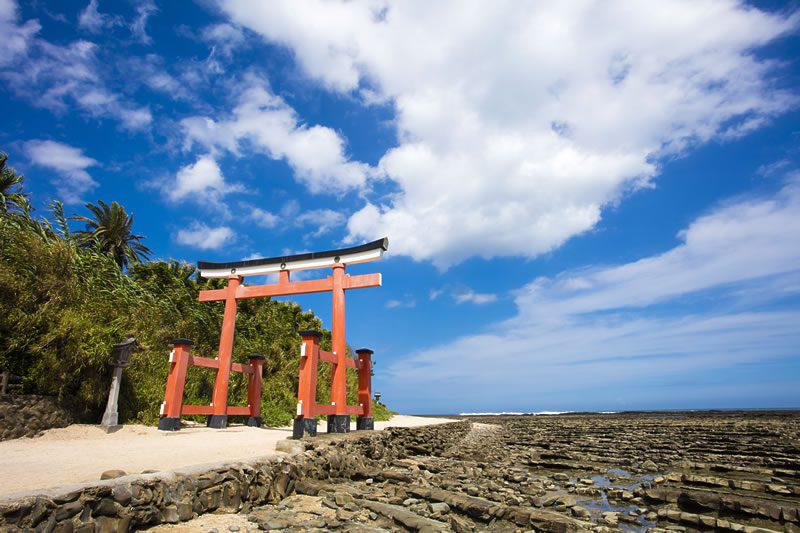
For your night's stay, Bukeyashiki (traditional samurai residence) is recommended. This will be a unique experience staying in a traditional architectural house that was originally used by a high-class Samurai family back in the Edo period (17th-19th century). The house will be reserved for only one group of guests each day. Enjoy staying in this historical yet modernly furnished Samurai residence while you are in the preserved samurai district of Obi.
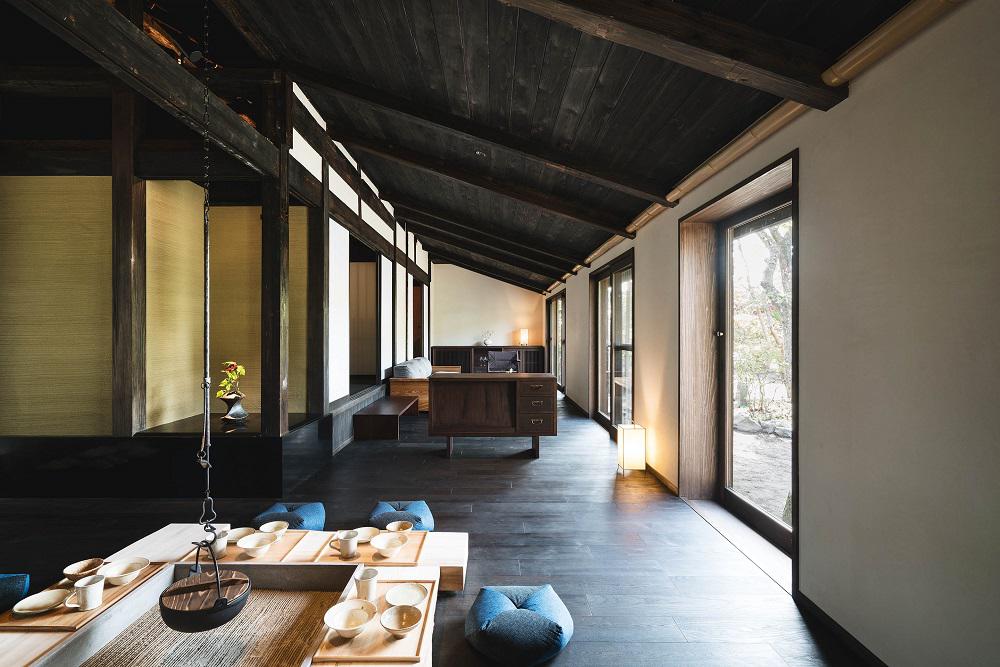
Day 5 Obi in Nichinan City
Privately guided tour in Obi in Nichinan City. First, enjoy exploring unique Obi town which is the preserved samurai district, often described as the "Kyoto of Kyushu". It is fun to walk around traditional streets lined with former samurai residence, attractive stone and plastered walls, and more.
Thanks to the warm climate through the year, Miyazaki prefecture produces many different kinds of fresh fruits. On this day, enjoy strawberry picking activity. The bright red ripe strawberries are fresh and sweet. Some of strawberries are larger than bite-sized!
Nichinan City is also well-known for surfing and a variety of other marine sports . Your family can have a fun together by trying canoe riding, snorkeling or other activities. If you prefer to have a relaxing moment in the ocean, there is a cruise ship too. You will be escorted to many view spots where the scenery of green mountains of Nichinan City can be appreciated from the sea side.
Have a pleasant night in Bukeyashiki style accommodation in Obi town.
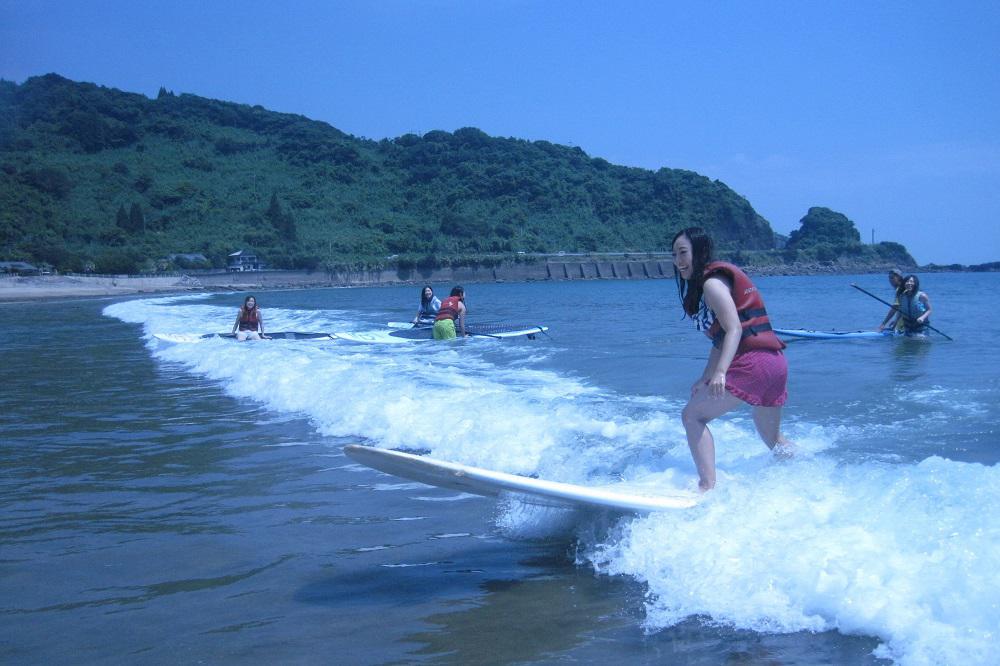
Day 6 Kirishima / Transfer to Kumamoto
Start your another adventure with your guide. The first interesting destination on this day is Mizonokuchi Cave . This cave is the erosion created by spring water of Kirishima mountain and now is surrounded by the dense forest. Behind the vermilion torii gate, you will find the entrance of this cave. From the inside of the cave, look back to the entrance. You will see the sublime scenery of the light falling onto the torii gate through surrounding trees.
Next stop is Kirishima Shrine . This shrine originally established in the 6th century consists beautiful halls surrounded by forest. Feel the sacred ambience here.
Then, visit Kirishima Open Air Museum lying at the foot of Kirishima mountain. Here, you can enjoy walking amidst meadowland while experiencing unique contemporary arts such as the one created by Yayoi Kusama, the famous Japanese artist.
Stay at a hotel in Kumamoto city.
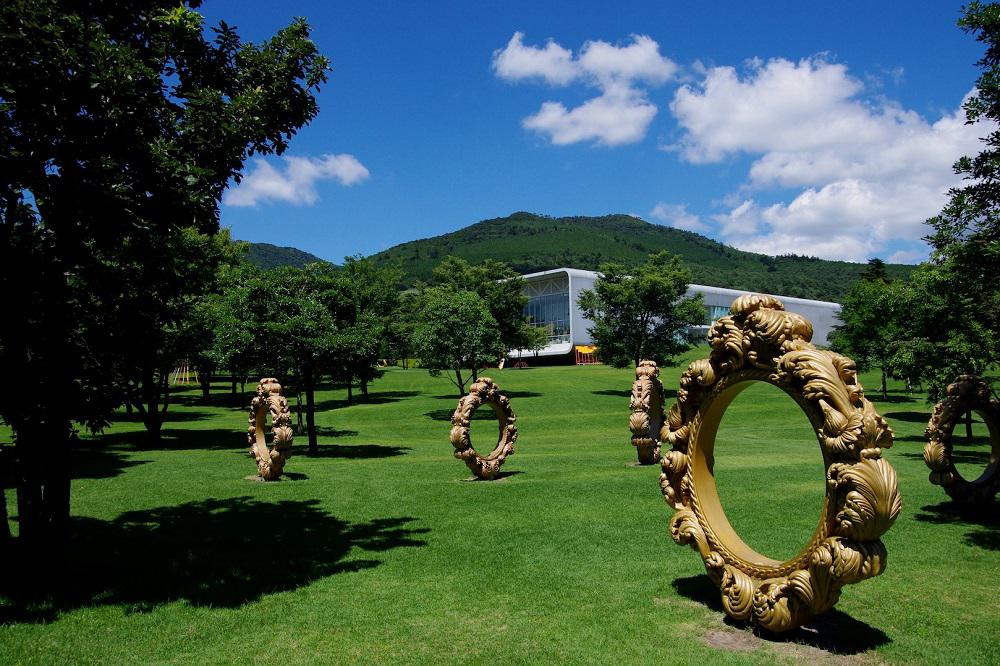
Day 7 Kumamoto and Mt. Aso
Privately guided tour in Kumamoto City and Mt. Aso . In the morning, start from Kumamoto Castle which was established by samurai Kiyomasa Kato in 1601. Considered as the best three castles in Japan and nowadays, it is the most popular sightseeing spot in Kumamoto City.
Drive to Mt. Aso, an active volcano in the center of Kyushu. Its ancient caldera ranks among the world's largest, with a diameter of up to 25 kilometers and a circumference of over 100 kilometers. First stop is Kusasenrigahara , a shallow square prairie spread over the northern base of Mt. Eboshidake. Enjoy the truly idyllic scenery here.
Then, visit Aso Farm Land which offers fun nature activities for your family. There is a zoo area where children can touch with animals closely.
Before moving to your ryokan, stop by Daikanbo where the spectacular vista of five peaks of the Aso and Kuju mountain range can be seen.
At night, immerse yourself in the hot spring water at your ryokan in Mt. Aso.
Note for Kumamoto Castle) As the earthquake happened in 2016 severely damaged the castle. There are many areas of the castle still closed off to entry. However, exterior of the castle can be seen from the surrounding area. It is impressive to see that the castle stands strongly and exudes the sense of presence even under repair.
Day 8 Transfer to Fukuoka Airport / Depart from Fukuoka
After relaxing morning at your ryokan, transfer to Fukuoka Airport by a private car.
Have a safe flight to home!
The tour price will differ according to many factors such as the rank of accommodation (e.g. 5-star hotel, 4-star ryokan), way of transportation (e.g. train, private car), number of days with a private guide, duration of your tour, or season. Please contact us. One of our tour consultants will come up with an ideal plan and cost for you.
For more information, or to start customizing your own itinerary, please contact us.
Michi Travel Japan Tel: +81-3-5213-5040
- Highlights of Japan Tour
- Highlights of Western Japan Tour
- Hokkaido Custom Travel
- Kyushu Custom Travel
- Unspoiled Traditional Towns
- Gourmet Tour Japan
- Japan's traditional art, architecture and culture tour
- Japan Garden Tour
- Rural Charms of Northern Japan - Tohoku
- Contemporary Art & Architecture Tour in Japan
- Bonsai Tours
- Honeymoon in Japan
- Family Travel: Japan Highlight Tour
- Family Travel: Hokkaido
- Trip to Northern Kyoto and Surrounding Area (Kyoto's off-the-beaten gems)
- Trip to National Parks in Japan
- Business Solutions

You are using an outdated browser. Please upgrade your browser .
- Guide to Russia
- Experience Russia
Fun Things for Kids in Moscow
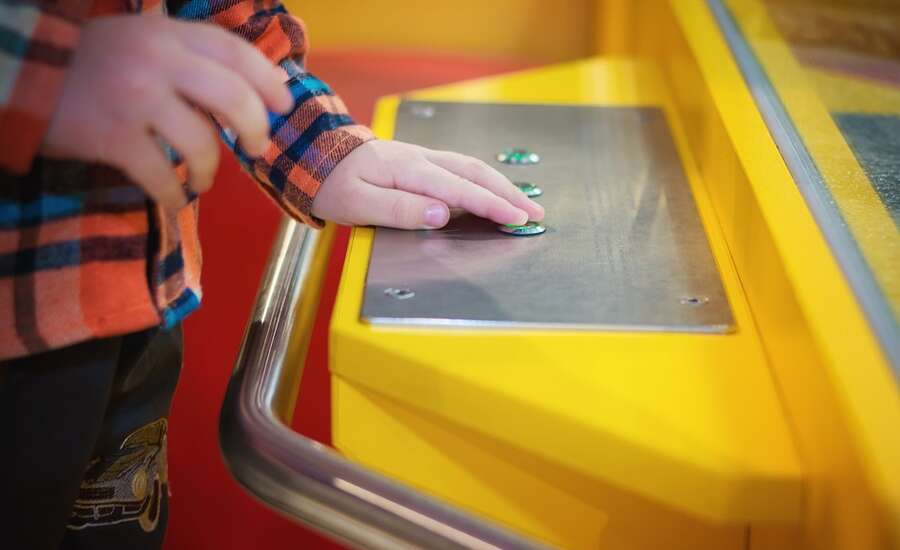
Photo by victoria_borodinova from Pixabay
What are the best things to do with children in Moscow?
- Summer: Futuristic parks, river boats and ice caves are perfect attractions for when the temperatures rise above 30.
- Museums: Russians are very proud of their history, which means that their museums are kept to a world-class standard. Both parents and children alike will be sure to learn something new at one of the many, often unique museums in Moscow.
- Culture: From the world’s oldest puppet theatre to UNESCO-listed whimsical, wooden palaces there’ll be plenty to treat your little prince or princess to.
- Winter: New Year is arguably the most magical time to visit Moscow, especially for children. The ice rinks throughout the city, Christmas markets and the magnificent ice-sculpture festival truly make Moscow a winter wonderland.
Moscow truly is a mega-metropolis like no other. Its non-stop energy and sheer unorthodoxy is sure to enthuse any child with its rebellious, east-meets-west spirit. Just walking down Old Arabat Street— where ancient wooden storehouses are squashed against grey, soviet blocks which are then towered over by blingy high-rises— is sure to appeal to the childish disdain of all things orderly and conventional. Apart from the main sites, there’s a whole host of family-friendly activities in Moscow from the very traditional to the uber, high-tech that will keep your kids entertained.
For Summer Scorchers:
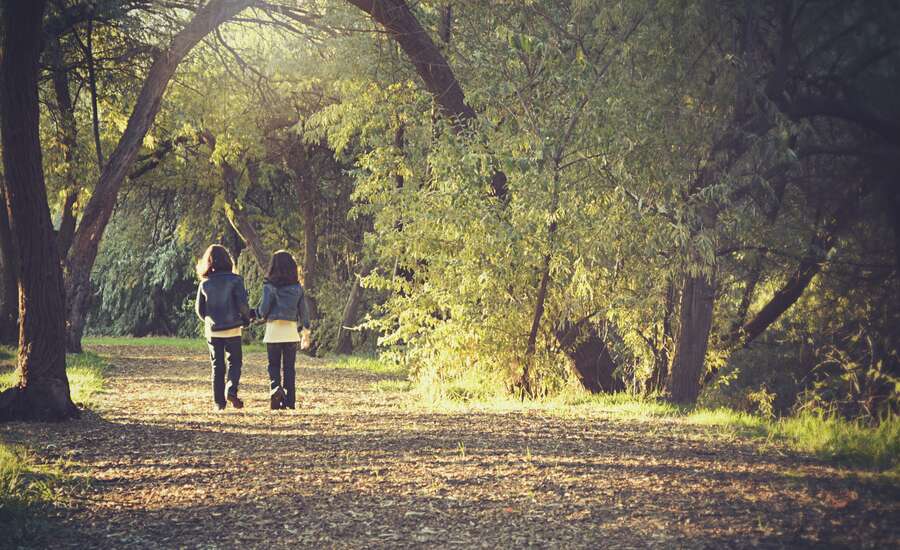
Photo by Jamie Taylor on Unsplash
VDNKh is Russia’s version of Disneyland and, to be honest, we think it trumps that tacky theme park by a mile. First things first is its size. At almost 600 acres, this Soviet park has everything; from space museums to soviet shopping outlets to equestrian centers to beaches. In fact, there’s so much to do that there really is no way to cover it all in one day. Our favorite attractions include the ROBO station, the super-cool playgrounds near the aquarium and the world’s biggest ice rink in winter. Better rent out scooters or bikes as well if you plan on seeing at least a fraction of this green gem.
Address: Prospekt Mira, 119 Nearest metro station: VDNKh
Unlike VDNKh, you won’t have to travel far from the centre to seek the lovely lush lawns of Gorky Park . Come early so that you can grab a beanbag or hammock for yourself while your children have some fun on the colorful playground rides or play ping-pong under the trees. At teatime, head over to the traditional Russian tea house for a brew from a giant samovar. It’s worth staying on for the whole day until dusk when the roof of the park’s planetarium slides open to reveal the wonders of the sky.
Address: Krymsky Val, 9 Nearest metro station: Park Kultury
Zaradye Park
Moscow’s brand-new Zaradye Park couldn’t be more different from the stern, red brick of the Kremlin that towers over it. Whichever way you look, you’ll be rubbing your eyes to make sure that this other-worldly landscape of floating glass bridges, underground ancient walkways, Siberian tundra and ice caves really does exist. For children, this wild-urban project is the perfect place for them to let some steam off during a day of sightseeing. Thanks to the unbelievable glass-paneled roof that keeps warm air in and the rain out, the lawns are perfect for lounging on all year round.
Address: Varvarka street, 6 Nearest metro station: Kitay-gorod
There’s a never-ending stream of tour boats bobbing up and down the Moskva River to hop on to when those little legs have had enough of walking. But for those who’d like something a little special, nothing beats the Radisson yacht. Champagne, on-board dining and floor to ceiling windows make it the most stylish way to cruise round Moscow.
Address: Naberezhnaya Tarasa Shevchenko, Moscow (next to teh Radisson Blue hotel) Nearest metro station: Studencheskaya
For Little Einsteins:
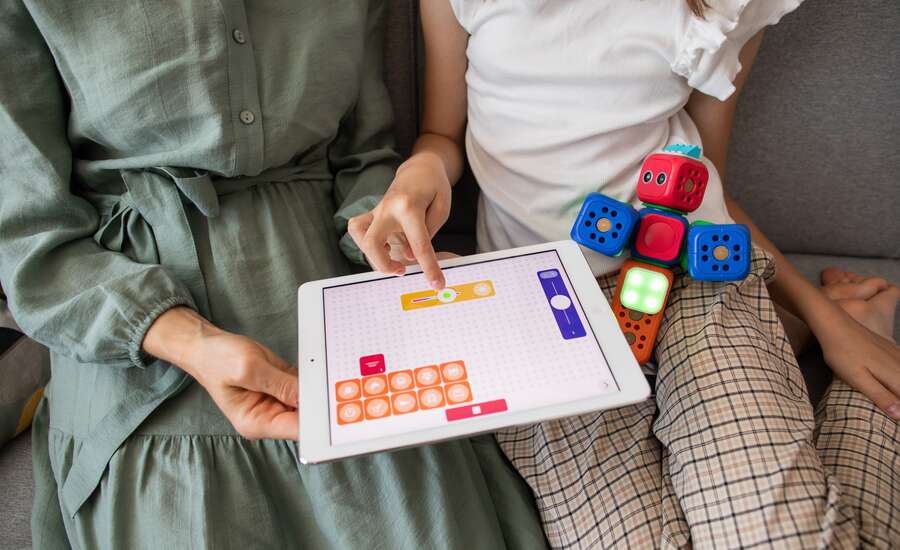
Photo by Robo Wunderkind on Unsplash
Museum of Cosmonauts
This is THE museum to go to if you happen to have a Star Wars fan with you. Unlike in countless planetariums around the world where gimmicky models of the solar system and dramatic movies make for a hollow experience, here you get the real thing. There’s a life-size model of the Russian space station, chunks of the moon, a space toilet, the actual Sputnik, heck, even Belka & Strelka, the space dogs, are there standing next to the very space shuttle they flew into space with (never fear, they were stuffed only after they died of old age). *For extreme fanatics, it’s worth noting you can arrange a tour to Star City, the astronaut training centre that is still in use outside of Moscow.
Address: Prospekt Mira, 111 Nearest metro station: VDNKh, Vystavochny tsentr
Darwin Museum
The first museum in the world devoted to explaining the most important concept of biology definitely deserves a visit. Its menagerie of nearly half a million stuffed animals illustrate the steady process of evolution and the many now extinct animals it boasts like the Dodo serve as a warning bell for what the age of mass-industrialization might bring. Despite its name, the Darwin museum isn’t at all quaint or old-fashioned with plenty of interactive displays and microscopes for children to engage with.
Address: Ulitsa Vavilova, 57 Nearest metro station: Akademicheskaya
Orlov Museum of Paleontology
This museum could easily compete with the famed Natural History Museum in London. In fact, its extensive exhibit of ginormous skeletons from all sorts of beasts from sloths to diplodocuses might even be more impressive than London’s. After all, Russia is an awful lot bigger than England and probably has lot more giants slumbering away in the depths of its forests just waiting to be dug up!
Address: Ulitsa Profsoyuznaya, 123 Nearest metro station: Kon'kovo
The Experimentanium
There’s lots of fun to be had at this fully hands-on science museum. It’s absolutely perfect for little toddlers and mischievous boys alike because nothing’s off bounds—the whole place is a playground (with a lot of science snuck in!). And don’t worry, most of the descriptions are in English so they’ll definitely learn something along the way.
Address: Leningradsky prospekt, 80/11 Nearest metro station: Sokol
For Boisterous Boys & Girls:
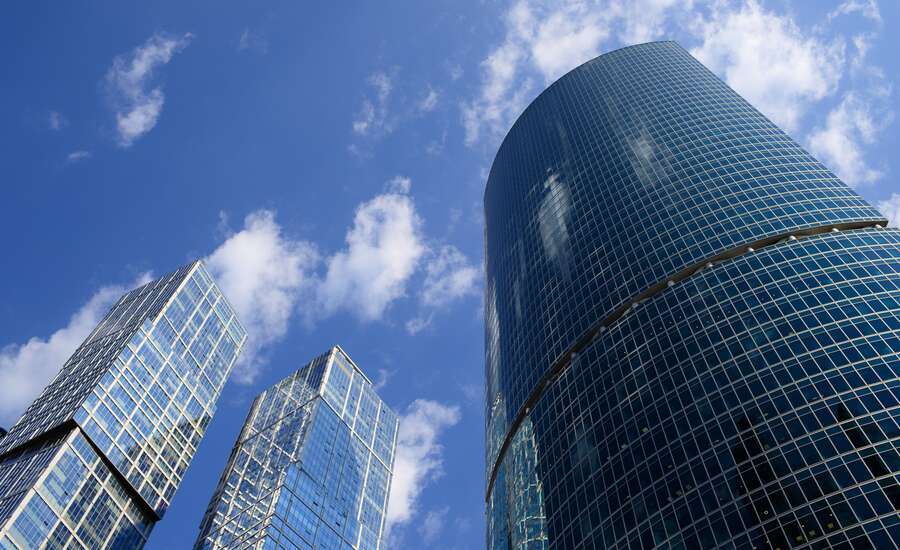
Photo by Alexandr Popadin on Unsplash
Moscow City
The second tallest, the third tallest, the fourth tallest and the sixth and seventh tallest buildings in Europe can all be found within a few meters of each other in the financial district, Moscow city. Apart from breaking their necks trying to gape at all the quirky high-rises, your kids can get a thrill by going up to the 54th floor of Ostankino TV Tower to its awe-inspiring panoramic viewing platform with a drop-down, glass floor!
Address: Presnenskaya Naberezhnaya Nearest metro station: Delovoy tsentr, Mezhdunarodnaya, Vystavochnaya
A trip down to this veritable villain’s lair is certainly worth it with children, not least because it’s 18 stories underground…. AND the only way back up is by the stairs making it the perfect recipe for a peaceful afternoon. Apart from tiring out children, Bunker 42 has the distinction of being a genuine nuclear bunker. It was intended to be the hide-away of the USSR’s top dogs in the case of nuclear war and the staff here do such an excellent job of recreating the tense atmosphere that we hazard against taking softer children here. Everything, from the actual computer with the big red button which would have been used to start WW3 to the KGB’s rooms, have been preserved exactly as they were at the height of the cold war.
*Entrance only with group tours which can be arranged in English.
Address: 5th Kotel'nicheskiy Pereulok, 11 Nearest metro station: Taganskaya
Central Armed Forces Museum
Though there isn’t much English in this museum dedicated to all things sickle and hammer (i.e. the Red Army), the genuine American U2 spy plane it has on show and the opportunity to hold real (but thankfully, not loaded!) guns make it a real treasure trove for army-mad kids.
Address: Ulitsa Sovetskoy Armii, 2 Nearest metro station: Dostoevskaya
Victory Museum
You don’t actually need to step a foot in this museum dedicated entirely to WW2 to please your wannabe soldiers. Just sit down on a bench as your kids jump on and off the airplanes, tanks, armored vehicles and every other killing machine imaginable that are free to explore outside this museum.
Address: Ploshchad' Pobedy, 3 Nearest metro station: Park Pobedy
Armory Chamber
Part of the Kremlin complex, the Armory Chamber’s incredibly diverse displays—spanning folk art to silverware to coronation dresses— cover almost every era of Russia’s royal history. The wedding carriages and ceremonial arms are particularly well-loved by children.
Address: The Moscow Kremlin Nearest metro station: Biblioteka imeni Lenina
For Little Princes & Princesses:
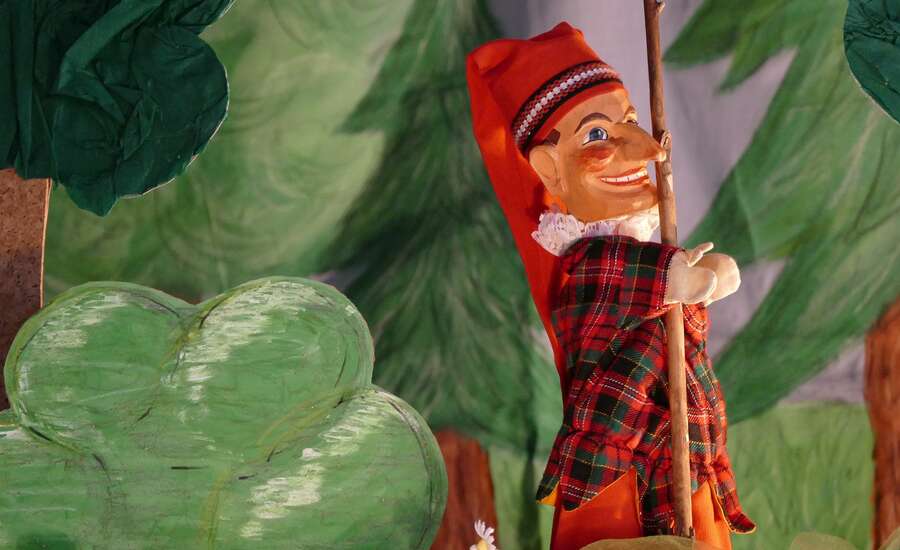
Photo by Ralph Lindner from Pixabay
Moscow State Puppet Theatre
The oldest puppet theatre in Moscow is also the largest in the world. Its wide-ranging repertoire has shows for tiny tots up to adult-only shows. Its fairytale clock, from which mythical creatures spring out, will be the cherry on top of a magical visit to this dear theatre.
Address: Pestovskiy Pereulok, 2/1 Nearest metro station: Marksistskaya
Central Kids Store on Lubyanka
This seven-story department store devoted entirely to little people boasts the biggest Hamleys in the world, the biggest time keeping mechanism and one of the best viewing platforms in Moscow. In other words, it’s kiddy heaven. The building itself is also rather noteworthy, dating back to 1953. Its stained murals and colorful tiles give it an old-world (soviet) charm.
Address: Teatral'nyy Proyezd, 5 Nearest metro station: Lubyanka, Kuznetsky Most
Izmailovsky Park
This is possibly the world’s only Slavic theme park. Just joking, but just be warned this recreated Russian village with mini-museums, bakeries and a market is a teensy bit kitsch. If your children are artsy, then why not let them make their own matryoshka at a masterclass instead of buying one at the market. And while the kiddies busy themselves with the business of covering every square inch of their clothes in paint, there’s plenty for parents to peruse; like the vodka museum or the pleasantly, rolling park land.
Address: Alleya Bol'shogo Kruga, 7 Nearest metro station: Sokolinaya gora
Kolomenskoye Park
Ivan the Terrible’s summer retreat isn’t at all as gloomy as you’d expect, indeed some might say it’s actually a bit too colorful. In our opinion, its postcard-perfect; with petite trains chugging through the acres of apple orchards, a pearl-white 16th century, UNESCO-listed church and a magnificently vibrant, 300 year old wooden palace. Take your children on a trip back in time, they’ll be delighted - we promise.
Address: Andropova Ave, 39 Nearest metro station: Kolomenskaya
For Petrol Heads:
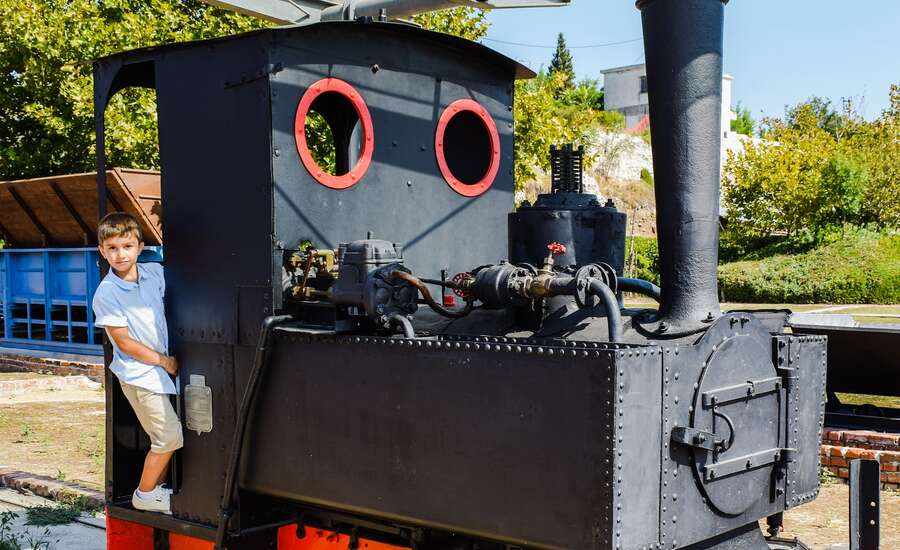
Photo by Dimitris Vetsikas from Pixabay
Moscow Rizhsky Railway Station
If you don’t have time to take your children on the Trans-Siberian, then a ride on a Soviet steam train is a superb alternative. The beauty of chugging through the outskirts of Moscow on a train with a red star on its gleaming, coal-black engine will definitely make Harry Potter fans squeal with excitement. Adults will appreciate the cups of tea served in old-style soviet mugs specifically made for train journeys. If you’d like to explore the rail museum after the trip (we highly recommend it), be prepared for the weather as the whole exhibition is uncovered.
Address: Rizhskaya Ploshad, 1 Nearest metro station: Rizhskaya
Moscow Metro Museum
After taking your children on the Moscow metro (which you simply must!), chances are they’ll bombard you with all sorts of questions a parent isn’t equipped to answer; like “How fast do the trains go?” and “Who drives them?”. Never fear, Moscow’s metro actually has a free museum which will answer all these questions, as well as even allowing kids to take a seat in the driver’s seat for a virtual ride down the tunnels.
Address: Presnenskaya Naberezhnaya, 2 Nearest metro station: Vystavochnaya
For White Winter Days:
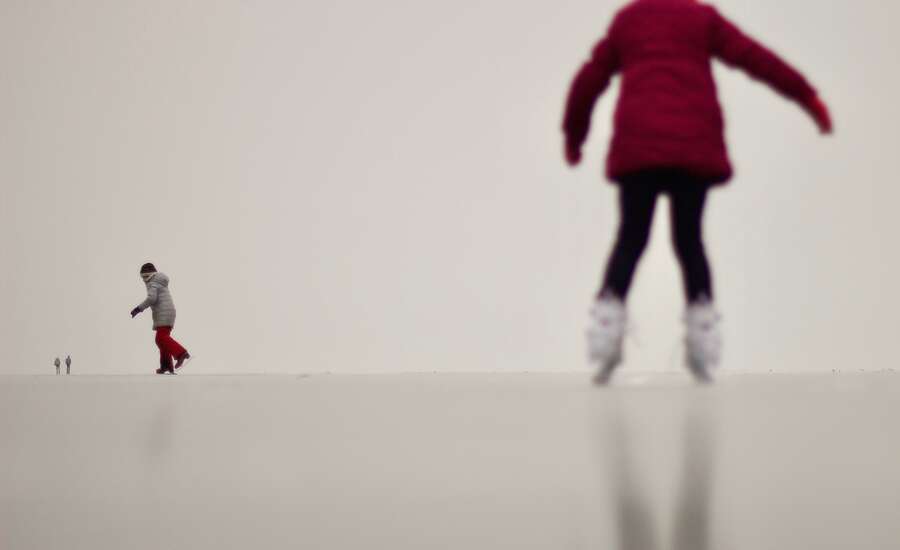
Photo by Mihály Köles on Unsplash
Moscow Ice Festival
Each winter in Park Pobedy, blocks of ice are towed in from Russia’s great lakes to be chiseled away into masterpieces. Children will be delighted to find that they can even clamber upon some of these unbelievably big artworks. But the favorite by far, are super slippery ice slides.
*Just beware of wet bums— waterproofs are a must.
Learn more about winter activities is Moscow .
Address: Park Pobedy on Poklonnaya Hill Nearest metro station: Park Pobedy
Ice-skating
There are almost 1500 ice-skating rinks in Moscow alone. It’s almost as if every open plot of land has water poured over it; even Red Square is transformed into a mega rink! The park VDNKh boasts the biggest in the world, but there’s also an awesome rooftop ice rink at ArtPlay. Wherever you take your children, you can’t go wrong with a bit of skating.
Our travel brands include

Express to Russia
Join us on Facebook
We invite you to become a fan of our company on Facebook and read Russian news and travel stories. To become a fan, click here .
Join our own Russian Travel, Culture and Literature Club on Facebook. The club was created to be a place for everyone with an interest in Russia to get to know each other and share experiences, stories, pictures and advice. To join our club, please follow this link .
We use cookies to improve your experience on our Website, and to facilitate providing you with services available through our Website. To opt out of non-essential cookies, please click here . By continuing to use our Website, you accept our use of cookies, the terms of our Privacy Policy and Terms of Service . I agree
THE 10 BEST Moscow Things to Do with Kids
Things to do in moscow with kids.
- 5.0 of 5 bubbles
- 4.0 of 5 bubbles & up
- 3.0 of 5 bubbles & up
- 2.0 of 5 bubbles & up
- 3rd Transport Ring (TTK)
- District Central (TsAO)
- Garden Ring
- Boulevard Ring
- Good for Kids
- Budget-friendly
- Good for a Rainy Day
- Good for Big Groups
- Good for Couples
- Honeymoon spot
- Hidden Gems
- Adventurous
- Good for Adrenaline Seekers
- Things to do ranked using Tripadvisor data including reviews, ratings, photos, and popularity.
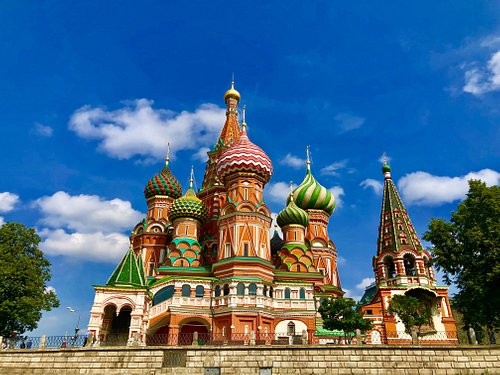
1. Red Square

2. Saint Basil's Cathedral

3. Tsaritsyno Museum-Reserve
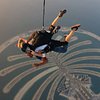
4. Moscow Kremlin
5. Kolomenskoye Historical and Architectural Museum and Reserve

7. The Museum of Cosmonautics
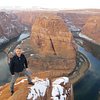
8. Kuskovo Estate

9. Sparrow Hills (Vorobyovy Gory)

10. The Exhibition of Achievements of National Economy (VDNKh)

11. Gorky Central Park of Culture and Leisure
12. Sokolniki Park

13. PANORAMA360

14. Kremlin Walls and Towers
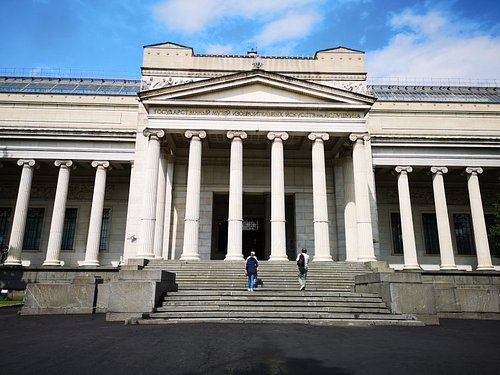
15. Pushkin State Museum of Fine Arts

16. Victory Park
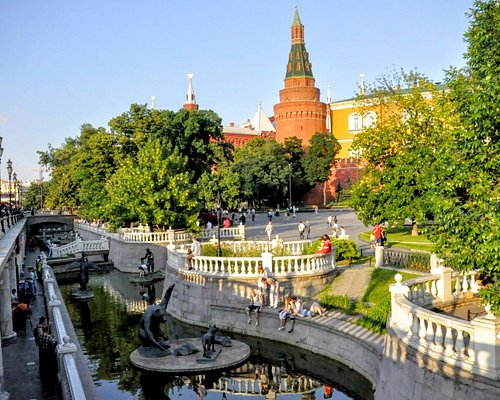
17. Aleksandrovskiy Sad
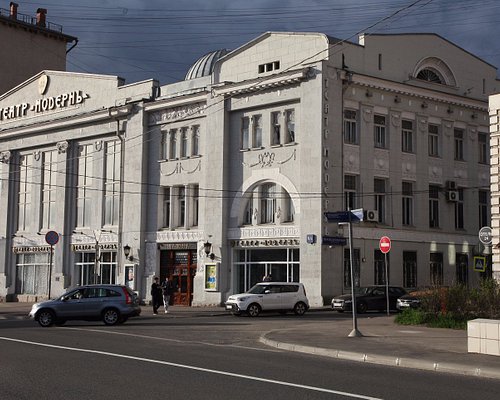
18. Modern Moscow Drama Theater
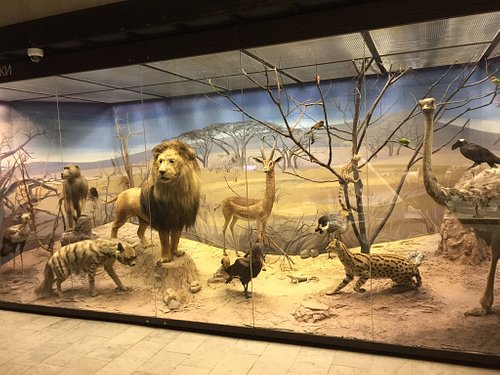
19. State Darwin Museum
20. Catholic Cathedral of The Immaculate Conception of The Blessed Virgin Mary
21. Patriarch's Pond

22. Krutitskoe Podvorye
23. Aptekarskiy Ogorod Botanical Garden

24. Ostankino TV Tower

25. Old Arbat (Stary Arbat)

26. Experimentanium Museum of Entertaining Sciences
27. Cathedral Square
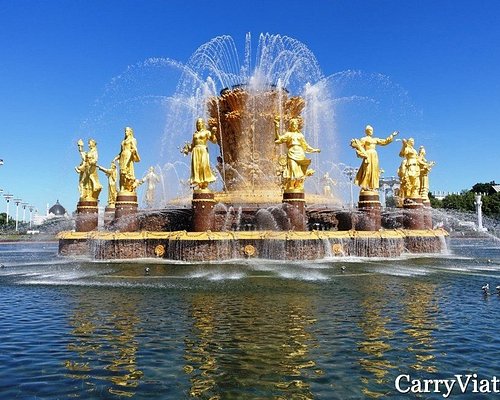
28. Fountain Druzhba Narodov

29. Neskuchny sad
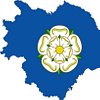
30. Museum of Soviet Arcade Machines
What travelers are saying

Moscow Itinerary: How To Spend 3 Days In Moscow
By: Author Lotte
Posted on Last updated: March 2, 2023
Categories Trans Mongolian Express

Moscow is the capital of Russia and there are few cities in the world that have played such a significant part in history.
Home to the Kremlin, the Red Square, the colorful St. Basil's Cathedral, and many more famous landmarks, Moscow is a city like no other.
This Moscow itinerary will help you plan your trip and make the most of your time in Moscow. From the best places to see in Moscow to how to get around, this post has got you covered.
Moscow itinerary

Disclosure: Some links in this post are affiliate links. If you make a purchase through one of these links, we may earn a small commission (at no extra cost to you!). We're very grateful when you use our links to make a purchase:-).
Moscow 3 day itinerary: map with highlights
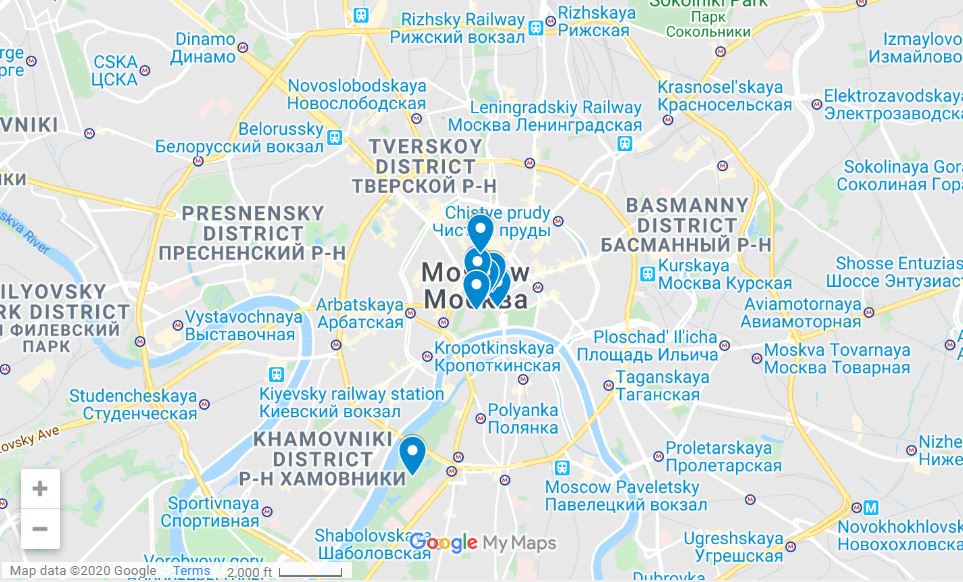
Click here for the interactive map .
What to do in Moscow in 3 days
- Day 1: The Red Square, GUM Department Store, St. Basil's Cathedral, Lenin's Mausoleum, and the State Historical Museum.
- Day 2: The Kremlin, the Cathedral of Christ the Saviour, Gorky Park, and the Bolshoi Theatre.
- Day 3: Izmailovsky Market, Bunker 42, and Zaryadye Park.
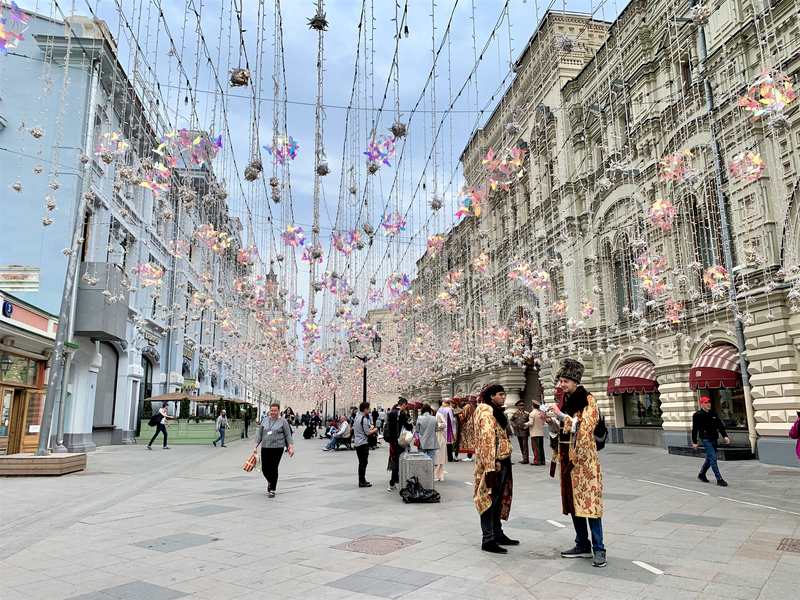
Important things to know when planning a trip to Moscow
The best time to plan a trip to Moscow is April-May and September-October . During these months temperatures are (generally) quite comfortable, though even in April there can be a bit of snow! The summer months are hot, both in regard to temperature as well as activities in the city. While it's a nice time to visit, it's also the busiest time of the year to visit Moscow. Hotel prices reflect this as well and summer definitely isn't a great time for budget travelers to visit Moscow. Winter in Moscow is cold, and I mean seriously cold (-15°C isn't rare). However, if you can withstand the subzero temperatures and freezing winds, it can be a magical time to visit. A snow-covered St. Basil’s Cathedral is a sight you will never forget. Keep in mind that days are short in winter and be sure to bring plenty of warm winter clothes!
The official currency in Russia is the Russian Ruble (₽ or RUB). Here you can find the current exchange rates, at the time of writing €1 is approximately 70RUB and $1 is around 62RUB.
Yes, you probably do. Getting a visa for Russia requires a bit of time and effort. You need to fill out several forms and provide a detailed travel itinerary and information about your accommodation. Also, you will need a Visa Support Letter which can be provided by your travel agency or your hotel. Depending on your nationality, there may be additional requirements, please refer to the information provided on the website of your country's Embassy in Russia.
While most of the things to see in Moscow listed in this post are within walking distance of each other, sometimes you will have to travel a bit further afield. The best way to get around in Moscow is by metro. It's cheap and efficient and a sightseeing activity in itself, because Moscow has the most beautiful metro stations in the world ! Among the most exquisitely decorated stations are Komsomolskaya, Novoslobodskaya, Mayakovskaya, Taganskaya, and Prospect Mira Station, but there are many more worthwhile stations to be found in the Moscow underground. You can purchase a single ticket from one of the ticket machines or get a rechargeable Troika Card when you plan on taking the metro several times. Read more details on how to use the Moscow metro here . If you prefer to get around by taxi, that's possible too. We used the Gett app to order a taxi (similar to Uber) to avoid confusion about our intended destination and having to negotiate in Russian. A convenient extra for families is the Gett Kids option, these cars are outfitted with a car seat.
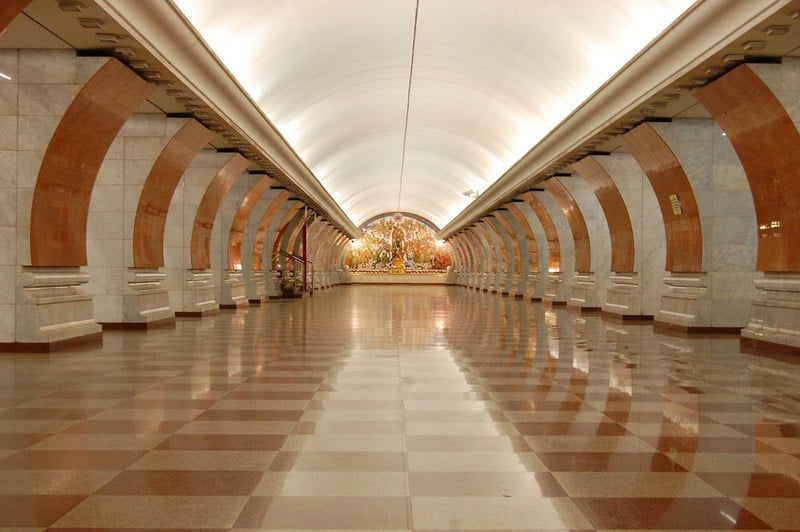
The best things to do in Moscow
While you could easily spend a week in Moscow (or more), most of us, unfortunately, don't have that much time available.
This 3-day Moscow itinerary will guide you to the most popular and important places to visit in Moscow, as well as to some of the more unusual things to do in Moscow.
Below you can find the list of the Moscow sightseeing highlights included in this post.
The Red Square
Gum department store, st. basil's cathedral, lenin's mausoleum, the state historical museum, the kremlin, cathedral of christ the saviour.
- The Bolshoi Theatre
Izmailovsky Market
Zaryadye park.
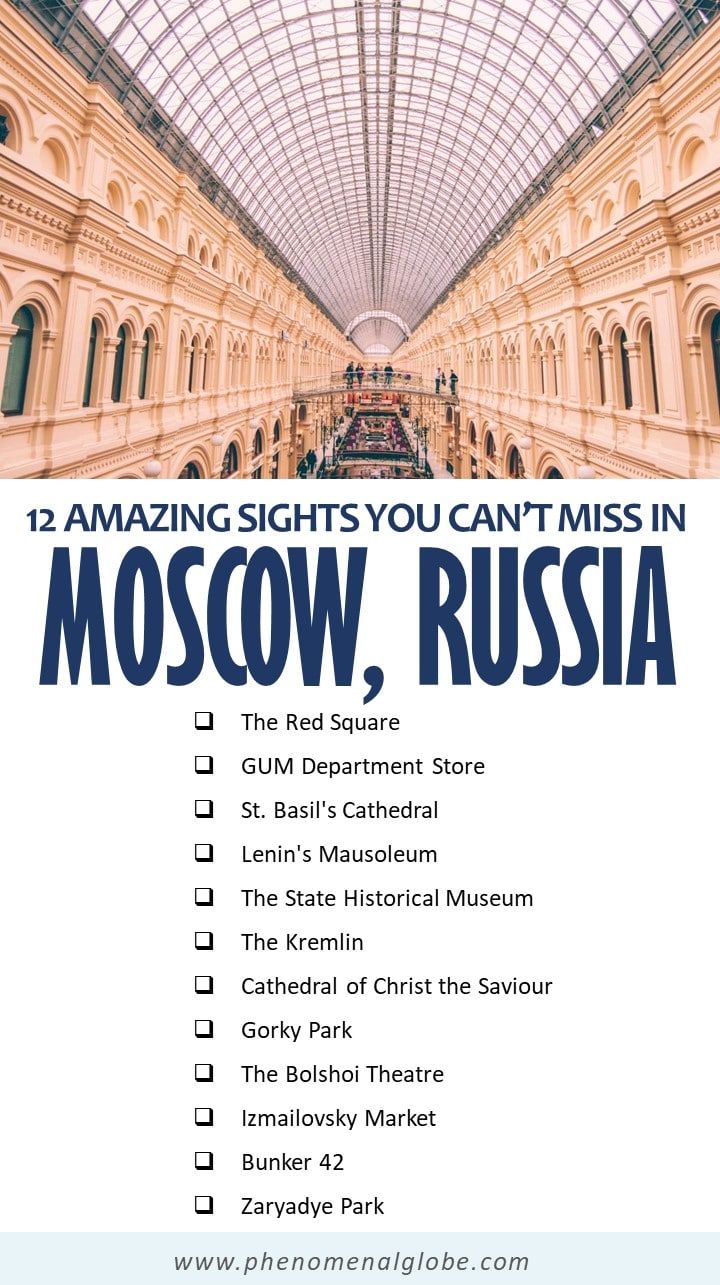
Plan your trip like a pro with these tools: ✈️ Find the best flight deals on Kiwi.com . ? Get the best car rental deal for your road trip on Rentalcars.com . ?️ Find your dream accommodation on Booking.com or Agoda . ? Book the best tours via Get Your Guide , Viator or Klook . ? Plan your journey with the Lonely Planet . ?️ Travel safely and get reliable travel insurance from Safety Wing .
Moscow itinerary day 1
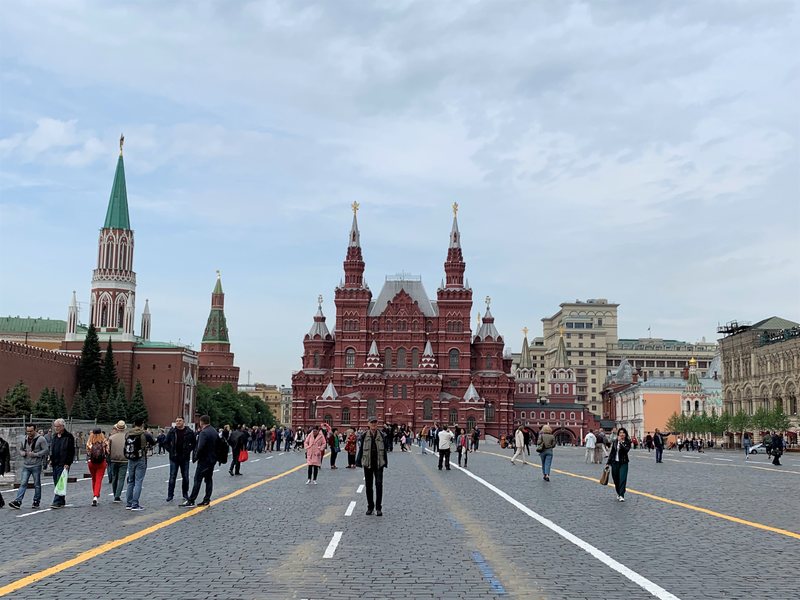
There is no better place to start your first day in Moscow, than at the world-famous Red Square.
This square is considered the central square of Moscow, not just because all the major streets start here, but also because no matter where you look when standing on this square, there are historic buildings all around.
Starting with the impressive GUM store and going clockwise, there is the colorful Saint Basil's Cathedral, the Kremlin, Lenin's Mausoleum, the State Historical Museum, and the Kazan Cathedral.
However, before entering any of these Moscow must-see attractions, allow yourself a moment to take in the view and let it sink in that you're standing on historical grounds (and a UNESCO site).
The Red Square was the official address of the Soviet government and played an important part in history. Many military parades have been held (and are still being held) here. It's the place where protests have taken place, as well as high-profile concerts from famous international artists.
All in all, it's one of the places in Moscow you can't miss during your Moscow city trip!
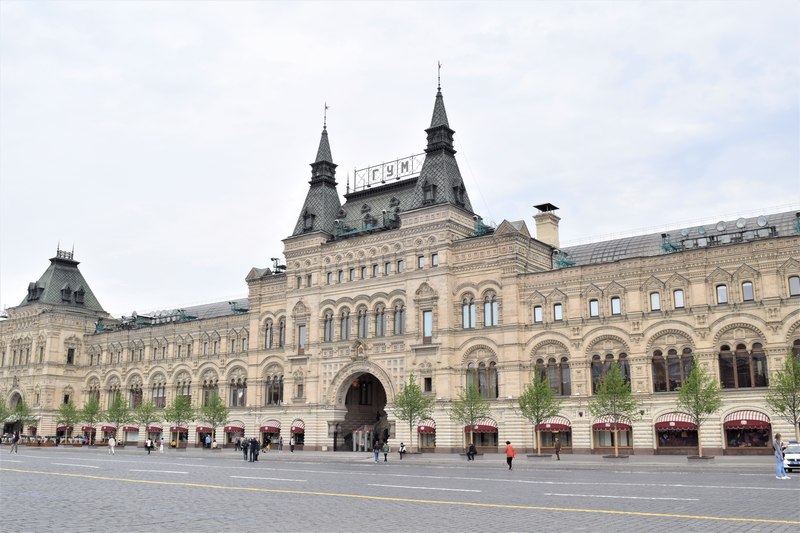
Yulia from That's What She Had: it might seem like visiting a department store is not something you’d do on the first visit to Russia’s capital.
But GUM is not like any other department store and is well worth your time, if only for its unique architecture.
First of all, it’s located right on Red Square which makes it an easy stop on your Moscow trip itinerary. Second, GUM is not a simple mall, but an institution built in the late XIX century.
The abbreviation stands for Glavniy Universalniy Magazin or Main Universal Store. Its impressive facade extends for over 240 meters along the eastern side of Red Square.
Inside you’ll find a beautiful glass ceiling supported by a metal framework, not unlike the ones found in the old train stations of Great Britain.

While shopping in GUM will cost you an arm and a leg, there’s one reason why tourists and locals come here anyways: traditional Russian food at Stolovaya #57. Stolovaya is Russian for canteen and this is where you can get your pelmeni , borsch , and pirozhki fix!
Afterward, don’t forget to get the famous plombir ice cream in one of the kiosks on the ground floor.
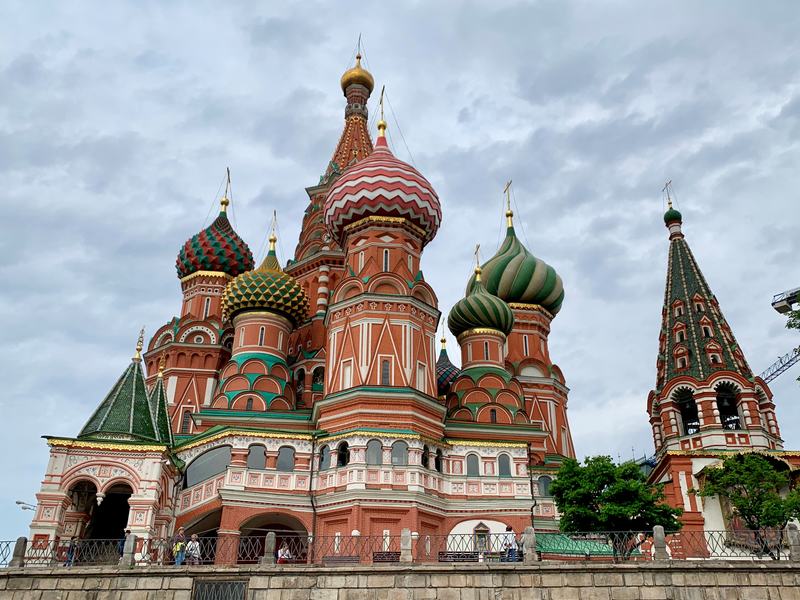
Saint Basil's Cathedral with its colorful domes is easily recognizable and one of the most popular Moscow tourist attractions. The building, built on orders from Ivan the Terrible, was completed in 1561 to commemorate the victory over Kazan and Astrakhan.
Until the construction of Ivan the Great Bell Tower (which can be found within the walls of the Kremlin), it was the tallest building in Moscow.
The design of St. Basil's Cathedral is truly unique; it's shaped like the flame of a bonfire and not one building in a similar style can be found in the whole of Russia.
A legend tells the story of how Ivan the Terrible had the architects of the Cathedral blinded so they could never build anything comparable.
This is a myth, however, but the fact remains that Saint Basil's Cathedral is one of a kind and it's not surprising it has become the symbol of Russia.

Wendy from The Nomadic Vegan: Lenin Mausoleum is hard to miss. It's a stepped-pyramid construction that sits right at the base of the Kremlin walls on the western side of Red Square.
Entrance is free but note that opening hours are quite limited, with visiting hours lasting only from 10 am to 1 pm on Tuesday, Wednesday, Thursday, and Saturday.
If seeing Lenin's embalmed body is important to you, be sure to take this into account when planning your itinerary in Moscow.
One of my top tips for travelers to Russia is to arrive early, well before the mausoleum opens, as the queue is usually quite long. However, usually, the queue does move pretty quickly.
This is especially true now that they have lifted the ban on bags and cameras.
It used to be that all cameras, smartphones, and bags of any size had to be checked at a left-luggage office nearby. But now you can bring a small handbag or backpack as well as your camera and phone.
Photography inside the mausoleum is still strictly forbidden, but you are allowed to take photos of the graves of various other important Russian figures that line the path leading to the mausoleum.
Once you finally enter the mausoleum, the atmosphere is surprisingly peaceful and uncrowded. It doesn't feel nearly as rushed as when visiting Mao Ze Dong's tomb in Beijing or Ho Chi Minh's body in Hanoi , for example.
The illumination of the body is very well done and would make for superb photography if it wasn't forbidden. As an added bonus, just after you exit, you'll see the grave of Joseph Stalin outside.

Rai from A Rai Of Light: the imposing crimson building at the northern end of the Red Square is the State Historical Museum.
By decree of Alexander III, the museum was built with the support of Russian historians, philosophers, and artists. The red brick building, dating from 1875, was designed in the Russian revival style by Vladimir Shervud.
The National Museum of Russia houses a collection of over four million items, devoted to the history of the country's ancient and imperial period.
The exhibitions include many items previously owned by members of the Romanov dynasty, such as documents, artwork, personal items, furnishings, and decorations from the palace interiors.
Another exhibit features relics of the prehistoric tribes that once inhabited this region.
Notable items include ancient manuscripts, birch-bark scrolls, a longboat excavated from the banks of the Volga River, and the largest coin collection in Russia, sourced from the museums in St Petersburg .
The State Historical Museum is open daily from 10 am to 6 pm. The entrance fee is 700₽ per adult.
Moscow itinerary day 2

When listing the best Moscow things to do, one cannot miss the Kremlin! The Kremlin houses the current seat of power in Russia and has done so for several decades.
Within its walls, the offices of the Russian Government can be found. During Soviet rule, the Kremlin was where all the important decisions were made but its history goes back for many centuries.
The first mention of the Kremlin in history books was in 1147, however, the current citadel dates from the 16th century.
The Kremlin is one of the major fortifications found in Europe, with walls that are up to 6.5 meters thick and 19 meters high in particular sections.
Inside the complex, there are many government buildings, however, these aren't accessible to the public.
Around Cathedral Square you'll find (as the name suggests) many churches and cathedrals, such as the Cathedral of the Archangel, Annunciation Cathedral, the Church of Laying Our Lady's Holy Robe, and Ivan the Great Bell-Tower.
While Cathedral Square is definitely worth visiting, the highlight of the Kremlin is a visit to the Armoury.
Inside you can find an impressive collection of Faberge eggs, beautiful dresses worn by Catherine the Great, intricately decorated thrones used by the Tsars, and much more. Unfortunately, photography is forbidden inside the Armoury.
Practical information about visiting the Kremlin
In order to visit both Cathedral Square and the Armoury, you will have to buy two separate tickets. A ticket to Cathedral Square costs 700₽ and a ticket to the Armoury is 1000₽. Prices mentioned are for adults, children below 16 years old are free.
Tickets can be bought at the ticket office onsite on the same day, however, there's no guarantee tickets will be available, especially during peak season.
Conveniently, tickets can be bought online as well, which is highly advisable if you want to make sure you'll be able to visit the Kremlin during your city trip to Moscow.
How much time to spend at the Kremlin
Be sure to allow plenty of time to explore the Kremlin, at least half a day but it's easy to spend more time as there is so much to see.
Please note there isn't any food sold inside the Kremlin, so bring a snack and enough water (especially in summer when it can get pretty hot).
Luggage storage
Backpacks aren't allowed inside the Kremlin, they can be stored (for free) in the cloakroom, but you can bring your camera and a small purse.
We could also take our Babyzen Yoyo stroller inside, which was very convenient as our 10-month-old son could take a nap while we explored the sights.

After the original Cathedral of Christ the Saviour was demolished by Stalin in 1931, a new version was completed in 2000.
The imposing building is the tallest Orthodox Christian church in the world (103 meters high), and is beautiful on the outside as well as on the inside.
Visiting the Cathedral is free of charge and it's open any day of the week from 10 am to 5 pm (except on Mondays when the opening hours are 1 to 5 pm).
When visiting the Cathedral of Christ the Saviour it's important to dress appropriately. For men, this means no shorts or tank tops.
Women can't enter with mini skirts or shorts, strap tops, or anything too revealing. Also, women are advised to cover their heads with a scarf as a sign of respect.
Inside the Cathedral photography isn't allowed, but believe me when I say there is plenty to see. There are beautiful frescoes, colorful icons, impressive statues, and other vivid decorations.
For a beautiful view over Moscow, walk up the stairs to the 40-meter high observation deck (entrance fee 400₽).
Visit Gorky Park
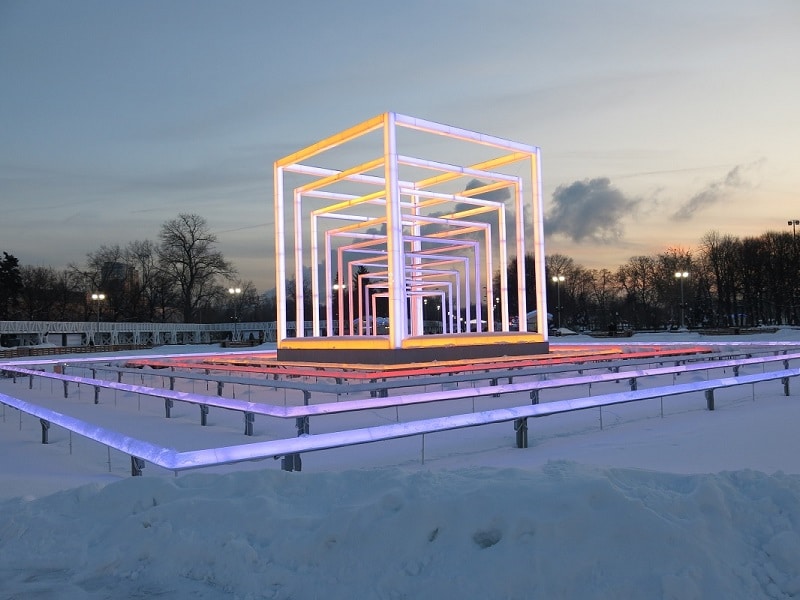
Helen from Holidays from Hels : Gorky Park, named after the Soviet writer Maxim Gorky, has recently undergone extensive regeneration to become Moscow's central leisure hub for young Muscovites.
Every day of the week you can find many Moscow residents strolling along the banks of the river in the summer, hiring bikes, picnicking on the grass, or dining at one of the many restaurants.
Open-air cinemas, petanque, and ping pong are all on offer. Not to be missed is the iconic white stone entranceway and museum, complete with columns carved with Soviet hammers and sickles.
In winter, look out for the ducks waddling across the frozen Moskva River, and watch boats attempting to navigate through the cracked ice. However, the real winter highlight is to try ice skating on one of the biggest rinks in Europe!
Ice skating in Gorky Park
The park’s maze of pedestrian pathways is transformed into one huge skating rink, which can play host to up to four thousand skaters.
Not surprisingly, Russians are talented ice skaters and there is a good chance you will find yourself next to a pirouetting ballerina.
Handily, you will find you will already be wearing most of what you need – gloves, hat, scarf, and thick socks and you can hire skates on-site. Lockers are included in the price if you don’t fancy skating with your day pack.
Disco tunes fill the air, and the whole arena is backlit in spectacular neon lights. Rest your weary legs and warm up at one of the cafes dotted along the frozen pathways, with the added bonus of not having to take off your skates.
Opening times
The rink is open from 10 am until 11 pm on weekdays and until midnight at weekends but closes between 3 and 5 pm. Like most attractions in Moscow, the rink is closed on Mondays.
The prices range from 350-650₽ and go up in the evening, which is the best time for the light show. Arriving at 5 pm, just as the rink opens for the evening session will give you time to find your ice legs before it fills up with more confident skaters.
Whilst waiting for the rink to open, try out the nearby tubing track where you can shoot down a snowy hill on an inflatable ring repeatedly for a very enjoyable half an hour!
How to get to Gorky Park by metro
The nearest metro is Park Kultury Station, on the other side of the river. As always, check out in advance what this looks like in the Russian Alphabet so you know when to get off!
Bolshoi Theatre
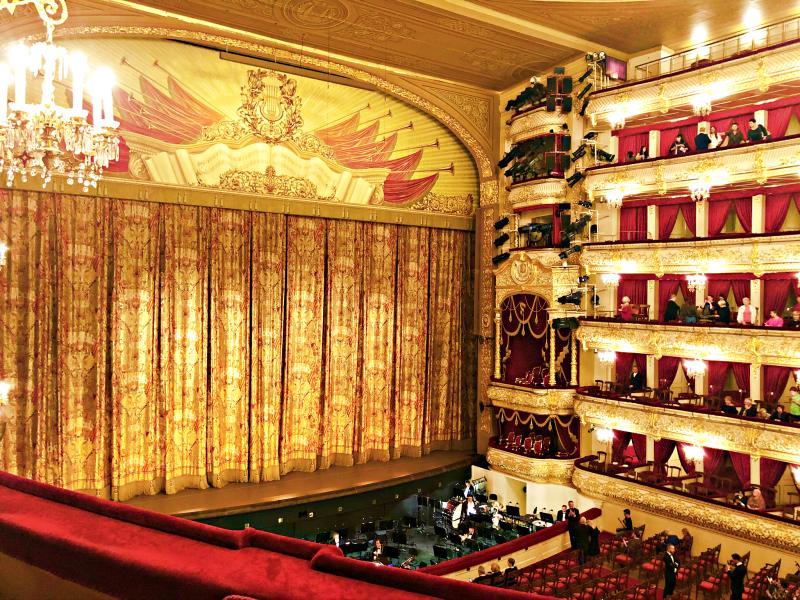
James Ian at Travel Collecting : one of the best places to go in Moscow is the famous Bolshoi Theater, located only a short walk from Red square. Bolshoy means big in Russian, and the theatre is not only big but also beautiful.
There are two ways to see the theater: on a guided tour or by watching a performance .
Take a guided tour
- English tours are held on Tuesdays, Wednesdays, and Fridays at 11:30 am. Tickets for these tours can be bought (on the same day) at the ticket office located in the Historic building of the theatre (door #12).
- A ticket costs 2000₽ per person, tours last one hour, and the number of people on a tour is limited to a maximum of 20. The tour takes you inside the theater and to the historic main stage.
Watch a performance
My favorite way to see the theater, though, is to enjoy a performance and experience the theater as a patron.
The entrance is a little underwhelming when you first arrive, the street lobby is small and quite plain and you will be immediately directed up to your floor.
There are helpful attendants on each floor to guide you to the correct door. Arrive a little early and head up to the Grand Salon on the top floor where you can enjoy a glass of champagne while people-watching (Russians dress up for the theater).
Then head to your seat and take in the stunning theater before enjoying the famous Bolshoi Ballet or another performance.
Be sure to book a show at the historic stage, there is a modern stage as well but that isn't nearly as much fun.
Moscow itinerary day 3

Karen from WanderlustingK : one of the most interesting Moscow places to visit is the Izmailovsky Market .
This flea market and tourist attraction a bit outside of the tourist center is a recreation of a Tzar’s Palace, known as a Kremlin, produced in a colorful 16th-century style.
The market is filled with tiny stalls that sell everything from snacks to kitsch to authentic items from Soviet times such as hats, pins, and other pieces of memorabilia.
You'll also find authentic antiques such as vases, paintings, and other religious items if you're looking to splurge within the interior parts of the market.
Negotiating in English is not always possible as many vendors only speak Russian, so be sure to practice your Russian numbers and see how well you can do with haggling.
It's important to carry cash when you visit given that many vendors do not accept cards. We ended up purchasing a series of hats at the market, along with a beautiful hot tea glass with a metal holder with a typical Russian scene.
Elsewhere in the market, you’ll also find a few tourist shops that sell typical Russian products. It takes a few hours to see the market in full, so arrive early as the best items go quickly!
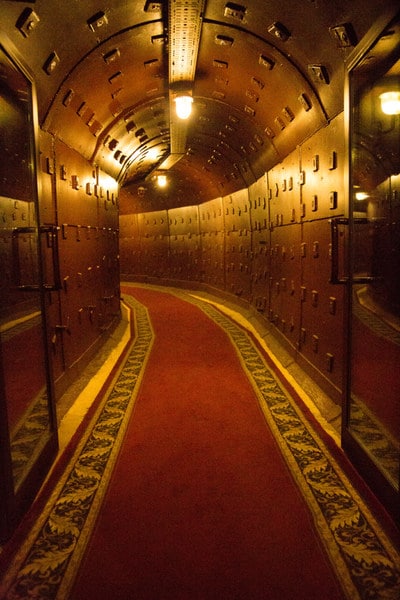
Lindsey from Have Clothes, Will Travel : Bunker-42 was once a top-secret, Soviet military complex. Stalin commissioned its construction after the United States succeeded in creating a nuclear bomb.
An impressive 65 meters (or about 213 feet) underground, was the desired depth to protect Russia’s top officials from a nuclear attack.
Bunker 42 became operational in 1954. Fortunately, it was never needed for its true purpose, and instead it was used as the command center of strategic bombers for nearly 30 years.
Nowadays it's a museum dedicated to the Cold War and visiting is a truly unique experience!
You will need to join a tour in order to see the museum. You can call ahead to book your tour (the number is: +7 499 703-44-55), there are several English tours throughout the day that are held at 13:30, 16:30, and 18:30 (the price is 2200₽).
On Mondays, there is an extra tour at 17:30, which lasts an additional 30 minutes and costs 2800₽ per person. There is also the option to book a private tour. However, I am unsure of the price for this.
You will have to wait until exactly 15 minutes before your tour begins before you'll be admitted inside. After paying for your tickets and a quick restroom stop you will descend 65 meters underground…
Another option for visiting Bunker-42, if you would rather not do the tour, is to visit the restaurant inside Bunker-42. Actually, I highly recommend visiting the restaurant before or after a tour as well!
While the food is not that great, it’s worth visiting for a drink. The restaurant is also located within the bunker and is decorated in the old Soviet style.
From time to time there will be live performances and visiting Bunker 42 is definitely an experience worth having while in Moscow! After all, how many people can say they've had a drink in a top-secret Soviet military bunker?
If you’re visiting Moscow during peak season (June-July-August), it would be worth making a reservation, to avoid having to wait. Otherwise, I would not say you need to worry about a reservation at the restaurant.
Bunker-42 is a short cab ride away from Red Square (10-15 minutes). But I recommend taking the metro to get there. The closest station is Taganskaya, which is a beautiful metro station very much worth visiting.

Park Zaryad'ye or Zaryadye Park is a lovely place for a stroll and a nice place to relax after a day of sightseeing in Moscow, especially when exploring Moscow with kids.
There are many things to see and do in this park, but I recommend starting your visit at The River Overlook , a 70-meter-long boardwalk with beautiful views over the river and the Kremlin.
Other interesting places to visit in Zaryadye Park are the Ice Cave, The Museum of Nature, and The Glass Crust. But most importantly, do as the Muscovites do and find yourself a nice place in the park to sit down and relax.
Enjoy the view, do some people-watching, and take a moment to think back about all the Moscow top sights you've seen in the past couple of days.

Where to stay in Moscow
There is a huge amount of hotels in Moscow, ranging from budget hostels to exquisite 5-star hotels. Below you can find three well-reviewed Moscow hotels (rating of 8.5+ on Agoda and Booking ).
3-star hotel in Moscow: MIRROS Hotel Mokhovaya

This 3-star hotel is one of the best budget Moscow hotels and is all about location! From the hotel, it's just a 10-minute walk to the Kremlin and only 600 meters to the Christ the Savior Cathedral.
Set in a historic 19th-century mansion, the hotel features classic rooms with ensuite bathrooms.
The staff is friendly and there is a metro station nearby (Borovitskaya), making it easy to get to the Moscow attractions a bit further afield.
Click here to book
Modern hotel in Moscow: Barin Residence Myasnitskaya
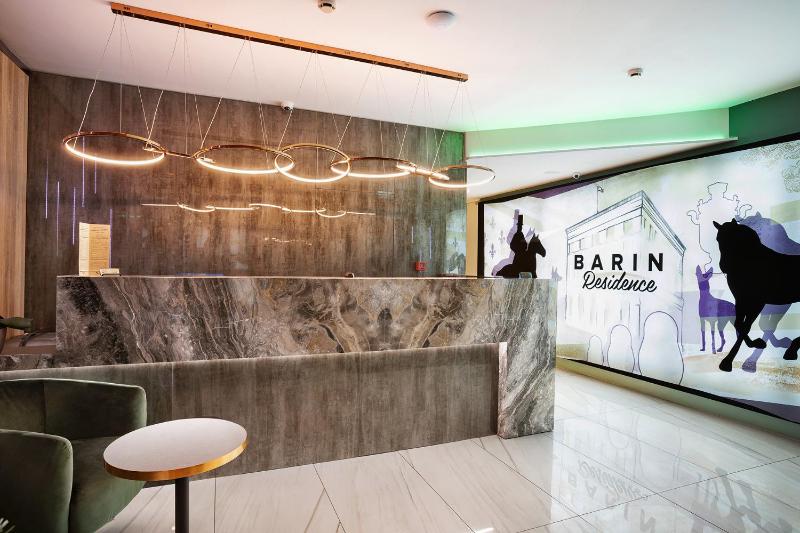
The Barin Residence Myasnitskaya is a newly built hotel, located about 1.2km from the Red Square (about a 15-20 minute walk).
The rooms and bathrooms are very modern and clean, the beds are comfortable and room service is available. This hotel is an excellent choice for travelers looking for a nice hotel without a hefty price tag.
Luxury hotel in Moscow: Hotel National Moscow

Hotel National is potentially the best Moscow hotel. It's a gorgeous 5-star hotel located just a stone's throw away from the Bolshoi Theater, the Red Square, and the Kremlin.
The building was designed by architect Alexander Ivanov and completed in 1903 and has been welcoming international travelers ever since.
With its imperial architecture, luxury design, and charming classic rooms (some with a view of the Kremlin!), the Hotel National is a unique property.
Furthermore, you can enjoy an indoor pool, sauna, and fitness center as well as the well-reviewed Beluga restaurant that serves both Russian and European dishes.
While this hotel doesn't come cheap, your stay at the Hotel National will make your trip to Moscow an unforgettable experience.
Moscow itinerary and travel guide: in conclusion
I hope this guide to Moscow will help you plan a trip to this interesting Russian city. Feel free to ask any questions you may have by leaving a comment or sending me an email !
Below you can find my other posts about the Trans Mongolian Express , and the stops we made along the way:
- St. Petersburg itinerary
- Irkutsk and Lake Baikal itinerary
- Ulaanbaatar itinerary
- Trans-Mongolian Express travel guide

This post was updated in December 2020.

IMAGES
VIDEO
COMMENTS
Here are some important things to note before we get started: I've combined two of my personal itineraries to create this 7-10 day Kyushu travel guide.; For Days 1-4, I recommend using public transport such as the trains and express airport bus.; From Day 5 onwards, a rental car is the best option to reach more remote areas.; I also recommend using Kumamoto as a base, due to its central ...
Day 1: Fukuoka. Kyushu's largest and most vibrant city is Fukuoka ( 福岡 ), a great place to start your trip. The old castle town is located along Hakata Bay, which made it a favorable base for international trade. The city was first known as Hakata, but was renamed Fukuoka in the 17th century.
Day 1: Mount Aso Day Tour or Mount Aso Hiking/Mount Eboshi. Day 2: GorogoTaki Waterfall in the morning and Mount Neko Hike in the afternoon. Day 3: Takachiho Gorge Tour. Day 4: Mount Kuju Hiking circuit and transit from Kumamoto to Beppu. Beppu. Day 5: Onbara Falls mini-hike and Mount Taharamaya/Magaibutsu Buddha.
Day 1: Hiroshima. Land in Osaka in the morning, go to Hiroshima immediately, and spend all day in Hiroshima. Day 2: Fukuoka. Travel to Fukuoka in the morning, then spend time in Fukuoka All-Day. Day 3: Nagasaki. Travel to Nagasaki in the morning and spend the rest of the day in Nagasaki. Day 4: Stay in Nagasaki All-day.
5 days in Kyushu. The starting point for our return trip was Kobe - 20 minutes east of Osaka by train. But you could be starting in any number of cities in Japan that have an airport. Of course, you could start in one city, fly to Kyushu, use this itinerary, and then fly onto a new city as your next destination.
After all, we're enjoying a fabulous family holiday in Kyushu! For more Japan family holiday information, visit my articles about our visits to Kyoto and Hiroshima. USEFUL INFORMATION. Getting There. It takes 8 hours to travel from Tokyo Station to Kagoshima Station with a transfer of trains at Shin-Osaka station.
Land of volcanoes, ancient religious sites and a galaxy of regional cuisines. Kyushu (九州, Kyūshū, literally "nine provinces") is Japan's third largest island, located southwest of the main island Honshu. An early center of Japanese civilization, Kyushu offers many historic treasures, modern cities and natural beauty.
Huis Ten Bosch, Beppu Onsen, Sakurajima, etc. There are many popular tourist spots Kyushu Would you like to travel to. This time, Recommended hotels and tourist spots for families traveling with children in Kyushu Special feature. Activities and experiences to enjoy nearby I will also introduce you.. Kyushu If you are planning a family trip to Japan, please use this as a reference!
A 7-day All Kyushu Rail Pass pays off for this itinerary. A rental car is recommended for days 5-6. Alternatively, public transportation can be used for the entire itinerary at a possibly lower cost, but with appropriate adjustments made to account for the longer travel times. Below are some sample budgets for the itinerary, excluding airfare. Find out more about the sample budgets and about ...
Our trip to Kyushu with kids (ours were 1.5yo and 3.5yo at the time of travel) marked our 1.5yo daughter's sixth set of flights. Needless to say, the kids are pretty adaptable and great at travel by now. ... Overall, Kyushu was a great family destination for us. If you're looking for a slow, nature-filled holiday with all the perks of Japan ...
Day 1: Fukuoka. Starting in Kyushu's main city of Fukuoka we spent the day exploring the city and wandering around the temple district very close to Gion subway station. Located in the Hakka half of the city the area is home to a stunning collection of temples and gardens, many of which are free. The largest temple in the area is the Tocho-ji ...
The Sanyo-Sanin - Northern Kyushu Pass is for the Kyushu area and also travels to/from the Osaka area. This pass lasts 7 days. Buy your pass here for a discounted price. JR Kyushu Pass is available but has duration of 3 or 5 days. This pass is good if you fly to Kyushu and don't plan to travel outside of the island.
Good to Know. Kyushu is Japan's warm and friendly southern island, with verdant green hills, active volcanoes, abundant hot springs and delicious food. It's also well connected to the world, with many transport options, lively cities and free Wi-Fi in many areas. Here are some tips on when to go, where to stay and how to make the most of your trip.
The total cost of this 1-week itinerary in Kyushu was around 200,000 JPY (two people, food expenses not included). We travelled in May during the Golden Week Holidays and booked everything well in advance. Here's the breakdown: Return flight ticket from Tokyo for 2 pax ~ 70,000 JPY; Car rental ~ 50,000 JPY; Petrol ~ 7,000 JPY;
August 18, 2023 · In: Motherhood, Travel. Finding this gem of a family friendly farm stay in the Japan countryside was a major highlight of our Kyushu trip. In this post, I share about our 3 day 2 night stay at Yufu Child Farm. (For our full week-long itinerary, check out - One week in Kyushu with Kids ).
40 reviews. 20 helpful votes. Trip Report for 2-week Kyushu Family Trip in February 2024. Feb 26, 2024, 2:06 PM. Save. Just got back from a 2 week family trip (wife and I + my elderly parents) around northern Kyushu! This is just a (relatively) short trip report to share some reviews/recommendations accumulated from the trip that I particularly ...
Option 1: Private guided tour. You want to travel on a private tour bus with your friends or family and an English-speaking guide. You want an all-inclusive tour with meals, accommodation and entrance fees already included in the price. You want to visit the best places and eat the best food. Visit this page to learn more about our private ...
Planning for a family trip in Kyushu in September. Me, my wife and 2 kids (3 and 7 years old) Hopefully can get some advice if the itinary is workable. Day 1 : Arrive into Fukuoka at 7am in the morning. Check into hotel. Keep the day for exploring Fukuoka City. Day 2 : Day trip via JR to Dazaifu and Nagasaki.
Family Travel: Kyushu. Kyushu, the third largest island located in the southern part of Japan, can be a perfect destination for a family trip. Thanks to the warm climate throughout the year, the island is blessed with both green mountains and clear blue ocean. The island is also well-known for volcanic mountains offering quality hot springs.
Unfortunately in 2023 my trip to Kyushu was not possible. I'll try again this year and I have new questions! It will be my sixth time in Japan, we will arrive in Osaka (13th august)and continue to Kyoto where we will stay for a few days.. From Kyoto by train to Fukuoka where we will stay for 2 nights and then by train to Nagasaki with a one night stop. So, i think to rent a car in Nagasaki and ...
Summer: Futuristic parks, river boats and ice caves are perfect attractions for when the temperatures rise above 30. Museums: Russians are very proud of their history, which means that their museums are kept to a world-class standard. Both parents and children alike will be sure to learn something new at one of the many, often unique museums in ...
Fun Things to Do in Moscow with Kids: Family-friendly activities and fun things to do. See Tripadvisor's 809,931 traveler reviews and photos of kid friendly Moscow attractions
What to do in Moscow in 3 days. Day 1: The Red Square, GUM Department Store, St. Basil's Cathedral, Lenin's Mausoleum, and the State Historical Museum. Day 2: The Kremlin, the Cathedral of Christ the Saviour, Gorky Park, and the Bolshoi Theatre. Day 3: Izmailovsky Market, Bunker 42, and Zaryadye Park.
Walking tour around Moscow-City.Thanks for watching!MY GEAR THAT I USEMinimalist Handheld SetupiPhone 11 128GB https://amzn.to/3zfqbboMic for Street https://...